Christina Rickman
12-18-2023
The Knott Foundation offices will be closed December 25 through January 1, and will re-open on Tuesday, January 2, 2024.
We wish you all a joyous holiday season and a happy new year!
Kathleen McCarthy
12-15-2023
An end of year message from Team Knott
Dear friends and grantee partners,
Preparation, Dedication, Joy, Unity, and Purpose – five words that convey the meaning behind the seasons of Advent, Christmas, Hanukkah, and Kwanzaa. While seasonal in t his context, they are unceasing words describing the work of you, our friends, and grantee partners.
his context, they are unceasing words describing the work of you, our friends, and grantee partners.
Through your preparation, dedication, unity, and purpose, you have provided refuge, respite, and reassurance to those in need, strengthening the communities that our founders, Henry and Marion, cared so deeply about. By doing so with a joyful spirit, even in your most challenging times, you have exemplified Henry and Marion’s approach to their life’s work.
We are humbled by the example you have set for us, and we too strive to measure up to the meaning of those five words in our own work. In 2023, we were afforded the opportunity to endeavor to do so with a new team. Welcoming Kelley Kilduff, Executive Director, and Jessica Feldt, Grants and Database Administrator, in June of this year, we began to build capacity for deepening existing connections and building new ones.
As we look ahead to 2024, we do so with great anticipation and high aspirations. Anticipation over a new website to be launched in early 2024, our 2023 Annual Report in late February, and another Open House in the spring. Aspirations to become more intentional and streamlined grantmakers with a greater focus on collaborating and convening. We also look ahead with tremendous appreciation for you and boundless awe for the work you do.
With warm regards and profound gratitude,
Team Knott (Christina, Jessica, Kathleen and Kelley)
Jessica Feldt
10-18-2023
How a generosity mindset confers physical, mental, and emotional benefits
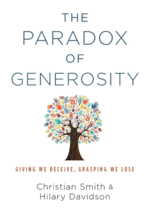 I began at the Knott Foundation, my first foundation job after a career in the nonprofit sector, just a few months ago. When I learned that the Foundation's blog has a column on what the staff is reading, I wanted to select a book that would explore the idea of philanthropy and giving. I am doing lots of learning on policies, practices, and the way foundations carry out their important work, but what about why we are drawn to philanthropic work? Every day we have the privilege of engaging with people in the nonprofit field giving their time, resources, and mental energy to help others. I picked this book to dig into what generosity means and how it manifests in one's life in ways big and small.
I began at the Knott Foundation, my first foundation job after a career in the nonprofit sector, just a few months ago. When I learned that the Foundation's blog has a column on what the staff is reading, I wanted to select a book that would explore the idea of philanthropy and giving. I am doing lots of learning on policies, practices, and the way foundations carry out their important work, but what about why we are drawn to philanthropic work? Every day we have the privilege of engaging with people in the nonprofit field giving their time, resources, and mental energy to help others. I picked this book to dig into what generosity means and how it manifests in one's life in ways big and small.

This book explores generosity through the results of a 2010 survey and series of interviews that explore the connection between different forms of generosity and greater life benefits like happiness, bodily health, feeling greater life purpose, and interest in personal growth. Here are my key takeaways from the book:
- Generosity as a practice: The book repeatedly returns to the idea that the connection between these human value benefits and generosity is tied to the regular practice of generosity instead of sporadic events. Things like a one-time blood donation or writing a will that gives money to a favorite nonprofit did not yield the same benefits that routine engagement and giving provided. This also applies to things like small, automatic deductions from paychecks or ticking the organ donor box on your driver's license application.
- Generosity is not just financial: The book shows that the benefits do not just come from giving financially; regular volunteerism, helping friends and family, and devoting attention and emotion to your relationships also benefits your health and well-being. The authors discuss how this regular generosity of time and of your mental energy can pay back your overall happiness and health in the long term.
- Generosity is not as common as you may think: According to the book, over 40% of Americans do not give away a single dollar and another group, also at over 40%, give less than 2% of their annual income. As many other studies have noted, greater income does not translate into giving larger percentages of one's annual income. Similarly, only 24% of Americans reported volunteering in a given year. The book also shows similar numbers for the other kinds of generosity such as relational and neighborly generosity. This is a little harrowing from the perspective of nonprofit organizations like our grantees who are reliant on donations and volunteer service.
- Generosity as a mindset: The authors point out in numerous ways that the benefits they see from generosity depend most on the mind-set of the giver. Being pressured to give does not result in the same sense of well-being that giving from an inward impulse does. Similarly, going along with a spouse, parent, or friend in an act of generosity does not yield the same benefits without the mindset of wanting to engage with that activity. The authors call the difference “purposefully giving away moderate portions of dearly held resources.” I loved the phrase dearly held resources. It really stood out to me as a way to think about the essence of being generous. Is it generous if you do not miss what you gave, be it time or money?
- We are all connected: In discussing the many reasons those 80% do not give, the authors note that while those who do not give of their time or money may feel they are doing no harm they are not seeing that “everyone’s life, however lived, sends out ripples of influence, positive and negative, toward untold numbers of other people.” This idea fascinates me. Both our actions and our inactions have an impact on this world we all share.
Jessica Feldt
10-11-2023
Announcing our most recent grant recipients in arts and humanities, Catholic activities, education, health care, and human services
We are pleased to announce that 19 organizations received over $833,000 in our October grant cycle.
Arts and Humanities
- B&O Railroad Museum: $60,000 to support Restore Baltimore, a targeted, applied, and intensive workforce development program for the under-employed, offered on the Museum’s 40-acre southwest Baltimore campus, in partnership with the Community College of Baltimore County
Catholic Activities
- Cathedral of Mary Our Queen Church: $80,000 to support the first phase of a lighting retrofit project at this, the mother church of the Archdiocese of Baltimore located in northwest Baltimore City
- St Francis de Sales: $10,000 to support the enhancement and expansion of youth-focused Religious Education programs at this thriving Catholic parish located in Harford County
Education
- Baltimore Urban Baseball Association: $10,000 to support the Free Membership Program providing access to a state-of-the-art youth training center in the Pigtown neighborhood of Baltimore City, using baseball and softball as tools to provide mentorship and promote community engagement for youth ages 4 – 25
- HASA: $15,000 to support the Gateway for a Healthy Future initiative, focusing on renovations of the Gateway School’s gym to better serve this K-8 school’s population experiencing a broad spectrum of sensory, cognitive, and social differences
- The John Carroll School: $80,000 to support improvements and technology upgrades in the theatre of this co-educational independent Catholic high school located in Harford County
- Maryland Book Bank: $45,000 to support the general operating costs of this Baltimore City-based organization cultivating literacy in under-served neighborhoods by increasing access to quality books
- Mother Seton Academy: $48,000 to support the general operations of this tuition-free independent Catholic middle school located in the East Baltimore Midway neighborhood of Baltimore City
- Mother Seton School: $20,000 to support technology investments at this this PreK-8 independent Catholic school in Emmitsburg
- Mount Saint Joseph High School: $65,000 to support technology upgrades designed to expand virtual learning and teaching opportunities at this Catholic college preparatory school serving young men in grades 9 – 12 in Baltimore City
- St. Francis Neighborhood Center: $48,500 to support the general operations of this Reservoir Hill-based nonprofit’s flagship out-of-school time program, the Power Project
Health Care
- Horizon Day Camp Baltimore: $37,362 to support transportation costs for children with cancer and their siblings attending Horizon’s summer camp in Baltimore
Human Services
- Associated Catholic Charities: $53,375 to support the general operations of the Esperanza Center’s Client Services program providing support to immigrants living in and around Baltimore City
- Asylee Women Enterprise: $45,000 to support the expansion and improvement of the Day Program providing educational, material, and financial support to asylum seekers and foreign-born survivors of human trafficking
- Baltimore Hunger Project: $45,000 to support the hiring of a development director to further grow the work of this Baltimore County-based organization dedicated to eliminating weekend childhood hunger
- HOPE for All Inc.: $42,000 to support this Anne Arundel County-based organization’s Turning Houses into Homes program, providing families transitioning from homelessness access to basic household necessities to establish healthy homes free of charge
- House of Ruth Maryland: $65,000 to support the general operations of the Clinical Program, providing therapy, client transportation, and emergency food assistance to individuals facing or fleeing Intimate Partner Violence
- Open Works, Inc.: $48,500 to support capacity building at this makerspace located in the Greenmount West neighborhood of Baltimore City dedicated to making tools, technology, and the knowledge to use them accessible to all
- Second Chances Garage, Inc.: $15,000 to support the Reduced Cost Car Repair program, providing needed auto repair services at reduced rates to low-income families in the Frederick area
By Kathleen McCarthy
10-06-2023
This fall, the Knott Foundation focused staff and trustee learning around the challenges and opportunities facing Catholic schools in the Archdiocese of Baltimore.
“The greatest crisis facing Catholic education, and education in general, is the recruitment and retention of talented and committed teachers and leaders for our schools.” John Staud - Executive Director, Alliance for Catholic Education at The University of Notre Dame
Henry and Marion Knott, our founders, believed that access to quality education was a key building block for achieving success in life. Success in their minds was not to be measured against one’s bank account but rather against one’s character, faith, and civic engagement. Given their own personal faith and belief that Catholic schools provided an unrivaled academic grounding and opportunity for the development of self-knowledge and selflessness, it is no surprise that Education in general, and Catholic education in particular, have historically been the Knott Foundation’s largest funding areas. Over the past decade alone, the Foundation has awarded more than $10M to support this work.
As responsive funders, the Foundation allows organizations meeting our eligibility guidelines to approach us with their greatest need. In the context of Catholic schools, we have seen these needs change in ways both subtle and significant over the now 46-year history of the Foundation. Perhaps the biggest change we have seen has been the need for staffing. Gone are the days when Catholic schools could rely upon the services of religious men and women to teach in the schools. This loss of free, faith-filled, and highly qualified labor has created challenges both earthly and spiritual – salaries are now the largest component of a school’s budget and there is a scarcity of faith-filled teachers.
While enrollment in AOB Catholic schools benefitted from growth during Covid, the teaching profession suffered. Althoug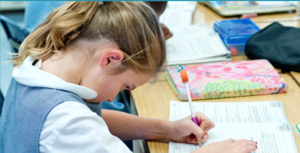 h notably lower than Maryland’s public school turnover rate of 18%, the 12.82% turnover rate in AOB Catholic schools is only slightly higher than the national average and cannot be ignored. Estimates place the cost of teacher turnover somewhere between $9,000 to $21,000 per teacher. While less quantifiable, rapidly changing social contexts including growing disaffiliation from religious practice among the population mean that it is harder to find teachers who, while not required to be Catholic, share the same mission as that of the schools' which is to “provide a Christ-centered education that is academically excellent and empowers students to reach their full potential –spiritually, intellectually, physically, socially, and morally.”
h notably lower than Maryland’s public school turnover rate of 18%, the 12.82% turnover rate in AOB Catholic schools is only slightly higher than the national average and cannot be ignored. Estimates place the cost of teacher turnover somewhere between $9,000 to $21,000 per teacher. While less quantifiable, rapidly changing social contexts including growing disaffiliation from religious practice among the population mean that it is harder to find teachers who, while not required to be Catholic, share the same mission as that of the schools' which is to “provide a Christ-centered education that is academically excellent and empowers students to reach their full potential –spiritually, intellectually, physically, socially, and morally.”
Notre Dame of Maryland University’s Operation TEACH (Teachers Enlisted to Advance Catholic Heritage), a two-year post-graduate mission-driven program, seeks to develop highly committed educators to meet the needs of students in Baltimore-area Catholic elementary and secondary schools. Similar to the public school-supporting program, Teach for America, Operation TEACH places young teachers in Catholic schools and supports them as they work towards a Masters in Education. To date, the program has graduated 175 educators, 50% of whom have remained with the Archdiocese of Baltimore.
Once recruited, individual schools and the Diocese need to begin to offer supportive and creative solutions to improve retention rates. While salary is often highlighted as the biggest driver for resignation, research indicates that it is not. Of course adequate compensation is important, but when surveyed, teachers responded that higher on their list of reasons to stay are having a strong and supportive principal, a positive and collaborative work environment, the ability to express themselves and influence curriculum, and for new teachers, access to a supportive mentor.
This academic year, there are 24,000+ students attending the 40 Archdiocese of Baltimore-managed Catholic schools (34 elementary and 6 high school) in Maryland. They are served by a teaching staff of more than 1,600. Together they will strive for academic excellence, build community, and grow in faith – carrying on a mission that is well over 200 years old and as meaningful in spirit and measurable in outcomes today as it was back then.
Christina Rickman
09-06-2023
North East Housing Initiative uses a Knott Foundation cash flow loan to bridge receivables from Baltimore City’s Department of Housing and Community Development
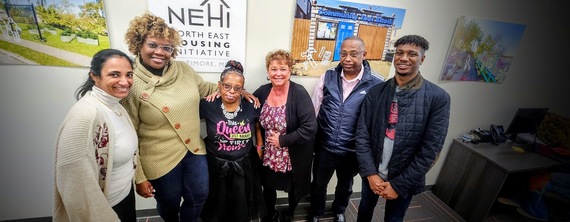
“The cornerstone of a healthy family is housing. You can’t think about your grades as a child if you don’t have a good place to stay. You can’t think about crime and safety if your house is not a safe place,” states Garrick R. Good, Executive Director of North East Housing Initiative (NEHI).
A housing model unique to Baltimore
NEHI is a community land trust dedicated to providing permanently affordable shared equity housing in Baltimore. “A community land trust is community-owned land that is removed from the private real estate market, overseen by a board of directors, and made up of members who live and work within the geographically defined area,” Garrick explains. NEHI buys vacant, abandoned, and foreclosed properties, and using subsidies, rehabs these properties into permanently affordable homes for families earning less than 50% of the area medium income.
If this doesn’t sound like something you’ve seen before, that’s because it isn’t. “Baltimore is the first city to have an affordable housing trust fund. We now have states across the country looking to see if they can replicate it and how,” Garrick says. NEHI is working to educate state and city legislators about the social and fiscal benefits and functions of community land trust organizations. In addition to giving low-income families the opportunity to create and build wealth, the community and city realize the benefit of increased property values.
Delays in government funds
Baltimore City depends on nonprofits like NEHI to provide services ranging from housing and food assistance to rehabilitation, youth mentorship, and job training. Baltimore’s most disenfranchised and vulnerable populations rely on these essential services. However, the City’s contracting and payment process often leaves nonprofits waiting over a year for payment. To avoid a disruption in services, directors like Garrick must find creative solutions to keep the lights on.
This is where the Knott Foundation’s cash flow program can help. Under Garrick’s leadership, NEHI has been the recipient of four cash flow loans from the Knott Foundation. Three of these loans were awarded during the pandemic, helping NEHI to weather exacerbated delays in government payments at the same time that housing insecurity worsened.
When Garrick started at NEHI in 2018, their annual budget was $50,000. Today, it’s $5 million. He has also worked to develop institutional partners who provide services ranging from financial literacy counseling to a tool-library homeowners can borrow from for home repairs. By 2025, his goal is to have 200 homes in their community land trust. “Our goal is to make dreams come true for families that didn’t feel they had the ability to buy a house.”
Kathleen McCarthy
07-24-2023
This spring, the Knott Foundation focused staff and trustee learning around workforce development.

 As we emerge from the COVID-19 pandemic, it is clear that the country continues to face challenges finding workers to fill open positions. A recent study by the Chamber of Commerce found that Maryland is one of twelve states facing a “most severe” crisis filling open positions, with 44 available workers for every 100 jobs.
As we emerge from the COVID-19 pandemic, it is clear that the country continues to face challenges finding workers to fill open positions. A recent study by the Chamber of Commerce found that Maryland is one of twelve states facing a “most severe” crisis filling open positions, with 44 available workers for every 100 jobs.
To learn more about the state of the workforce sector in Maryland, the Knott Foundation sought out the insights and experiences of several sector workers during our spring Joint Grant Committee and June Board Meetings.
From funders focused on making an impact in this sector, we learned the importance of:
- Providing general operating support to build the capacity of selected organizations and promote the success of their clients.
- Acknowledging the time commitment required by foundation staff and trustees to move a strategy forward in a meaningful and impactful way.
- Accepting that it is an iterative process; the board should be on a learning journey, adjusting as we learn.
- Streamlining and adapting requirements (e.g., zoom calls, video submissions) levied upon grantee partners.
- Being community driven and community led.
- The need to support the sector, not just individual programs (e.g., engaging in advocacy through membership organizations such as Maryland Philanthropy Network and their Workforce Development Funders Collaborative).
From organizations providing workforce development programs, we learned that:
- Policy and advocacy work are inextricably linked to the success and failure of low wage/low skilled workers and the programs that provide training.
- Funders need to create safe spaces for partners to take risks and have honest conversations.
- The most sustainable programs create opportunities rather than give handouts.
- Providing wrap-around services to clients and employers is key to success. Support and education need to take place in both directions for a placement to be lasting and productive.
- Public education and outreach around the challenges faced by low wage/low skilled workers and the collateral damage of a criminal record is essential.
- To be successful in a labor market that increasingly emphasizes workplace culture, autonomy, and flexibility, programs need to consider people’s passions alongside their skills sets.
Each expert echoed that while a program might focus on a specific area of workforce development, the sector should be viewed as an ecosystem and consideration given to the many different ways in which people find meaningful, sustainable, and family-supporting work. In essence, workforce development must be treated as more than placing a person in a job and walking away. The same can be said of the relationship between the funder and the grant partner as well; deep relationships take time to build but will prove to be a key component in success for all parties.
Jessica Feldt
06-14-2023
Announcing our most recent grant recipients in Catholic activities, education, health care, and human services
We are pleased to announce that 12 organizations received over $780,000 in our June grant cycle.
Catholic Activities
- The Baltimore Basilica: $60,000 to support renovation of the Sexton Lodge into a Café of Hospitality to serve as a gathering place for parishioners and community members
- Monsignor O’Dwyer Retreat House: $78,450 to support a replacement fire protection system for the retreat house in Sparks, which hosts over 7,000 people each year
Education
- Mount de Sales Academy: $150,00 to support needed porch repairs to the 1852 academic building on its historic Catonsville campus
- Next One Up Foundation: $65,000 to support the Career Exposure and Workplace Development programs that help young men in the program find pathways to quality jobs
- South Baltimore Learning Center: $50,000 to support technology upgrades for learners and staff to assist their programs for literacy, life skills training, and career preparation for adult learners
Health Care
- Pro Bono Counseling: $40,000 to support their work providing mental health care through the volunteer services of licensed mental health professionals
Human Services
- Itineris: $40,000 to support their efforts to formalize a Consulting Program to help train other organizations with their mission to empower adults on the autism spectrum
- Maryland Therapeutic Riding: $50,000 to support the creation of a new Learning Lab to support participants of this Crownsville based organization that uses connection with horses to help individuals with physical, developmental, and emotional challenges
- Weekend Backpacks for Homeless Kids: $50,000 to support their ongoing efforts to provide bags of food to food-insecure Baltimore City youth to bridge the gap between school provided meals on weekdays
06-13-2023
It is with great pleasure that we announce Jessica Feldt as a new member of Team Knott!
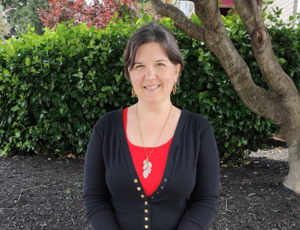
Jessica Feldt joins the Knott Foundation as the Grants & Database Administrator after 21 years in the nonprofit community. She has worked at various history and humanities nonprofits in Pennsylvania, Maryland, and Washington DC and most recently spent five years at Preservation Maryland administering their small grants program, the Heritage Fund. Jessica has a Bachelor of Arts degree from Western Michigan University and a Masters from Penn State University.
Having grown up in Michigan, Jessica now lives in Northeast Baltimore with her husband, daughter, energetic dog, and two cats.
Working alongside our Program Director Kathleen McCarthy, Jessica is “excited to join the Knott Foundation and to have the chance to help support its work.” We are certainly excited to have Jessica on the team and know that she will be a huge support to our grantees and community partners.
06-02-2023
Martin G. Knott, President of the Marion I. and Henry J. Knott Foundation’s Board of Trustees, announced that the Foundation has selected Kelley Q. Kilduff as its new Executive Director.
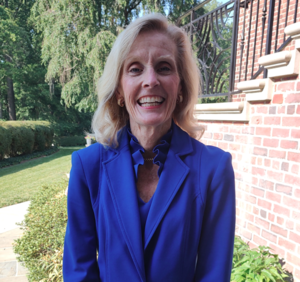 “Kelley Kilduff’s long career with institutions that underscore and strengthen Catholic values will be a terrific asset for our family foundation as we continue the work my parents began over 45 years ago. Her energy and enthusiasm for our mission, along with her accomplished history and leadership experience, will carry us forward in the years to come,” Knott said.
“Kelley Kilduff’s long career with institutions that underscore and strengthen Catholic values will be a terrific asset for our family foundation as we continue the work my parents began over 45 years ago. Her energy and enthusiasm for our mission, along with her accomplished history and leadership experience, will carry us forward in the years to come,” Knott said.
Kilduff will assume her new position at the Foundation on June 12 after completing nearly a decade at Notre Dame of Maryland University (NDMU), where she has most recently served as their Vice President for Institutional Advancement and Communications.
Prior to NDMU, Kelley held leadership positions at Maryvale Preparatory School, Sts. Peter and Paul Schools in Easton, and Mount de Sales Academy, as well as being a Regional Director of Major Gifts for Catholic Relief Services and Director of Marketing for the American Cancer Society, both in Orlando. Kilduff holds a Master’s in Business Administration from the University of Central Florida and a Bachelor’s of Science in Communication Studies from Northwestern University.
Kilduff replaces Kelly C. Medinger, who led the Foundation since 2012. Medinger resigned from the Foundation in December 2022 but has continued to advise the Trustees and Executive Team during this period of transition.
“I am honored to partner with the Knott Foundation's Board of Trustees and Executive Team to continue to advance the mission and legacy of their founders, Henry and Marion Knott,” stated Kilduff. “In addition, Kelly Medinger's leadership was transformational, and I am grateful for her dedication and support. She and the Foundation have led the way in values-driven philanthropy,” Kilduff reflected.
“On behalf of the Board of Trustees, I would like to thank Kelly Medinger for her years of helping to grow and professionalize our work in the Maryland philanthropic and Catholic communities, and extend a very warm welcome to Kelley Kilduff as our new Executive Director,” Knott said.
02-18-2023
Celebrating 45 years of giving back to the community
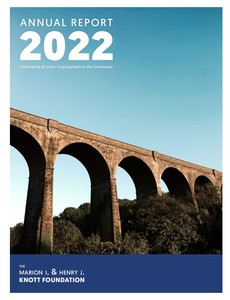 We are pleased to announce the publication of our 2022 annual report.
We are pleased to announce the publication of our 2022 annual report.
“Celebrating 45 years of giving back to the community,” is the theme of our report.
In addition to celebrating a milestone in our history as a Catholic family foundation, the year 2022 brought a good deal of change to the Knott Foundation, which our President details in his opening letter.
With over $2.8 million in grants being awarded to organizations in our various program areas, our annual report showcases the Knott Foundation's giving to the many different types of organizations we support across central and western Maryland.
Thank you for your interest in our work as we celebrate 45 years of giving back to the community.
By Kathleen McCarthy
02-14-2023
Announcing our most recent grant recipients in Catholic activities, education, health care and human services
We are pleased to announce that 17 organizations received over $850,000 in our February grant cycle.
Catholic Activities
- Jesuit Volunteer Corps: $30,000 to support the general operations of their Baltimore-based programming, linking young people who are committed to putting their faith in action with local nonprofits serving communities in need
- Sisters of St. Francis of Assisi: $45,000 to support a memorial project to honor and reflect the mission, history, and values of the Franciscan Sisters of Baltimore, founders of St. Elizabeth School and the Franciscan Center of Baltimore
- St. Augustine Church: $27,000 to support the replacement of the front stairs at this parish based in Williamsport; one of three parishes comprising the Pastorate, The Catholic Parishes of South Washington County
Education
- Dyslexia Tutoring Program: $55,000 to support the general operations of this specialized tutoring program providing services free-of-charge to low-income children and adults with language-based learning differences
- Improving Education: $45,000 to support the expansion of this early childhood literacy program’s work into additional Catholic Charities supported Head Start sites throughout Baltimore City
- The Loyola School: $115,000 to support (re)construction work enabling this high-quality tuition-free school to expand their mission from pre-K to pre-K through grade 4
- St. Maria Goretti High School: $80,000 to support the acquisition of transportation to better serve the student population attending this Archdiocesan Catholic high school in Hagerstown
Health Care
- Community Free Clinic: $45,000 to support general operating costs associated with the Community Mental Health Care Center serving as a safety net provider for Washington County residents who are uninsured
- Gilchrist Hospice Care: $50,000 to support charity care hospice services for patients in need at Gilchrist Center Baltimore located in the Waverly neighborhood
Human Services
- Caroline Friess Center: $45,000 to support operational costs for this organization’s tuition-free career and life skills educational program serving unemployed and underemployed women in Baltimore
- Fuel Fund of Maryland: $15,000 to support energy assistance to single-parent households through the newly launched Power of One program
- Heartly House: $45,000 to support the general operations of this Frederick County based nonprofit providing comprehensive services, free of charge, to survivors of domestic violence and sexual abuse
- The Light House: $20,000 to support the implementation of a Landlord Engagement Strategy with the goal of increasing permanent housing opportunities and decreasing the number of individuals and families experiencing homelessness in Annapolis and throughout Anne Arundel County
- Living Classrooms Foundation: $35,000 to support the general operations of Project SERVE, a community service and job-training program for unemployed and disadvantaged adults in Baltimore City
- Partners in Care Maryland: $50,000 to support the general operations of the Anne Arundel County site supporting the independence of older adults ages 60+ through service exchanges and community building
By Christina Rickman
02-01-2023
The importance of unlearning, rethinking, and staying open-minded
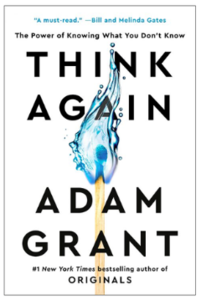
For this newsletter’s edition of What We’re Reading, we decided to do something different: instead of one staff member reading and reflecting on a book on her own, a book club was established! All (two) staff members read the same book and met to think out loud about it together. Our inaugural book, Think Again: The Power of Knowing What you Don’t Know by Adam Grant, was chosen by Program Director, Kathleen McCarthy.
In Think Again, Adam Grant, an organizational psychologist, top-rated professor at Wharton, best-selling author, and one of the world’s 10 most influential management thinkers, explores the process of – and benefits to – unlearning and rethinking. Pulling together wide-ranging studies and personal stories, Adam makes a compelling case that by eschewing comfort and conviction in favor of curiosity and, at times, discomfort, we can change both ourselves and the world.
He suggests that there are four roles we can assume: scientist, politician, prosecutor, and preacher. It would benefit us to act as scientists are trained to do – to ask questions and revise our opinion based on new information. However, all too often, people prefer to cling to their beliefs and slip into the role of a preacher delivering sermons to protect and promote their beliefs, a prosecutor determined to find flaws and prove the other side wrong, or a politician campaigning for support and approval.
Both Kathleen and I enjoyed this book, and we hope you enjoy the snippets of our conversation below:
Christina: Thank you for taking the initiative and choosing a book for us! What made you pick this one?
Kathleen: I’ve been a casual fan of Adam Grant’s work for some time and was reminded of him more directly during Kelly Medinger’s farewell address to the Board. I had been thinking of ways to do a team building exercise since we are going through a leadership transition. I was looking for something to ground and guide us through the transition. I’ve been here for 16 years, and worked with Kelly for 12 of those years, so her departure marks a big change. You get into a routine, and when that routine is upended, it presents an opportunity to examine your ways of thinking. I thought this book would be perfect – and a good way to give us a common language to think differently.
Christina: It was indeed. What did you like about it?
Kathleen: It was written in a very approachable style, and I like that he broke out the four personalities – the preacher, prosecutor, politician, and scientist. I liked that framing a lot. We got the book as a group around the holidays and I used those lenses to look at my family and how we relate to one another, how we go in and out of roles, and to take a look at myself and how I fit into that. How about you?
Christina: I thought the main message, to be aware of what you don’t know and open to learning and understanding, is really important right now. The internet was meant to increase knowledge sharing and understanding and in some ways it has, but in other ways the opposite has occurred. We are increasingly polarized, siloed, and unmotivated to seek out challenge networks.
Kathleen: I agree. With the internet, we’re all armed. I’ll be having a conversation, but I’m not paying attention to what the other person is saying because I’m looking for articles online to support my opinion. It’s like “boom boom here’s all my data”. We now have this world of factoids available to us at all times, and we’ve stopped really listening to each other, we’re just lobbing data grenades at each other. I’m guilty of it and you don’t get anywhere with it. A productive conversation is a dance, not a battle. This book helped me see that the best question to ask is how? Can you tell me how you came to that decision? Walk me through the steps. It’s not a question I ever think of asking, but it leads to more learning and better understanding for both sides than an exchange of facts.
Christina: I completely agree. Regardless of whether two parties agree in the end, if you can come out of a conversation feeling like you approached it with curiosity and respect rather than in preacher, prosecutor, or politician mode, the relationship will be better and you’ll feel less gross afterward. Any other takeaways?
Kathleen: I’m a reluctant skeptic at heart so I have a hard time imagining that open mindedness is a teachable skill once someone is a fully formed adult. What’s the best way to teach open mindedness?
Christina: I think it’s by modeling it, and hoping they respond in the same way.
Kathleen: I agree, and I think creating a challenge network is important as well. Things change, and it’s important to seek out those new ways of thinking and stay receptive to them.
Christina: I love that, and Adam Grant touches on that as well. One of my favorite quotes from the book is “We laugh at people who still use Windows 95, yet we cling to opinions that we formed in 1995.”
On that note... happy rethinking from the Knott Foundation!
By Martin G. Knott
01-01-2023
Kathleen McCarthy promoted to Program Director
Happy 2023!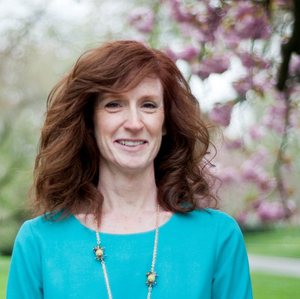

An exciting and very important change to the Executive Team has occurred. Here is why and how we chose this path.
The Knott Foundation is unique in that our volunteer board members (all 33 of whom are family) support the work of the Foundation by serving on multiple committees and conducting the majority of site visits with potential grantees. Site visits provide a deep insight into the inner workings of non-profits seeking financial support. These visits also give the Foundation a bird’s eye view of the needs of communities we serve across Maryland.
A common thread from the grantees has been that the access to the Executive Team is paramount to providing a better understanding of what information is important to formulating their potential grant proposal. In my experience and that of a host of the Board, the most repeated comment is the value of one very special person the Executive Team. That individual is Kathleen McCarthy.
Kathleen joined the Foundation in a part time role in 2007 and went full time in 2008. Her insight and openness, along with a passion for helping grantees in a plethora of ways are essential to every aspect of our giving. Kathleen played a key role in implementing suggestions regarding policies and procedures. These adjustments have made us stronger and somewhat more flexible. Because of the above and a host of other reasons articulated by grantees (like kindness, empathy, strategic suggestions, and availability) Kathleen McCarthy has been promoted to Program Director. In this new role, her duties have increased dramatically along with her responsibilities and authority. The Knott Foundation is delighted that Kathleen has chosen to accept this promotion and is fortunate to have her continue on the Executive Team.
On a personal note, Kathleen is a joy to work with and I look forward to learning from her vast knowledge and experiences. Please join me in congratulating Kathleen.
By Lindsay R. Gallagher
10-31-2022
Announcing our leadership transition and search
Dear Friends and Colleagues,
I’m writing to share that Kelly Medinger, our most trusted and valued Executive Director of the Knott Foundation for the last decade, has shared her intentions to resign from her post, effective December 31, 2022.
Kelly will indeed be missed. Her unwavering dedication to our mission, her institutional knowledge of our Foundation, her keen understanding of family dynamics, and her strong team-building with our executive staff have all contributed greatly towards the growth, focus, and stability of our Catholic family foundation. In addition, her interpersonal skills and astute insights always served us well over these many years.
While her shoes will not be easy to fill, we are embarking on a search for a new Executive Director. We are pleased to share that position announcement in this e-newsletter and on our website and look forward to receiving applications from candidates interested in the role.
On behalf of the entire Knott family and Board of Trustees, I extend my sincere thanks to Kelly. Our hearts are full of immense gratitude for her “too numerous to mention accomplishments,” which have left an indelible mark on our 45-year history. We all wish her the best in her future endeavors, and we look forward to welcoming a new Executive Director in the coming months.
With deepest appreciation,
Lindsay R. Gallagher
President
The Marion I. & Henry J. Knott Foundation
By Kelly Medinger
10-30-2022
Sharing my joy and gratitude for this amazing leadership opportunity
Dear Friends and Colleagues,
Since joining the Knott Foundation in 2011, my heart has been full of gratitude. I’ve had the wonderful opportunity to work with a fantastic team of professional staff, an engaged and talented Board of Trustees, and a vast array of nonprofit organizations and community leaders who care deeply about Maryland and its people. Thank you to everyone who has been part of my journey, and thank you to everyone who has helped further the legacy of the Knott Foundation!
The mission, values, and work of the Knott Foundation are truly admirable, and it has been a privilege to serve this organization for so long. I look forward to meeting my successor and helping to facilitate a smooth transition. While I’ll be stepping down as Executive Director at the end of this year, I’ve offered to support the Foundation in a part-time capacity through the start of 2023, in order to assist with the transition in every way I can.
As for me, I’ll be redesigning my professional commitments in light of my current family needs. I hope to find ways to continue the purposeful and service-driven work that I’ve found so fulfilling at Knott, and to cross paths with all of you again soon.
Once more, thank you to my incredible staff, my amazing Board, our entire grantee community, and my fellow colleagues in philanthropy – all of you have made the last decade of my professional life rewarding in so many ways.
Warmest personal regards,
Kelly C. Medinger
Executive Director
The Marion I. & Henry J. Knott Foundation
By Kathleen McCarthy
10-11-2022
Announcing our most recent grant recipients in Catholic activities, education and human services
We are pleased to announce that 15 organizations received over $870,000 in our October grant cycle.
Catholic Activities
- St. Paul Catholic Church: $24,300 to support a roof replacement at this Catholic parish founded 184 years ago in Ellicott City
Education
- Baltimore SquashWise: $78,500 to support the renovation of the historic Greyhound bus terminal into the future permanent home of this Baltimore-based organization, which aims to create opportunities for youth to realize their academic, athletic, and personal potential through the sport of squash
- Boys Hope Girls Hope of Baltimore: $50,000 to support general operating expenses at this residential program serving academically motivated middle and high school students, helping them to become well-educated and prepared for college, careers, and life
- Jemicy School: $78,500 to support technology upgrades at this independent school in Owings Mills serving students in grades 1-12 with dyslexia and other language-based learning differences
- Our Lady of Hope/St. Luke School: $80,450 to support technology upgrades at this PreK-8 Catholic school in Dundalk
- Parks & People: $45,000 to support the Branches Workforce Development Program, an afterschool internship and summer job program for Baltimore City high school students
- Resurrection-St. Paul School: $85,000 to support technology upgrades at this pre-K – 8 Catholic school in Ellicott City
- St. Ursula School: $79,250 to support technology upgrades at this pre-K – 8 Catholic school in Parkville
Human Services
- Associated Catholic Charities: $120,000 to support the creation of an Intergenerational Center to serve as a community hub of Catholic Charities programs and partnerships in West Baltimore
- Associated Charities of Cumberland: $20,000 to support general operating expenses at this organization, which provides emergency support services to individuals and families in Allegany County
- Family Crisis Center of Baltimore County: $25,000 to support safety and security enhancements to the Center’s Emergency Safety Shelter, the only permanent emergency safe shelter for adult and child victims of dometic violence in Baltimore County
- Franciscan Center: $75,000 to support renovations to the Outreach Intake Area and other offices at this organization, which provides emergency assistance and supportive services to economically disadvantaged people in Baltimore City
- Maryland Nonprofits: $45,000 to support general operating expenses at the Maryland Association of Resources for Families & Youth (MARFY), which is a network of child welfare providers working to improve the system of foster care in Maryland
- Project JumpStart: $50,000 to support general operating expenses at the East Baltimore training center, which delivers a pre-apprenticeship training program in construction to Baltimore City residents
- Taking the Lead: $15,000 to support enhancements to the indoor riding arena at this organization providing therapeutic horseback riding for veterans, adults, and children with disabilities in northern Baltimore County
By Kelly Medinger
07-14-2022
Jesuit Volunteer Corps uses Catholic activities grant to support volunteers and partner agencies in Baltimore
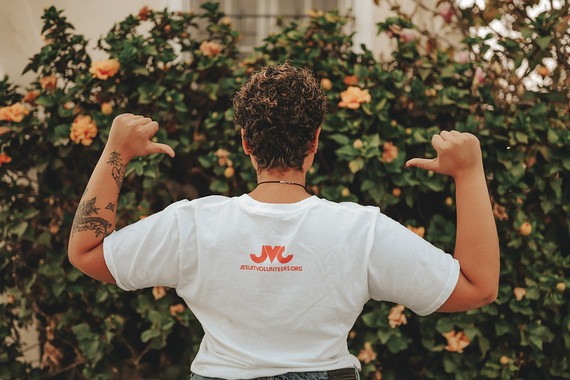 After graduating from Boston College with a degree in business and economics, Codie Perry knew two things: first, he wanted to use his educational background to serve others; and second, he didn’t want to sit in a cubicle all day. Perry applied to Jesuit Volunteer Corps and was placed at St. Vincent de Paul Church in Baltimore City. There, he was charged with running the Church’s outreach ministries in a community experiencing deep poverty.
After graduating from Boston College with a degree in business and economics, Codie Perry knew two things: first, he wanted to use his educational background to serve others; and second, he didn’t want to sit in a cubicle all day. Perry applied to Jesuit Volunteer Corps and was placed at St. Vincent de Paul Church in Baltimore City. There, he was charged with running the Church’s outreach ministries in a community experiencing deep poverty.
“The level of poverty and homelessness was something I had not seen before,” reflects Perry. “It was eye-opening and tough, but also gave my work greater purpose and connected me on a deeper level to the City.”
About Jesuit Volunteer Corps
Over the past 60 years, the Jesuit Volunteer Corps (JVC) has become one of the largest lay, Catholic, full-time volunteer programs in the world. With approximately 200 volunteers each year in 37 cities and 5 countries, Jesuit Volunteers (JVs) put their faith into action through one year of service at nonprofit agencies in high-need communities.
Four core values guide the entire JVC experience: Ignatian spirituality; simple living; community; and social justice. JVs are usually fresh out of college, age 21-25, and enjoy living in community and taking part in professional training and formation, leadership development, and spiritual direction as part of their volunteer experience.
“Orientation reminded me why I chose JVC in the first place. Having a community formed around faith and getting to engage in meaningful conversations was one of the hallmarks of my college experience. Getting to have a community in which I could feel supported in who I am and my faith was very consoling to have as I moved to a new city with new people,” commented one Baltimore JV during orientation week.
Ministering in Baltimore City
Not only is Baltimore the national headquarters of JVC, it is also home to five JVs every year. The Knott Foundation has supported JVC’s presence in Baltimore for over 30 years. The agencies where JVs work in Baltimore have remained consistent for the last several years and include Cristo Rey Jesuit High School, Loyola Early Learning Center, Public Justice Center, and St. Vincent de Paul Beans & Bread/Homeless Outreach.
“It is hard to put the value of the Jesuit Volunteers into a few words!” exclaims Erica Meadows, School Director at Loyola Early Learning Center. “The JVC program is a key part of our school. They are such a positive addition to our team and understand the mission of the school because of their background and experience with Catholic and Jesuit education,” she relays.
As for Codie Perry, he wrapped up his work at St. Vincent de Paul Church five years ago, then returned to his hometown in Massachusetts. Perry recently came back to Baltimore to join the team at Johns Hopkins’ Office of Economic Development. There, he helps grow the small business community and promotes local goods and talent. “Something about my year of service drew me back to Baltimore,” he admits. “I was inspired by how many people and organizations are dedicated to bringing justice and peace to this community, and I wanted to help carry that mantle forward in my own work.”
By Kelly Medinger
07-05-2022
Announcing Carol’s retirement and Christina’s arrival
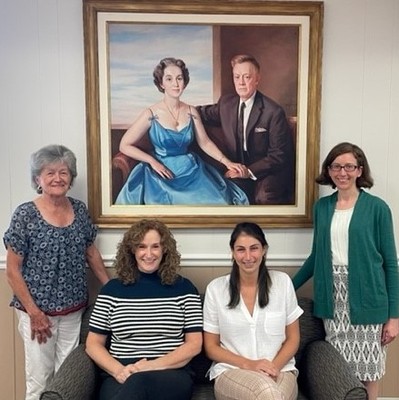 Our longtime Executive Manager, Carol Hoffman, retired this summer after 28 years of service to the Knott Foundation, and nearly 50 years with the Knott family! Carol has been a familiar face at the Foundation’s office for decades, always leading with kindness and grace. We are excited for her to enjoy this next phase of her life, and we thank her for her many contributions to the Foundation over the years. She will be dearly missed!
Our longtime Executive Manager, Carol Hoffman, retired this summer after 28 years of service to the Knott Foundation, and nearly 50 years with the Knott family! Carol has been a familiar face at the Foundation’s office for decades, always leading with kindness and grace. We are excited for her to enjoy this next phase of her life, and we thank her for her many contributions to the Foundation over the years. She will be dearly missed!
In May, Christina Rickman joined our team as Carol’s replacement. Aware that she has big shoes to fill, Christina is excited to bring her accounting and non-profit administration experience and passion for philanthropy to her role as Business Manager. Previous to joining the Knott Foundation, Christina served as the Accounting Manager at Baltimore Lab School. She regularly volunteers with Blue Water Baltimore to build parks and plant trees in low-income neighborhoods across Baltimore City.
Christina holds a Masters of Business Administration from University of Maryland’s Robert H. Smith School of Business and a Bachelor of Arts from St. Mary’s College of Maryland. Originally from Towson, she now lives in Hampden and enjoys reading, hiking with her dog, and trying new restaurants.
Our best wishes to Carol (pictured standing left), and our warmest welcome to Christina (pictured sitting right)!
Book Review by Christina Rickman
07-05-2022
A reflection on the ways in which human beings gather and a guide on how to do it better
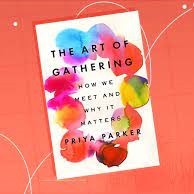 For my first contribution to the Knott Blog, I read The Art of Gathering: How We Meet and Why It Matters by Priya Parker. This book is presented as a “how to” transform your gatherings into meaningful and memorable experiences for you and your guests – whether a small dinner party for close friends, an industry networking event, or a company board retreat. Parker’s experience immediately impresses, and her lessons are drawn from both her personal life and her career as a strategic advisor and facilitator for events as wide-ranging as a conclave for council members from the World Economic Forum to a major city’s outdoor book festival.
For my first contribution to the Knott Blog, I read The Art of Gathering: How We Meet and Why It Matters by Priya Parker. This book is presented as a “how to” transform your gatherings into meaningful and memorable experiences for you and your guests – whether a small dinner party for close friends, an industry networking event, or a company board retreat. Parker’s experience immediately impresses, and her lessons are drawn from both her personal life and her career as a strategic advisor and facilitator for events as wide-ranging as a conclave for council members from the World Economic Forum to a major city’s outdoor book festival.
Written in 2018, Parker’s motivation to write this guide undoubtedly stems from the struggle to find time to connect, be present, and gather meaningfully in today’s distraction-filled world. However, it was also a fascinating read viewed through the lens of the COVID-19 pandemic. The need to protect ourselves from a deadly virus provided human beings with an unparalleled opportunity to examine the ways in which we gather. Amidst the loneliness, sadness, and fear, a silver lining to the abrupt hiatus of gathering emerged: people had time to reflect on the habitual, traditional, and compulsory formats of gathering. People realized that many of their gatherings, or the format in which those gatherings occurred, did not fulfill a meaningful purpose or bring them joy. The realization applied not only to professional spheres but to gatherings with friends and family. The human desire to socialize and collaborate – to celebrate, create, or grieve with others – will always exist, but our conventional ways of gathering often fail to help us achieve our purpose.
In many ways, this book offers a solution to a problem that Parker saw in 2018 but many of us only realized during the pandemic. Given the opportunity to gather again, her insights equip us with a way to design our gatherings to provide higher purpose, meaning, and most importantly, connection.
I’ll admit, I began this book interested in the author’s experiences and theories, but skeptical much of her advice could be applied to my own life. To my surprise and delight, I finished this book not only thoroughly convinced of the universality of Parker’s guidelines, but feeling eminently prepared to apply her advice to my life. Three of my favorite pieces of advice from Parker follow:
- Decide on why you’re really gathering: This may sound like an obvious instruction, but as Parker demonstrates, we often skip this step and immediately focus on the logistics: Who should we invite? What should we serve to eat and drink? In doing so, we exhaust ourselves with planning details and lose sight of the higher purpose of any gathering – to connect as human beings. Parker warns against equating category with purpose. A dinner party is a category that can have many purposes – to celebrate long-lasting friendships, to introduce couple’s respective friends, to provide support to a friend going through a difficult time. Likewise a board retreat is a category with many possible higher purposes – to recover from a difficult quarter, to recruit new members, to provide time for the board to get to know the new CEO. If we are not clear about our purpose, we often end up repeating traditional formats of gathering and lose the opportunity to create a meaningful experience for our guests. Once you have committed to a strong purpose, choices around logistics will flow naturally.
- Don’t be a chill host: Parker claims that, “chill is selfishness disguised as kindness.” When people attend gatherings, “they want to be governed – gently, respectfully, and well.” As hosts, we often feel like our job is done once guests have crossed the threshold into our event. At that point, however, it is crucial for a host to recognize and continue to exercise their authority. Parker explains that when a host fails to take responsibility for a gathering, often out of a desire not to appear domineering or be annoying, they are not relieving their guests. In actuality, they are leaving them up to the mercy of one another, some or many of whom are likely to act in a way inconsistent with the gathering’s purpose. By gracefully wielding your power as a host, you protect both your guests and the gathering’s purpose.
- Pop-up rules are better than etiquette: One of my favorite of Parker’s guidelines is to provide your guests with rules for your gathering rather than relying on etiquette, or as she puts it, “random knowledge of how rich people want you to behave.” In today’s increasingly diverse world, your gatherings are likely to include people from an assortment of upbringings. To expect attendees to have an implicit understanding of how to act when etiquette is culturally-based is unrealistic and unfair. Rules help you equalize you quests – please use first names only at this conference - and can also be fun – wear all white, take a funny photo with three different guests, don’t miss the flight home. As Parker puts it, “Etiquette allows people to gather because they are the same. Pop-up rules allow people to gather because they are different – yet open to having the same experiences.” Nervous about enforcing rules at your annual conference or family’s Thanksgiving? Refer to rule two!
By Kathleen McCarthy
06-21-2022
Announcing our most recent grant recipients in Catholic activities, education, health care and human services
We are pleased to announce that 19 organizations received over $925,000 in our June grant cycle.
Catholic Activities
Education
- Baltimore Lab School: $15,000 to support playground renovations at this nonpublic school in Baltimore City, which educates and supports children with learning differences in grades 1 – 12
- Bishop Walsh School: $90,000 to support technology upgrades at this K – 12 Catholic school in Cumberland
- First Tee - Greater Baltimore: $40,000 to support the ACE Scholars Program, an intensive study program combining golf, academic supports, and character education, for high school youth in the Baltimore area
- Immaculate Heart of Mary School: $89,500 to support electrical upgrades and air conditioning units at this pre-K – 8 Catholic school in Towson
- Irvine Nature Center: $15,000 to support nature-based educational opportunities for students attending selected Catholic schools in Baltimore City
- Junior Achievement of Central Maryland: $50,000 to support the delivery of JA’s flagship economic education programming – JA BizTown and JA Finance Park – to students attending Catholic elementary and middle schools throughout the Archdiocese of Baltimore
- LET’S GO Boys and Girls, Inc: $45,000 to support the general operations of this organization providing STEM education and workforce development opportunities to youth in Baltimore City with the goal of breaking the cycle of generational poverty
- Mount Saint Mary’s University: $60,000 to support the purchase of equipment for the environmental sciences program, at this private liberal arts Catholic university in Emmitsburg
- Notre Dame Preparatory School: $50,000 to support outdoor lighting enhancements designed to improve athletic field access and security at this Catholic, independent school for girls in grades 6 – 12 in Towson
- Sisters Academy Baltimore: $50,000 to support management consulting as this independent, tuition-free Catholic middle school for girls in grades 5 – 8 in southwest Baltimore
- St. John Regional Catholic School: $80,000 to support technology upgrades at this pre-K – 8 Catholic school in Frederick
- Trinity School: $70,000 to support technology upgrades at this pre-K – 8 independent Catholic school in Ellicott City
Health Care
- Mission of Mercy: $50,000 to support the general operations of this community-based health clinic providing free medical and dental care to patients in Frederick, Carroll and Baltimore Counties
- Mount Washington Pediatric Hospital: $25,000 to support the Trauma and Healing Program, which provides mental health assessments, treatment, and consultation services to children and their families at this pediatric sub-acute hospital in Baltimore
- Shepherd’s Clinic: $30,000 to support the general operations of this holistic medical clinic, providing a medical home for the uninsured and underinsured living in and around the Coldstream Homestead and Montebello neighborhoods of Baltimore City
Human Services
- Pathfinders for Autism: $31,800 to support the creation of a new safety curriculum teaching teens and adults with ASD and law enforcement officers community safety skills and how to interact with each other
- Paul’s Place: $75,000 to support GroundWork Kitchen’s Culinary Arts Training Program, a social enterprise workforce development program in southwest Baltimore City
- Sexual Assault/Spouse Abuse Resource Center (SARC): $25,000 to support the second phase of the renovation and expansion of their facilities, at this organization serving women and children fleeing domestic violence in Harford County
Book Review by Kathleen McCarthy
03-16-2022
Seeking to find flow, engage in play, and grant ourselves the grace and space to think deeply
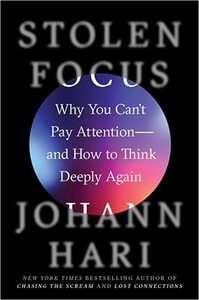 I had a hard time selecting a book to read for the purposes of this blog post, and I think that it had a lot to do with being distracted. Like so many others, I find myself increasingly distracted; consumed by an overabundance of tasks, information, and obligations, so that taking a moment to select and read a book felt like a great indulgence.
I had a hard time selecting a book to read for the purposes of this blog post, and I think that it had a lot to do with being distracted. Like so many others, I find myself increasingly distracted; consumed by an overabundance of tasks, information, and obligations, so that taking a moment to select and read a book felt like a great indulgence.
To make the selection, I turned to the recommended reading list of Adam Grant, bestselling author and professor of organizational psychology at the Wharton School. When I saw Johann Hari’s book Stolen Focus on this list and its assurance of explaining to me why I can’t pay attention, I thought, “Count me in!”
Hari’s book is an engaging mix of journalistic inquiry, historical research, and personal memoir. Looking back as far as ancient Rome, Hari draws a map that confidently argues that the distance between distraction and deep thought has been collapsing for a long-time, and has exponentially accelerated over the past two decades with the introduction of technology apps designed with a business model built around “screen time, not life time.”
Most humans spend their days staring at screens, scrolling images, scrambling to keep up. We tell ourselves we are being productive as we move at this pace. While many of us like to think that we are multi-tasking, Hari’s book points out that in fact, multitasking is a term “created in relation to computers, not humans.” What we are in fact doing is juggling – switching back and forth between tasks – and it is actually degrading our ability to focus, and has been shown in studies to lower worker’s IQs and productivity.
In addition to juggling, we are a society constantly besieged by interruptions. Research has shown it takes, on average, twenty-three minutes for one’s attention to return to a state of refocus after an interruption. Hari states, “If you have been interrupted enough in your daily life, you will start to interrupt yourself even when you are set free from all these external interruptions.” I find this to be true in my own life; sitting still to read a book is always fraught with thoughts of ‘output’ and even laziness.
It would be easy to place the blame solely on the tech industry for the degradation of our ability to focus and think deeply. However, Hari’s book highlights how systems and conditions such as global economic growth, pollution, lack of sleep, poor diet, and the loss of play and the time to daydream contribute to what ails us as well. In some ways, I found these observations to be of the greatest interest: We haven’t been driven to distraction, but have instead been programmed into it by our environment and business models that are based upon viewing humans as data sets to be bought and sold. We have become a society under a constant state of interruption, which has led to sleep disturbance, poor nutrition, inflated intellectual confidence, and anxiety.
Regardless of the trigger, the overarching outcome of our ever decreasing ability to focus weighs heavily on our ability as a society to feel empathy for others and to solve complex problems. Watching what has unfolded across the world (online and IRL) over the past two years has been sobering and left many attention casualties in its wake. Like Hari, I feel that if left unaddressed, what we have witnessed will only get worse.
Offering both actionable individual solutions and societal approaches, Hari’s book, Stolen Focus, is a fascinating exploration of the systemic destruction of our attention. And, as Hari states himself, “No answer will be perfect but if we wait for perfection, we will be waiting forever.”
Pre-committing to a plan of action, installing apps that cut access to the internet at programmed intervals, and using a timed lock box are some of the suggestions Hari offers (and uses himself) to reduce distraction and promote focus. This reader is not quite willing to lock myself down just yet; however, I have taken the step of disabling notifications on my cellphone so that I no longer hear or feel the vibration – the siren song if you will – of distraction. Additionally, after reading Stolen Focus, I have found myself thinking more deeply about how I am consuming information about our world. In doing so, I can definitely see where my understanding of the most pressing issues of our day has been dulled by moving too quickly.
In the end, Stolen Focus gave me the opportunity to look more carefully at the downstream effects of my own behavior of consuming information and approaching daily tasks, and it has inspired me to spend less time scanning and more time reading deeply.
By Kelly Medinger
03-15-2022
Rooted in Faith, Family & Community
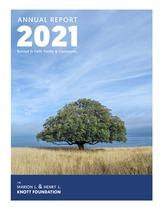 I am pleased to announce the publication of our 2021 annual report.
I am pleased to announce the publication of our 2021 annual report.
“Rooted in faith, family, and community,” is the theme of our 2021 annual report.
Our mission to strengthen the community in concert with our identity as a Catholic family foundation resulted in a fruitful year in 2021, with over $2.3 million in grants being awarded to organizations in education, human services, Catholic activities, health care, and the arts & humanities. We hope you enjoy reading about our giving where we spotlight stories about our grants in our five program areas.
Thank you for your interest in the Knott Foundation as we nurture and celebrate our roots in faith, family, and community.
By Kelly Medinger
03-10-2022
Walters Art Museum uses arts & humanities grant to restore a rare statue of St. Michael the Archangel
 “Conservation and repair of our collective cultural heritage is key to our understanding of world history and the universal human need to create,” observes Julie Lauffenburger, Director of Conservation, Collections, and Technical Research. “Works of art that have been preserved and shared with the public help bring history to life and foster conversation about world events, religion, culture, and life in periods beyond our own.”
“Conservation and repair of our collective cultural heritage is key to our understanding of world history and the universal human need to create,” observes Julie Lauffenburger, Director of Conservation, Collections, and Technical Research. “Works of art that have been preserved and shared with the public help bring history to life and foster conversation about world events, religion, culture, and life in periods beyond our own.”
About the Walters Art Museum
Established in 1934, the mission of the Walters Art Museum is to bring art and people together for enjoyment, discovery, and learning.
Located in Baltimore’s historic Mount Vernon neighborhood, the Walters offers free admission to all visitors. The museum’s campus includes five buildings and 36,000 art objects from the Mediterranean, Africa, East Asia, Europe, the Middle East, and the Americas. By collecting, preserving, and interpreting art, the Walter’s creates a space for people of every background to engage in dialogue and be touched by art.
About St. Michael the Archangel
St. Michael is an archangel in Judaism, Christianity, and Islam. In Roman Catholic tradition, St. Michael is the guardian of the Church and the leader of heaven’s forces in their triumph over the powers of evil. He is the patron saint of soldiers, police officers, and doctors.
The Walters collection includes a rare 17th-century ivory sculpture of St. Michael the Archangel, which was not on display for several decades due to needed restoration. The Knott Foundation helped fund conservation treatment that repaired his broken wings and consolidated paint and gilding loss on the statue.
Today, Michael stands nearly four feet tall, with long hair, wings, pleated skirt, sash, and boots. He holds a sword above his head as he stands on the body of the devil. The size and detail of the St. Michael statue are rare, and it would have been an expensive and high value sculpture to produce.
A Story of Global Trade
When it came into the collection in the early part of the 20th century, the St. Michael statue was believed to have been made in Italy during the Renaissance period. However, further research revealed his true origins.
“This striking 17th century sculpture was made in Manilla from African elephant tusks for a church in Mexico,” reveals Katarina Ziegler, Director of Institutional Giving & Government Affairs. It was created as a devotional statue for a Mexican church, by an artisan in the Philippines, with material from Africa. “What a remarkable story of global exchange of ideas, art, crafts, materials, and faiths!” she exclaims.
The St. Michael statue is a physical embodiment of early international trade routes and the spread of Catholic iconography and beliefs throughout the world. Its history is a marriage of three continents, dating back some 400 years. It is a global treasure in our own local art museum.
By Kathleen McCarthy
02-23-2022
Announcing our most recent grant recipients in Catholic activities, education and human services
We are pleased to announce that 17 organizations received over $850,000 in our February grant cycle.
Catholic Activities
- Shrine of the Little Flower: $40,000 to support restoration of the grand pipe organ, a significant component of this Catholic church’s culture of celebration and community in Baltimore City
- St. Michael the Archangel Church: $75,000 to support the restoration and repair of the stained glass windows in this 100+ year-old Catholic church in the Overlea-Fullerton neighborhood of Baltimore County
Education
- ¡Adelante Latina!: $20,000 to support alumnae and family outreach at this organization providing after-school and college access programming to promising Latina girls in grades 10 – 12 who attend Baltimore City high schools
- Chesapeake Bay Outward Bound School: $50,000 to support outdoor experiential education programs and character development at three Catholic schools located in the Archdiocese of Baltimore
- Cristo Rey Jesuit High School: $50,000 to support a 1:1 technology program at this Catholic Jesuit high school in Baltimore City that combines college-preparatory education with corporate work experience
- Mercy High School: $120,000 to support HVAC upgrades at this Catholic, independent, all-girls high school located in Baltimore City
- Project Pneuma: $45,000 to support the expansion of this holistic after-school program providing academic and social-emotional support to young Black males in grades 4 – 8 in Baltimore City
- Saint John’s Catholic Prep: $95,000 to support the final phase of this Catholic, independent high school’s capital campaign and stadium project in Frederick County
- Sisters Circle: $50,000 to support the general operations of this long-term mentoring program serving at-risk girls from Baltimore City, starting in sixth grade through college and career
- St. Michael – St. Clement School: $65,000 to support technology upgrades at this pre-K-8 Catholic school in the Overlea-Fullerton neighborhood of Baltimore County
- Thread: $42,500 to support the general operations of this long-term mentoring program serving underperforming high school students in Baltimore City, providing them with a family of committed volunteer mentors and encouraging them to become self-motivated, resilient, and responsible citizens
Human Services
- Associated Catholic Charities, Samaritan Center: $40,000 to support My Sister’s Place Women’s Center’s housing program, called the Samaritan Center, and their efforts to provide clients in Baltimore City with direct financial assistance for rent, case management, and traveler's assistance to help build each client’s financial stability
- Baltimore Outreach Services: $10,000 to support the general operations of this emergency shelter serving women and children in Baltimore City
- Cornerstone Community Housing: $45,000 to support the general operations of Earl’s Place, a transitional housing program serving men recovering from substance abuse and homelessness in Baltimore City
- Marian House: $91,200 to support the renovation and construction of housing for women and their families experiencing homelessness and other instability as part of this holistically focused housing and supportive services organization in Baltimore City
- Religious Coalition for Emergency Human Needs: $40,000 to support the general operations of the new, permanent Emergency Family Shelter Program serving homeless families in Frederick County
- Women’s Housing Coalition: $15,000 to support the general operations of this organization that serves individuals and families experiencing homelessness by providing permanent, affordable housing and supportive services in Baltimore City
Book Review by Kelly Medinger
10-29-2021
An exploration of grit and how you can grow it from the inside out
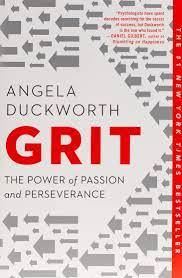 I recently picked up Angela Duckworth’s Grit: The Power of Passion and Perseverance (Scribner, 2016). Dr. Duckworth is a psychology professor at the University of Pennsylvania, and her stated purpose in life is “to use psychological science to help kids thrive.”
I recently picked up Angela Duckworth’s Grit: The Power of Passion and Perseverance (Scribner, 2016). Dr. Duckworth is a psychology professor at the University of Pennsylvania, and her stated purpose in life is “to use psychological science to help kids thrive.”
She opens the book with her central hypothesis: “What we eventually accomplish may depend more on our passion and perseverance than on our innate talent.” Hence, her focus on the psychological asset of grit.
Grit is what goes through our heads when we fall down or get side-tracked. It’s the trait that carries us through the marathon of life, and is “more about stamina than intensity” explains Duckworth. She describes grit as a special blend of passion and endurance that pushes us to keep going, in good times and in bad.
After presenting data and anecdotes about how grit is often the best predictor of success, Duckworth offers a four-part recipe for growing your own grit from the inside out:
- Find & Develop Your Interests: Passion comes from life experience. “Nobody is interested in everything, and everyone is interested in something,” writes Duckworth. Therefore, she says we need to try things on for size throughout our lives, to help us discover what ignites our passion. Then we should seek to develop and deepen our knowledge in that area. “Ask yourself a few simple questions,” she advises. “What do I like to think about? Where does my mind wander? What do I really care about? What matters most to me? How do I enjoy spending my time? And, in contrast, what do I find absolutely unbearable?” These questions help identify interest, the first ingredient for grit.
- Practice with Intention: Practice takes energy and effort to make it deliberate and worthwhile. It also takes a significant amount of time, which is why “the ten-thousand hour rule” and “the ten-year rule” have been widely popularized. Eventually, however, good practice is rewarded by something called “flow” – the ease and exuberance you experience when you really hit your stride. Duckworth states, “Gritty people do more deliberate practice and experience more flow.”
- Connect to a Broader Purpose: Purpose is what motivates us to help others through our work. Duckworth believes we need that level of inspiration to find a deeper meaning in what we do, and to become grittier. She recommends reflecting on the work you already do, and how you are making a difference in the world, or thinking about how you could make small, meaningful changes to better connect to your core values.
- Embrace Hope: Optimists and pessimists are equally likely to encounter adverse events, but gritty people tend to explain these events in more positive terms, such as how they can learn from them. Duckworth connects this ingredient to her colleague Carol Dweck’s research on a growth mindset (see my coworker Carol Hoffman’s review of that book here). In short, a growth mindset helps you be grittier, and even leads you to seek out new challenges that make you stronger in the long-run. Here, Duckworth recommends that we recognize our intelligence and talent can substantially change throughout life, that we “practice positive self-talk,” and that we ask for help when we need it.
Ultimately, grit is a book about how passion and perseverance trump innate talent in achieving goals. It is a tome that makes us all feel like players in the game of life, where we can discover, set, nurture, and relentlessly pursue our own destiny.
By Kelly Medinger
10-27-2021
The Pro Bono Counseling Project uses health care grant to connect caregivers to donated therapy sessions
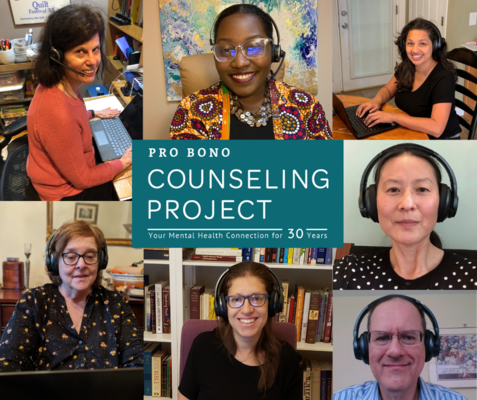 When 30-year old Jasmine moved home to take care of her father with cancer and mother with depression and hoarding issues, she needed someone to help her through the grief, pain, and psychological stress of becoming a caregiver. Enter Pro Bono Counseling Project.
When 30-year old Jasmine moved home to take care of her father with cancer and mother with depression and hoarding issues, she needed someone to help her through the grief, pain, and psychological stress of becoming a caregiver. Enter Pro Bono Counseling Project.
About Pro Bono Counseling Project
Pro Bono Counseling Project (PBCP) connects individuals, couples, and families living in Maryland to free mental health services, whether they are experiencing stress, anxiety, sadness, grief, a life transition, or relationship issue.
“We really work with folks to make a good match between patient and therapist,” describes Amy Greensfelder, Executive Director. “This fit is the most important predictor of success in therapy. We interview people up front to find out what they’re looking for in a therapist, and we use our extensive network of clinicians to find the best match.”
Founded over 30 years ago, PBCP has helped over 30,000 Marylanders find volunteer counselors and receive the therapy they otherwise could not afford. Over 850 volunteer clinicians work with PBCP’s clients to provide thousands of hours of donated therapy sessions each year.
Caring for Caregivers
PBCP’s Caring for Caregivers program helps people cope with the psychological stress of caring for a loved one with high medical needs or a chronic condition.
“Caregiving is often an unrecognized, misunderstood, and neglected issue in our community. Even caregivers themselves may not identify with the term. Because the vast majority of caregivers are loved ones – a spouse, a parent, a child, or a family member – they might classify ‘caregiver’ as someone who does the job full-time, or is a paid professional,” mentions Greensfelder
Meanwhile, the competing priorities caregivers face, such as work, family, and medical management, often block their ability to take care of their own mental health needs. The Caring for Caregivers program helps these to find the space to “refill their cup,” as Greensfelder puts it.
The Knott Foundation supported PBCP’s Caring for Caregivers program with a grant in 2020. That support enabled PBCP to train more than 40 clinicians in caregiver mental health practices, to answer 41 phone calls from people experiencing caregiver stress, and to serve 30 people with 300 hours of donated therapy – equating to $45,000 of donated care.
Recognizing the Need
Oftentimes people focus on those with the highest need – the parent who just received a cancer diagnosis, the grandparent who is aging in place, or the child who is born with a chronic health condition. While this focus is necessary, it can gloss over the needs of the caregivers.
“The biggest thing is just recognizing these needs in our community and being there when our friends and loved ones step into the role of caregiver,” reflects Greensfelder. “It’s important to make sure people who are supporting the needs of others also support themselves.”
By Kelly Medinger
10-27-2021
Archdiocese of Baltimore uses education grant to build the new Mother Mary Lange Catholic School in Baltimore City
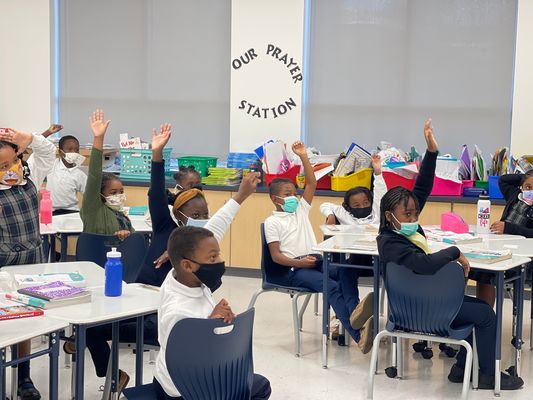 A new, 65,000 square foot school stands proudly on Martin Luther King Jr. Boulevard. A large cross illuminates three stories of windows above the front entrance, which first welcomed students on August 30, 2021.
A new, 65,000 square foot school stands proudly on Martin Luther King Jr. Boulevard. A large cross illuminates three stories of windows above the front entrance, which first welcomed students on August 30, 2021.
Honoring a saintly woman
Mother Mary Elizabeth Lange moved to Baltimore from Cuba. She opened a school for girls of color in her home in Fells Point, which became the only provider of Catholic education to black children in Baltimore during the 19th Century. She also founded the Oblate Sisters of Providence, the first religious order for women of African descent in the United States, and is a candidate for sainthood.
Every floor of the school has an image of Mother Mary Lange.
During the ribbon cutting and blessing of the new school, eighth-grader Jaylah Golder announced to the crowd: “I intend to follow in the footsteps of Mother Lange by leading others to do good and try my best to stand up for those who aren’t big enough to stand up for themselves.”
Enrolling students in a new tradition
Mother Mary Lange Catholic School began its inaugural year with over 400 children in grades pre-K through 8. The students hail from 70 zip codes. Only approximately 20% are Catholic.
“This is not just a job, it’s a ministry,” explains Alisha Jordan, Principal. She has involved the kids in all aspects of the school, from picking their uniforms, to selecting a mascot – the Mother Mary Lange Catholic School Tigers. They also planted two time capsules in front of the school to commemorate its opening and preserve the legacy of the two schools that were consolidated into Mother Mary Lange: the former Holy Angels Catholic School and Saints James and John Catholic School.
Building amenities and partnerships to serve the community
The Knott Foundation contributed to the capital campaign to build the new school.
Once a vacant lot in the City, Mother Mary Lange is now a model of top-notch amenities: fully-equipped art and science labs; a spacious library; a cafeteria and gymnasium with a stage for student productions; a turf field; two playgrounds; and a chapel. “We are the first archdiocesan elementary school in Baltimore to have a tabernacle in the chapel,” comments Jordan. “The Archbishop is very proud of that.”
The school’s health suite also features a partnership with University of Maryland Children’s Hospital, where doctors offer physicals for students and the school nurse has access to a telehealth line during the day. A private health suite, hands-free plumbing, and sanitary devices are new features that were incorporated during construction, which further enhance the school’s focus on student health.
“This is a loving, secure, Catholic community,” concludes Jordan, “and we look forward to becoming part of the social fabric of this neighborhood for many years to come.”
By Kathleen McCarthy
10-15-2021
Announcing our most recent grant recipients in Catholic activities, education, health care and human services
We are pleased to announce that 15 organizations received over $800,000 in our October grant cycle.
Catholic Activities
Education
- Building STEPS: $35,000 to support the expansion of this STEM-focused program serving high-achieving high school students in Baltimore City
- Higher Achievement Baltimore: $50,000 to support salaries, laptops, and student transportation costs at this academic enrichment, out-of-school time program serving students in grades 5 – 8 in Baltimore City
- Maryvale Preparatory School: $100,200 to support technology upgrades at this Catholic, independent school in Lutherville serving girls in grades 6 – 12
- Notre Dame of Maryland University: $120,000 to support the renovation of The Knott Science Center, which is the primary home for all STEM disciplines, on the campus of this private, Catholic university in Baltimore
- One Love Foundation: $30,000 to support the expansion of their programming in Baltimore area Catholic schools, by educating more young people about healthy and unhealthy relationships
- Soccer Without Borders Maryland: $60,000 to support the general operations of this middle-grades out-of-school time program serving newcomer refugee and immigrant youth in Baltimore City and County
- St. Francis Neighborhood Center: $60,000 to support the general operations of the Power Project, an out-of-school time enrichment program serving youth ages 5 – 14 in the Reservoir Hill neighborhood of Baltimore City
- The Catholic High School of Baltimore: $110,000 to support the creation of a fitness and visitation center at this all-girls independent Catholic high school in Baltimore
Health Care
- Horizon Day Camp Baltimore: $32,000 to support bus transportation for children at this full-summer day camp in Baltimore for children with cancer and their siblings
Human Services
- Associated Builders & Contractors Craft Trust: $25,700 to support the creation of a flexible computer lab inside their new education building in Baltimore City to serve young adults in their construction trade apprenticeship program
- Baltimore Hunger Project: $12,500 to support technology purchases designed to improve the operational efficiency of this nonprofit dedicated to eliminating the problem of weekend childhood hunger in Baltimore City and County
- First Fruits Farm: $45,000 to support capital improvements that will enhance and expand the packaging and distribution capabilities of this nonprofit farm, located in Freeland, Maryland, dedicated to providing fresh, nutritious produce to those experiencing hunger in the region
- Hampden Family Center: $40,000 to support the expansion of case management and emergency services at this community hub offering educational and supportive services to families, children, youth, and senior citizens living in the Hampden neighborhood of Baltimore City
- House of Ruth Maryland: $41,000 to support operating costs associated with the clinical program, an essential piece of this nonprofit’s work to address intimate partner violence and provide comprehensive services to women and children so they may rebuild their lives safely and free of fear
Book Review by Carol A. Hoffman
07-12-2021
Everyone who deals with various work and life situations should learn how to negotiate successfully
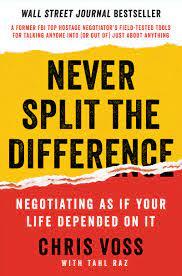 I recently picked up the book Never Split the Difference: Negotiating As If Your Life Depended On It by Chris Voss, after someone recommended it in a meeting I attended.
I recently picked up the book Never Split the Difference: Negotiating As If Your Life Depended On It by Chris Voss, after someone recommended it in a meeting I attended.
Chris Voss started his career in Kansas City, Missouri as an international hostage negotiator with the FBI. He was the FBI’s lead negotiator in situations with a wide range of criminals, such as bank robbers, terrorists, kidnappers, etc. Then Voss went from his key role as an FBI negotiator to his current life situation as head of the Black Swan Group, teaching negotiation skills to business men and women.
In Never Split the Difference, Voss shares many effective principles, strategies, and tactics everyone can use to become more persuasive in their personal and professional life.
For example, you could use some of his strategies when you venture out to buy a car or a home, negotiate your salary, or deliberate with your business partner, spouse, or child. Here are a few of his negotiating techniques that were of interest to me.
Voss explains that negotiations should be approached with the mindset of discovery. This means having the goal to extract as much information as possible. When negotiating, you need to make your counterparty feel understood and positively affirmed. Then you can engage the party in a conversation that will lead them to say, “That’s right,” instead of just, “Yes.” Voss says “that’s right” is a great winning strategy, and oftentimes means the negotiation has been successful.
Another tactic Voss shares is something he calls “label it.” This approach is designed to create trust and tactical empathy so that you can better learn your counterpart’s perspective, and then gain their trust. Labels such as “it seems like,” “it sounds like,” or “it looks like,” can help to defuse negative emotions. Voss describes how people’s emotions have two layers – there is an external side and internal side – and the second layer requires understanding the person’s state of mind, and then offering a solution.
Finally, “bending reality” is a tool Voss puts forward for framing a negotiation in a way the counterparty accepts the limits placed in the discussion. When you “bend reality,” you deploy the idea of fairness and push the person you are negotiating with to realize if they don’t accept your offer, it would be a huge loss to them. In short, you show them that no deal at all is better than what they may perceive as a bad deal.
We can all apply Voss’s negotiation methods to our daily experiences in the workplace. In reflecting on my role as Executive Manager at the Foundation, I see where I have already used some of these tactics myself. Recently, we completed a major capital project on our building, and I had to negotiate with the contractors who performed the work. I frequently have dealings with all sorts of vendors and volunteers, and having read his book, I can see where opportunities exist for richer conversations where we both understand each other’s positions and are able to reach mutually beneficial solutions.
By Kelly Medinger
07-07-2021
St. Veronica’s Church uses Catholic Activities grant to replace their roof
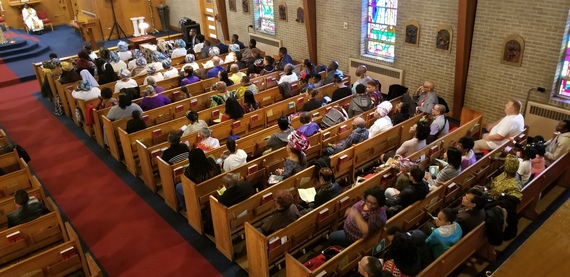 A clean red brick façade with a statue of St. Veronica helping Jesus, surrounded by manicured green grass and shrubbery, stands proudly on Cherry Hill Road in Baltimore.
A clean red brick façade with a statue of St. Veronica helping Jesus, surrounded by manicured green grass and shrubbery, stands proudly on Cherry Hill Road in Baltimore.
About St. Veronica’s
For over 75 years, St. Veronica’s Catholic Congregation has been a community of worship in the Cherry Hill neighborhood of Baltimore City. The Church was established by the Joesephites, a religious community of Catholic priests and brothers, committed to serving the African American community. Today, it serves 230 registered families and attracts parishioners from Cherry Hill, West Port, Curtis Bay, Brooklyn, and Port Covington.
St. Veronica’s is a small church with no paid staff. Nearly half of the congregation volunteers in management, ministry, and outreach services. “People always want to come forth and do something for our parish, and that gives me great joy,” comments Fr. Stephen Ositimehin, Pastor. “Our church doesn’t belong to any one person, it belongs to all of us,” he shares.
Raising the Roof
Realizing that the original roof installed in 1954 needed to be replaced, the Church organized a “Raise the Roof” campaign to raise money for a new roof. With support from parishioners, alumni, their sister parish (Our Lady of Perpetual Help in Ellicott City), the Knott Foundation, and others connected to the mission, St. Veronica’s raised over $150,000 for the project.
“Everybody who pledged to the campaign ended up paying more than they pledged,” shares Cathy McClain, Church Secretary. “When other parishes were struggling to make ends meet during the COVID pandemic, our parish was lucky,” she explains. Some people donated their entire economic stimulus check to the campaign, while others gave what they would have spent on their commute to work, since they were working virtually.
Even the roofing contractor managed to save money by pairing St. Veronica’s job with another one nearby, which enabled them to purchase the necessary lumber at a bulk rate. This was extremely helpful, as lumber prices increased greatly during the pandemic.
Giving Back
Often described as a leader and stabilizing force in the community, St. Veronica’s provides much more than mass, sacraments, and Catholic fellowship. A food pantry, thrift store, healthy cooking classes, summer camp, eviction prevention services, and holiday outreach to families in need are just some of the ways the parish helps the broader community.
“It’s really hard to preach to someone if they’re hungry,” says McClain. “We realize we have to give back in order to receive. Since St. Veronica’s was established, we have always felt it was our responsibility to care for the corporal and spiritual needs of our community.”
By Kelly Medinger
07-07-2021
Franciscan Center uses human services grant to create more healthy meals to feed the hungry
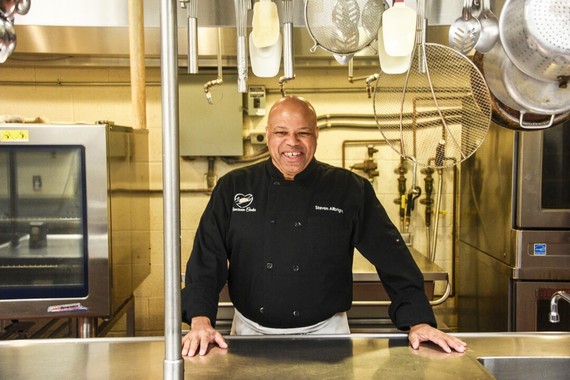 In Baltimore City, a group of red brick row houses sit on West 23rd Street where, in 1968, Sister Irene Marshiano, O.S.F. opened an emergency food and clothing center when local residents told her that’s what they needed most.
In Baltimore City, a group of red brick row houses sit on West 23rd Street where, in 1968, Sister Irene Marshiano, O.S.F. opened an emergency food and clothing center when local residents told her that’s what they needed most.
Now more than 50 years later, the Franciscan Center remains a ministry of the Sisters of St. Francis of Assisi and offers a continuum of care to local people in need – including food, clothing, emergency health services, counseling, and technology training to help clients become as self-sufficient as possible.
A key ingredient for success
A hallmark of the Franciscan Center’s programming is daily hot lunch service. As a longtime supporter of the Center, the Knott Foundation recently made a grant to support the Center’s new culinary director who helps lead their dining services program.
“We believed that a trained culinary chef could change the culture of the Franciscan Center’s dining services, by creating a new way of feeding and a new way of cooking for our patrons,” shares Jeff Griffin, Executive Director of the Franciscan Center.
Enter Chef Steve Allbright, a two-time graduate of Stratford University with an Advanced Culinary Degree and Baking & Pastry Arts Degree, a decorated US Navy Veteran, and an experienced chef at multiple high-end restaurants.
Creating healthier meals
“As much as I appreciate casseroles, I believe cooks are supposed to cook,” proclaims Chef Allbright. In his first year at the Franciscan Center, he partnered with four farms in and around Baltimore to increase the amount of fresh food and vegetables coming into the Center. He also started teaching people how to make healthy and delicious meals with donated provisions.
“Folks eat with their eyes, so we plate what we’re going to serve every day and post it to our Facebook Page,” says Chef Allbright.
By changing the products they were getting and where they were getting them from, the Franciscan Center dramatically reduced its food budget from $125,000 per year to $75,000 per year. They also made other nutritional changes, like serving water instead of a sugary lemon drink traditionally offered to the hot lunch patrons. Then COVID hit.
Expanding during the pandemic
“We’ve just about tripled the amount of food we typically serve during the pandemic,” explains Griffin. The Center changed its model from only serving food at the Center, to adding a meal delivery system, going to apartment complex and homeless encampments throughout Baltimore City.
“By going to where the people are and bringing them healthy meals, we have also created some very helpful conversations and opportunities for our patrons,” comments Griffin. “We are able to help them with more than just food.”
By Kathleen McCarthy
06-18-2021
Announcing our most recent grant recipients in Catholic activities, education, health care and human services
We are pleased to announce that 13 organizations received over $650,000 in our June grant cycle.
Catholic Activities
Education
- Calvert High College High School: $40,000 to support the Campus Ministry Program at this Catholic, college preparatory high school for boys located in Towson
- The John Carroll School: $30,000 to support upgrades to the robotics and physics lab at this Catholic, co-educational high school located in Bel Air
- Loyola University Maryland: $54,852 to support the creation of an outdoor Wi-Fi network benefitting the campus and neighboring community at this Catholic, Jesuit university located in Baltimore City
- Mother Seton Academy: $45,000 to support general operating costs of their Graduate Support Program at this Catholic, tuition-free middle school in Baltimore City
- Mother Seton School: $34,000 to support renovations to their computer lab at this independent Catholic school serving students in grades preK – 8 located in Emmitsburg
- Mount Saint Joseph High School: $58,000 to support technology equipment upgrades designed to enhance distance learning at this Catholic, college preparatory high school for boys located in Baltimore City
- Our Lady of Mt. Carmel School: $95,000 to renovate the Wellness & Performance Center at this Catholic, Archdiocesan school for students in grades preK – 12 located in Essex
- Sacred Heart School of Glyndon: $65,000 to support upgrades to their building automation system at Catholic, Archdiocesan school for students in grades preK – 8 located in Baltimore County
- St. Margaret School: $75,000 to support technology upgrades at this Catholic, Archdiocesan school for students in grades preK – 8 located in Harford County
Health Care
Human Services
- The Family Tree: $19,500 to support essential technology upgrades at the Baltimore City office of this organization dedicated to preventing child abuse by building safe, strong families
By Kathleen McCarthy
03-02-2021
Creating systems of kindness during hard times
 Each day we awake into a world of systems ranging from the commonplace (such as the way one organizes their sock drawer), to the highly complex (such as the universe itself). In between the sock drawer and the universe lies a myriad of other systems in which we operate, perhaps none more reflexively and repeatedly than the global economic system.
Each day we awake into a world of systems ranging from the commonplace (such as the way one organizes their sock drawer), to the highly complex (such as the universe itself). In between the sock drawer and the universe lies a myriad of other systems in which we operate, perhaps none more reflexively and repeatedly than the global economic system.
Nishan Degnarian’s Forbes article, Survival Of The Kindest: A New Mantra To Rebuild The Global Economy, found its way into my email on the heels of a conversation with colleagues about COVID and the economy. As a family foundation, we were witnessing growing community needs juxtaposed against dramatic gains in the global stock market. Simultaneously, the philanthropic sector was facing increased scrutiny as holdings in donor advised funds increased and people began questioning a static 5% payout rule for private non-operating foundations dating back to 1976.
Degnarian argues that modern economic thinking and its related systems were born from a misconstrued, and yet fixed understanding of Charles Darwin’s “On the Origin of Species by Means of Natural Selection, or the Preservation of Favoured Races in the Struggle for Life.” In his words, this Darwin-based model of economic thinking “valued competition above collaboration, selfishness above empathy, aggression above pacifism.”
It is telling that when Darwin’s seminal work is referenced in “the commons,” it is done so in shorthand, leaving the “Preservation of Favoured Races in the Struggle for Life” out of the conversation (and, one might say, out of our collective conscientious). “Preservation” and “Origin” are some pretty powerful words indicating that the ways of the universe, and the systems under which we’ve operated, are preordained, scientifically proven, and perpetual.
Survival of the Kindest argues we are not, and should not, be constrained by a view of the world from 150 years ago. Modern scientific study has revealed that “the species that have survived the longest are ones that live in groups, have symbiotic relationships with other species, and who behave kindly within the communities that they live in.” Additionally, Degnarian writes that during periods of extreme crisis, we have in fact shifted our viewpoint to a more human-centered and community-focused approach. He argues that our current time of crisis could be yet another opportunity to shift the way the system operates.
Having watched the COVID pandemic unfold through the professional lens of a grants manager, I have heard stories of tremendous need, mental and material anguish, and just plain exhaustion. I have also heard stories of great frustration as individuals try to navigate systems to access basic human needs. After reading Degnarian’s piece, I believe that an absence of kindness in the economic and social systems engineered prior to and during our current crisis are simply managing – if not exacerbating – the challenges of our day.
As we begin to emerge from “the time of COVID,” we have a significant opportunity to reflect upon the idea of kindness, and how it can become an integral part of our systems, both personal and professional.
It is not easy to recalculate an algorithm that has been baked into our operating system for so long; especially in a world where it can seem impossible to switch from something as basic as iOS to Android. However, if there ever was a time to consider recalibrating our economic and philanthropic systems, this could be it. As many scoffed at Darwin’s findings in 1859, many will likely do the same with Degnarian in 2021 – but I would urge you to consider his viewpoint. Adding kindness to our operating systems may be the key to transcending the challenges of our day and securing a more equitable and fulfilling future for our species.
By Kelly Medinger
02-26-2021
Responding to the Needs of Today, Investing in the Promise of Tomorrow
I am pleased to announce the publication of our 2020 annual report.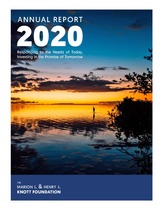
Last year was a challenging one for the nonprofit sector. Our Annual Report helps catalog the new context brought about by the pandemic, as well as the Foundation’s response to help meet the needs of our community. We also highlight our giving through spotlight stories in our five program areas.
Our annual reports are a wonderful archival resource of the Foundation’s grantmaking activities, as well as a way to learn about the positive impact of some of our recent grants in education, human services, health care, arts & humanities, and Catholic activities. For a collection of our past annual reports click here.
Thank you for your continued interest in the Knott Foundation’s mission to strengthen the community.
By Kathleen McCarthy
02-24-2021
Announcing our most recent grant recipients in Catholic activities, education and human services
We are pleased to announce that 17 organizations received over $625,000 in our February grant cycle.
Catholic Activities
- Ignatian Volunteer Corps.: $25,500 to support the general operations of the Baltimore regional office, which pairs older adults with volunteer opportunities at local nonprofits and supports their work with Catholic spiritual reflection
- Jesuit Volunteer Corps: $25,000 to support the general operations of their Baltimore-based programming, which links young people committed to putting their faith in action with local nonprofits serving communities in need
Education
- 10:12 Sports: $10,000 to support this sports-based youth empowerment organization’s Mentor In Training Program (M.I.T.) serving teenage males in West Baltimore
- Dyslexia Tutoring Program: $40,000 to support the general operations of this organization, which provides free specialized tutoring services to low-income children and adults who are dyslexic or have a language-based learning disability
- Loyola Blakefield: $40,000 to support general operating costs at this Jesuit, college-preparatory school in Baltimore County serving boys in grades 6-12
- MERIT Health Leadership Academy: $35,000 to support the general operations of this Baltimore-based organization working to eliminate health care disparities by transforming underrepresented Baltimore City high school students into health care leaders
- Monsignor Slade Catholic School: $40,000 to support technoloy upgrades at this pre-K – 8 Catholic school in Glen Burnie
- Next One Up Foundation: $55,000 to support the general operations of this sports-oriented mentoring program working to transform the lives of young men in Baltimore City by advancing their academic, athletic, and social development
- Saint Ignatius Loyola Academy: $40,000 to support the general operations of this Jesuit, tuition-free middle school in Baltimore City serving boys in grades 5-8
Human Services
- Caroline Friess Center: $40,000 to support the general operations of this healthcare-based career and life skills program for unemployed and underemployed women in Baltimore City
- Community Assistance Network: $40,000 to support the general operations of this organization targeting the health, housing, and food needs of Baltimore County residents
- Govans Ecumenical Development Corporation (GEDCO): $40,000 to support the generation operations of this organization, which provides affordable housing, supportive services, and emergency assistance in Baltimore City
- Harford Family House: $40,000 to support and expand housing and supportive services to young adults age 18-24 in Harford County
- Living Classrooms Foundation: $40,000 to support the general operations of Project SERVE, a community service and job-training program for unemployed and disadvantaged adults in Baltimore City
- UEmpower of Maryland: $40,000 to support The Food Project, which combines culinary skills training, job opportunities, sustainable food sourcing, and mentorship to feed and empower neighborhoods in Southwest Baltimore
- Weekend Backpacks for Homeless Kids: $40,000 to support this organization’s expansion to provide more food to hungry and vulnerable Baltimore City youth
By Kelly Medinger
01-06-2021
HASA uses health care grant to provide charitable care services to children and adults in Maryland
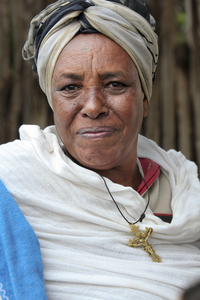 A 65-year-old woman named Dolores was referred to HASA (formerly known as the Hearing and Speech Agency) by her ENT for hearing aids. She had profound hearing loss. Even though her family knew she needed hearing aids, they could not afford the cost. They came to HASA for help.
A 65-year-old woman named Dolores was referred to HASA (formerly known as the Hearing and Speech Agency) by her ENT for hearing aids. She had profound hearing loss. Even though her family knew she needed hearing aids, they could not afford the cost. They came to HASA for help.
About HASA
Founded in 1926, HASA’s mission is to connect people to their worlds. Recognizing the critical role of communication in life, HASA provides clinical, educational, and American Sign Language (ASL) interpretation services to children and adults with the vision “to help them understand and be understood.”
“HASA is Baltimore’s best resource to support individuals with communication differences and disorders like autism, developmental language disorder, and hearing loss,” explains Erin K. Stauder, CEO of HASA. “Left untreated, these conditions can have wide-ranging devastating effects on people’s lives, causing academic problems, social difficulties, and challenges in the workplace.”
Charitable Care
“We never turn anyone away due to their inability to pay,” states Ilana Glazer, External Relations Director at HASA. In 2020, this meant that nearly 1,000 people received assistance from the HASA Charitable Care Fund, supported with a grant from the Knott Foundation, to access comprehensive audiology, speech-language pathology, and occupational therapy.
The importance of charitable care has heightened with insurance coverage challenges. For example, stuttering treatment is not covered when it occurs spontaneously during childhood (which it most often does), and under Maryland law, hearing aids are provided for those on Medicaid, but not others who might not be able to afford them (like Dolores).
A Positive Outcome
At HASA, Dolores was fitted for hearing aids at a reduced fee. At her two-week follow-up appointment, she was found smiling and laughing in the clinic waiting room, heavily engaged in a conversation with her son and daughter-in-law. Her family reports that they were not even aware of how much she was missing in life until she got them.
“HASA’s Charitable Care program helps hundreds of people like Dolores to afford the services they need every year, preventing the serious long-term effects of untreated communication challenges,” states Glazer. Indeed, Dolores’ experience of reconnecting with family and friends is just one example of how important HASA’s mission and services are.
“Effective commination is vital to the health of individuals and communities,” concludes Stauder.
Book Reivew by Kelly Medinger
11-10-2020
How we can navigate the game of life with an infinite mindset
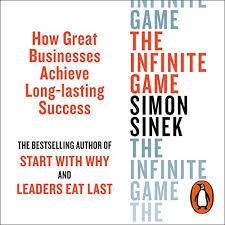 Ten years ago my then Board President, Owen Knott, introduced me to Simon Sinek and his “start with why” Ted Talk. The basic premise of Sinek’s “start with why” philosophy is that businesses thrive when people are clear about why they do what they do, not just what they do. In other words, purpose drives profit, not product.
Ten years ago my then Board President, Owen Knott, introduced me to Simon Sinek and his “start with why” Ted Talk. The basic premise of Sinek’s “start with why” philosophy is that businesses thrive when people are clear about why they do what they do, not just what they do. In other words, purpose drives profit, not product.
So when my colleague and friend, Sadiq Ali at Maryland MENTOR, told me that he’s reading Sinek’s newest book entitled The Infinite Game, I immediately picked it up.
In many ways, The Infinite Game is a continuation of Sinek’s study on leadership. He praises leaders who operate with an infinite mindset, meaning that they recognize their purpose is not “winning” or “being number one” or “beating the competition.” Rather, their purpose is building a company where others develop a deep-seated desire “to contribute to that organization’s ability to keep succeeding.”
The premise of The Infinite Game is that there are two types of games in life: finite games with fixed rules and a clear path to winning or losing (like football); and infinite games with complex players, multiple metrics, and no finish line or practical end to the game (like marriage). Sinek argues that a chief weakness in business these days is that leaders often try to approach the game with a finite mindset, like adherence to a set of arbitrary metrics. Business is better defined with an infinite time horizon – the objective is to keep the game going.
Sinek upholds that an infinite mindset is rooted in five practices. Here are some of my key take-aways from his study of each practice:
- Just Cause: We must be able to share a clear, appealing, and deeply personal vision for the future that motivates people to contribute to our mission and work.
- Trusting Teams: We should prize trust over performance; i.e., when looking for a natural leader within your organization, don’t ask who the top performer is, ask who people trust the most.
- Worthy Rival: We do better when we can identify someone whose work we admire. That helps us adopt a self-improvement regimen and keeps us laser focused on our vision.
- Existential Flexibility: It’s important to be willing to innovate and adopt new strategies at all times, even if they disrupt the current business model or we feel like we’re already at the top of our game.
- Courage to Lead: We must strive to shift our perception of how the world works, free ourselves from depending too much on artificial performance indicators, and adopt an infinite time horizon for success.
I’ll conclude with a notion that resonated with me during the COVID-19 pandemic. Sinek writes: “An infinite-minded leader does not simply want to build a company that can weather change but one that can be transformed by it. They want to build a company that embraces surprises and adapts with them. Resilient companies may come out of the other end of upheaval entirely different than they were when they went in (and are often grateful for the transformation).”
Every nonprofit has been greatly impacted by the current health crisis. Soup kitchens have seen demand skyrocket; schools have adopted hybrid or virtual instructional modalities; fundraisers have been reimagined; and we’re all wondering about what our “new normal” will be, or if there is an end to this seemingly infinite game. We can only hope that the pivots and transformations that we’ve all made during COVID will make us stronger in the long-run, and that our mission and work will become even more relevant in the world ahead.
By Kathleen McCarthy
10-28-2020
Announcing our most recent grant recipients in Catholic activities, education, health care and human services
We are pleased to announce that 18 organizations received over $700,000 in our October grant cycle.
Catholic Activities
- Sacred Heart Parish: $73,183 to support exterior capital improvements to this Catholic parish located in Glyndon, Maryland
- St. Bernardine Church: $75,000 to support mechanical upgrades to this Catholic parish located in the Edmondson Village neighborhood of Baltimore
Education
- Boys Hope Girls Hope of Baltimore: $50,000 to support general operating expenses at this residential program serving academically motivated middle and high school students, helping them to become well-educated and ready for college, careers, and life
- Highlands School: $35,000 to support general operating expenses related to their Executive Function initiative, a cornerstone program at this K – 12 school for students with dyslexia, ADHD, and other language-based learning differences located in Harford County
- Loyola Early Learning Center: $56,250 to support an academic support position at this Jesuit preschool serving students ages 2 – 5 located in Baltimore City
- Maryland Book Bank: $10,000 to support capital upgrades designed to improve the efficiency and safety of their facility and operations, where they distribute books to children, teachers and families in under-resourced neighborhoods in Baltimore
Health Care
- Pro Bono Counseling Project: $20,000 to support their Caring for Caregivers program, which offers no-cost professional counseling to people who are impacted by the financial and emotional stresses of caregiving for a family member
Human Services
- Dove Center (Domestic Violence Sexual Assault Resource Center): $43,264 to support a residential services position in their transitional housing units, at this organization located in Oakland, Maryland that assists adults and children who are victims of domestic violence overcome barriers and build skills to live independently and safely
- Franciscan Center: $55,000 to support the Dining Services Program, which feeds the hungry at this organization that has been providing emergency assistance and supportive outreach to residents in Baltimore City for over 50 years
- Manna House, Inc.: $85,000 to support capital construction costs associated with the expansion of their facility, where they have been serving meals and providing free services to Baltimore’s homeless and poor for over 50 years
- Tubman House, Baltimore(a project of Fusion Partnerships):$10,000 to support the Friend of a Friend program, which supports their urban garden and community food program in the Sandtown-Winchester neighborhood of Baltimore City
- Year Up Baltimore: $25,000 to support general operating expenses of this workforce development program that serves young adults in Baltimore ages 18 – 24 by helping them build technical skills development and gain access to internships
By Kelly Medinger
10-16-2020
Oblate Sisters of Providence use Catholic activities grant to replace the roof on their Chapel and Sacred Heart Hall
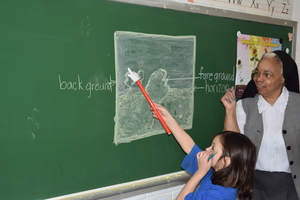 Sister Rita Michelle Proctor, OSP, serves as the Superior General of the Oblate Sisters of Providence, an order that she has been a part of for more than 50 years. “I’ve come to understand that God calls us to different walks of life. I felt called to religious life with the Oblates. I remember being attracted by their sense of genuineness and hospitality,” she reflects.
Sister Rita Michelle Proctor, OSP, serves as the Superior General of the Oblate Sisters of Providence, an order that she has been a part of for more than 50 years. “I’ve come to understand that God calls us to different walks of life. I felt called to religious life with the Oblates. I remember being attracted by their sense of genuineness and hospitality,” she reflects.
About the Oblate Sisters of Providence
Formed in 1829, the Oblate Sisters of Providence are the first religious order in the Roman Catholic Church founded by women of African descent. In the early years, the Sisters educated youth and provided a home for orphans. Slaves who had been purchased and freed were educated and, at times, admitted into the congregation.
Mother Mary Lange is the Order’s Foundress and was born in Santiago de Cuba in 1784. Despite the racial hardship around her, Mother Lange began St. Frances Academy, a Catholic school in Baltimore City, and attracted African American women to join her as servants of God.
The order currently consists of approximately 80 Sisters in parishes and schools located in Maryland, New York, Florida, and Costa Rica. Their Motherhouse is in the Baltimore area, where almost 40 Sisters reside. “Our Sisters struggled to build this house,” says Sister Rita Michelle. “They sold aprons to build it. We are proud of that heritage and are glad to have a place to call home.”
Many supporters
The Knott Foundation awarded Oblates a challenge grant to replace the roof on their Chapel and Sacred Heart Hall, which are located at the center of the Motherhouse and serve the Sisters and community on a daily basis. The Sisters more than doubled the Foundation’s grant by raising money from the Bunting Family Foundation, the Mother Mary Lange Guild, and the Sisters themselves.
“The roof was leaking. We knew it would take a miracle to raise the money to fix it,” states Sister Rita Michelle. She laughs remembering the Order’s 190th anniversary celebration where the Sisters creatively placed potted plants in various locations to catch the drips of water.
A path to sainthood
“I would describe Mother Lange as a woman of color, deep faith, great courage, and a desire to serve God’s people,” says Sister Rita Michelle. “She trusted in God’s providential care, a trust that has permeated our community for 191 years now. She also had an inner joy that could only come from God.”
As testament to that great faith, trust, and joy, Mother Mary Lange is being considered for sainthood. Her life’s journey has been documented and is being examined by the Congregation of the Causes for Saints in Rome.
Dr. Camille Brown, President of the Mother Lange Guild, concludes, “Mother Lange is not just a Sister from Baltimore. She is a Catholic woman of the world.”
By Kelly Medinger
10-16-2020
SBLC/Learning Works uses education grant to upgrade technology and expand their digital literacy agenda for adult learners
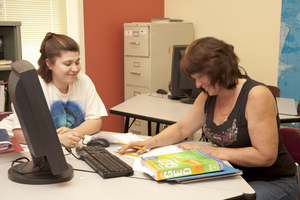 “We give individuals a second chance to take the first step towards a better life,” proclaims Sid Wilson, Executive Director of SBLC/Learning Works.
“We give individuals a second chance to take the first step towards a better life,” proclaims Sid Wilson, Executive Director of SBLC/Learning Works.
About SBLC
SBLC/Learning Works (formerly South Baltimore Learning Center) began 30 years ago as a tutoring program for adults learning to read. Since then, the organization has grown to serve approximately 700 adults each year by providing pathways to educational advancement and workforce readiness.
“What’s unique about SBLC/Learning Works,” explains Wilson, “is our 1:1 tutoring model via the support of our dedicated volunteers. Whether it’s distance learning or a traditional classroom, our learners can progress at their own pace.”
A digital agenda
The Knott Foundation awarded SBLC/Learning Works a grant to upgrade their technology inventory, including new computers, a mobile Chromebook cart, and software licenses.
“The advantages leveraged from new hardware and software were beyond what we anticipated and created a significant shift in the scope and depth of our digital agenda,” says Brandy Carter, Assistant Executive Director of Literary Education.
A pre-grant survey of learners found that nearly 60% did not know how to operate a computer. While SBLC/Learning Works sought to change that figure, the technology upgrades they made showed success on a number of other fronts: increasing access to devices; improving instruction with just-in-time curriculum based assessment measures; and creating new partnerships for fulfilling career pathways for students.
Pathways to the future
SBLC/Learning Works recently cultivated a relationship with Byte Back, a nonprofit career pathways program in the information technology sector. Their learners now have the opportunity to learn essential computer skills, earn industry certifications, and eventually be placed as Help Desk support technicians or other technology-related positions.
“Partnerships like the one we have with Byte Back are so important,” states Wilson. “They are willing to meet our learners where they are and guide them in the direction of their goals.”
For one learner at SBLC/Learning Works – Odith Sandoval – that goal is to improve her English language skills so she can help her two daughters with their schoolwork. Her teachers describe her as a motivated learner and a natural with virtual tools. Her sister also recently enrolled at SBLC/Learning Works and is working towards earning her high school diploma.
Odith has a positive outlook for the future: “Thank you for everything you guys do for us,” she reflects. “I know this is going to help me in my whole life. From here on, everything is going to be different.”
Book Review by Carol Hoffman
06-29-2020
A story about American education and one principal’s fight to change the world
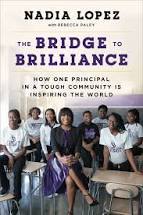 In America, the state of education for children of color living in disadvantaged communities is extremely poor and the educational consequences are very severe.
In America, the state of education for children of color living in disadvantaged communities is extremely poor and the educational consequences are very severe.
Nadia Lopez – author of The Bridge to Brilliance: How One Woman and One Community Are Inspiring the World – grew up in Brooklyn, NY in an area called Brownsville, where 40% of the population lived below the poverty level. She had a vision to open up a new school in the neighborhood because she wanted to make a difference for the children in that area.
From the beginning, it was an uphill battle with the Department of Education (DOE) to get the school started. The DOE did not have enough money to pay a Guidance Counselor or an Assistant Principal, so Nadia became both, along with being the Principal. Her next problem was getting teachers to come to the area and grow with the school.
Nadia named her school “Mott Hall Bridges Academy.” Mott Hall would be the bridge from the past (the place the students came from), to the future (a place full of potential).
Nadia and the teachers developed a motto, “Committed to Succeed,” and a pledge that the children said each day. They picked school colors – purple for the girls and black for the boys. She felt the whole point of the school was to give the children a choice and bring some stability to their everyday lives.
There were 45 students and 6 teachers when Mott Hall opened.
Mott Hall was sent the children that other schools did not want because they had the worst behavior problems. Being a mentor and educator, Lopez emphasizes that you need to understand why a student is misbehaving. After three months, she learned she needed to find out what the students were good at and then built on their abilities. She figured out the most effective way to change a child’s behavior was by talking to the students, and once they knew she was interested in them, their behavior and management issues dwindled.
The inspiration behind Mott Hall was to help children find their self-worth, teach them that they mattered, and expand their horizons. One instance that comes to mind from the book was Nadia had the children write letters to a neighborhood felon who was incarcerated for armed robbery. When he was released from jail, he visited the school and eventually started an afterschool athletic program for boys, which was a great success.
After five years, there were 194 students and 15 teachers at Mott Hall. At this time a book was written about the school describing it as, “A safe zone in a crime-plagued neighborhood, a gateway out of generational poverty for those born with few advantages in life.”
As Lopez states, “Principals and teachers don’t just prepare children for school, we prepare children for life.”
In my work at the Knott Foundation, we see many people in the nonprofit world like Ms. Lopez, who are extremely caring and giving of themselves, while working tirelessly to better the lives of children and others. I am grateful for those people and for my nonprofit colleague, Van Brooks, Founder & Executive Director of the SAFE Center in West Baltimore, who recommended this book to me.
By Kelly Medinger
05-01-2020
Walters Art Museum uses arts & humanities grant to tell a story about one saint’s humility, kindness, and simple living
 The St. Francis Missal is a 12th-century manuscript and beloved to be a relic of touch of St. Francis of Assisi – founder of the Franciscan Friars and the patron saint of Italy, animals, and merchants. The Missal is housed at the Walters Art Museum in Baltimore and was recently exhibited with the support of the Knott Foundation and other funders.
The St. Francis Missal is a 12th-century manuscript and beloved to be a relic of touch of St. Francis of Assisi – founder of the Franciscan Friars and the patron saint of Italy, animals, and merchants. The Missal is housed at the Walters Art Museum in Baltimore and was recently exhibited with the support of the Knott Foundation and other funders.
The Story of the Missal
In the year 1208, St. Francis of Assisi and two of his followers were debating what God’s plan was for them. Unable to come to agreement, they sought answers at the Church of San Nicolò in Assisi, where Francis often attended. Legend has it that they approached the Missal sitting on the Church’s altar – opened it three times at random – and every time the text on the page implored them to renounce all earthly goods and follow the Lord. This pivotal moment laid the foundation for the Franciscan order.
"The St. Francis Missal is our most frequently requested manuscript,” comments Lynley Anne Herbert, Ph.D., Curator of Rare Books and Manuscripts & Curatorial Chair. “Franciscans from around the world regularly make pilgrimages to the museum to be in its presence.”
The Restoration Project
The restoration of the St. Francis Missal is one of the most extensive conservation treatments on a manuscript completed in the 85-year history of the Walters’ Conservation and Technical Research Lab. Decades of use took a toll on the book’s fragile binding, so there was an urgency to restore it. Overall, the project took two years under the careful direction of Abigail Quandt, Head of Book and Paper Conservation, and Cathie Magee, a Fellow funded by the Andrew W. Mellon Foundation.
The project’s numbers are impressive: 5,000 conservation hours logged; 599 images digitized; 285 manuscript pages preserved; and 30 Walters staff assisting on the project. “We are thrilled to share these scholarly discoveries and to have been able to make this incredible object accessible to all, both onsite and online,” comments Julia Marciari-Alexander, Ph.D., Andrea B. and John H. Laporte Director of the Walters.
About the Exhibition
“Through this exhibit we can tell the story of St. Francis and his followers, St. Clare and St. Anthony, and the impact that they had worldwide," shares Quandt. The exhibition features the legendary Missal along with 17 other objects, including manuscripts, paintings, ivories, ceramics, and documentation of the Missal’s restoration.
Nearly 6,000 visitors came to witness the story of St. Francis and view the Missal during the six weeks the exhibition was open to the public. (The exhibition was shortened due to the COVID-19 pandemic.) After the exhibition, the St. Francis Missal returned to its home in the Walter’s Rare Book Library. It can also be viewed cover-to-cover on the Walters’ manuscript website, Ex Libris.
“This extensive reconstruction really brought the book back to life, now and for future generations,” concludes Herbert.
By Kelly Medinger
04-24-2020
Announcing our COVID-19 Emergency Response Fund grant recipients
The Knott Foundation’s mission is to strengthen the community, and now more than ever, our community needs us.
COVID-19's presence in Baltimore and beyond has been a sobering reality and significant challenge facing us all. We’re trying to feel our way through a situation that seemed unbelievable and is now the new normal. This has placed pressure on us to respond individually and as a community to address the health and economic concerns resulting from this uncertain new world.
The Foundation’s immediate response to this public health crisis and its ripple effect through the nonprofit industry has been to deploy our discretionary grant program as a rapid-response COVID-19 Emergency Fund. A select group of past grantees working on the front lines of food security and housing across Maryland each received a $5,000 grant to support their most urgent needs.
I am pleased to announce that 16 human service organizations received a total of $80,000 in grant support through this effort:
- Baltimore Hunger Project
- Community Assistance Network
- Franciscan Center
- Harford Community Action Agency
- Helping Up Mission
- Interfaith Services Coalition of Hancock
- Light House
- Manna House
- Marian House
- Maryland Center for Veterans Education and Training (MCVET)
- Meals on Wheels of Central Maryland
- Our Daily Bread Employment Center (a program of Catholic Charities of Baltimore)
- Religious Coalition for Emergency Human Needs
- St. Francis Neighborhood Center
- St. Mary’s Outreach Center
- St. Vincent de Paul of Baltimore
Click here to review a list of these grants and their purpose found in our past awards database.
We applaud these organizations and all your efforts to respond to our growing community needs during this uncertain time. While there is currently no antidote for COVID-19, we believe respite may be found through compassion and collective action!
By Kelly Medinger
04-23-2020
Enoch Pratt Free Library uses human services grant to support its Mobile Job Center, helping Baltimore residents find employment
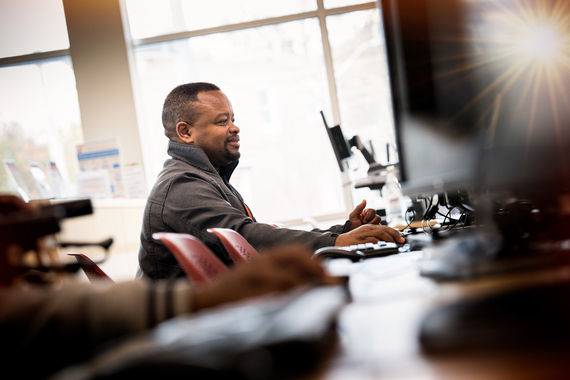 “One great thing about the library is that it’s a place people trust,” comments Meghan McCorkell, Marketing Director of the Enoch Pratt Free Library, “so they feel comfortable coming to us for help.”
“One great thing about the library is that it’s a place people trust,” comments Meghan McCorkell, Marketing Director of the Enoch Pratt Free Library, “so they feel comfortable coming to us for help.”
Mr. McQueen was one of those people. Through the Social Worker in the Library program, he was introduced to the Pratt’s Mobile Job Center for employment counseling. There, he got help writing a resume and applying for jobs. He’s now a Peer to Peer Recovery Coach with one of Baltimore’s major hospitals.
About Enoch Pratt Library
Founded in 1882, the Enoch Pratt Free Library is one of the oldest free public library systems in the United States. It serves Baltimore City residents at its Central location and 21 branches across Baltimore. Their mission is “to empower, enrich, and enhance the quality of life for all through equitable access to information, services, and opportunity.”
The Pratt’s programs extend far beyond books. They offer free legal assistance, career services, and access to social workers, both inside the Library and through outreach programs in the community. “For the longest time the Library has been bordered by its walls, but that has changed,” notes Marlyn Norton, a Librarian with the Mobile Job Center. “We now go to the community that needs us and give them the services they want.”
The Mobile Job Center
The Mobile Job Center opened in 2017 and takes skilled employment specialists on the road to neighborhoods with high unemployment, and where access to an existing Pratt location may be challenging. The Center visits laundromats, barber shops, and even stops when people hail them along the road.
Once inside, people have access to one dozen computers, printers, and the Library’s experienced staff. Approximately ten people cycle through the Center every hour. “We help people no matter what stage they are at in the job search process,” says Ryan O’Grady, Mobile Job Center Director. He and his staff teach small classes and offer one-on-one assistance with resume writing, job searches, interviewing skills, and application submissions.
When the Knott Foundation supported the Mobile Job Center with a grant, the Center reached its goal of serving 15,000 people in the first 6 months of the yearlong award period. In the nine months preceding the closures due to COVID-19, the Center had helped 19,500 customers, answered 11,000 questions, and assisted with 687 resumes and 428 job searches.
A Welcome Surprise
“I love the people who don’t know what the Mobile Job Center is, who walk by, get invited inside, and 30 minutes later walk out with a resume on a flash drive and having applied for a few jobs,” reflects McCorkell. “It’s wonderful to see the smile on their face and their surprise to find out the service is available, and that it’s available for free, in their neighborhood.”
By Kathleen McCarthy
03-06-2020
Shifting the narrative and sharing the power
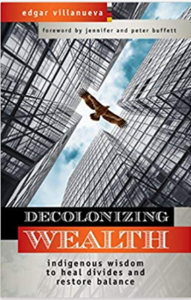 Last November I had the great fortune of attending an event hosted by Maryland Philanthropy Network called Decolonizing Wealth: A Conversation with Edgar Villanueva.
Last November I had the great fortune of attending an event hosted by Maryland Philanthropy Network called Decolonizing Wealth: A Conversation with Edgar Villanueva.
Having heard from colleagues who attended his session at a national family foundation conference last year, I knew that the conversation would be challenging… and I was not wrong.
You see, Villanueva makes a bold argument about philanthropy: rather than improving the lives of those it seeks to serve, he says philanthropy actually re-traumatizes communities, especially those of color, as it adheres to practices and beliefs rooted in colonialism.
While it was one thing to hear Villanueva share his personal path to this conclusion, it was quite another to sit quietly with the book and really consider what he was saying.
My first reaction to the idea that I work in an industry which, in his words – “has evolved to mirror colonial structures” – was a combination of defensiveness and an uncomfortable level of knowing. On the one hand, I know when I am working with a grantee I am careful to call into play the “culture of respect, curiosity, acceptance, and love” that Villanueva discusses. I also feel confident that in doing so, I am working to “create, relate and belong.” However, I cannot ignore that there is always a power dynamic that requires an applicant to conform to cultural norms that may not fit who they are or how they express themselves.
We discussed this dynamic and the trauma it can cause during a gathering we recently hosted with some of our youth-serving grantees. The grantees brought up the fact that negative narratives (i.e. how bad things are) are often what compels funders to take action. Yet such an approach of “deficit framing” by philanthropy forces communities to remain stuck and stigmatized in stories that are not authentic, and that reinforce a colonialist narrative of weakness and dependency. This is especially true for nonprofits serving communities of color. A better frame would be to ask nonprofits about the strengths and assets of their community.
Conversations and critiques such as those put forward by Villanueva and surfaced in our own work are a growing and important part of our sector’s landscape. While they are no doubt challenging, it does not mean that they are unworthy of examination and consideration.
Written with humor, humility and hard-facts, Villanueva’s “Decolonizing Wealth: Indigenous Wisdom to Heal Divides and Restore Balance” presses the reader to pause and truly consider the field – how it arose, how it operates, and how it largely perpetuates harmful dynamics that ultimately inhibit the systemic changes the sector would like to see. Challenging stuff indeed.
By Kelly Medinger
03-05-2020
Many Needs, One Purpose
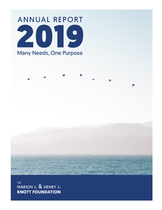
I am pleased to announce the publication of our 2019 annual report.
"Many Needs, One Purpose" is the theme of our 2019 annual report. In 2019, we responded to the many needs in our community while maintaining one purpose: to honor our founders' legacy of generosity to strengthen our community.
Our annual reports are a wonderful archival resource of the Foundation's grantmaking activities, as well as a way to learn about the positive impact of some of our recent grants in education, human services, health care, arts & humanities, and Catholic activities. For a collection of our past annual reports click here.
I hope you enjoy reading our 2019 annual report and learning more about our mission and work!
By Kathleen McCarthy
02-14-2020
Announcing our fourth round of grants in our Building Opportunities in Out-of-School Time initiative
Kids need committed and caring adults to help them navigate life. Out-of-school time programs are a great avenue to build those relationships and help them realize their full potential. Yet an increasing number of low-income students are on the sidelines, and older youth in particular (those in middle and high school) often face the most complex barriers to participation.
Our BOOST initiative focuses on reaching these older youth. Our goal is to engage and retain them in comprehensive out-of-school time programs that promote enduring life skills. Recognizing there are many ways to do this, our strategy is all about relationships.
In our research and conversations with field experts, we learned a growing body of evidence suggests that a consistent relationship with a caring adult is the single most important ingredient to increasing the likelihood that a young person will flourish and become a productive adult.
Through our BOOST initiative, we would like to see organizations demonstrate significant depth, duration, and reach of informal and formal mentoring relationships between older youth and caring adults. With those measures, research says in the long-term these youth will experience improved educational outcomes and labor market success, improved decision-making capabilities, and beneficial effects on a number of other well-being variables – all of which point to our founders’ deep-seated value of education, opportunity, and hard work.
This year we are pleased to announce our fourth round of BOOST initiative funding.
BOOST Award Round IV:
- Sisters Circle: $169,000 grant over two years ($79,000/year one; $90,000/year two) to support the general operations of this organization, which offers long-term mentoring relationships for at-risk girls in Baltimore, empowering them to define success for themselves, make intentional decisions about their futures, and become self-sufficient young women
BOOST is a 5-year, $1 million initiative. Participation in our BOOST initiative is by invitation only. We look forward to sharing what we learn from this initiative over time.
For a complete description of the program, please visit our BOOST initiative webpage. And to read more about the Foundation’s journey to develop the BOOST initiative, click here.
By Kathleen McCarthy
02-13-2020
Announcing our most recent grant recipients in education and human services
We are pleased to announce that 9 organizations received over $400,000 in our February grant cycle.
Education
- Genesee Valley Outdoor Learning Center: $16,780 to support LIFE (Lead, Instruct, Fulfill, Experience), an outdoor experiential learning program for underserved youth in northern Baltimore County
- Junior Achievement of Central Maryland: $60,000 to support the purchase of furniture and fixtures for their new Youth Workforce and Innovation Center in Baltimore, which will house work-readiness, entrepreneurship, and financial literacy programs for youth in grades K – 12
- Sisters Academy of Baltimore: $50,000 to support technology upgrades at this all-girls, tuition-free Catholic middle school in southwest Baltimore
- St. Elizabeth School: $66,686 to support facility improvements that will promote student safety and independence at this Catholic special needs school in Baltimore City
Human Services
- Associated Catholic Charities: $40,000 to support service enhancements at Christopher Place Employment Academy, an intensive residential recovery, education, training, and employment program for formerly homeless men in Baltimore City
- CASA of Baltimore County: $30,000 to support operating costs associated with a new staff position to serve older youth in foster care after they age out of the system
- St. Mary’s Outreach Center: $30,000 challenge grant to support the general operations and expansion of services at the Center, which improves the quality of life for older adults living in poverty in the greater Hampden community
By Kelly Medinger
02-07-2020
St. Clare Parish uses Catholic activities grant to renovate convent for Baltimore area Catholic school teachers to live in a community of faith and friendship
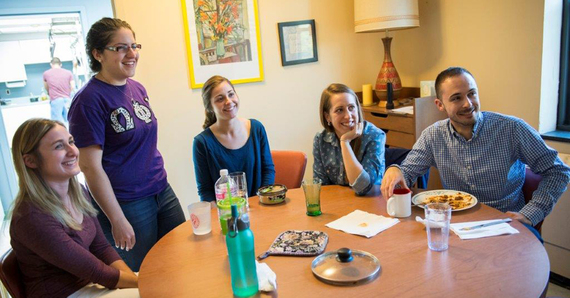 “Our mission is the spread the Word of God and be the Light of Christ for the Essex community in this day in time,” proclaims Father Richard Gray, Pastor of St. Clare Parish in Baltimore County.
“Our mission is the spread the Word of God and be the Light of Christ for the Essex community in this day in time,” proclaims Father Richard Gray, Pastor of St. Clare Parish in Baltimore County.
To further that mission, St. Clare Parish goes beyond offering Mass, sacramental rites, and fellowship programs. Each year, up to ten graduate students who are teaching in Baltimore-area Catholic schools call the Parish’s convent “home.”
“It’s great to have them on our campus,” shares Fr. Gray. “They bring youth and energy to our 11:00 a.m. mass every Sunday, and from a practical perspective, their presence means we don’t have an empty building on our property, and the parish benefits from the added rental income.”
About St. Clare Parish
Opened in 1956, St. Clare Parish serves over one thousand families in the Essex community. The church has been renovated twice – once after a massive fire in 1970, and again in 2016, partly with funds from the Knott Foundation.
In 2018, the church received another Knott grant to upgrade various features of the convent where the graduate education students are housed. The renovation improved the kitchen, added a full bathroom, and addressed some longstanding maintenance issues.
About Operation TEACH
Operation TEACH is a two-year post-graduate service program at Notre Dame of Maryland University, with the goal to develop a corps of highly committed educators to meet the needs of children in Baltimore area Catholic elementary and secondary schools.
Students in Operation TEACH live on a stipend of $14,000/year, teach full-time in a local Catholic school, attend graduate classes on evenings and weekends, and live in community with their fellow teachers. There are currently 16 students in the program who live at St. Clare Parish and St. Thomas Aquinas Church. They teach first grade through high school at 14 different Catholic schools in Baltimore City and Anne Arundel, Baltimore, and Harford Counties.
“Operation TEACH participants have lived in a lot of old convents throughout our 20-year history,” reflects Angela Simmons, Director of Operation TEACH. “St. Clare Parish’s convent is among the best residential facility we have be able to utilize. The facility is in good shape, especially with the recent renovations, and the location is convenient to an abundance of schools across the Archdiocese.”
A Convent Called Home
Monica is from Scranton and teaches middle school language arts at St. Joe’s Fullerton. She describes Operation TEACH as a “bundle deal – with housing, education, a job, and a support system on top.” This is her second year in the program, and when she reflects on the recent convent renovations, she remarks, “My favorite thing is that there’s always someone cooking in the kitchen this year – it’s a great joy to see and makes it feel more like home.”
Fr. Gray concludes with a serendipitous connection to his own life story: “I was a teacher before I was a priest. I taught for eight years in Delaware before going to Seminary. If a program like Operation TEACH had been around back then, I would have been in it.”
By Kelly Medinger
11-19-2019
Taking a closer look at the multiple charitable vehicles established by our founders, Marion and Henry Knott, during their lifetimes, including the Knott Foundation and other funds
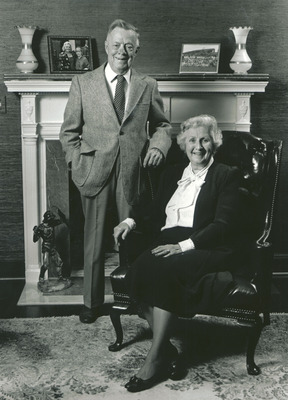 With the generosity of Marion and Henry Knott – and their large Catholic family that has only grown in size over the decades – many in Baltimore are familiar with the Knott name. What most don’t know, however, are the multiple structures for giving that our founders established long ago, as well as how those structures continue to support the community today.
With the generosity of Marion and Henry Knott – and their large Catholic family that has only grown in size over the decades – many in Baltimore are familiar with the Knott name. What most don’t know, however, are the multiple structures for giving that our founders established long ago, as well as how those structures continue to support the community today.
A Family Foundation to Strengthen the Community
In 1977, Marion and Henry Knott established The Knott Foundation as a private family foundation in the State of Maryland. The vision of the Foundation is "to provide resources for nurturing and sustaining family unity through charitable activities in the Roman Catholic community and other deserving agencies that the Knott family encouraged and supported."
“Today, 40 years later, continuing the philanthropic legacy of my grandparents remains at the heart of our mission, as we strive to both improve our community and strengthen our family,” states Lindsay Gallagher, Board President.
The Foundation is a multi-generational philanthropic family enterprise, with 34 Trustees representing 3 generations and 8 branches of the Knott family. All of the Foundation’s Trustees are involved in making grants that help strengthen communities in central and western Maryland. The median grant to an organization is around $50,000, and program areas include education, human services, health care, Catholic activities, and the arts. You can learn more about the Foundation here: www.knottfoundation.org.
A Trust to Benefit Catholic Charities
The Henry J. and Marion I. Knott Catholic Community Fund (est. 1971), is a trust governed by Catholic Charities of Maryland (the Agency). The Fund is overseen by a committee of the Agency’s leadership and a Knott family member. Currently, the Fund provides approximately $250,000 per yearfor the Agency’s key priorities and organizational funding needs. Most recently, the Fund has been dedicated to helping the Agency with technology upgrades.
“Producing life-improving outcomes for those we serve and being accountable to our benefactors requires that we keep pace with the ever-evolving technological world,” comments Bill McCarthy, Executive Director of Catholic Charities. To that end, the Fund’s annual support has allowed Catholic Charities to refresh its technology – including providing staff with laptops and Chromebooks, and helping to implement an electronic health records system for their many programs serving children and families.
“We are grateful for the ongoing financial support from this fund and the thoughtful involvement of family members who guide our stewardship of this valuable resource,” concludes McCarthy.
A Trust to Support Other Catholic Institutions
In 1975, the RCA Trust (Roman Catholic Archdiocese of Baltimore Trust) was established as a trust that supports certain Catholic organizations including the Archdiocese of Baltimore, Notre Dame of Maryland University (NDMU), and the University of Notre Dame in Indiana.
Lump sums were paid out to each beneficiary organization at the beginning of the life of the trust. From those payments, the Archdiocese of Baltimore directed $1 million to Catholic Charities’ Our Daily Bread campaign and $1 million to the Baltimore Basilica’s Restore the Light renovation campaign. NDMU dedicated $2 million to create the Marion Burk Knott Athletic Center, which remains a focal point for athletics, fitness, and a variety of other student services on the college’s campus. And the University of Notre Dame built Marion Burk Knott Hall, the first residence hall on campus named for a woman.
“This Trust is a wonderful example of the leadership and philanthropic spirit we have been blessed with in the Archdiocese of Baltimore,” States John Matera, Chief Financial Officer of the Archdiocese of Baltimore.
Today, the Archdiocese and NDMU continue to receive annual proceeds from the Trust, beyond the initial payments outlined above. Each organization receives approximately $100,000 per year.
The Archdiocese uses this annual income to support The Basilica of the Assumption Historic Trust. Since 2003, a large proportion of this money has been used to support renovations and maintenance of the Basilica’s grounds. More recently, the funds have been allocated to support the Basilica’s programming as a City parish.
“What the endowment allows us to do is huge,” comments Rev. James Boric, Pastor of the Basilica. “It has afforded us the ability to create a tailor-made missionary program to evangelize Baltimore and help the homeless and addicted on our streets. The Knott Endowment has allowed us the freedom and the room to re-invent the Basilica into something more than just a historic building. It has allowed us to become a parish that is meeting the needs of our Church and our City in 2019.”
Father Boric cites the fact that the Basilica has women discerning religious life, a young man discerning priesthood, and between 25-50 young professionals coming to Adoration every Thursday as signs of success of their evangelization work supported by the RCA/Knott Trust. “This is the fruit of a lot of things—but certainly the Knott Endowment is a part of that,” he remarks.
Meanwhile, NDMU uses ongoing annual contributions from the Trust to support student financial aid and institutional operations. “Notre Dame today is blessed to provide as much as $10 million in financial aid and scholarship resources to worthy students each year,” shares Carroll David Galvin, Interim Associate Vice President for Development and Director of Corporate, Foundation & Government Grants. “Most recently, 51% of students in the undergraduate Women’s College are recipients of federal Pell-grants, awarded to those students showing the highest levels of financial need. Funds from the Knott Trust help support aid to this population, and others, on our campus,” he confirms.
Scholarship Funds to Help Catholic Students
The Marion Burk Knott Scholarship Fund (est. 1980) and the Marion I. & Henry J. Knott Scholarship Fund (est. 1988) together operate as the Knott Scholarship Funds. The assets of these two funds total approximately $100 million. The Knott’s vision for these scholarships was to create a future for Maryland that is supported and steered by a community that puts into action the values and beliefs of the Catholic faith.
The Knott Scholarship Funds award scholarships to academically talented Catholic students who wish to continue their education in a Catholic school within the Archdiocese of Baltimore. Full-tuition scholarships are awarded to elementary students (grades 5-8) and high school students attending a Catholic school. College scholarships are available at the three Catholic Colleges in Maryland: Loyola University Maryland, Mount St. Mary’s University, and Notre Dame of Maryland University.
To date, nearly $60 million in scholarship awards have benefited some 1,500 students in elementary school, high school, and college. With a rich history spanning 38 years, the Scholarship Funds has produced some heartwarming results: over 64 siblings have been awarded scholarships; a mother/son are both scholarship winners; and there have even been two marriages between Knott Scholars. You can learn more about the Knott Scholarship Funds here: http://knottscholar.info/
Matt Smolka (Loyola Blakefield '20) and Katie Smolka (School of the Cathedral of Mary Our Queen '21) are a brother and sister who have both benefited from Knott Scholarships.
“I felt very honored to be named a Knott scholar considering the great legacy of the scholarship program,” shares Matt. “I know that my parents and I very much appreciate the generous contribution of the Knott family for their financial support, especially with two kids to send to college, so it’s an incredible gift from an incredible foundation.”
“Together, the community of Knott Scholars demonstrate an outstanding academic record, as well as the promise to fulfill our founders vision: that they will use their intellectual abilities to serve others,” reflects Michelle Burke, Director of the Knott Scholarship Funds.
Adds Jim Sellinger, Chancellor of Education for the Archdiocese of Baltimore: “The Knott Scholarship Fund has recognized outstanding student performance and has reinforced the importance of Catholic education provided by the Archdiocese of Baltimore Catholic schools for close to four decades. The students who attend our Archdiocesan Catholic schools are blessed to have the Knott Scholarship Fund recognize their academic excellence in the classroom with full scholarships.”
Conclusion
Together, the legacy of charitable vehicles that Marion and Henry Knott created to benefit the community total more than $150 million. All of these resources create a picture of the causes that our founders cared about and their commitment to students, families, schools, churches, and charities within the Archdiocese of Baltimore.
Martin Knott, a Charter Trustee of the Knott Foundation, sums it up like this: “My parents believed in doing good work while they were here, but more importantly, leaving a legacy when they were gone. So what they did is set up a structure that builds a work ethic in the next generation, and an understanding that you have to help other people. The funds they created during their lifetimes have perpetual meaning – in addition to their family, they are a lasting legacy of their morals and values.”
By Kelly Medinger
11-12-2019
How tiny changes produce remarkable results
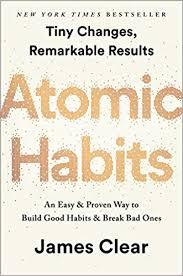 Aristotle said, “We are what we repeatedly do. Excellence then, is not an act, but a habit.”
Aristotle said, “We are what we repeatedly do. Excellence then, is not an act, but a habit.”
The fall season presents a prime opportunity for self-examination of our habits. As the leaves change colors, I often reflect on the passage of time and try to think of ways to turn over a new personal leaf to help make life better in some small way.
Such was my mood when I picked up the New York Times bestseller Atomic Habits by James Clear (2018). Billed as “an easy and proven way to build good habits and break bad ones,” I hoped it would help lead me down my own path of autumnal renewal.
Clear’s book is an enjoyable read. His prose is simple and impactful, and his framework for approaching “getting 1% better every day” is compelling.
A major premise of the book is that our dreams and successes are not built on massive actions or swift changes. Rather, they develop with a purposeful commitment to small changes – habits that we build into our daily routines. His advice then is really quite simple: focus on the system and steps you use to achieve your goals, rather than the goal itself.
Clear uses his own life story as the backdrop for his hyper-concentration on habits. As a sophomore in high school, he suffered a critical head injury when a bat hit his face during baseball practice. The injury landed him in a medically induced coma followed by months of rehabilitation.
But Clear didn’t give up on baseball. After two difficult years trying to reenter the sport, he turned over a new leaf in college where he “would discover the surprising power of small habits for the first time.” For example, he made it a habit to lift weights every day, keep his room tidy, and go to bed early. He attributes these small habits to his success in college as a scholar and an athlete.
Clear’s step-by-step guide for building better habits unfolds in four basic laws: make it obvious, make it attractive, make it easy, and make it satisfying.
One of my favorite pieces of advice he offers within this framework is called “habit-stacking” where you say, “After [current habit], I will [new habit].” The key to habit stacking is the specificity. It’s not enough, Clear suggests, to say, “When I take a break for lunch, I will mediate for one minute.” Instead, he recommends being more specific: “When I close my laptop for lunch, I will meditate for 60 seconds at my desk.” It is this focus on clarity (when, where and how long) that will help make the habit stick.
Clear’s book draws from biology, psychology, sports, business, and entertainment to create an easy-to-use operating manual for making small changes stick. Most importantly, these small changes can lead to big results over time. I truly enjoyed the book and hope you will, too!
By Kathleen McCarthy
10-21-2019
Announcing our most recent recipients in Catholic activities, education, health care and human services
We are pleased to announce that 14 organizations received nearly $650,000 in our October grant cycle.
Catholic Activities
- Monsignor O’Dwyer Retreat House: $75,000 to support the construction of an outdoor worship space at this Catholic youth retreat facility in Baltimore County
- Oblate Sisters of Providence: $100,000 challenge grant to support roof repairs to the Motherhouse of this Catholic religious order for women located in Baltimore County
Education
- Cristo Rey Jesuit High School: $46,000 to support technology upgrades at this Jesuit high school in Baltimore City that provides college-preparatory education coupled with corporate work experience
- Irvine Nature Center: $15,000 to support environmental education and leadership development programming for students at two Catholic schools in Baltimore City
- Soccer Without Borders: $40,000 to support this out-of-school time program using soccer as a vehicle for positive change for newcomer refugee students in middle and high school in Baltimore City and County
- St. Frances Academy: $75,000 to support capital renovations at this 190-year-old, historically African-American Catholic high school in Baltimore City
- St. Maria Goretti High School: $58,788 to support the launch of Project Lead the Way: Introduction to Engineering at this Catholic high school in Hagerstown
- St. Thomas More Academy: $40,000 to support the More Readers Initiative providing supports to students with learning differences at this pre-K-8 Catholic school in Frederick County
- The Community School: $25,000 to support the expansion of teaching faculty at this academic and mentoring high school located in the Remington community of Baltimore City
Health Care
- Gilchrist Hospice Care: $25,000 to support construction of the new Gilchrist Center Baltimore at Stadium Place, to serve adults and children in Baltimore City who have reached their end of life stage
- The Hearing and Speech Agency: $15,000 to support the charitable care fund, which helps make clinical audiology, speech-language pathology, and occupational therapy services available to all, regardless of income
Human Services
- Athletes Serving Athletes: $40,000 to support the expansion of services through volunteer recruitment at this organization working to elevate the quality of life for individuals with limited mobility by empowering them to train for and participate in running events at no cost
- Cornerstone Community Housing (formerly United Ministries): $50,000 to support the general operations of Earl’s Place, a recovery-based transitional housing program for men experiences homelessness in Baltimore City
- Pathfinders for Autism: $30,000 to support the launch of a pilot program focused on creating recreational opportunities for adults with autsim
By Kelly Medinger
10-02-2019
Mother Seton Academy uses education grant to support their 25th anniversary building campaign
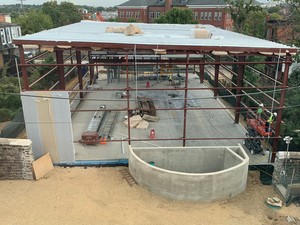 “It’s so great to see the kids watching the new gym being built,” observes Sister Peggy Juskelis, President of Mother Seton Academy. “They see this as a sign of people’s belief in them. To the kids, it’s not just a steel structure, it’s a symbol of the great promise the future holds and the transformative effect of education.”
“It’s so great to see the kids watching the new gym being built,” observes Sister Peggy Juskelis, President of Mother Seton Academy. “They see this as a sign of people’s belief in them. To the kids, it’s not just a steel structure, it’s a symbol of the great promise the future holds and the transformative effect of education.”
About Mother Seton Academy
Located in the Greenmount neighborhood of Baltimore City, Mother Seton Academy was founded in 1993 by a group of six Roman Catholic religious orders. It was named in honor of St. Elizabeth Ann Seton, the first American-born saint and the foundress of the country’s first free Catholic school for girls.
Mother Seton Academy’s 83 boys and girls in grades 6-8 are all on full scholarships. They come to the school through a competitive admissions process, where it is typical to have 80 students applying for only 30 seats. To date, the school has graduated 470 students who have since gone on to become police officers, professional educators, members of the armed services, and more.
“The kids are with us beyond the three years they are here,” comments Sister Peggy. Mother Seton’s graduate support program follows the students through high school, ensuring a near perfect 100% graduation rate every year.
Building a Gym
Before this new gym was under construction, Mother Seton Academy’s students practiced basketball on a makeshift court obstructed by two poles. “They never had a full court to run,” explains Sister Peggy. “Now they will feel like real athletes in a true, high-quality middle school gymnasium.”
The gymnasium will also include a music and community room. “The local community is very pleased with what we’re doing,” shares Sister Peggy. The school plans to offer the community room to the adjacent parish, St. Ann’s Catholic Church, as well as local associations for neighborhood events.
Fundraising for the Project
“The Knott Foundation was the first grantor to support the project,” comments Rachel Trask, Development Director. After the Foundation’s support, Mother Seton Academy’s campaign total grew from $1.3 million to over $3 million. Beyond the capital campaign, Mother Seton Academy also raises approximately $1.5 million each year to fund the school’s day-to-day operations.
Sister Peggy concludes: “The philanthropic community is foundational to the success of Mother Seton Academy and our students. Your faith in our students helps them to believe in themselves.”
By Kelly Medinger
09-27-2019
B&O Railroad Museum uses arts and humanities grant to build a home on their campus for the Baltimore City Mounted Police Unit
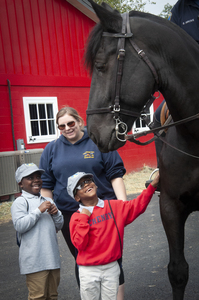 A class of kindergartners from James McHenry School walks out of the B&O Railroad Museum abuzz with excitement. As the first school group to tour the First Mile Stable – an innovative partnership between the Museum and the Baltimore City Police Department – the children had spent the morning meeting horses and talking to Sargent Russ Robar, the head of the City’s Mounted Police Unit.
A class of kindergartners from James McHenry School walks out of the B&O Railroad Museum abuzz with excitement. As the first school group to tour the First Mile Stable – an innovative partnership between the Museum and the Baltimore City Police Department – the children had spent the morning meeting horses and talking to Sargent Russ Robar, the head of the City’s Mounted Police Unit.
About the B&O Railroad Museum
The Baltimore & Ohio Railroad Museum is recognized as the birthplace of American railroading. The Museum holds the oldest and most comprehensive collection of railroad history in the Western Hemisphere.
Located on a 40-acre campus in southwest Baltimore, the Museum is both a cultural anchor for the local community and a destination for more than 185,000 guests each year from around the world. Tours include regularly scheduled train rides, demonstrations of historic equipment, access to the Museum’s fully operational restoration shop, admission to numerous galleries and exhibitions, and a robust educational program for school children that focuses on transportation, history, and innovation.
The First Mile Stable Project
For the past three decades or more, the hard-working horses from Baltimore City’s Mounted Police Unit have lived in a former car dealership beneath a major highway in the City. The B&O recently raised over $2 million to build a stable and paddock for the horses on their 40-acre campus, naming the project “The First Mile Stable.” The term “First Mile” refers to its location where the first mile of long-distance rail was laid and the first passenger station was built.
Visitors to The First Mile Stable will enjoy talking to Sgt. Robar or one of his police officers, as well as meeting the horses themselves. The Unit currently consists of four horses and four officers, but has the capacity to more than double in size in the future. The Unit’s horses are selected for their ability to interact with people and to perform police work. “Big D,” the lead horse for the Unit, has even received an international award for bravery and was just inducted into the Horse Star Hall of Fame.
A Community Builder
“A major purpose of the project is to better integrate the police and the community through educational activities and positive bonding,” states Kris Hoellen, Executive Director. She cites the First Mile Stable’s community classroom and demonstration area as resources for groups to spend time learning about the Mounted Unit and witnessing first-hand how the horses are cared for. School children will be exposed to equine studies, law enforcement, and transportation as potential career pathways.
“The whole project is a way to help reach into the community,” concludes Francis Smyth, Board Chair of the B&O. “Our hope is to help spark community economic development for this area, act as a deterrent for unsafe activity, and ultimately bring more visitors to the B&O as a cultural anchor for the neighborhood.”
By Carol Hoffman
07-16-2019
A guide for thoughtful philanthropy
 In Giving Done Right: Effective Philanthropy and Making Every Dollar Count, Phil Buchanan educates his audience by offering practical advice for all levels of giving.
In Giving Done Right: Effective Philanthropy and Making Every Dollar Count, Phil Buchanan educates his audience by offering practical advice for all levels of giving.
As President of the Center for Effective Philanthropy for nearly 20 years, Buchanan deeply understands the charitable giving sector and what issues confront donors when they are making contributions, large or small. He also believes that a push for “business thinking” has taken over the discussion of effective philanthropy in recent years, and that it’s time for “thoughtful givers and nonprofit leaders… to stand up and make clear that their work is uniquely challenging – and uniquely valuable – and as such requires its own approach and discipline.”
“Giving done right” according to Buchanan requires understanding the organizations you want to fund, and the people and communities you seek to affect. It also requires humility and patience.
In his book, Buchanan writes about many different aspects of the nonprofit world and charitable giving. For this blog post, I am focusing on his examination of personal giving and some of the things you need to know when deciding to make a donation.
Buchanan says every giver needs to answer the same question, “How do I channel my giving effectively to make the greatest difference?” He points out that the majority of households give to many local charities – such as schools, religious organizations, community foundations, food banks, or homeless shelters. When considering giving, he recommends carving out a significant portion for where you feel it will do the most good.
But how can you determine what will do the most good? Buchanan tells us to research the nonprofits we are interested in helping, evaluate the outcomes of the nonprofits we are already giving to, and believe in their respective causes. For example, he suggests contacting someone on the board you might know, or contacting the Executive Director, to learn more about the organization. There are also many ways to give, and a challenge can often be finding the right organization based on your interests and goals, as well as your level of giving.
Finally, Buchanan tells us that sometimes you just need to say no when receiving a phone call asking to support your local police or fire department, or for cancer research. He admits it’s hard to say no, but you should save your contributions for the organizations that you choose thoughtfully, based on your personal goals and strategies. In other words, you need to feel confident about the impact of your giving based on your own research and due diligence, so you can feel good about how your money will be used and the difference your giving will make.
Years ago, when I first went to work for the Knott Foundation, I changed my own way of giving to be more in line with Buchanan’s advice. I found that the nonprofit world was much larger than I had ever anticipated, and through my work, I was able to research and learn about the ones I found particularly interesting, and I started to change my way of giving.
“Giving Done Right” is a must read for anyone who wants to be thoughtful about their philanthropic giving, as well as anyone who wants to learn more how unique and complex the nonprofit sector really is.
By Kelly Medinger
07-03-2019
Mission of Mercy uses health care grant to launch new mobile dental clinic
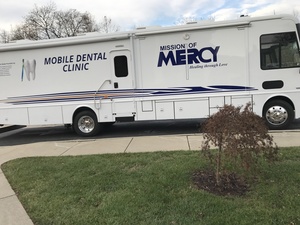 A group of 50 people or so sit in a church hall, waiting for their name to be called so they can see a doctor or a dentist. “Just look at them waiting here, and then look at their faces when they get off the van,” one patient remarks.
A group of 50 people or so sit in a church hall, waiting for their name to be called so they can see a doctor or a dentist. “Just look at them waiting here, and then look at their faces when they get off the van,” one patient remarks.
About Mission of Mercy
Started 25 years ago and operating in Maryland, Pennsylvania, Texas, and Arizona, Mission of Mercy attracts hundreds of medical volunteers who see patients at local sites that host the organization’s traveling medical and dental clinics.
“Mission of Mercy is a medical home for patients who do not have insurance or cannot afford care,” shares Jennifer White, Development Director. For example, 70% of patients at the four clinic sites in Maryland have chronic health issues that require regular care and monitoring, and Mission of Mercy will provide all of their medications, lab work, and doctor’s visits free-of-charge.
Responding to the Need for Dental Care
“We have a real dental crisis in the United States,” explains Linda Ryan, Mission of Mercy’s Executive Director. Dental care is not included in the Affordable Care Act, Medicare, or Medicaid, and supplemental dental insurance is expensive. Combine that with a dearth of general dentistry practitioners, and people are putting off regular dental care until a crisis emerges.
In responding to this need, Mission of Mercy recently launched a new mobile dental clinic, complete with three patient chairs and professional dental equipment, to double the number of patients they serve. The Knott Foundation contributed to the $1 million fundraising campaign, which included purchasing and fully outfitting the mobile dental clinic and funding its first two years of operations.
With the new mobile dental clinic, Mission of Mercy is able to see more patients, as well as store and utilize more high-end instrumentation.
Restoring Smiles
Enter Dr. Roslyn Kellum, DDS, the Dental Director at Mission of Mercy, and a team of volunteer dentists from the communities the clinic serves. Dr. Kellum (who is both a dentist and registered nurse) and the volunteer dentists provide dental care to their patients, but also refer them to the medical clinic for issues such as heart disease, high blood pressure, and diabetes. “You can tell a lot about somebody’s health just by looking in their mouth,” Ryan remarks.
Looking at the faces of patients climbing down the stairs of the new dental van, their smile says it all: “I get pleasure and great joy in restoring patients’ smiles because all smiles matter,” concludes Dr. Kellum.
By Kathleen McCarthy
06-19-2019
Announcing our most recent recipients in Catholic activities, education, health care and human services
We are pleased to announce that 15 organizations received over $750,000 in our June grant cycle.
Catholic Activities
Education
- Archbishop Spalding High School: $100,000 to support the acquisition of furniture and equipment for the new Innovation Center at this Catholic high school in Anne Arundel County
- Baltimore Chesapeake Bay Outward Bound: $40,000 to support outdoor experiential education programs and character development for two Catholic girls schools in Baltimore City, Sisters Academy and Mercy High School
- Resurrection-St. Paul School: $70,000 to support technology upgrades and laboratory furniture/fixtures at this pre-K-8 Catholic school in Ellicott City
- Saint Casimir Catholic School: $75,000 to support technology upgrades at this pre-K-8 Catholic school in the Canton neighborhood of Baltimore City
- St. Francis of Assisi School: $75,000 to support the creation of a Wellness Center and STEM Lab/Maker Space at this pre-K-8 Catholic school in Northeast Baltimore City
- Strong City Baltimore: $35,000 to support The Club at Collington Square, an after-school and summer program serving youth in East Baltimore
- The First Tee of Greater Baltimore: $25,000 to support the College Bound Project for high school youth in this out-of-school time program that combines golf and character education
Health Care
- Shepherd’s Clinic: $43,318 to support salary costs at this free, integrative health care clinic in Baltimore City
Human Services
- Baltimore Hunger Project: $12,500 to support the delivery of weekend food packages to 50 more students in Baltimore City and County
- Enoch Pratt Free Library: $15,000 to support the Library’s Mobile Job Center, which serves job seekers throughout Baltimore City
- Santa’s Helpers Anonymous: $10,000 to support the purchasing of toys for distribution to Baltimore area families in need at Christmastime
- Paul’s Place: $80,000 to support the construction of Groundwork Kitchen, including a new culinary arts training program, restaurant, and catering business, at this social service agency in the Pigtown neighborhood of Baltimore City
- The Light House: $18,000 to support a workforce development program in the trades industry at this homeless service organization in downtown Annapolis
By Kelly Medinger
06-17-2019
Baltimore Child Abuse Center uses human services grant to grow its grants management team in order to help heal and protect more children
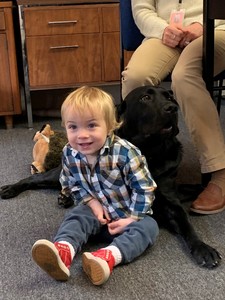 How do you double your grant revenue in a year by applying for fewer grants? Ask the Baltimore Child Abuse Center.
How do you double your grant revenue in a year by applying for fewer grants? Ask the Baltimore Child Abuse Center.
About the Center
Since 1987, Baltimore Child Abuse Center has helped children who have been abused, sexually assaulted, victimized, or witnesses to homicide. The Center, which recently joined LifeBridge Health as a wholly owned not-for-profit subsidiary, provides free services to more than 1,800 children and their non-offending caregivers every year, including medical treatment, forensic interviews, and mental health treatment.
“The violence and trauma a child suffers at the hands of adults takes its toll on their lives and social outcomes,” states LaDonna Morgan, Chief Operating Officer at Baltimore Child Abuse Center. “We are in the fight to protect them and help them on their path to healing.”
Increasing Grants Capacity
The Knott Foundation has supported the Center for more than 20 years. Most recently, the Foundation awarded a grant to increase the Center’s capacity to research, apply for, and administer grants.
One unexpected lesson the Center learned during the grant period: “It’s not as much about the number of grants you win, but the size of those that you do,” states Morgan. The Center actually applied for fewer grants but doubled their grant revenue in just one year, from $1.3M to $3.1M. They did this by seeking larger, multi-year grants, seeing their average award increase from just under $40,000 to $150,000 in 12 months.
“We also developed a new grant strategy, improved our data collection and tracking, implemented program improvements and quality assurance measures, and successfully administered larger and more complex grants than ever before,” comments LeeAnne Woods, Director of Grants Management. “Without the addition of the Grants Coordinator, through the support of the Knott Foundation, we would not have been able to achieve these goals,” continues Woods.
A Path to Healing
More grant funding has allowed the Center to establish a mental health department to better serve children.
“We used to refer children and families to therapists in the community, but we found there was a very low connection rate,” notes Morgan. Grant funding helped the Center hire two therapists and create a therapy department, and in three years the Center has grown the department to six therapists, meaning they can see children immediately, without having to put them on a wait list.
Clearly, Baltimore Child Abuse Center has been successful at turning revenue into results: “Our grants capacity is directly tied to our programmatic ambitions for the organization,” concludes Morgan. “That revenue ensures our doctors, nurses, therapists, and social workers can do the important work they do and positively impact the lives of the children they see.”
By Kelly Medinger
03-13-2019
Reflecting on the continued growth and vibrancy the Knott family brings to the Foundation’s work
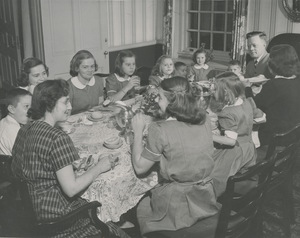 When people say, “Tell me about the Knott Foundation,” I often answer that we are a Catholic family foundation with a capital F-A-M-I-L-Y.
When people say, “Tell me about the Knott Foundation,” I often answer that we are a Catholic family foundation with a capital F-A-M-I-L-Y.
The Knott family is 250 members strong – all direct descendants of our founders, and spouses of those descendants.
Thirty-four of those members have gone through our rigorous training program and now sit on the Knott Foundation’s Board of Trustees. Two more members are going through our training program right now. Together, our Trustees represent the second, third, and fourth generations of Marion and Henry Knott’s lineage, and 9 discrete family branches from the Knotts’ original 13 children.
I learned in a webinar recently that most family foundations don’t make it past the third generation. Perhaps the foundation is unable to attract younger family members, or perhaps differing viewpoints piece the philanthropy into multiple vehicles, each with its own set of priorities. Nevertheless, the foundation ceases to exist in its original form.
The Knott Foundation bucks this trend. Last year we added four younger family members to our Board of Trustees and elected the largest Board in the Foundation’s history.
Letters from some of these newest (and youngest) members reveal their motivation for joining our work – primarily, an interest in the core values of the Foundation and our grantmaking in the community. Here are excerpts from some of those letters:
- “I have reflected on the fundamental morals and characteristics that my great grandparents had, including generosity, compassion for others and perseverance. I am ready to continue the Knott tradition, by engaging more in charitable work, learning about the grant process, and helping to give to those in need.”
- “I am interested in joining the board to explore the charity work, the grants, and the ideals that the Foundation holds… Grandpop and Grandmom Knott instilled in their children that family, faith, and charity are all extremely important in life, and this has been passed down from generation to generation. I am incredibly lucky that my family is as close as we are, and I think that this all stems from Grandpop and Grandmom Knott.”
- “I would be humbled with the opportunity to give back to community and help amazing organizations that are performing incredible work around the greater Baltimore area and throughout Maryland by being a part of the Knott Foundation. I look forward to joining and continuing the philanthropic work that helps great organizations succeed and thrive.”
Spring is a season for growth and renewal. In that vein, I am happy to reflect on the continued growth and vibrancy the Knott family brings to our work as a philanthropic venture dedicated to strengthening communities in central and western Maryland.
Truly, we are a Catholic family foundation with a capital F-A-M-I-L-Y!
By Kelly Medinger
03-04-2019
Building the Foundation for Stronger Communities
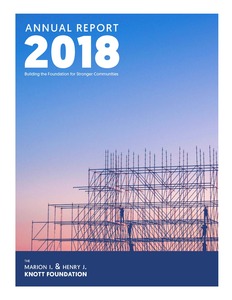 I am pleased to announce the publication of our 2018 annual report.
I am pleased to announce the publication of our 2018 annual report.
“Building the Foundation for Stronger Communities” is the theme of our 2018 annual report. Through this theme, we embrace our dual purpose to strengthen the community and nurture and sustain family unity. We also mark a significant milestone, having recently elected the largest Board in the history of the Foundation – 34 family members dedicated to our legacy and work.
Our annual reports are a wonderful archival resource of the Foundation’s grantmaking activities, as well as a way to learn about the positive impact of some of our recent grants in education, human services, health care, arts & humanities, and Catholic activities. For a collection of our past annual reports click here.
I hope you enjoy reading our 2018 annual report and learning more about the Knott Foundation’s mission to strengthen the community.
By Kathleen McCarthy
02-28-2019
Why implementation and process matter just as much as effort
 In my colleague Carol Hoffman’s blog post from last summer, we shared how one of our grantees introduced us to the work of Carol Dweck, Ph.D. and her influential book Mindset, The New Psychology of Success. Published in 2006, the book captured the attention of educators, employers, parents and others interested in the idea of realizing one’s full potential.
In my colleague Carol Hoffman’s blog post from last summer, we shared how one of our grantees introduced us to the work of Carol Dweck, Ph.D. and her influential book Mindset, The New Psychology of Success. Published in 2006, the book captured the attention of educators, employers, parents and others interested in the idea of realizing one’s full potential.
Dweck’s research highlighted the belief that one’s potential for success is not fixed at birth, but rather fluid and open to nurturing. She distilled this concept down to two mindsets – “fixed” and “growth.” An individual with a fixed mindset believes that they are born with a restricted amount of “x” – whether that be intelligence, personality, aptitude etc. Believing that you are restricted by what you received at birth limits a person’s passion for learning and taking on challenges; it prohibits curiosity and can promote a feeling of being “less than.”
On the flipside, an individual with a growth mindset believes that their potential was not dictated at birth but rather is something that they can cultivate and expand through “hard work, strategies and lots of help from mentors…” Growth mindset thrives on curiosity and challenges.
This twofold concept of fixed and growth mindsets seems straightforward, right? If you want to reach your potential, adopt a growth mindset. Unfortunately, since the publication of her book, Dr. Dweck started noticing the misapplication and misunderstanding of her mindset concept, which is where I’d like to pick up.
I recently came across an interview with Dr. Dweck published in The Atlantic in 2016, ten years after the initial release of the book. The article, How Praise Became a Consolation Prize by Christine Gross-Loh highlights how (as one of our grantees put it) “implementation matters.”
Clearly concerned by what she was hearing from the field, Dr. Dweck dug back in to understand how well-researched concepts could be distilled down to an oversimplification about effort, i.e. “praise the effort, not the outcome.”
In Dweck’s mind, and demonstrated through her research, effort is not enough. Effort + the process is what matters. This is where implementation and the way learning is approached takes a front seat to mere effort. Creating a safe environment for a student, or an employee, or an athlete, where failure and achievement are viewed through the lens of a journey, is key.
In a truly functioning growth mindset, mistakes, obstacles and setbacks are not viewed as failures but opportunities for examination, strategizing and succeeding. Creating those opportunities for youth or any other person is challenging since we are all shaped by a mixture of growth and fixed mindsets. When we don’t or won’t take the time to do a deep dive into our own fixed positions around facing challenges, it can be hard for us to impart a growth mindset in our work and our relationships…no matter how much we declare ourselves to have a growth mindset.
One of the greatest joys in my job over the past two years has been working with our grantees focused on opportunities for older youth in the out-of-school time sector. Watching them give power and voice to the youth they are serving – bringing them into leadership positions, asking them to sit on boards and navigate program development – is part of the journey to cultivate a growth mindset. Top down didactic programming does a disservice to youth and may tamp down their curiosity and belief that they are powerful and possessing more than what they received at birth. In that regard, Dweck’s concepts continue to resonate with me, because they have the power to create a love of learning and a belief of self. Just remember, “implementation matters.”
By Kathleen McCarthy
02-15-2019
Announcing our most recent recipients in Catholic activities, education, health care, and human services
We are pleased to announce that 12 organizations received over $750,000 in our February grant cycle.
Catholic Activities
- Christ the King Catholic Church: $35,000 to support the acquisition of furniture and equipment for the new Parish Hall and Classroom Building at this Towson parish
- St. Philip Neri Roman Catholic Church: $85,000 to support the construction of a masonry ramp designed to provide ADA access for the church and school community at this parish in Linthicum Heights
Education
- Dyslexia Tutoring Program: $55,000 to support the general operations of this specialized tutoring program that provides services free-of-charge to low-income children and adults with language-based learning differences
- Our Lady of Victory School: $70,000 to support a Chromebook initiative and other technology upgrades at this preK-8 Catholic school in Baltimore City
- South Baltimore Learning Center: $47,306 to support technology upgrades designed to enhance instruction for adult learners who are earning their GED or advancing their workforce skills
- St. John Westminster: $85,000 to support a Chromebook initiative and other technology upgrades at this pre-K-8 Catholic school in Carroll County
- The Catholic High School of Baltimore: $120,000 to support the construction of a new driveway and parking area to provide a safer place to drop-off and pick-up students at this all-girls Catholic high school in Baltimore City
Health Care
Human Services
- Associated Catholic Charities: $25,000 to support consulting and staff training around delivering person-centered and community-based care and workforce supports for adults with intellectual and developmental disabilities at Gallagher Services
By Kelly Medinger
02-15-2019
Announcing our third round of grants in our Building Opportunities in Out-of-School Time initiative
Kids need committed and caring adults to help them navigate life. Out-of-school time programs are a great avenue to build those relationships and help them realize their full potential. Yet an increasing number of low-income students are on the sidelines, and older youth in particular (those in middle and high school) often face the most complex barriers to participation.
Our BOOST initiative focuses on reaching these older youth. Our goal is to engage and retain them in comprehensive out-of-school time programs that promote enduring life skills. Recognizing there are many ways to do this, our strategy is all about relationships.
In our research and conversations with field experts, we learned a growing body of evidence suggests that a consistent relationship with a caring adult is the single most important ingredient to increasing the likelihood that a young person will flourish and become a productive adult.
Through our BOOST initiative, we would like to see organizations demonstrate significant depth, duration, and reach of informal and formal mentoring relationships between older youth and caring adults. With those measures, research says in the long-term these youth will experience improved educational outcomes and labor market success, improved decision-making capabilities, and beneficial effects on a number of other well-being variables – all of which point to our founders’ deep-seated value of education, opportunity, and hard work.
This year we are pleased to announce our third round of BOOST initiative grants, totaling $233,000 to two organizations in Baltimore.
BOOST Awards: Round III
- Next One Up: $128,000 grant over two years ($64,000/year) to support the general operations of this organization, which aims to transform the lives of young men in Baltimore City by supporting and advancing their academic, athletic, and social development
- Thread: $105,000 grant over three years ($35,000/year) to support salary expenses of this organization, which engages underperforming high school students in Baltimore City, provides them with a family of committed volunteer mentors, and encourages them to become self-motivated, resilient, and responsible citizens
BOOST is a 5-year, $1 million initiative. Participation in our BOOST initiative is by invitation only. We look forward to sharing what we learn from this initiative over time.
For a complete description of the program, please visit our BOOST initiative webpage. And to read more about the Foundation’s journey to develop the BOOST initiative, click here.
By Kelly Medinger
10-31-2018
A look at what’s happening in the world of mentoring across our state and how we all can help
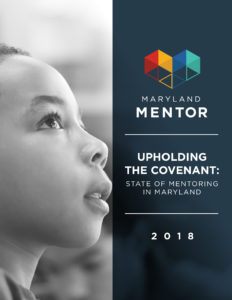 Earlier this year I introduced you all to my friend and colleague, Sadiq Ali, Director of Maryland MENTOR (for which I am a board member and the Knott Foundation is a funder).
Earlier this year I introduced you all to my friend and colleague, Sadiq Ali, Director of Maryland MENTOR (for which I am a board member and the Knott Foundation is a funder).
At that time, Sadiq was busy hosting “good old-fashioned town halls” with mentoring programs across Maryland – all the way from Allegany to Anne Arundel! Maryland MENTOR is in its first year of operation, so this process was instrumental in helping inform the organization’s future direction. Fifteen town halls, 200 attendees, and 100 pizzas later, the culmination of Sadiq’s listening tour is encapsulated in Upholding the Covenant: The State of Mentoring in Maryland 2018.
“Think of someone who you see as successful,” the report begins. “Chances are that person or the people who come to mind had a mentor.”
This statement gets to the heart of why mentoring programs exist: because no one can do it alone. We all need advice, emotional support, resources, social connections, and exposure to a world beyond our own to be the most successful people we can be. And when mentors provide that for our youth, great things happen.
I want to be clear, however, that this report isn’t a manifesto on the value of mentoring. Instead, it takes a deeper look at what mentoring organizations look like in our state, who they’re serving, their strengths, and the types of support they need. It also presents recommendations for how all stakeholders, Maryland MENTOR, public and private funders, mentoring organizations, education systems, and the corporate community can help.
In this way, Upholding the Covenant is one of the most comprehensive efforts to map the work of Maryland mentoring program providers and provide recommendations for better supporting them.
One of my favorite features of the report is how it paints a picture for each region of our state, so you can find out the challenges folks are facing in Baltimore City, the types of programs that exist in Northern Maryland, or the strengths of the work organizations are doing on the Eastern Shore. This not only customizes your data consumption to the area you’re working in, it also supports the idea that different communities have different landscapes.
Another great piece of information that I found useful was the delineation of mentoring models, such as one-to-one, group, hybrid, e-mentoring (who knew!), peer mentoring, and team. These models show how mentoring is so much more pervasive than what we might have imagined, in that mentoring relationships can develop in nearly any youth development context. “Mentoring is like water,” Sadiq said to me the other day, “it takes the shape of whatever vessel you pour it into.”
If you’ve had a mentor in your life, or if you’re mentoring someone now, I hope you’ll take a moment to pick up this report and learn more about what’s happening in the world of mentoring in Maryland and how we all can help support the mentoring community.
By Kelly Medinger
10-22-2018
St. Bernardine Catholic Church in Baltimore City uses Catholic activities grant to launch capital campaign and renovate Church’s entrance

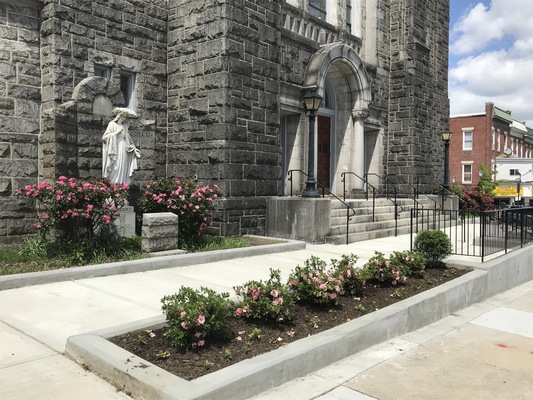 Situated in the Edmondson Village neighborhood of West Baltimore, St. Bernardine Catholic Church has a storied history. As one of the largest Catholic parishes in the City in the 1950s, it nearly closed 20 years later when it struggled to adapt to changing demographics and a changing Catholic Church.
Situated in the Edmondson Village neighborhood of West Baltimore, St. Bernardine Catholic Church has a storied history. As one of the largest Catholic parishes in the City in the 1950s, it nearly closed 20 years later when it struggled to adapt to changing demographics and a changing Catholic Church.
In 1975, Msgr. Edward Miller arrived and chose to see opportunity in the face of the Church’s challenges. He worked with the community to grow St. Bernardine’s into the largest African American parish in the Archdiocese of Baltimore. Today, under the leadership of Msgr. Richard Bozzelli, the parish serves 900 households and is celebrating its 90th anniversary year.
A Pillar of the Community
“Father Miller was a pillar of the community,” reflects Msgr. Bozzelli. “His philosophy was, let’s look at who the neighborhood is and put a Church together for the neighborhood.’ He knew everybody and was highly respected.”
The legacy of Msgr. Miller lives on at St. Bernardine’s. Multiple generations of families remain active in the parish, including the family of one of the first African American parishioners. Even the Church’s leadership is inspired by Msgr. Miller’s approach. The current Pastor was mentored by Msgr. Miller for more than 20 years. He became Pastor of St. Bernardine’s in 2014, a year after Msgr. Miller died, and helped the parish emerge from its grief.
Msgr. Bozzelli’s focus on the community has been a steadying force: the parish is active in the local community association, 40 West Ministries; they host an ongoing food pantry; they provide Christmas gifts and dinner to 100 families each year; and they host an annual neighborhood walk on Martin Luther King Day in honor of their late pastor.
A New Capital Campaign
Built in 1928, St. Bernardine’s Church continues to have a strong spiritual presence, but a deteriorating structural one. Msgr. Bozzelli recently launched a capital campaign, Destined Under the Dome, to make some much-needed repairs and upgrades. The initial campaign goal was $800,000, and the Church has pledges just shy of $900,000.
A grant from the Knott Foundation, designated to repair the exterior steps leading up to the Church, helped kick-off the campaign. With the Foundation’s funds as well as help from parishioners and the Archdiocese, the entrance to the Church was renovated to include new steps, a landing with a small courtyard, and multiple access points from the Edmondson Avenue and Mt. Holly Street.
“When people can see concrete progress – and in this case, it was literally concrete – they are energized,” shares Fr. Rich. “The funding the Knott Foundation gave us really launched our campaign. I’m not sure we would’ve had the same result without it.”
By Kathleen McCarthy
10-15-2018
Announcing our most recent grant recipients in Catholic activities, education, health care, and human services
We are pleased to announce that 19 organizations received over $860,000 in our October grant cycle.
Catholic Activities
- The Catholic Community of South Baltimore: $85,000 to support the replacement of the boiler system at Holy Cross Church located in the Federal Hill neighborhood of Baltimore City
- Jesuit Volunteer Corps: $20,000 to support the recruitment, training and on-going work of five Baltimore-based Jesuit Volunteers committed to serving the poor and marginalized
- Saint Clare Parish: $25,850 to support the renovation of this Catholic church’s convent in Essex for use as housing for the Operation TEACH program, a post-graduate service program for teachers in Catholic schools
- St. Mark Roman Catholic Church: $45,000 to support the Faith is Cool Capital Campaign to replace the HVAC system at this Catholic Church located in Harford County
Education
- Acts4Youth: $45,000 to support the expansion of this comprehensive mentoring program for youth into Cardinal Shehan School, a Catholic K-8 school in Baltimore City
- Mercy High School: $125,000 to support the construction of a new turf field complex at this all-girls Catholic high school in Baltimore City
- Mount Saint Joseph High School: $88,630 to support campus-wide technology upgrades at this all-boys Catholic high school in Baltimore City
Health Care
- St. Joseph’s Nursing Home: $100,000 to support the roof replacement at this 44-bed nursing home in Catonsville run by the Congregation of the Sisters Servants of Mary Immaculate
Human Services
- Arc Baltimore: $25,000 to support the expansion of the Career Catalyst program, which helps individuals with disabilities find competitive wage employment that aligns with their interests
- Associated Catholic Charities: $50,000 to support ESOL programming (English for Speakers of Other Languages) for immigrant children and adults at the Esperanza Center in Baltimore City
- Associated Charities of Cumberland: $12,000 to support the general operating costs of this organization dedicated to promoting a healthy and housed community in Cumberland
- CASA of Baltimore: $19,760 to support the fundraising capacity of this organization, which deploys trained volunteers to speak up for the best interests of foster children in Baltimore City’s Juvenile Court
- Community Assistance Network, Inc.: $10,000 to support the general operating costs of this outreach services organization serving Baltimore County’s low-income residents
- Govans Ecumenical Development Corporation (GEDCO): $40,000 to support mental health treatment for residents at GEDCO’s Harford and Micah Houses, which provide permanent supportive housing for men and women in Baltimore City who were previously homeless
- Harford Community Action Agency: $24,348 to support one year of maintenance and operations of a refrigerated truck delivering approximately 55,000 pounds of food per month to those experiencing food insecurity in Harford County
- Itineris: $36,000 to support the acquisition of technology hardware and software to enable this organization serving adults with Autism Spectrum Disorder (ASD) in Baltimore improve their data tracking and service delivery for clients
- Living Classrooms Foundation: $50,000 to support Project SERVE, a job-training program serving Baltimore City adults returning to the community from incarceration
- The Religious Coalition for Emergency Human Needs: $50,000 to support the Emergency Family Shelter Program, which provides housing and supportive services to approximately 40 families in Frederick County each year
- Women’s Housing Coalition: $15,000 to support general operating costs for this supportive housing program in Baltimore City that serves formerly homeless women and children
By Kelly Medinger
10-12-2018
Baltimore Chesapeake Bay Outward Bound School uses education grant to send students from two all-girls Catholic schools in Baltimore City on a character-building expedition
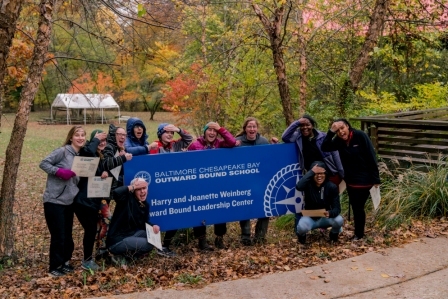 “Ships are safe in harbor, but that’s not what ships are built for,” says Leanna Powell, Fundraising Manager at Baltimore Chesapeake Bay Outward Bound School.
“Ships are safe in harbor, but that’s not what ships are built for,” says Leanna Powell, Fundraising Manager at Baltimore Chesapeake Bay Outward Bound School.
She uses the ship metaphor to describe the organization’s work: “We prepare students to leave the safe harbor of their home, their family, and their community. We give them authentic challenges to confront, on wilderness expedition trips or our Baltimore City ropes course. Then they return home safely – mentally stronger and with the confidence that they can overcome challenges in their own lives.”
About Outward Bound
Outward Bound has been serving the Baltimore community for 32 years. As an educational organization and expedition school, people of all ages and backgrounds participate in active learning expeditions that inspire character development, self-discovery, and service both in and out of the classroom.
“We think of ourselves as a partner to schools,” explains Powell. “Where the traditional classroom might be limited, we can step in with our curriculum and outdoor classrooms to teach kids how to overcome very real challenges, hone their own leadership skills, and develop a greater sense of compassion for others.”
Character & Leadership Initiative for Girls
The Knott Foundation funded the Catholic Girls Character & Leadership Initiative at Outward Bound, which offered programs for two Catholic girls schools in Baltimore City.
The partnership included Sister’s Academy, a tuition-free middle school, and Mercy High School. Nearly 200 students from these schools participated in Insight days, which include a rigorous outdoor challenge course and character education curriculum. Small groups of students from each school also participated in 5-day expedition trips – canoeing on the Potomac and hiking the Appalachian Trail.
Notably, 100% of the girls participating showed gains in emotional self-efficacy, conflict resolution, problem solving, and perseverance. “Ultimately, all teens are at risk, and the window to make an impact on their development is short. What we do helps them make decisions that chart a course for the rest of their lives,” states Ginger Mihalik, Executive Director.
In Their Own Words
The girls who participated in the expedition trips were challenged and changed by their experience. At the end of the trip, their comments ranged from, “Thank you for giving me this opportunity to experience a different environment other than my house,” to, “I got to know myself in ways I may have never seen without this trip. I am now able to trust myself that I am able to do more than what I think.”
Perhaps one participant summed up her transformation the best: “Entering the expedition I was closeminded, not confident, and completely unwilling to try new things. Through this week, I made new friends and hiked more than I ever thought I could, volunteered to be a navigator twice, and ate food of all kinds. I would never exchange this experience for anything.”
By Kelly Medinger
08-23-2018
Charm City Care Connection uses health care grant to help marginalized residents in Baltimore link to high-quality medical care and social services
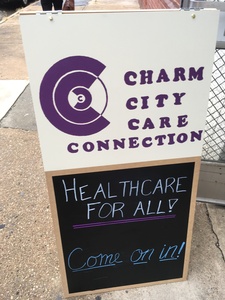 When Macy showed up at Charm City Care Connection’s clinic in East Baltimore, she wanted help getting medical insurance coverage. The case management team signed her up for Medicaid and reconnected her with her primary care doctor. They also recommended she do some preventative health screenings their medical team was offering that day – which was how they found her blood pressure was dangerously high.
When Macy showed up at Charm City Care Connection’s clinic in East Baltimore, she wanted help getting medical insurance coverage. The case management team signed her up for Medicaid and reconnected her with her primary care doctor. They also recommended she do some preventative health screenings their medical team was offering that day – which was how they found her blood pressure was dangerously high.
Without insurance for several months, Macy had been cutting her blood pressure pills in half to save money. Now facing a health crisis, the clinic staff rushed her to East Baltimore Medical Center where a medical team got her blood pressure under control and restarted her on the correct dosage of medication. Crisis averted.
About Charm City Care Connection
Founded in 2009 by Hopkins students in collaboration with the East Baltimore community, Charm City Care Connection (CCCC) helps Baltimore’s poorest families access high-quality medical care and social services. CCCC staff and volunteers meet with clients through walk-in clinic hours at two community locations and build long-term relationships with them through home visits, phone calls, text messages, and hospital visits.
“Macy’s case is a wonderful example of how we connect residents to the health care they need and want, and also find undetected health issues that could easily get out of hand,” says Wynn Engle-Pratt, Executive Director of CCCC. Macy is now working with CCCC’s medical student volunteers on long-term goals to continue to improve her health and wellbeing.
Expanding to Meet the Needs
CCCC received a Knott Foundation grant in 2017 to expand its services and open a second clinic location. Using neighborhood indicators, the organization selected Dee’s Place as their second site. Dee’s Place is one of the only 24-hour-a-day addiction programs in Baltimore, and research shows addiction issues have a strong correlation with chronic health and social service needs.
With two locations in East Baltimore that residents know and trust – Dee’s Place, and one at The Men and Families Center – CCCC has seen its client base grow by more than 40% and has been able to make even more referrals to social services. Most often, clients need help getting dental care, finding affordable stable housing, and enrolling in medical insurance. Access to mental health treatment is a rising need as well.
“Overall our success rate is about 75% for meeting a client’s individual need for services,” notes Engle-Pratt. The most common barriers are dental care (which is often not covered by insurance) and access to mental health treatment.
New Ways to Promote Health and Well-Being
CCCC hasn’t stopped growing. The organization just piloted a community training program for Naloxone use in emergency situations and is now looking to develop a healthy cooking and lifestyle class. They are also preparing to welcome a group of new nursing student volunteers from Johns Hopkins School of Nursing to complement the teams of medical residents and students already dedicating their time to CCCC.
“My future interest lies in how to incorporate Charm City Care Connection’s comprehensive model for meeting patients’ needs into the wider healthcare system,” reflects Engle-Pratt. “There is a real opportunity for primary care to provide day-to-day, long-term case management and address people’s needs for housing and other services that so greatly impact their health.”
By Kelly Medinger
06-30-2018
Announcing our $1 million grant to support urban Catholic education in Baltimore
Our Board of Trustees has awarded a $1 million grant to the Archdiocese of Baltimore, payable over three years, for the construction of a new Catholic school on the westside of Baltimore City.
This marks the first new school the Archdiocese has built in Baltimore in 57 years. The school will serve students in grades pre-K – 8 and will advance the educational mission of the Church to provide young people a pathway to a better life grounded in virtue and faith.
“This is an important project for the Archdiocese and an important project for the City.” shares our President, Patrick Rodgers. “As longtime supporters of Catholic education, it’s something that the Knott Foundation is also pleased to support.”
Our founders, Marion and Henry Knott, were devout Catholics, and the Foundation has honored their faith by prioritizing our giving to Catholic organizations, including schools. In the past five years, the Foundation has awarded approximately $4.5 million to more than 55 independent and archdiocesan Catholic schools.
“This singular grant of $1 million represents an extraordinary commitment for the Foundation,” states Patrick. “We believe in Catholic education, we believe in Baltimore City, and we look forward to the opening of the new school.”
By Carol Hoffman
06-29-2018
How our life journey is vividly influenced by how we choose to think about our own talents and abilities
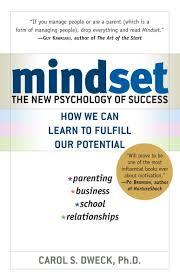 While sitting down recently with one of our grantees, they told us about this amazing book, and how they were going to introduce it as a way to frame their work with youth in their afterschool program.
While sitting down recently with one of our grantees, they told us about this amazing book, and how they were going to introduce it as a way to frame their work with youth in their afterschool program.
The book, Mindset by Carol S. Dweck, demonstrates the power of people’s beliefs and how your success at work, school, sports or in any other phase of your life can be vividly influenced by how you think about your own talents and abilities. Dweck calls these two types of mindsets fixed and growth.
First, let’s talk about a person with a fixed mindset. If you have a fixed mindset, you believe you’re either good or not good at what you do or what you want to accomplish in life, because that’s who you are. You believe your basic qualities, like intelligence or talent, are simply fixed traits. This type of mindset is the most common and also the most harmful to a person.
For example, when a fixed mindset student enters high school, their grades tend to decline, and they blame their teachers or other students for their failures in order to protect their own egos. The student with a fixed mindset needs to learn that through failure, you can find success. A person with a fixed mindset hears the saying, “Nothing ventured, nothing gained,” and to them it means, “Nothing ventured, nothing lost.” The same goes for an athlete. You can be a natural born athlete, but if your mindset is not in the right place and you don’t push yourself to be the best that you can be, in the end you fail.
In a fixed mindset, intelligence is stationary and leads to a desire to look smart. But a person with this mindset has a tendency to avoid challenges, and sometimes they just give up all together and never reach their full potential or ability.
Now let’s look at a person with a growth mindset. This person believes they can be good at anything, once they put their mind and actions first and foremost. A person with a growth mindset feels that they learn by their mistakes, that their own failures are only temporary setbacks – and consequently they try harder.
A student with a growth mindset believes anyone can learn, and they tend to lead a more successful life. If they get a grade below what they think it should be, they find out where they went wrong, and they confront the challenge, and keep working toward a better outcome next time. An athlete with a growth mindset who makes a huge mistake in a game doesn’t dwell on it, but instead realizes their mistake, rights their wrong, and uses the experience to be a better player and better person in the future.
In a growth mindset, intelligence grows. This leads to a desire to learn more, embrace challenges, forge ahead after a setback, and then reach a higher level of success.
In the end we all have our own life journey, and it starts by accepting that we all have both mindsets. Our job is to identify what triggers our fixed or our growth mindset. Dweck tells us you do have a choice. Mindsets are powerful beliefs, but you can always change your own mind. Choosing a growth mindset, therefore, is ultimately what Dweck argues will determine your success in life, more than grit or resilience.
I’m looking forward to hearing from our grantee about how this book influences their work with youth in Baltimore City.
By Kathleen McCarthy
06-19-2018
Announcing our most recent grant recipients in arts & humanities, Catholic activities, education, and human services
We are pleased to announce that 14 organizations received over $850,000 in our June grant cycle.
Arts & Humanities
- B&O Railroad Museum: $74,263 to support capital costs associated with the First Mile Stable Project, designed to create a permanent home for the nation’s oldest continuously operating police mounted unit as well as educational, programming and community space for the Museum
Catholic Activities
Education
- Bishop Walsh School: $50,000 to support general operations of the Advancement Office and major gifts campaign at this pre-K-12 Catholic school in Cumberland
- Institute of Notre Dame: $70,000 to support staffing and other costs associated with the development of a facilities Master Plan at this all-girls Catholic high school in Baltimore City
- Loyola Early Learning Center: $50,000 to support the development office operations of this Jesuit early childhood education program in Baltimore City
- Mother Seton Academy: $100,000 to support the capital campaign to expand the facilities at this co-ed, tuition-free Catholic middle school in Baltimore City
- Sacred Heart School of Glyndon: $76,000 to support technology enhancements in grades 4 through 8 at this pre-K-8 Catholic school in Baltimore County
- St. Mary Catholic School: $100,000 to support the construction of a gymnasium at this pre-K-8 Catholic school in Hagerstown
Human Services
- Caroline Center: $50,000 to support the general operations of this Catholic, tuition-free employment training program in Baltimore City for women in health care
- Churches for Streets of Hope: $12,000 to support the expansion of case management services at this community-based homeless services organization serving Southeast Baltimore County
- Helping Up Mission: $50,000 to support general operating costs associated with the education and workforce development program for homeless, poor, and addicted men in Baltimore City
- Interfaith Service Coalition of Hancock, MD, Inc.: $60,000 to support the renovation of Martha’s House, a youth center and summer feeding site, as part of the organization’s larger mission to assist families and individuals in need in Hancock
- Manna House: $50,000 to support general operating costs of this drop-in center that feeds and supports up to 200 men and women a day who are living in need in Baltimore City
- St. Vincent de Paul of Baltimore: $65,000 to support the installation of a new HVAC system at the Pimlico Head Start site, one of many program sites at this 150-year old community service provider in Baltimore
By Kelly Medinger
05-10-2018
A conversation with Sadiq Ali, Director of Maryland MENTOR
 I recently caught up with Sadiq Ali, the founding director of our state’s new national mentoring affiliate, Maryland MENTOR. Its mission is to fuel the quality and quantity of mentoring relationships for Maryland’s young people and to close the mentoring gap. Given the Knott Foundation’s interest in supporting the mentorship of older youth in out-of-school time programs through our BOOST initiative, Sadiq’s perspective and work in the field is both relevant and timely.
I recently caught up with Sadiq Ali, the founding director of our state’s new national mentoring affiliate, Maryland MENTOR. Its mission is to fuel the quality and quantity of mentoring relationships for Maryland’s young people and to close the mentoring gap. Given the Knott Foundation’s interest in supporting the mentorship of older youth in out-of-school time programs through our BOOST initiative, Sadiq’s perspective and work in the field is both relevant and timely.
Tell me about yourself and what attracted you to lead Maryland’s new mentoring affiliate.
On a spiritual level, I believe that when something is chosen for you, nothing can keep you from it. And likewise, when something’s not meant for you, it doesn’t matter how clear the path is towards that thing, it still is not for you.
I believe this role was really meant for me. Each person’s “sweet spot” is where passion meets ability. For me, I’ve always had a passion for supporting young people and seeing them do their absolute best. Of all the resources that we have available to us, I believe that people – our human capital – is what makes everything else go. If we invest in that, everything else takes care of itself. This role was the perfect meshing of my skills and passions, in the sense that I’ve always thought of myself as a people developer, and Maryland MENTOR is coaching people and organizations to work better with young people.
Also, coming from a situation where I was an entrepreneur (Sadiq founded and led a training and leadership development organization for six years), the opportunity to build this affiliate to become effective and impactful throughout the state was attractive to me because the entire path isn’t necessarily laid out.
Who in your own life stands out as a mentor, and what qualities made that person a good mentor?
My first mentors really came into my life when I was in middle school. I’ll never forget them. Mr. Shabazz, Mr. Phillips, and Mr. Alfred. They started an all-boys after-school program at my middle school in Prince George’s County. The name of the program was Umoja, which is Swahili for unity. The program was all about us being unified as a school, learning about our African heritage, and learning about leadership. I’m actually still in contact with these gentlemen today.
Two of the biggest characteristics my mentors brought to bear when they were with us every day were, first, they exposed us to new things. Opening the eyes and minds of young people so they can go explore what might be of interest to them is so important. Second, they listened very, very well without judging. This is critical for mentors. Too many times we judge young people for decisions that they’re making when they’re doing the best they can with what they have. You have to listen without judgement, while still offering feedback and support. The mentors that I had in my life early on absolutely did these things.
How many states have a national mentoring affiliate, and what resources does it bring to bear?
Twenty-six states have a mentoring affiliate right now, and there are plans in place to bring on another three or four by the end of this year. I think Maryland was the 25th affiliate, Georgia came after us, and DC and Greater Milwaukee are following closely on our heels.
The number one resource these affiliates offer is bringing best practices for mentoring to all of the different mentoring programs across a service area. We’re tied into this national network, which allows us to hear the best of what really high performing programs are doing across the country, and bring that information back to our own state’s mentoring programs. For example, we have the Elements of Effective Practice, which are six standards that are evidence and research-based that every mentoring program should have familiarity with. But if you’re operating in a silo, you don’t have the benefit of that information. We unify the mentoring ecosystem in our service area by bringing these best practices, training opportunities, and consulting to mentoring organizations.
Why is mentoring so important for youth, especially youth coming from disadvantaged circumstances?
First and foremost, I’ll say that mentoring is too often seen as just being of great benefit to young people from disadvantaged backgrounds. This is one thing that I’m really working to shift the paradigm on. Mentoring – and I want to this make really, really clear – mentoring benefits all young people across the board. Absolutely there are more challenges for our young people coming from areas of high crime and poverty, but every young person can benefit from a mentor. The reason is that no young person, even those who come from families of means, gets out of making tough decisions and choices in life.
I strongly believe that young people can’t be what they can’t see. Mentors not only allow young people to be exposed to a caring and thoughtful adult, but if that mentor’s effective, a young person is exposed to a variety of things, a variety of people, and a variety of environments. And that exposure can set them off on a course that they might not have discovered on their own.
What are some of the “big opportunities” you’re hoping to capitalize on in Maryland’s mentoring sector?
First of all, there is a communication gap – a big, wide communication gap. Many of our programs that have been operating for all lengths of time – newer programs to some more mature programs – simply aren’t aware of some of the resources that are available to them. That’s been one of our key focuses early on, creating an email, social media, and communications strategy to connect folks to different resources. For example, there’s a national mentoring summit that takes place annually in DC. This past January was the eighth one. It was my first month on the job, so when I came back from the summit and was talking to organizations here in Maryland for the first time, I’d say, “Wow, I wish you’d been there!” And they would literally say, “What summit?” We’re talking about a conference with over 1,000 folks from across the country, all involved in mentoring in some way, shape or fashion, with hundreds of workshops by youth development experts. If an organization had sent a representative to that program, they would’ve filled their cup for an entire year. And they didn’t even know about it.
The other gap is around exposure to best practices, such as the Elements of Effective Practice I talked about earlier. There are tons of programs doing excellent work, and doing the best they can, that are operating without the best information available. That’s a huge opportunity for us to be out in the community and present it to them as a way to tighten their programs even more, and potentially have an even greater impact on the young people they’re already working with.
Any common themes that you’re hearing from mentoring organizations in Baltimore regarding their biggest needs and challenges?
Probably the top three themes would be mentor recruitment, fundraising, and parent/community engagement.
For mentor recruitment, we’re immediately directing programs to resources around creating segmented mentor recruitment strategies. This has been one of the big concepts that we’ve introduced so far to the ecosystem, that you can’t have a one-size-fits-all mentor recruitment strategy. If you want more black men, there has to be a segmented strategy for that. If you want more professional women, more seniors, or more college students – each one of these requires a different strategy.
The second challenge is funding. How do we – especially for the smaller programs – not consistently have to dig into our own pockets? Even though these are passion projects and a labor of love, it shouldn’t be leading people to financial ruin just to sustain the work. We’ve had a lot of conversations with programs so far about what funders are looking for, which is a great opportunity for collaboration with our affiliated funders like the Knott Foundation. We can help programs meet those standards. For example, we have a team of consultants that can help organizations develop solid mission statements, vision statements, logic models, and accompanying outcomes that can then be reported to a foundation with the message, “Hey, here’s what we’re doing on a shoestring budget. Imagine what we could do with an infusion of $25K or $50K.”
The last one would be parent/community engagement. The question here is, how can we get holistic support from each young person’s network? We’ll definitely be rolling out some more resources along those lines in the near future.
Tell me about some of the connections you’ve made in the community since coming on board.
We’ve connected to the Mayor’s Office, both in Human Services and their new Office of African American Male Engagement. We’ve also had the opportunity to attend the Mayor’s call to action meetings around holistic strategies for violence reduction in the city, where mentoring is a critical component. I’ve been named to MBK (My Brother’s Keeper) Baltimore’s Board of Directors, as they work to develop a citywide strategy to pursue MBK’s Community Challenge Competition to improve life outcomes for boys and men of color. And lastly, we’ve made great connections with the 24 local management boards for children, youth, and families, as well as the Governor’s Office for Children.
What accomplishment are you most proud of in your first 90 days at Maryland MENTOR? What are you most looking forward to in the year ahead?
There are several accomplishments. Getting our website up was a big undertaking. Scheduling town hall meetings – that’s been a big one. We’ve scheduled 14 different mentoring town halls across the state. We’re so excited to get the feedback from programs about how we can do the best job supporting them. And lastly, getting our training and consulting cadre in place. We have eight consultants who are experts in the mentoring field and are ready right now to start working with programs across the state in raising their standards.
In the year ahead, I’m excited about expanding our team. As we’ve made more of a mark and folks are aware that we exist, we’re getting more requests for services and support, which means this can’t be a one or two person operation. We were actually just approved for a second AmeriCorps VISTA and we’re searching for an intern right now to help with a couple projects we have in the hopper. I’m also excited to be talking to the Mayor’s Office about a major citywide mentor recruitment campaign. That’s all I can say right now about that!
As we’ve discussed in the past, the Knott Foundation’s BOOST initiative underscores our interest in supporting OST programs that mentor older youth. Any words of advice as we continue down that path?
Earlier this week we sent a Maryland delegation to the Charles Stewart Mott Foundation’s 50-state afterschool network conference. A lot of folks we met at the conference were really intrigued by the purposeful collaboration between the mentoring ecosystem and the out-of-school-time ecosystem here in Maryland; in other words, how do we integrate more local mentoring programs into the out-of-school time space? Even our MSDE representative who was part of the delegation was talking about the possibility of linking funding for OST programs to relationships with mentoring programs. That could be a tremendous BOOST (pardon the pun) to the work both Maryland MENTOR and Knott are already doing. In terms of words of advice, this speaks to the fact that we have to be purposeful about our collaborations – seek them out where we have shared values and outcomes.
Is there anything else you’d like to share?
First, I’d like to share that I’m excited to be in this role because one of my beliefs is that we don’t choose this work, it chooses us. Anything that involves supporting another human being in the active pursuit of their goals or that improves the world, that work chooses us. Second, it remains our collective responsibility to support those who support others.
By Kelly Medinger
05-03-2018
Baltimore Center Stage uses arts and humanities grant to provide access for all
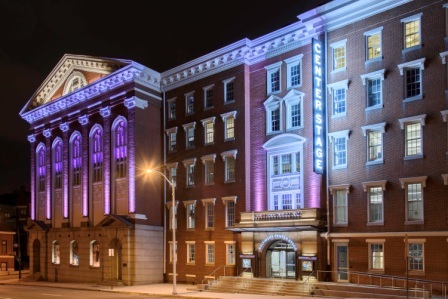 When he’s not running the Front of House at Baltimore Center Stage, you might find Alec Lawson, Audience Services Manager, narrating one of the theater’s productions for a visually impaired audience member.
When he’s not running the Front of House at Baltimore Center Stage, you might find Alec Lawson, Audience Services Manager, narrating one of the theater’s productions for a visually impaired audience member.
The audience member wears an earbud, with Alec (or another trained member of his staff) providing a detailed, live audio description of the set, costumes, entrances and exits of each actor, and action on stage. “Doing a good audio description is tricky,” says Lawson. “You have to watch the show many, many times to learn how to break it down, and you have to share information strategically since you can’t talk while an actor is talking.”
About Baltimore Center Stage
Founded in 1963, Baltimore Center Stage is the City’s leading professional producing theatre, named the State Theatre of Maryland in 1978. It welcomes nearly 100,000 people each season from all 24 Maryland counties.
In 2017, the theatre completed a $33 million renovation, which included upgrades to the technology and services available to patrons with special access needs. The Knott Foundation supported Baltimore Center Stage with this work, awarding a grant for new assistive listening devices, improved captioning services, American Sign Language interpreted performances, increased audio description offerings, and more availability of Braille and large print programs.
An Enhanced Theatre Experience
Audiences are putting the new services and equipment to good use.
Approximately 750 people each season benefit from assistive listening devices and captioning services, and another 15 members subscribe to the American Sign Language interpreted performance of the mainstage productions. Braille and large print programs continue to be printed at 20 per show.
An average of 100 people also attend “touch tours” of the theatre each season, where they learn about a particular performance by touching props, costumes, and stage items. While staff originally designed the tours for the visually impaired, a large number of attendees have been children. “By opening the touch tours to everyone and attracting lots of kids, it has created a really nice sense of community where we can all interact together to experience theatre,” comments Lawson.
A Commitment to Diversity and Access
“Diversity and access are key priorities for Baltimore Center Stage,” notes Brandon Hansen, Institutional Giving Coordinator. He points to the evidence: One quarter of their audience identifies as a race other than white, and over a third of households have an annual income below $75,000. The newly renovated Head Theater is equipped with removable seats accessed immediately from the entrance ramp, with wheelchair accessible seats built into the theater’s design. Anyone can email access@centerstage.org with a question and one of eight staff members trained in accessibility issues will respond.
Baltimore Center Stage’s accessibility program has achieved national recognition, so much so that Lawson and a colleague have been invited to present at the Leadership Exchange for Arts and Disabilities. Their presentation will address how to create inclusive programs that reflect diverse communities, how diversifying opens perspectives and opportunities, and the role volunteers play in a successful accessibility program.
“Access for all applies to everyone,” emphasizes Lawson. “We often talk about access in the context of race or socioeconomic status, but access needs exist across a wide spectrum.” That could include people who have low vision, are hard of hearing, or have a family member with autism. “These groups with special access needs have often been taught to hide,” Lawson continues. “Here at Center Stage, we want to make theater a welcome place for everyone, to come as you are.”
By Kelly Medinger
05-03-2018
Partners In Care uses human services grant to harness the talents of its members to support the independence of older adults
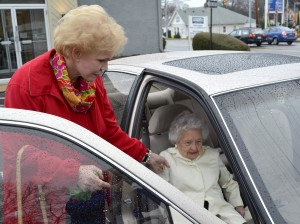 “It’s my heart and soul, and the most phenomenal place I’ve ever worked,” declares Mandy Arnold, President & CEO of Partners In Care in Anne Arundel County. Reflecting on her 23-year career in healthcare, she is thankful to be in a place where community members come together to help one another, with a special focus on the senior population.
“It’s my heart and soul, and the most phenomenal place I’ve ever worked,” declares Mandy Arnold, President & CEO of Partners In Care in Anne Arundel County. Reflecting on her 23-year career in healthcare, she is thankful to be in a place where community members come together to help one another, with a special focus on the senior population.
About Partners In Care
For 25 years, Partners in Care (PIC) has helped older adults remain independent and an active part of their community, through the exchange of the time and talents of its membership. Its membership has grown dramatically since its founding, from 13 volunteers helping roughly a dozen seniors, to more than 900 volunteers helping upwards of 1,000 older adults.
PIC’s services mostly consist of transportation and home repairs, both of which support seniors aging in place. Members do not pay money for these services, but rather give their time and talent in exchange for them. The membership process includes an application, orientation, and background check. Whether a member is a provider or receiver of services, everyone is considered a member, and no one is turned away.
The Knott Foundation has awarded PIC five grants over the past 15 years, most recently for general operating support. “We could not do what we do without this type of support,” shares Mandy.
Stories From the Field
One PIC member drove a patient to her chemotherapy appointments for an entire first round of treatment. When the patient needed a second round of treatment, the member rearranged her schedule so that she could be the one to continue driving her. The patient’s cancer is now in remission.
Another member had been driving a 94-year-old woman to the grocery store for some time, when a new PIC volunteer took the shift. The member called to check-up on the new volunteer and make sure he was “doing everything right,” Mandy laughs. “She wanted to make sure the new volunteer was going into the store with the woman, getting everything on her list, stopping to buy her and her husband a sub on the way home, and putting all the groceries away in the cupboard once they were home.”
A Talent Bank
When asked how PIC has managed to grow over the years and still maintain such a personal touch, Mandy states, “Everyone is treated with dignity and respect. Their value is based on the time they can commit, not monetary net worth. Members feel it is a give and take, and not a charity.”
Leveraging the time and talent of members is a serious part of PIC’s service model. Some members provide home repairs. Other members write birthday cards to the general membership. Recently, 25 members baked deserts for a local fundraising event.
“Everyone has their own talent and all of these talents together is what we were created to be – an organization of neighbors helping neighbors,” Mandy concludes.
By Kathleen McCarthy
03-14-2018
An absorbing case for the role of self-determination, trust and community to win the War on Poverty
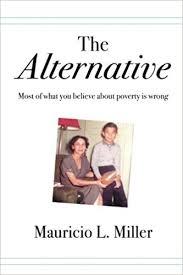 More than 50 years ago the War on Poverty was launched by then President Lyndon B. Johnson to “not only relieve the symptom of poverty, but to cure it and, above all, prevent it.” What has followed, however, has not eradicated or prevented poverty but, in the words of the author, merely made the condition of poverty tolerable.
More than 50 years ago the War on Poverty was launched by then President Lyndon B. Johnson to “not only relieve the symptom of poverty, but to cure it and, above all, prevent it.” What has followed, however, has not eradicated or prevented poverty but, in the words of the author, merely made the condition of poverty tolerable.
Born to a single mother who came to the U.S. from Mexico to make a better life for her family, the author’s mother, Berta, worked tirelessly to build opportunities for her two children to live the American dream. And yet, as hard as she worked, Miller saw his mother’s efforts discounted and her worth diminished by people and programs that viewed her and others like her as weak, incapable, and in need of prescriptive forms of charity.
In The Alternative, Miller argues that the current state of philanthropy and the nonprofits it funds is based on a flawed premise that poor families are helpless and incapable of making the necessary choices to move themselves out of poverty without the assistance of an “expert” guiding, or in some cases dictating, the way.
What has resulted is a largely paternalistic system of programs that fail to recognize the grit, creativity, interests, work ethic and desire for self-determination of the poor. Running alongside of these programs is a system of federal policies that, while helpful in moments of crisis, do little to move and stabilize the poor once they make their way out of poverty and into what can be arguably worse – the world of the working-poor.
Miller’s book does a great job of providing qualitative and quantitative data to demonstrate his argument and builds an eloquent case for flipping the script using his life experiences as the child of an immigrant, a leader of “paternalistic” nonprofits, and the founder of the Family Independence Initiative (FII). FII is dedicated to ending the cycle of poverty by relying upon the expertise of the poor to create their own solutions; rather than leading with degreed expertise, it chooses to follow and reward the ingenuity and hard work that the poor are already doing to move and maintain themselves out of poverty.
The book highlights that while poverty is often painted as a permanent (and sometimes welcome) state, in reality, 75% of low-income families move themselves out of poverty in four years or less. But 50% find themselves below the poverty line again within five years. The author points out that this constant cycling has more to do with a lack of access to networks and meaningful resources than laziness and an unwillingness to work.
While the path out of poverty is not a linear one, Miller argues that it is a path well-travelled by those in the middle and upper classes, because it is based upon networks. The work of FII and the premise behind The Alternative is to provide the poor with access to networks to create their own solutions to their own challenges. In fact, the work of FII is so focused on the self-determination of their clients that if an FII employee is identified as offering help, no matter how small, they are fired! The goal of the program and this “alternative” approach is to put the power in the hands of the poor; to invest in the work they are already doing and let them lead the way.
By flipping the traditional anti-poverty script, Miller’s FII is showing some very intriguing results. For example, a $2,400 investment in a family over two years, either through matches towards documented savings or scholarships towards school, yields 2.4 times more in average income and 2.1 times growth in assets. When Miller was running a workforce development nonprofit, he would invest far more money per client with a much lower yield rate in terms of income earned and assets accumulated.
The Alternative is chock full of food for thought when it comes to thinking about poverty, philanthropy and the human condition. Its emphasis on promoting self-determination and trust as a platform for poverty eradication over traditional models of support that in many ways promote dependence and distrust is a fascinating and hopeful read. Although I am not a military strategist, it seems that after over fifty years of a particular strategy, it might be time to consider this Alternative if we really want to win the war.
By Kelly Medinger
03-08-2018
Celebrating 40 Years of Giving
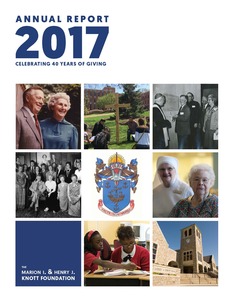
I am pleased to announce the publication of our 2017 annual report.
Our 2017 annual report celebrates the Knott Foundation’s 40th anniversary year, marking four decades of giving to organizations strengthening communities in the Archdiocese of Baltimore. To commemorate this milestone, we also released a short film last year about the history and mission of the Foundation. You can watch it here.
Our annual reports are a wonderful archival resource of the Foundation’s grantmaking activities, as well as a way to learn about the positive impact of some of our recent grants in education, human services, health care, arts & humanities, and Catholic activities. For a collection of our past annual reports click here.
I hope you enjoy reading our 2017 annual report and learning more about the Knott Foundation’s mission to strengthen the community.
By Kathleen McCarthy
02-23-2018
Announcing our most recent grant recipients in Catholic activities, education, health care, and human services
We are pleased to announce that 10 organizations received over $750,000 in our February grant cycle.
Catholic Activities
- Ignatian Volunteer Corps.: $30,000 to support general operating costs for the Baltimore regional office, which pairs older adults with volunteer opportunities at area nonprofits and supports their work through Catholic spiritual reflection
Education
- Mount de Sales Academy: $116,477 to support classroom renovations at this Catholic, all-girls high school in Catonsville
- Our Lady of Mount Carmel School: $105,000 to support technology upgrades at this Catholic, co-ed pre-K – 12 school in Essex
- Saint Margaret School: $100,000 to support the upgrade and replacement of the heating and air conditioning system at this Catholic, pre-K – 8 school in Bel Air
- St. Jane Frances School: $75,000 to support technology upgrades at this Catholic, pre-K – 8 school in Pasadena
Health Care
- Mission of Mercy: $100,000 to support the purchase of a mobile dental van to provide free dental care to patients in need in Baltimore, Carroll, and Frederick Counties
Human Services
- Associated Catholic Charities, Inc.: $40,000 to support the implementation of a trauma-informed care model for children at St. Vincent’s Villa, a comprehensive residential facility for children ages 5-14 whose behavioral and emotional needs have not responded to community-based interventions
- At Jacob's Well, Inc.: $100,000 to support operating and capital needs at this organization providing housing and wrap-around services to the mentally ill homeless in Baltimore City
- Baltimore Child Abuse Center, Inc.: $50,000 to support the grants management capacity of this organization providing training and services in Baltimore City to keep kids safe
- Women's Care Center of Maryland Incorporated: $60,000 to support salaries and supplies at this pregnancy resource center in Baltimore County
By Kelly Medinger
02-23-2018
Announcing our second round of grant recipients in our Building Opportunities in Out-of-School Time initiative
Kids need committed and caring adults to help them navigate life. Out-of-school time programs are a great avenue to build those relationships and help them realize their full potential. Yet an increasing number of low-income students are on the sidelines, and older youth in particular (those in middle and high school) often face the most complex barriers to participation.
Our BOOST initiative focuses on reaching these older youth. Our goal is to engage and retain them in comprehensive out-of-school time programs that promote enduring life skills. Recognizing there are many ways to do this, our strategy is all about relationships.
In our research and conversations with field experts, we learned a growing body of evidence suggests that a consistent relationship with a caring adult is the single most important ingredient to increasing the likelihood that a young person will flourish and become a productive adult.
Through our BOOST initiative, we would like to see organizations demonstrate significant depth, duration, and reach of informal and formal mentoring relationships between older youth and caring adults. With those measures, research says in the long-term these youth will experience improved educational outcomes and labor market success, improved decision-making capabilities, and beneficial effects on a number of other well-being variables – all of which point to our founders’ deep-seated value of education, opportunity, and hard work.
This year we are pleased to announce our second round of BOOST initiative grants, totaling $198,000 to two organizations in Baltimore.
BOOST Awards: Round II
- Baltimore SquashWise: $90,000 grant over two years ($45,000/year) to support the general operations of this organization, which aims to create opportunities for students to realize their academic, athletic and personal potential through the sport of squash
- SAFE CENTER (Safe Alternative Foundation for Education, Inc.): $108,000 grant over three years ($35,000/year one; $36,000/year two; $37,000/year three) to support salary expenses of this organization, which seeks to inform and encourage Baltimore City youth of the importance of obtaining an education and creating an adaptable life plan
BOOST is a 5-year, $1 million initiative. Participation is by invitation only. We look forward to sharing what we learn from this initiative over time.
For a complete description of the program, please visit our BOOST initiative webpage. And to read more about the Foundation’s journey to develop the BOOST initiative, click here.
By Kelly Medinger
02-07-2018
Port Discovery Children’s Museum uses arts and humanities grant to make science fun for students at four Catholic schools in Baltimore City
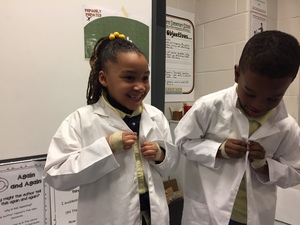 “Science is the way we learn about everything in the world,” wrote one student. She was responding to the question, “How do you feel about science?” after partaking in the Port Discovery Children’s Museum STEMventures program. “Port Discovery’s research-based, proven philosophy is that playful, joyful learning broadens children’s horizons, builds their self-esteem, sparks their creativity, and piques their lifelong interest in subjects like science,” explains Bryn Parchman, President and CEO.
“Science is the way we learn about everything in the world,” wrote one student. She was responding to the question, “How do you feel about science?” after partaking in the Port Discovery Children’s Museum STEMventures program. “Port Discovery’s research-based, proven philosophy is that playful, joyful learning broadens children’s horizons, builds their self-esteem, sparks their creativity, and piques their lifelong interest in subjects like science,” explains Bryn Parchman, President and CEO.
Mission and Outreach
The mission of Port Discovery Children's Museum is to connect purposeful play and learning, with the goal to develop smarter, healthier, engaged kids. Port Discovery is counted among the country's top children's museums and has served nearly five million visitors, or about 270,000 people annually.
In 2016, Port Discovery teamed up with the four Catholic community schools in Baltimore City. Archbishop Borders, Cardinal Shehan, St. James and John, and Holy Angels Schools serve children in grades pre-K-8 from at-risk neighborhoods. “Our relationship with these schools is really an extension of our efforts to reach kids in as many low-income, urban schools as possible,” shares Christina McLoughlin, Grants Director.
Meeting Content Objectives
The Knott Foundation awarded Port Discovery a grant to offer its STEMventures after-school program to students at the Catholic community schools, as well as on-site workshops and field trips.
After participating in five-week program series on themes including primates, nanoscience, and engineering, students from the Catholic community schools showed respectable gains in knowledge. For example, the percentage of students who knew primates are a group characterized by a large brain, 3D vision, and opposable thumbs grew from 46% to 90%. And 88% of students identified the correct image of a DNA molecule, a 60% increase from before the program.
Equally as important, the students had fun. In Nanoscience Exposed, students learned about things too small to see and enjoyed a theatrical performance by New Moon Theater called “Alice in Nanoland.” The Everyday Engineers session taught about the five main branches of engineering – civil, electrical, mechanical, chemical, and aerospace – and allowed students to perform experiments, build structures, and create the ultimate slime.
Building Relationships
Beyond this content area knowledge, Port Discovery strives to create a comfortable atmosphere where children feel they can explore science. That feeling of comfort starts with the people in the room when the program is happening. With the same facilitators from the Museum running all of the programs at each school, students looked forward to their arrival and developed strong bonds with them.
These relationships – coupled with the exciting content of each program series – ultimately helped create more positive attitudes about science. At the conclusion of the program, one student described it best when she exclaimed, “Science is my life!”
By Kelly Medinger
10-30-2017
How growing up rich or poor has changed in America, and why talent and hard work are no longer enough to level the playing field
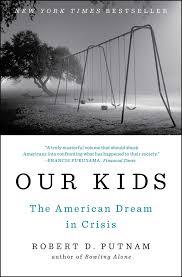 I recently attended the National Forum on Family Philanthropy in Washington, DC, where Harvard professor and best-selling social science author Robert D. Putnam delivered a riveting breakfast plenary presentation on the American dream.
I recently attended the National Forum on Family Philanthropy in Washington, DC, where Harvard professor and best-selling social science author Robert D. Putnam delivered a riveting breakfast plenary presentation on the American dream.
His most recent book – Our Kids: The American Dream in Crisis – paints a picture of how growing up rich or poor has changed in America over the last half a century, and why talent and hard work are no longer enough to level the playing field.
Putnam opened his presentation by describing the phrase “our kids.” He said in his parent’s day, “our kids” referred to all the kids in their city or neighborhood. “We need to build our kids a swimming pool,” for example, meant that all the neighborhood children needed a place to swim in the hot months of summer. Fast forward to today, and the term “our kids” more often refers to one family’s kids, and only one family’s backyard swimming pool.
This social isolation – highlighted by the change in meaning of “our kids” – is a fundamental feature of poor kids’ lives today. A look at some more granular data on children and families further shows indicators of this growing opportunity gap.
“Parents provide their kids with two things: time and money,” Putnam contended while on stage. It turns out that time meeting children’s basic needs (“diaper time” as Putnam calls it) has remained relatively flat and the same across social classes, but developmental time (“Good Night Moon time” as Putnam coins it) as well as money spent on enrichment activities have widened dramatically between the rich and the poor over the last several decades.
The observation about enrichment expenditures caught my attention. As a grantmaker, we have spent a good deal of time over the past couple years learning more about the out-of-school time sector, and specifically opportunities available for older youth in middle and high school. What Putnam described is what we found in our research: ever-widening gaps between youth participation in both school-based extracurriculars and enrichment expenditures by their parents, based on whether you’re rich or poor.
Putnam pointed out that it costs $800/year, on national average, for a high school student to participate in one extracurricular activity like football or band. This “pay-to-play” approach came about in the 1980’s when school boards were under pressure to find new revenue sources. A consequence has been fewer poor kids participating in out-of-school time activities, and many schools in poorer neighborhoods cutting back on the activities they offer. Ironically, research shows that these are the very activities that foster soft skills – things like grit, teamwork and stick-to-it-iveness – that help kids succeed in work and life.
In the end, Putnam’s presentation included just as many stories as statistical data, and his message came across as heartfelt: Most of us believe that everyone in America should have the chance to get ahead if they just work hard enough. But that belief is being shaken to its core as the numbers present a very different story, that money often matters more than ability, and that hard work isn’t always enough.
10-16-2017
A short video celebrating the work of Caroline Center and our relationship with them
In celebration of our 40th anniversary year, the Knott Foundation is releasing three short video stories about our grantees.
This video features Caroline Center, an education and health care career skills training program for women in Baltimore City dedicated to helping each woman see and achieve their potential in their personal and professional life.
By Kathleen McCarthy
10-13-2017
Announcing our most recent recipients in Catholic activities, education, health care and human services
We are pleased to announce that 12 organizations received over $900,000 in our October grant cycle.
Catholic Activities
- Our Lady Queen of Peace Church: $60,000 to support the renovation and repair of the stained glass windows at this Catholic church located in Middle River
Education
- Calvert Hall College High School: $107,000 to support theatre stage lighting upgrades in the Marion Burk Knott Center for Performing Arts at this Catholic, college preparatory high school for boys located in Towson
- Irvine Nature Center: $17,000 to support an environmental education program for students at Cristo Rey Jesuit High School and St. Ignatius Loyola Academy
- Notre Dame Preparatory School: $80,000 to support auditorium lighting upgrades at this Catholic, college preparatory school in Towson serving girls in grades 6 – 12
- Parks & People Foundation, Inc.: $50,000 to support the Branches environmental education and youth leadership internship program for middle and high school students in Baltimore City
- St. Francis Neighborhood Center: $128,147 to support the Count on Me capital campaign for the expansion of this longstanding community center located in the Reservoir Hill neighborhood of Baltimore City
Heatlh Care
- MedStar Good Samaritan Hospital: $50,000 to support equipment purchases for the hospital’s Center for Successful Aging, which provides comprehensive geriatric services to patients ages 65 and older
Human Services
- Marian House: $150,000 to support renovations of the former convent and rectory of the Blessed Sacrament Parish in Baltimore City to provide supportive housing for homeless women seeking to transform their lives
By Kelly Medinger
10-11-2017
Druid Heights Community Development Corporation uses education grant to support programs for youth in west Baltimore
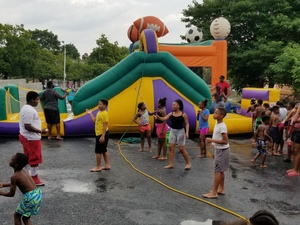 A list of rules sits on every table in Druid Heights Community Development Corporation, where a group of approximately 20 young people are gathered afterschool. “Be respectful to everyone,” and “don’t destroy things” are two points on the list. “The kids came up with these rules themselves,” explains Anthony Pressley, Executive Director, “so they’re worded the way they would talk.”
A list of rules sits on every table in Druid Heights Community Development Corporation, where a group of approximately 20 young people are gathered afterschool. “Be respectful to everyone,” and “don’t destroy things” are two points on the list. “The kids came up with these rules themselves,” explains Anthony Pressley, Executive Director, “so they’re worded the way they would talk.”
About Druid Heights CDC
Established in 1974, Druid Heights Community Development Corporation (Druid Heights CDC) seeks to cause, encourage, and promote community self-empowerment in west Baltimore through economic, educational, employment, and affordable housing opportunities.
“We’ve built more than 100 homes as a community developer,” states Pressley. “And this year we helped 28 families transition from renting to owning their own home. Our key to making this community more successful is home ownership,” he adds.
Enriching the lives of young people
In addition to helping house a wide spectrum of people – from seniors to young families – Druid Heights CDC hosts a variety of youth programs, which the Knott Foundation has supported.
A popular program is the summer camp, which is the only free camp in the neighborhood. The mandatory parent orientation for the camp showcases a video about the disparity between a child growing up in the county and one in the city. “The film helps parents buy in to the program – because if what we’re doing at camp isn’t supported at home, then ultimately we won’t get the kids where we want them to be,” reflects Pressley.
This past summer Druid Heights CDC hosted 86 youth and 40 YouthWorks students in its summer camp, with evaluations showing positive results in preventing summer learning loss, the camp’s primary goal.
“In the afterschool program, we have to be more creative,” says Pressley, explaining that parents often take a more relaxed approach to afterschool and allow their kids to do what they want. “We make it fun so the kids want to come back,” he says, “and provide supper so the parents don’t have to worry about it.”
Creating community partnerships
A large part of Druid Heights CDC’s successful programming for youth comes from community partnerships: the Maryland Food Bank (free supper), the Peabody Conservatory (twice weekly harp classes for youth), the Baltimore Policy Department (mentoring), and St. Peter Claver Catholic Church (gym space), to name a few.
Often these partnerships bear witness to the organization’s commitment to building community and breaking down racial barriers. For example, during the grant period, Druid Heights enhanced its cultural enrichment program for youth by forging a relationship with Beth Am Synagogue, bringing together ten African American teens and ten Jewish American teens for two weekends per month for discussions, lunch, and travel.
“We couldn’t do all this without the support of the community,” Pressley concludes. “Our programming and our partnerships really show our direct impact on families and children in our neighborhood.”
By Kelly Medinger
10-02-2017
Gilchrist Center Baltimore – Joseph Richey Hospice uses health care grant to provide compassionate, personalized care in Baltimore City
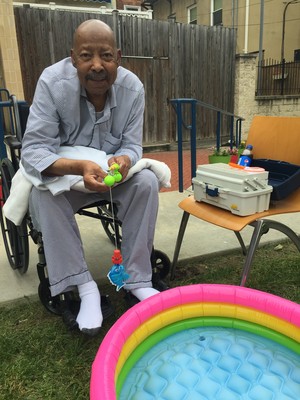 When Melvin came to Joseph Richey Hospice, he likely did not expect a party thrown in his honor. It turns out Melvin loved to fish, and he often spoke to the hospice staff about taking a fishing trip before he reached the end. When a trip with a friend fell through, the staff decided to take matters into their own hands: they threw a fishing party for Melvin in the backyard of the house, complete with a kiddie pool, fishing poles, and party hats.
When Melvin came to Joseph Richey Hospice, he likely did not expect a party thrown in his honor. It turns out Melvin loved to fish, and he often spoke to the hospice staff about taking a fishing trip before he reached the end. When a trip with a friend fell through, the staff decided to take matters into their own hands: they threw a fishing party for Melvin in the backyard of the house, complete with a kiddie pool, fishing poles, and party hats.
For people like Melvin, Joseph Richey Hospice is often the only place to find quality, end-of-life care. “There are no other residential options in Baltimore City for people who don’t have the resources or a strong support system,” remarks Ted Blankenship, Director of Development.
About Joseph Richey House
Joseph Richey House is a 19-bed hospice in Baltimore. No one is turned away due to an inability to pay. Like Melvin, patients often do not have a caregiver at home, or even a stable living environment. Some have experienced homelessness, incarceration, or addiction, and many have been underserved medically.
Patients are referred to Joseph Richey by a physician because they suffer from a terminal illness and have less than six months to live. What they find when they get there, however, is a deeply compassionate medical team and support system, including a social worker, bereavement counselor, chaplain, and more than 20 physicians who volunteer their time to treat patients at the House.
A Baltimore blessing
Joseph Richey was founded in 1987 by The All Saints Sisters of the Poor and Mt. Calvary Church. Since that time, approximately 8,000 patients and their families have been served. The Knott Foundation has supported the organization for ten years.
In 2014, Joseph Richey was acquired by Gilchrist Center Baltimore to bolster its financial standing and prospects for future success. “Both Joseph Richey and Gilchrist saw a need that existed for end-of-life care in Baltimore, that otherwise wasn’t being filled. Joining forces ensured that commitment to serving the City and the underserved,” comments Blankenship.
Gilchrist’s relationship with Joseph Richey has helped the hospice serve more medically complex patients, as well as cover the uncompensated care cost that the small nonprofit faces each year due in large part to the fact that Medicaid does not cover patients’ food and lodging. “We really depend on grants and donations from individuals to be able to deliver the care we are providing,” shares Blankenship.
Looking to the future
“With a strong organizational structure in place, recent capital renovations, and a burgeoning fundraising campaign, we are all very pleased with the growth that’s been happening at Joseph Richey House,” says Blankenship.
“We may be a small nonprofit, often flying below the radar screen,” he notes, “but we always find a way to serve those who need it most… and do so in a way that brings compassion, dignity, and a personal touch to their final life celebration.”
08-17-2017
A short video celebrating the work of St. Francis Neighborhood Center and our relationship with them
In celebration of our 40th anniversary year, the Knott Foundation is releasing three short video stories about our grantees.
This video features St. Francis Neighborhood Center, a community-based organization located in Reservoir Hill dedicated to ending generational poverty and strenthening connections in the Baltimore community.
By Kelly Medinger
08-14-2017
A Q&A with trustees about the family’s participation in our grantmaking process
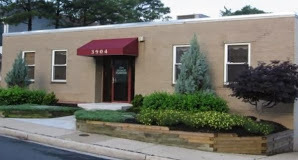 This is the third post in a multi-part series that explores a year in the life of the Knott Foundation behind the scenes
This is the third post in a multi-part series that explores a year in the life of the Knott Foundation behind the scenes
Did you know that 93% of Knott Foundation trustees conducted one or more site visits in the community last year?
This hands-on approach that our trustees take in our grantmaking process is one of the unique components of the Knott Foundation’s operations. In essence, our board of 28 family members from 3 generations functions not only as the governance body of the Foundation’s assets and charitable activities, but also as “a team of volunteer program officers” – evaluating grant requests, conducting site visits, and reporting back to their fellow board members each year.
As part of our “behind the scenes” blog series, we’re taking a look at the inner workings of the Knott Foundation, from strategic planning to grantmaking. This is the third post in the three-part series:
- Part I (read it here) recapped our strategic journey over the past three years to share our donor intent and legacy, explore our own talents and resources, and create a common education base around community needs and conditions.
- Part II (read it here) examined what happens behind the scenes with grant applications – from the time a letter of inquiry comes in the door to when a final grant report is submitted.
- Part III (this post) features a Q&A with trustees about the family’s participation in our grantmaking process, including reflections on their giving philosophies and experiences as site visitors.
Recently, I sat down with several longtime trustees of the Knott Foundation to hear their perspectives on how we approach our grantmaking and what they look for in grant requests. Below are excerpts from that conversation.
How would you describe the involvement of our trustees in the grantmaking operations of the Foundation?
Martin: We are very involved, not only from a screening perspective when an organization comes to us with a letter of inquiry, but beyond that. We go out on site visits to see organizations in action and meet the people involved, and then we write about it and share it with our fellow trustees. This work ultimately puts us in touch with the people we’re serving.
Patrick: My grandfather was very hardworking, so it’s not surprising that we have a hardworking board as well. And while I don’t want to speak for everyone on the board, I think many people would say that doing site visits is their favorite thing that we do as trustees. Each cycle we get to select the grant application we want to evaluate. Kathleen sends us the materials, and we study them and prepare our site visit questions. After the visit we do our own write-up about the organization, the nuts and bolts of the request, and an assessment of their leadership and financial position.
John: On a scale of 1 to 10, I would rate the involvement of our trustees as an 8. Obviously, some people are more involved than others, but we still rely on our professional staff to do some of the legwork each grant cycle.
In your experience, what makes for a good site visit?
John: Being prepared. Having the right people in the room and thinking of questions and issues ahead of time. But also being prepared to offer suggestions or be critical in front of them. We’re here to learn from you, but we’re also here to share our own perspective. I find that I can usually offer them a variety of suggestions or connect them to organizations that might be good partners. As a foundation operating in the Baltimore community for 40 years, we bring a huge amount of knowledge to the table.
Visiting the nonprofit organizations we support creates meaningful opportunities for learning about the needs of our community. What are some trends, challenges, or opportunities that you see in the program areas we support?
Lindsay: I see a trend in Catholic religious orders that are not prepared financially to take care of their aging populations.
John: There is also a lot of consolidation of Catholic schools, parishes, and provinces going on.
Patrick: I see a trend in programs that work with older youth in our city, where so many of the movers and shakers are new organizations that are founder-led and founder-driven. It makes me wonder what the sector will look like in 20 or 30 years, and how we can support these organizations now to ensure that their innovation and work continues for decades to come.
What are some of the key ingredients you look for when evaluating a grant proposal?
Martin: Statistics that demonstrate successful outcomes, along with trying to get a read on the leadership and make-up of the board – are they givers, raisers, what are their talents? Knowing they’ve executed the mission successfully and can back that up with data is important.
John: The very first thing I look at is the professional leader’s experience and tenure. Board giving is also hugely important to me, because if an organization’s own board isn’t contributing financially, then why should we? Next I look at how many people are served, is the ask reasonable, and how well-prepared they are for the site visit.
Any other thoughts or reflections you’d like to share with our grant applicants?
John: Tone down the flowery language and stick to convincing facts.
Patrick: I’d point out that we don’t always have the funds available to award every worthwhile grant that comes to our attention. There are lots of great organizations and programs strengthening the community, and we’re lucky to be able to support a few of them in that important work.
Lindsay: When we as trustees meet with grant applicants is when we really find out about your impact in the community. A hallmark of the Foundation is the time we spend as trustees learning about your work, seeing your program in action, and then sharing your story with the rest of the board. I think we are all very thankful that we have that opportunity and grateful for our many grantees who’ve been so generous with their time and expertise over the past 40 years.
By Carol Hoffman
06-21-2017
A tale of redemption from an author who turned his life around through literature, self-examination, and prayer
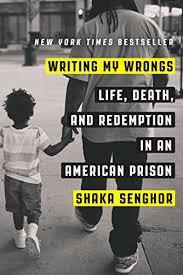 During a recent site visit for our BOOST initiative, the group we observed was reading “Writing My Wrongs” by Shaka Senghor. So I decided to read it, too.
During a recent site visit for our BOOST initiative, the group we observed was reading “Writing My Wrongs” by Shaka Senghor. So I decided to read it, too.
The author, Shaka Senghor, was born on Detroit’s east side, in a middleclass neighborhood, during the height of the 1980’s crack epidemic. Shaka’s life started out on a promising note. He was a straight ‘A’ student and a good all-around kid. Then at age 11 his mother and father separated. He and his two younger sisters lived with their mother, although his father promised he would always be there for him no matter what. Over the next several years, his parents got back together and separated multiple times finally getting divorced. Each time they separated, Shaka’s attitude towards life got worse, until he did not care about anything.
At age 14, Shaka was tired of his circumstances and the beatings from his mother. So he ran away from home and turned to the streets. For the next five years, in order to survive, he started dealing drugs and turned to alcohol and guns. At age 19, he murdered a man and was sent to prison. While in and out of county correctional facilities, he learned that jail was not much different from the streets: Both places were power-based environments where the only means of gaining respect were violence and money.
After being in solitary confinement -- better known as the “hole” -- off and on for seven years, Shaka realized the anger and pain he was feeling was a destructive force that was tearing him apart, and he knew he had to find a way to change. He started reading and putting his thoughts down on paper, and this process of self-examination began to change him. He would read the Bible or other religious books from the prison’s library. For seven years in the “hole,” he tested his will to survive. He also began to truly grow and forgive the people who had hurt him, and prayed for forgiveness from the people he had hurt in so many ways.
After three meetings with the parole board and many disappointments, Shaka was released from prison at the age of 38. For the first couple months at home, he reconnected with his family and got his first ever driver’s license. His surroundings had really changed since going to prison, and it was a lot for him to take in. He volunteered with youth in the community, sold some of the books he had written while in prison, and had numerous speaking engagements at local high schools, mentoring young men and women who were starting down the path he had taken as a young boy. Sharing his story with the community eventually led him to a fellowship at the MIT Media Lab and the Kellogg Foundation.
Shaka writes, “I’m asking you to envision a world where men and women aren’t held hostage to their pasts, where misdeeds and mistakes don’t define you for the rest of your life. In an era of record incarcerations and a culture of violence, we can learn to love those who no longer love themselves. Together, we can begin to right our wrongs.”
Shaka Senghor is a writer, mentor, and motivational speaker whose story of redemption has inspired thousands. It certainly inspired me.
By Kathleen McCarthy
06-16-2017
Announcing our most recent grant recipients in Catholic activities, education, and human services
We are pleased to announce that 14 organizations received over $800,000 in our June 2017 grant cycle.
Catholic Activities
- Church of the Nativity: $67,506 to support the purchase of liturgical elements to enrich the spiritual experience of parishoners and visistors alike at this growing Catholic parish in Lutherville
- Monsignor O’Dwyer Retreat House: $60,000 to support capital improvements to enhance the comfort and prayerful experience for youth and young adults visiting this Sparks-based Catholic retreat facility for the past 50 years
- St. Bernardine Church: $20,000 to support capital improvements to increase safety and access to this Catholic parish in the Edmondson Village neighborhood of Baltimore City
Education
- Camp Puh’tok for Boys and Girls: $75,000 to support the participation of 50 low-income Baltimore City youth in the year-round Urban Youth Scholars Program at this 60 acre outdoor learning center in Northern Baltimore County
- Loyola Blakefield: $60,000 to support 1:1 technology access for students in need at this Jesuit, college preparatory school in Towson serving boys in grades 6 – 12
- Maryvale Preparatory School: $100,000 to support STEM-related technology upgrades at this Catholic, independent school in Lutherville serving girls in grades 6 – 12
- St. Elizabeth School: $58,353 to support capital improvements so that this Catholic, nonpublic, special education school in Baltimore City can serve more elementary-age students
- St. Ignatius Loyola Academy: $55,285 to support the expansion of technology and faculty training at this tuition-free, Jesuit school in Baltimore City for underserved boys in grades 5 – 8
- St. Michael – St. Clement School: $120,000 to support the purchase and integration of technology at this newly merged Catholic school in Baltimore serving students in grades pre-K-8
Human Services
- Franciscan Center: $33,335 as a 2:1 matching grant to support the capacity-building efforts of this Catholic outreach organization in Baltimore City, which has provided a continuum of basic services to the poor for nearly 50 years
- Paul’s Place: $30,000 to support general operating costs associated with the case management program at this anchor community organization, which is dedicated to improving the quality of life in Southwest Baltimore
05-24-2017
A short video celebrating the work of St. Elizabeth School and our relationship with them
In celebration of our 40th anniversary year, the Knott Foundation is releasing three short video stories about our grantees.
This video features St. Elizabeth School, a Catholic school for students with special needs.
By Kelly Medinger
05-05-2017
Fellowship of Catholic University Students (FOCUS) uses Catholic activities grant to help Towson University students find fulfillment through faith and friendship
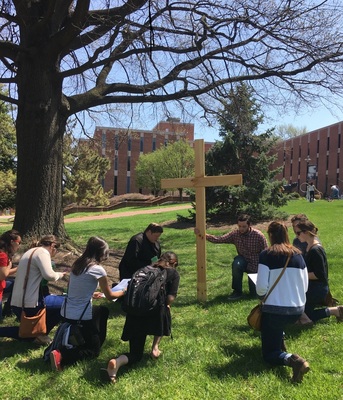 Four out of five people who leave the Catholic Church do so between the ages of 18 and 23. Meanwhile, the American College Health Association routinely reports widespread unhappiness among college students in this age range. So how does the Church find those who are lost and ultimately show them a path to a more fulfilling life?
Four out of five people who leave the Catholic Church do so between the ages of 18 and 23. Meanwhile, the American College Health Association routinely reports widespread unhappiness among college students in this age range. So how does the Church find those who are lost and ultimately show them a path to a more fulfilling life?
Connecting College to Christ
Fellowship of Catholic University Students (FOCUS) is the largest and fastest growing apostolate dedicated to the evangelization of college students. Its purpose is to engage a generation of young adults – those most at risk for disconnecting from their faith – as active participants in the Church through small group bible studies, large group leadership training, one-on-one discipleship, and social gatherings.
Founded in 1998, FOCUS missionaries now serve more than 100 college campuses across the United States, including four in Maryland: Mount St. Mary’s University in Emmitsburg, the University of Maryland in College Park, the US Naval Academy in Annapolis, and most recently, Towson University.
In just two short years at Towson University (and a grant from the Knott Foundation), FOCUS has helped the Catholic community expand from a handful of students involved in planning their own activities, to a group of more than 70 students, missionaries, and student leaders engaged in community outreach, interfaith dialogue, religious practice, and social events. In the words of a vice president in administration at the college: “It’s great that Catholic campus ministry has awoken again.”
A Home Away from Home
“When you go to college, you want to belong somewhere,” says Nan Leahy, Philanthropy Officer. “FOCUS provides that environment for these students and becomes their support system outside of their family.”
Amber Cybulski graduated from college interested in the field of college ministry but unaware of FOCUS. She learned about the organization from a friend, applied to become a missionary, and then took part in an intensive 5-week training program for new staff. Today Amber meets with Towson students one-on-one and helps to lead the Newman Center’s campus ministry activities. Through this discipleship, she has witnessed positive developments in students’ friendships, compassion, willingness to lead, and ability to make good choices.
“So much comes down to good choices,” adds Father Matt Buening, Director of Catholic Campus Ministry at Towson University. “Having the guidance of faith, a community to support them, and good friendships to help them make good choices is so important during college.”
A Time for Conversion
“In a way college is actually the easiest time for conversion,” shares Cybulski, “because you are not yet tied to a spouse, children, job, profession, or way of life, and perhaps for the first time you are charged with making decisions without the influence of your parents.”
Indeed, the culture of FOCUS has proven to be a powerful catalyst for conversion and discernment. Fr. Matt was recently contacted by an unbaptized student interested in exploring the Catholic faith. Simultaneously, FOCUS has inspired two recent Towson graduates to enter the seminary.
“When you fall in love with Christ, it just transforms everything,” says Fr. Matt. “This growth in the human person then translates into effective servant leadership, renewed dedication to the important things in life, a true commitment to helping the community, and a more fulfilling journey through life.”
By Kelly Medinger
05-04-2017
CASA of Allegany County uses human services grant to be a voice for more foster children
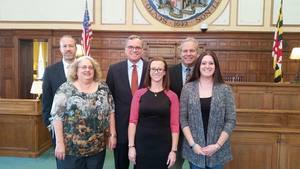 “While the number of children in foster care is declining in Maryland, the number in Allegany County has nearly doubled over the last four years, largely due to the drug epidemic,” says Misty Raines, Executive Director of CASA of Allegany County. Citing one of many examples, Raines shares the story of a young mother in Cumberland who recently died from an overdose, leaving her two young children with no options other than foster care.
“While the number of children in foster care is declining in Maryland, the number in Allegany County has nearly doubled over the last four years, largely due to the drug epidemic,” says Misty Raines, Executive Director of CASA of Allegany County. Citing one of many examples, Raines shares the story of a young mother in Cumberland who recently died from an overdose, leaving her two young children with no options other than foster care.
About CASA
Located in rural western Maryland, Court Appointed Special Advocates (CASA) of Allegany County was founded in 2012 by two local citizens who had seen the results and benefits of CASA programs in nearby towns in West Virginia. The organization hired Raines as Executive Director in 2013, and in 2014 their first CASA was appointed by the court.
CASA of Allegany County has trained approximately 40 CASAs since its founding. These volunteers are currently advocating for approximately 25 foster children, speaking to everyone on the child’s behalf in order to create the best life situation for them – whether that is adoption, kinship care, or other living arrangements.
“People in Allegany County are really starting to recognize our program and see the benefits,” comments Raines. “We actually had to waitlist a number of volunteers at our most recent training, because interest was so high.”
Being There for Kids
The Knott Foundation has awarded CASA of Allegany County two grants since it opened its doors. “When I think of where we were in the very beginning with our first grant – wondering what the next year would look like for all these kids in the foster care system – to where we are today with so many active CASAs, it is a testament to all the great people who have worked so hard to make a difference in our community,” shares Raines.
CASA is a serious volunteer commitment in the life of a child, and volunteers are trained accordingly. CASAs go through a rigorous 5-week training program based on a national curriculum. All are asked to commit to 12 months of service, or the life of the case to which they are assigned. For some volunteers, this can mean several years of service.
Such is the case for CASA Don, who has served his child for three years. Once or twice a month, CASA Don drives more than three hours to visit the child in a special group home setting. They go out for lunch, shop for things the child might need, see a movie, or celebrate birthdays together. CASA Don is his only visitor; the boy’s mother died of cancer, his father was his abuser, and he has no siblings.
CASA Roni Ringler sums it up like this: “Albert Einstein said, ‘Only a life lived for others is worth living.’ Through my decades of adulthood, I have tried to live by this – as a teacher, crisis counselor, friend, and now, a CASA. Becoming a CASA has made me a better person, a more determined person, with the hope my child will be reunited with parents, foster parents, or adoption that will regain a stable and happy home life for them. It is my honor to be a CASA and I am thankful for this.”
By Kelly Medinger
03-07-2017
Celebrating 40 years of a family legacy of generosity to strengthen our community
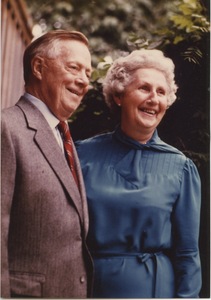 We are pleased to release a short film showcasing the history and mission of the Marion I. & Henry J. Knott Foundation.
We are pleased to release a short film showcasing the history and mission of the Marion I. & Henry J. Knott Foundation.
After four decades of grantmaking in the Archdiocese of Baltimore, we wanted to tell the story of who our founders were, why they created the Foundation, how multiple generations of the Knott family are involved in our work today, and how our founders’ vision and legacy continues to strengthen the community in and around Baltimore.
Click here to watch the 6-minute film, or visit our homepage and click on the photo of Marion and Henry.
We would like to thank all of the people who participated in the making of this film, including our grantees Caroline Center, St. Elizabeth School, and St. Francis Neighborhood Center, as well as Archbishop William Lori, Fr. Robert Leavitt, Peter Angelos, and members of the Knott family.
It is an honor to steward the legacy of Marion and Henry Knott, and to share our story with you.
By Kathleen McCarthy
03-07-2017
A powerful and compelling argument about the perpetuation of a racial caste system in America
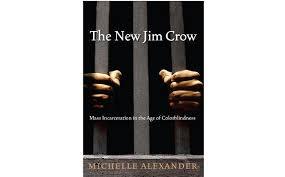 This entry in our “What We’re Reading” series might better be called “What We’re Reeling,” as my recent choice of tomes has triggered a level of cognitive imbalance in this reader’s brain.
This entry in our “What We’re Reading” series might better be called “What We’re Reeling,” as my recent choice of tomes has triggered a level of cognitive imbalance in this reader’s brain.
The New Jim Crow: Mass Incarceration in the Age of Colorblindness by Michelle Alexander, an Associate Professor of Law at Ohio State University and civil rights advocate, received much critical praise when it was released in 2010 and has spent 133 weeks on the New York Times’ Bestseller List.
Using the War on Drugs as a focal point, the book lays out an argument that the election of our first African-American President did not usher in a new era of colorblindness; that we are instead living in a time where racial caste in America has not ended, but merely been redesigned.
The New Jim Crow is not a book that I would normally gravitate toward for a leisurely read. Had I not been invited to participate in an event celebrating Black History Month at the Druid Heights Community Development Corporation in Baltimore, I likely would never have read this book.
The event will be held on March 18, 2017 and is supported by the Maryland Humanities Council. It seeks to gather a diverse intergenerational audience and, using the book as a vehicle to spur conversation, create a platform for learning about racial inequality in our communities. I can see why this book was selected as that vehicle.
In the book, Alexander provides a powerful and compelling argument that the War on Drugs has succeeded as a policy of relegating millions of mainly low-income people of color to the status of a second-class citizen. And this caste system, due to structural policies, is not one a person may transcend. The author argues this new dynamic is actually not new at all; just a repackaged and linguistically-nuanced version of the old Jim Crow laws.
While many would believe that Jim Crow died with the passage of the Civil Rights Act in 1964, Alexander argues that federal drug policy and the drug wars that federal, state and local law agencies have been engaging in since the early 1980s, have given rise to a new Jim Crow. This new Jim Crow, cloaked in the name of law and order, denies those convicted of even the most minor of felonies the right to vote, serve on juries, access housing, receive an education, or qualify for public benefits; all realities that applied to people of color under the old Jim Crow.
While there was much to Alexander’s argument that I was aware of, the depth of the structural foundations and its applications were sobering and humbling to say the least. In my role as Grants Manager, I review hundreds of letters of inquiry each year, with the majority of them from human service organizations – many of them working with the populations this book discusses. I knew the road ahead for these individuals was not easy; however, in reading this book, I realize my own naivety about the difficulty of that road.
Much has been written in defense of (and in opposition to) Alexander’s argument. Regardless of where one comes down, I feel confident in saying that for me, the book emphasized the importance of avoiding binary thinking when it comes to racial inequality and many other issues confronting society today. It also emphasized the importance of humility, grace, and the need for civil discourse if we are to change a system for the better.
By Kelly Medinger
02-28-2017
Announcing our most recent grant recipients in arts & humanities, education, health care, and human services
We are pleased to announce that 16 organizations received over $700,000 in our February 2017 grant cycle.
Arts & Humanities
- Baltimore Center Stage: $50,000 to support this nationally recognized theater company’s accessibility for blind, deaf, and autistic populations
Education
- Baltimore Chesapeake Bay Outward Bound School: $40,000 to support this experiential education organization’s Character & Leadership Initiative at two Catholic girls schools, Sisters Academy and Mercy High School
- Dyslexia Tutoring Program: $50,000 to support the general operations of this program delivering free, specialized tutoring services to low-income children and adults with language-based learning differences
- Mount St. Mary’s University: $40,000 to support equipment acquisition in the Division of Chemistry at this Catholic university in Emmitsburg
- St. Maria Goretti High School: $65,000 to support a 1:1 Chromebook initiative at this Catholic high school in Hagerstown
- St. Mark School: $100,000 to support technology upgrades at this pre-K-8 Catholic school in Catonsville
- St. Stephen School: $60,000 to support the Academic Excellence in Reading Program at this pre-K-8 Catholic school in Kingsville
- The Maryland School for the Blind: $45,073 to support the construction of a new accessible playground for students who are blind or visually impaired
- Trinity School: $82,400 to support technology upgrades at this K-8 Catholic school in Ellicott City
Health Care
- Charm City Clinic: $17,000 to support the general operations of this volunteer-driven health care access organization serving low-income residents in East Baltimore
Human Services
- Adoptions Together: $49,463 to support digital enhancements to the Heart Gallery, a physical display featuring adoptable children in foster care, as part of this organization’s mission to create lifelong connections for children in need
- CHANGE, Inc.: $25,000 to support renovations to their Respite Inn in Carroll County, where individuals with disabilities and their families can receive respite care
- Job Opportunities Task Force: $35,000 to support the general operating costs of Project JumpStart Mentoring, a new program pairing Baltimore City’s opportunty youth with successful graduates of JOTF’s cornerstone pre-apprencticeship workforce development program
- Maryland Farmers Market Association: $30,000 to support Maryland Market Money, a program designed to augment the food budgets of low-income residents while simultaneously supporting the livelihoods of local farmers
- Partners in Care: $45,000 to support the Member Care and Ride Partner Programs, which are designed to maintain and enhance the independence of older adults in Anne Arundel County
- Penn-Mar Human Services: $45,000 to support the Baltimore County operations of the Customized Integrated Employment Program, which places individuals with intellectual and developmental disabilities in community-based employment positions
For a complete listing of our grant awards, please visit our past awards database.
By Kelly Medinger
02-28-2017
Announcing our first round of grant recipients in our Building Opportunities in Out-of-School Time initiative
Our founders believed that education was the key to success, and that hard work combined with access to the right opportunities opened doors for people to become leaders in their communities. Our Building Opportunities in Out-of-School Time (BOOST) initiative is an extension of this donor intent and seeks to build opportunities in out-of-school time hours for older disadvantaged youth in Baltimore.
In short, we believe that kids need committed and caring adults to help them navigate life, and that out-of-school time programs are a great avenue to help build those relationships and help them realize their full potential.
Through our BOOST initiative, we’d like to see organizations demonstrate significant depth, duration, and reach of informal and formal mentoring relationships between older youth and caring adults. With those measures, research says in the long-term these youth will experience improved educational outcomes and labor market success, improved decision-making capabilities, and beneficial effects on a number of other well-being variables – all of which point to our founders’ deep-seated value of education, opportunity, and hard work.
This year we are pleased to announce our first round of BOOST initiative grants, totaling $355,000 to four organizations in Baltimore.
BOOST Awards: Round I
- Medical Education Resources Initiative for Teens (MERIT): $140,000 grant over four years ($35,000/year) to support the capacity-building efforts of this organization, which aims to eliminate health care disparities by transforming underrepresented Baltimore City high school students into health care leaders
- Next One Up: $40,000 grant over two years ($20,000/year) to support the general operations of this organization, which aims to transform the lives of young men in Baltimore City by supporting and advancing their academic, athletic, and social development
- Sisters Circle: $105,000 grant over three years ($35,000/year) to support the general operations of this organization, which offers long-term mentoring relationships for at-risk girls in Baltimore, empowering them to define success for themselves, make intentional decisions about their futures, and become self-sufficient young women
- Thread: $70,000 grant over two years ($35,000/year) to support salary expenses of this organization, which engages underperforming high school students in Baltimore City, provides them with a family of committed volunteer mentors, and encourages them to become self-motivated, resilient, and responsible citizens
BOOST is a 5-year, $1 million initiative. Participation is by invitation only. We look forward to sharing what we learn from this initiative over time.
For a complete description of the program, please visit our BOOST initiative webpage. And to read more about the Foundation’s journey to develop the BOOST initiative, click here.
By Kelly Medinger
02-23-2017
Weaving a network of life, hope, and charity
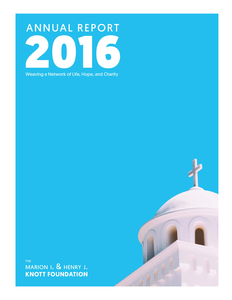
I am pleased to announce the publication of our 2016 annual report.
“Weaving a Network of Life, Hope, and Charity” is the theme of our 2016 annual report. Through this theme we remark how organizations across the Archdiocese of Baltimore are weaving the threads of life, hope, and charity to create a more vibrant social fabric in the communities we serve.
Our annual reports are a wonderful archival resource of the Foundation’s grantmaking activities, as well as a way to learn about the positive impact of some of our recent grants in education, human services, health care, arts & humanities, and Catholic activities. For a collection of our past annual reports click here.
I hope you enjoy reading our 2016 annual report and learning more about the Knott Foundation’s mission to strengthen the community.
By Kelly Medinger
02-13-2017
St. Vincent de Paul of Baltimore uses human services grant to upgrade information technology across 13 program sites serving the poor
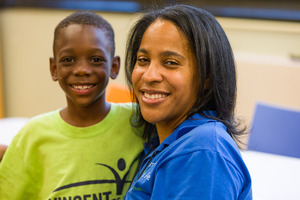 As one of the region’s larger human service organizations, St. Vincent de Paul of Baltimore provides a path from poverty to self-sufficiency for many residents of Baltimore. A continuous focus on program quality recently led the organization to investigate ways to use information technology to enhance the services delivered to those in need.
As one of the region’s larger human service organizations, St. Vincent de Paul of Baltimore provides a path from poverty to self-sufficiency for many residents of Baltimore. A continuous focus on program quality recently led the organization to investigate ways to use information technology to enhance the services delivered to those in need.
About St. Vincent de Paul
St. Vincent de Paul of Baltimore’s mission is to ensure those impacted by poverty have the skills and resources to achieve their full potential. More than 150 years after its founding at the Basilica of the Assumption in Baltimore, St. Vincent de Paul’s programs remain inspired by its Catholic roots. Today, in the tradition of its founder, Frederic Ozanam, the organization continues to help people move beyond hunger, homelessness, unemployment, and childhood poverty.
With 13 programs – including a homeless resource center, Head Start, housing services, family homeless shelters, and employment training – St. Vincent de Paul reaches thousands of men, women, children, and families each year, moving them beyond poverty to achieve a better future. These numbers represent significant growth over the past decade: In that time, St. Vincent de Paul has doubled its number of employees and added multiple new site locations and programs.
Such exponential growth creates challenges and opportunities. “We recognized that in order to be a better, higher functioning, more informed organization, we needed to put some time and resources into information technology,” states Matthew Kurlanski, Director of Foundation Relations & Grants and a member of the Information Technology Architecture Steering Committee.
Technology as a Tool
The Knott Foundation awarded St. Vincent de Paul a grant in 2015 for the first phase of its technology upgrade. “Very few funders will support the back-office infrastructure that enables the front-line case managers and program staff to do their jobs better,” remarks Kurlanski. “If we hadn’t received the Knott grant as a first investment, we wouldn’t have gotten the momentum we needed to get the project off the ground.”
Grant funds were spent on upgrades to the network infrastructure at 13 program sites, on a virtual Chief Information Officer, and on a network backup solution. The changes, however small, have begun to increase cross collaboration between programs and have made St. Vincent de Paul’s operations more streamlined and cost effective. For example, during a Baltimore City audit last year, documentation about programs was collected electronically utilizing the Office 365 cloud functions from multiple sites. This lessened the burden on front-line staff to sort and organize large volumes of paper and helped auditors to quickly and thoroughly review the organization’s program performance.
Future efforts include transitioning from using four different data management systems to track progress across all programs, to a single tracking and evaluation system. “Our goal is to use information technology to lay the foundation for becoming a more collaborative, more unified, more outcomes-focused organization,” concludes Kurlanski.
By Kathleen McCarthy
10-14-2016
Announcing our most recent grant recipients in Catholic activities, education and human services.
We are pleased to announce that 14 organizations received nearly $650,000 in our October grant cycle.
Catholic Activities
- Jesuit Volunteer Corps: East: $15,000 grant to support the recruitment, training and on-going work of five Baltimore-based Jesuit Volunteers committed to serving the poor and marginalized
Education
- Monsignor Slade Catholic School: $59,000 grant to support the implementatoin of a mobile device program and teacher professional development at this pre-K – 8 Catholic school in Glen Burnie
- St. Francis of Assisi School: $65,420 grant to support the implementaion of a technology Master Plan at this pre-K – 8 Catholic school in Northeast Baltimore
Human Services
- Associated Catholic Charities: $65,000 grant to support the St. Edward’s Workforce Development Center, an automotive job training program located in West Baltimore
- Family and Children's Services of Central Maryland: $40,000 grant to support the launch of a centralized intake system called Access FCS, creating a single point of entry and lowering barriers for individuals and families seeking behavioral health services
- Intersection of Change: $35,000 grant to support Martha’s Place, a recovery program for women overcoming drug addicition and homelessness in West Baltimore
- Living Classrooms Foundation: $48,457 grant to support general operating costs of Project SERVE, a community service and job-training program for unemployed and disadvantaged adults
- Pathfinders for Autism: $39,880 grant to support and expand the Community Safety Program, training law enforcement, fire, and EMS first responders across Central Maryland to more effectively interact with individuals on the autism spectrum
- St. Mary's Outreach Center: $35,000 grant to support operating costs for the Center, which improves the quality of life for older adults living in poverty in the greater Hampden community
By Kelly Medinger
09-30-2016
A look at what happens behind the scenes with grant applications
 This is the second post in a multi-part series that explores a year in the life of the Knott Foundation behind the scenes
This is the second post in a multi-part series that explores a year in the life of the Knott Foundation behind the scenes
Do you ever wonder what happens to your grant application after you click “submit”? Or who reads your final report once your grant is over? If so, this blog post is for you!
As part of our “behind the scenes” blog series, we’re taking a look at the inner workings of the Knott Foundation from strategic planning to grantmaking. This is the second post in the three-part series:
- Part I (read it here) recapped our strategic journey over the past three years to share our donor intent and legacy, explore our own talents and resources, and create a common education base around community needs and conditions.
- Part II (this post) examines what happens behind the scenes with grant applications – from the time a letter of inquiry comes in the door to when a final grant report is submitted.
- Part III will feature a Q&A with trustees about the family’s participation in our grantmaking process, including reflections on their giving philosophies and experiences as site visitors.
Letters of Inquiry
Our grantmaking process starts with registration in our online Grants Portal and submission of a letter of inquiry.
Nearing the deadline, our Grants Manager, Kathleen, starts processing all of the letters that are submitted. Your letter merges into a template, with key information at the top (organization name and address, request amount, project title, etc.) and the body of your letter below. We also include a chart of your funding history and attach your one-page Financial Analysis Form.
All of the letters and financial forms are organized by program area and sent to a committee of our board who review the letters three times a year. The committee spends a couple weeks looking through the information and then meets to discuss the submissions.
Each cycle we receive approximately 60 letters of inquiry. In the end we only invite 1 in 4 applicants to submit a full proposal – more a factor of our own limited resources than anything else. Notably, while education is our largest program area in terms of funding, about half of the letters we receive each year are in the human services program area.
By the end of the month we notify every applicant via email whether your letter of inquiry was advanced or not. Sometimes applicants will call (understandably) to find out why their letter was not advanced. While we’re always happy to take a call or respond to an email, it’s rare that we have any specific feedback for applicants (other than we simply didn’t have enough resources to bring them in).
Full Proposals
The full proposal process starts with a phone call and a conversation with Kathleen. She walks you through the application guidelines and what to expect, and emails you a link to the full proposal template in our Grants Portal.
One unique feature of this stage in our process is the opportunity to have Kathleen review a draft of your proposal. A good number of our applicants take advantage of this opportunity each cycle, and Kathleen shares her feedback through the Grants Portal. We see this as a great opportunity for knowledge-sharing: we learn from the information contained in your proposal, and we’re also able to ask questions or share ideas that we’ve gleaned from others who have done similar projects in the past.
Once you submit your full proposal and all of the required attachments, your proposal is merged into a template (similar to the letter of inquiry). A list of all of the applicants is sent to a committee of our board who votes on grants, and each committee member selects which organization(s) they want to explore.
About a month or so after submitting your full proposal, a trustee or staff member will usually contact you to schedule a site visit. That person will have all of the information you submitted with your grant application, as well as a copy of your post grant report from your most recent grant (if applicable).
Once the site visits are complete, the committee meets to discuss and vote on each proposal. While the letter of inquiry process is highly competitive (with only 1 in 4 applications advanced), by the full proposal stage the odds are much better: about 80% of our applicants receive at least a portion of what they asked for.
After this meeting, we call you to relay the news about your proposal, regardless of the outcome.
Interim Reports
A few years ago my colleague, Kathleen, spearheaded a new modality for interim reporting: phone conversations! For years we used to require our grantees submit a written report at the 6-month mark of their grant; however, Kathleen knew from her experience as our Grants Manager that the information exchange could be (and would be) better over the phone.
For this step, Kathleen contacts you to schedule the phone conversation. Each conversation typically lasts about 30 minutes. Some organizations delegate the call to their development person, while others pull in one or more program people to discuss the details of the grant-funded project. Either way the conversation is fruitful; both parties can ask questions, link to other resources, problem-solve, or even brainstorm new ideas.
Throughout these phone conversations, Kathleen takes notes. She shares her notes with me and the trustee who conducted the original site visit for the grant. Over time, these interim phone conversations have become an integral part of our knowledge gathering and knowledge sharing in the field.
Post Grant Reports
At the end of each grant, a post grant report is due. Unlike the interim report, this is a written report prepared by the grantee that recaps the challenges and successes encountered during the grant period. Kathleen reviews all of the reports and prepares a brief summary of each. I review both the summaries and the reports, and if there are no issues, we officially “close” the grant in our system.
Like our notes from the interim report conversations, your post grant report is shared with the trustee who conducted the original site visit. But your report ALSO becomes part of your next grant application, as we seek to incorporate an assessment of your previous stewardship into any new request for funding.
So what?
So that’s it – our grant process from soup to nuts! I hope this post has given you a window into what happens “behind the scenes” once your letter of inquiry, full proposal, and grant reports are submitted. If you have any input on our process from your standpoint – timing, requirements, feedback, etc. – please feel free to share it with us at knott@knottfoundation.org.
By Kelly Medinger
09-23-2016
Exploring the challenges (and opportunities) facing our young people
My colleague (and voracious reader/information gatherer) Kathleen McCarthy often sends me interesting articles from the field. In this post I’d like to highlight two such articles from The Atlantic that I found to be of particular value, and that greatly impacted my understanding of how we can help our young people grow up to be productive, happy adults.
The first article is “The Activity Gap” by Alia Wong. We read it last summer while conducting research into out-of-school time programs for our BOOST initiative. The article examines the growing divide between the “haves” and “have-nots” in terms of how youth spend their time in the afterschool hours.
Wong begins by painting a picture of Ethan and Nicole – two young people living in Austin – whose lives take dramatically different trajectories because of the world they grew up in.
Their stories are real and link to the findings of a national study published by Brown University’s Annenberg Institute for School Reform, which shows extracurricular participation is becoming an upper class privilege. It seems more and more afterschool activities these days require parents to have “flexible work schedules, comfortable financial situations, and commitment to their children’s social and intellectual development.” Sadly, this means more and more poor kids are being left on the sidelines.
Wong acknowledges that some might question paying so much attention to afterschool hours, given the problems that face schools themselves. Yet the data tells a convincing story for why afterschool matters. Kids spend more time out of school than they do in school; in fact, 80% of a young person’s life is spent outside of the school day and academic year (Child Trends, 2012). It follows that out-of-school hours are ripe for reaching kids and exposing them to new opportunities, sustaining or strengthening their academic skills, and fostering important relationships and social skills integral to their success in life.
In the second article, “Why Do Some Poor Kids Thrive?” by Alana Semuels, the data and stories hit much closer to home, with the research coming directly out of Baltimore.
Relating the journey from adolescence into adulthood, the article highlights research from the book Coming of Age in the Other America (DeLuca, Clampet-Lundquist, and Edin, 2016). The crux of the story is this: even kids who exhibit a lot of potential and are excelling academically often veer off-track if their environment pushes them to “simply survive” in the short-term. It turns out good grades and the drive to succeed aren’t enough; without a supportive environment (including relationships and living conditions), a teenager or young adult will almost always make decisions for short-term wins rather than long-term gain.
The researchers suggest numerous ways to help these kids, among them: improving neighborhoods so kids don’t rush out on their own just to escape; expanding opportunities in afterschool hours to fuel kids’ passions that help inspire them in tough times; and counseling kids about how seemingly short-term decisions will affect them in the long-run.
For me, these two articles connect in a real and meaningful way. On their face they both point to disadvantages that poor kids face in life that others don’t. But beneath the surface they shed light on the question, How can we help instill the skills, values, and information disadvantaged kids need for upward mobility in life? The answer is complex and multi-faceted. Environment is certainly a big part of the equation. As is how these kids spend their time outside of school, and the relationships they develop with caring adults to help them navigate important life decisions.
These two articles illuminated some important points about the challenges (and opportunities) facing our young people today. I hope you find them as insightful as I did.
By Kelly Medinger
09-12-2016
University of Maryland St. Joseph Medical Center uses health care grant to renovate and expand Mother Baby Unit
 Special deliveries arrive each day at University of Maryland St. Joseph Medical Center: more than 2,200 babies are born at the Catholic hospital in Towson every year.
Special deliveries arrive each day at University of Maryland St. Joseph Medical Center: more than 2,200 babies are born at the Catholic hospital in Towson every year.
St. Joe’s recently completed a campaign to renovate and expand its Mother Baby Unit, where the arrival of new life is celebrated in fine fashion. “Each birth is a sacred event,” describes Judy Rossiter, MD, Chief of Obstetrics and Gynecology and Director of the Perinatal Center. “The mother is an integral part of the team and decisions are made with her input. We do what is best for the baby and the mother, in body and spirit.”
About the Hospital
For more than 150 years, University of Maryland St. Joseph Medical Center has provided loving service and compassionate care to the greater Baltimore community. Notably, the 238-bed hospital in Towson is the only Catholic hospital in Baltimore County providing obstetric services.
“That is what sets us apart – our commitment to our faith-based mission,” states Jill Huey, Executive Director of the UM St. Joseph Medical Center Foundation. Daily prayers are said over the intercom. Brahms Lullaby plays every time a baby is born. A memorial service is held for all babies who are lost each year. “Our faith sets the tone for everything that happens in this institution,” Huey recounts.
In 2012, the hospital became part of the University of Maryland Medical System (UMMS). Because UMMS is a privatized system, St. Joe’s was able to remain a Catholic hospital operating under the ethical and religious directives of the Church. “After nearly four years in UMMS, we have returned to profitability, have received numerous awards for excellence and, most importantly, our patients have come back, drawn by the loving care they experience,” comments Senator Francis X. Kelly, Jr., Chairman of the medical center’s Operating Board.
Raising Standards… and Money
That loving care is especially evident in the Mother Baby Unit. Yet the physical space has not always matched the superior level of service that families receive. Until recently, parts of the unit had remained untouched since the hospital was built in 1965.
In 2015, St. Joe’s embarked on a capital campaign, Building For Our Future, to address the facility’s needs. The total cost to renovate the Mother Baby Unit was $2 million, and all $2 million was raised from public and private support – in just one year. The Knott Foundation awarded the largest foundation grant to the campaign, funding the design schematics for the renovated space.
When finished in 2017, there will be a new welcome area with better signage, improved triage space, renovated postpartum rooms, and a bereavement room for families who experience a loss. With these enhancements, the hospital will be able to provide enhanced care for families, including a faster and more private experience for expectant mothers when they arrive at St. Joe’s to give birth.
In the meantime, more special deliveries arrive each and every day as St. Joe’s joins new moms and dads in celebrating the birth of their children.
By Kelly Medinger
08-30-2016
Dyslexia Tutoring Program uses education grant to help low-income children learn to read
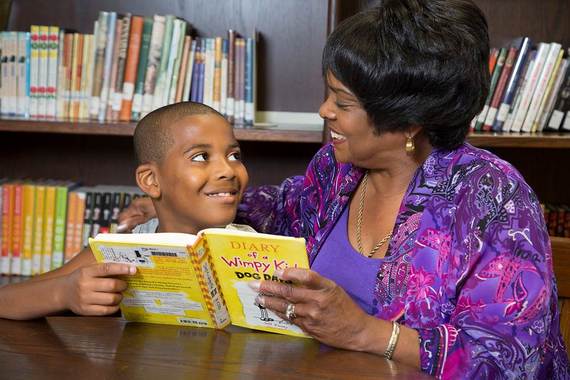 “One of the things we always say is, ‘If you can’t read, you can’t do anything,’” states Marcy K. Kolodny, CEO of the Dyslexia Tutoring Program. “Many times children come to us in the third grade and have already started to lose their self-esteem simply because they can’t read.”
“One of the things we always say is, ‘If you can’t read, you can’t do anything,’” states Marcy K. Kolodny, CEO of the Dyslexia Tutoring Program. “Many times children come to us in the third grade and have already started to lose their self-esteem simply because they can’t read.”
An estimated 15-20% of the population is dyslexic or has a language-based learning disability (International Dyslexia Association). Couple that statistic with the fact that only half of all third graders in Baltimore can read at grade level, and the need to intervene becomes clear.
About DTP
Dyslexia Tutoring Program (DTP) was founded in 1982 by a group of concerned citizens who sought to demonstrate that with a small investment of time and energy, the chain of dyslexia could be broken.
DTP works with approximately 200 children and adults in Baltimore and surrounding counties who are dyslexic or have a language-based learning disability and can’t afford private tutoring. DTP’s volunteer tutors are trained in the 22-hour Orton-Gillingham method of teaching reading, writing, and spelling. They come from a variety of backgrounds including lawyers, teachers, stay-at-home moms, retired men and women, and business people. And they all want to give something back to their communities.
“As far as we know, we’re one of the only organizations in the country to provide these services free of charge,” Kolodny says. Private tutoring can cost between $70 and $100 an hour, far out of reach for students and their families.
Providing Opportunity and Hope
“A lot of our students are very bright. It’s just that they can’t read,” Bob Morton, Program Director, says. To learn to read, a student meets with his or her DTP tutor for one hour at least once a week. DTP then re-screens the student after every 30 hours of tutoring to measure improvement in areas such as word identification, word attack, spelling, fluency, and comprehension.
While assessments and scores can show a student’s improvement throughout the school year, the greater impact comes later and is perhaps more difficult to measure: “By increasing a student’s reading ability, research says you increase his or her self-esteem, develop character, and create skills needed for future success in high school, college, vocational school, the workplace, and other life endeavors,” says Kolodny.
Ten of DTP’s students are now in college, and three just graduated. Of the five DTP students who finished high school this year, all of them plan to attend college.
One of the program’s students, Tavon, called one day to ask if Kolodny could help him get a part-time job. The Marriott Waterfront Hotel offered him a job as a busboy. He then became a waiter and was accepted into their management training program, where he soon became a Captain, and last summer was promoted to Assistant Manager of the Catering and Events Department. “If it were not for DTP,” he says, “this would never have happened.”
By Kathleen McCarthy
07-19-2016
A lesson in how to relate “thinking” technology to “feelings” and our broader organizational culture
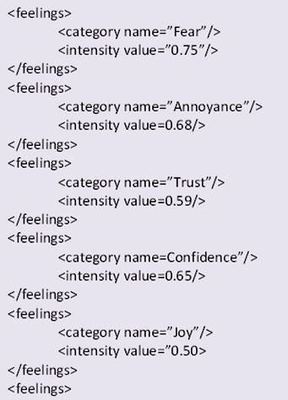 Maya Angelou famously said, “I've learned that people will forget what you said, people will forget what you did, but people will never forget how you made them feel.” I have given a lot of thought to this quote over the past year, especially as the Knott Foundation has transitioned to a new grants management system.
Maya Angelou famously said, “I've learned that people will forget what you said, people will forget what you did, but people will never forget how you made them feel.” I have given a lot of thought to this quote over the past year, especially as the Knott Foundation has transitioned to a new grants management system.
The transition to a new system began with a deep dive into to the ever-expanding world of software options. To see the multitude of bells and whistles available to manage, measure, and message our data was both overwhelming and exhilarating. And, like buying a new car, I could see how it would be very easy to walk away with a Ferrari when you only needed a Ford.
Our approach when identifying a system was largely threefold: to find a system that would improve operational efficiencies internally, enhance the grant applicant experience externally, and enable us to understand, aggregate, and share the data and stories we are collecting.
After months of planning and long hours of building out our new Fluxx platform, with tremendous excitement we went live with the system in April of this year. While largely a smooth ride, as is customary with any database transition, we have hit a few bumps in the road.
And this is where Maya Angelou comes into play. As it turns out, database transitions concern themselves with more than just data. At their heart they are all about people and how they feel.
For our staff, it was important that that the new system be flexible and powerful without being intimidating. To ensure that we achieved this in the final build, feelings became a big part of the conversation. Learning curves are inevitable, but what’s invaluable in getting the best possible product is understanding how the database ultimately makes the staff responsible for interacting with it feel. Communicating with Fluxx how certain processes and design elements were leaving individuals confused and uncertain helped us get to a place where change management (rather than crisis management) could take place.
For our applicants, it was important that the new system provide a high level of real time access and control. We believe, and have heard from many applicants, that the new online system does this. While the empowering elements are a valued improvement, we remain committed to our welcoming culture in the face of our new technology. Realizing that grant writing is a hard job and navigating the proclivities of foundations can be even harder, we never want to promote technological empowerment over human understanding. If we neglected to address how our new grants system made our applicants feel, we would not only be making their jobs harder, we wouldn’t be true to our own organizational culture.
Listening, acknowledging and responding to feelings throughout our database transition process has not always been easy. We believe in the end, however, that in doing so we have created a strong platform to achieve our long-term goal of understanding, aggregating, and sharing the data and stories we are collecting. While this goal will take a bit longer to achieve, we are energized by the thought that our grants management system transition could have a transformative impact on how we work to strengthen communities and foster relationships.
As the Grants Manager, my job has been to shepherd the Foundation and our applicants through the transition to the Fluxx system. There have been times when my flock strayed; however, I found that when I took a step back and thought to myself, how would this change element make me feel if my role were something different? I found that I was able to get the flock back in the stall.
There are so many amazing grants management systems on the market today. There are also a lot of great resources, such as Idealware’s A Consumers Guide to Grants Management Systems, to help you get started in your journey. Regardless of the route you take in selecting your Ferrari or your Ford, and regardless of the choice you ultimately make, we’ve found that feelings are the fuel that will keep both on the road and running smoothly. They may be hard to hear and challenging to translate, but if you take the time…and a breath…people will never forget how you and your grants management system made them feel. (And your database will thank you for it.)
By Carol Hoffman
07-13-2016
A moving portrait of our founders published by the Knott Scholarship Funds
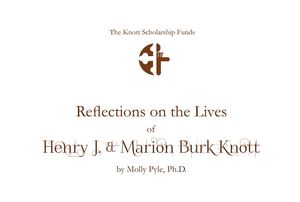 I recently read Reflections on the Lives of Henry J. & Marion Burk Knott by Molly Pyle, Ph.D. – a moving portrait of our founders published by the Marion Burk Knott and Marion I. & Henry J. Knott Scholarship Funds.
I recently read Reflections on the Lives of Henry J. & Marion Burk Knott by Molly Pyle, Ph.D. – a moving portrait of our founders published by the Marion Burk Knott and Marion I. & Henry J. Knott Scholarship Funds.
While the Knott Foundation and Knott Scholarship Funds are two separate entities, our roots are mutually tied to the incredible philanthropy of Marion and Henry Knott, who in many respects were two of the most generous people in Baltimore in their day.
Reflections is a historical composition that paints a portrait of two very different people who, through their ups and downs, ended up sharing the same unwavering love for their family, the same commitment to Catholic education, and the same understanding of the Baltimore community.
Marion and Henry each came from very humble beginnings. They met on a blind date in 1926 and two years later, during the time of the Great Depression, were married. In those early days, they struggled to make ends meet and raise a family of 13 children.
Growing up, Henry and his father did not agree on many things. Yet Henry learned from his father to be hardworking and stubborn, just like he was. After two years of college at Loyola, Henry dropped out and educated himself by reading texts and authors that were of interest to him; he was an avid reader and collector of the Loeb editions of the Greek classics. Henry believed, and in turn taught his children, that we are simply stewards of the money we earn on Earth, and with that money, we have an obligation to give back to our community.
Marion’s mother died when she was four years’ old, and so she went to live with an aunt in Baltimore. When Marion was growing up, she lacked a caring and consistent role model in many respects of her life. Yet she taught herself how to be a good mother to her 13 children, how to be a quiet strength within the family, and how to run a busy household. She was a strong, independent person, and she showed her daughters how to be the same. Marion encouraged all her children to do what was best for them, and to be their own person.
By virtue of their life experience, Marion and Henry were self-made people. He was hard charging, an informally but well-educated businessperson. And she was a compassionate, resilient and patient woman. This combination of personalities led them to great success in business, in family, in philanthropy, and in life in general.
Marion and Henry both believed that you could give just as much of yourself to help others as you could with a monetary gift. They instilled this commitment to volunteerism in their children, who in turn have encouraged the same in their children. Mr. Knott, his children, his grandchildren, and his great grandchildren have served on many boards and given their time and treasure to many charitable organizations throughout the Baltimore area.
In 1981 Marion and Henry established the Marion Burk Knott Scholarship Fund, and in 1988 they started the Marion I. & Henry J. Knott Scholarship Fund. Through these merit based scholarship programs, their dream was to help Catholic students continue to pursue a Catholic education, develop outstanding moral character, and become future leaders in the community. Since their inception, as many as 1700 scholarships have been awarded to over 1500 students.
I very much enjoyed reading Reflections, and I hope you do as well. On behalf of the Foundation, I would also like to extend our thanks to author Molly Pyle, Ph.D. for researching and writing the portrait, and to the Knott Scholarship Funds for publishing it.
By Kathleen McCarthy
06-30-2016
Announcing our most recent grant recipients in arts & humanities, education and human services.
We are pleased to announce that 10 organizations received over $650,000 in our June 2016 grant cycle.
Arts & Humanities
- Port Discovery Children’s Museum: $31,203 grant to support the delivery of the STEMventures after school program to children in grades 3 – 6 attending the four Catholic community schools in Baltimore City
Education
- Archdiocese of Baltimore: $50,000 grant to support the Smart Classroom initiative designed to enhance 21st Century technology opportunities in the four Catholic community schools in Baltimore City
- Institute of Notre Dame: $143,000 grant to support technology and security upgrades at this all-girls Catholic high school in Baltimore City
- Our Lady of Hope/St. Luke School: $61,590 grant to support Chromebooks for the middle school and associated infrastructure upgrades at this pre-K – 8 Catholic school in Dundalk
- Saint Ursula School: $89,000 grant to support a Chromebook initiative at this pre-K – 8 Catholic school in Baltimore County
- Sisters Academy of Baltimore: $50,000 grant to support development operations at this all-girls, tuition-free Catholic middle school in southwest Baltimore
Human Services
- Catholic Charities: $72,123 grant to support a technology upgrade designed to improve employee mobility, system access and security, and quality of care at the largest private human services provider in Maryland
- Helping Up Mission: $40,000 grant to support general operating costs associated with the Education and Workforce Development program at this 130-year-old organization serving homeless, poor, and addicted men in Baltimore City
- Itineris: $100,000 grant to support the acquisition of additional building space to expand the availability of services for adults with Autism Spectrum Disorder (ASD) in Baltimore City
For a complete listing of our grant awards from previous cycles, please visit our past awards database.
By Kelly Medinger
04-13-2016
Art with a Heart uses arts and humanities grant to prepare formerly homeless youth for the workplace
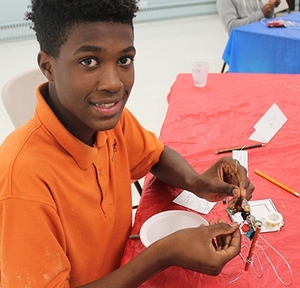 Fifteen new employees – all formerly homeless youth – are seated in an art studio for their new job orientation. “This is not just about making art. It’s about job readiness,” says the orientation director. She explains that they will be learning many different artistic techniques throughout their employment, but if they are late for work by only ten minutes, they will not get paid that day. “Punctuality is important on the job, and docking your pay may seem harsh, but at least you keep your job.”
Fifteen new employees – all formerly homeless youth – are seated in an art studio for their new job orientation. “This is not just about making art. It’s about job readiness,” says the orientation director. She explains that they will be learning many different artistic techniques throughout their employment, but if they are late for work by only ten minutes, they will not get paid that day. “Punctuality is important on the job, and docking your pay may seem harsh, but at least you keep your job.”
About Art with a Heart
Founded in 2000, Art with a Heart provides classes in visual arts to underserved Baltimore area children, youth, and adults. Their mission is to enhance the lives of people in need through visual art.
Part of Art with a Heart’s programming includes the Youth Entrepreneurship Program, which employs cohorts of youth in the spring, summer, and fall to create marketable art to sell in Art with a Heart’s retail store, HeARTwares. Youth complete a variety of art projects, such as designing table and chair sets in teams and learning other artmaking skills like wire and beading, wood burning, ceramics, and mosaics.
Teaching Soft Job Skills
In 2015, the Knott Foundation supported the Youth Entrepreneurship Program’s expansion from summer to year-round programming. This has not only grown the number of youth participating, it has also helped 83% of older youth working in the spring and fall cohorts to secure part-time or full-time employment after completion of the program.
Moreover, by partnering with Youth Empowered Society, a drop-in center for youth age 14-25 experiencing homelessness, Art with a Heart is able to engage at-risk teens and young adults in the HeARTwares space for a real job experience. The youth make marketable art for the store and help run the retail operations.
“Often this may be their first work experience,” mentions Christina Ralls, Director of Workforce Development and Social Enterprise for Art with a Heart, “so we’re all about teaching soft job skills they will need now and in the future.”
Overcoming Barriers to Success
“Art with a Heart is one of the most effective workforce development programs for youth in Baltimore City,” proclaims Maia Gibbons, Workforce Development and Education Coordinator for Youth Empowered Society.
“Many programs focus on hard skills such as learning a trade or teaching how to format a resume, but fall short on the soft skills development that our youth need – social skills, time management, conflict resolution, and communication skills,” explains Gibbons. By employing compassionate and committed educators to lead and mentor the youth, Art with a Heart creates a consistent connection with them and helps instill habits that translate into other areas of life.
“The artmaking is therapeutic for our youth,” Ralls says. “All of them are hard workers. All of them want to work. But there are obstacles for them to even get to work. Art can help them process traumatic experiences and overcome those obstacles to become productive employees and leaders in their communities.”
By Kelly Medinger
04-11-2016
Sisters of Notre Dame de Namur use Catholic activities grant to care for aging Sisters
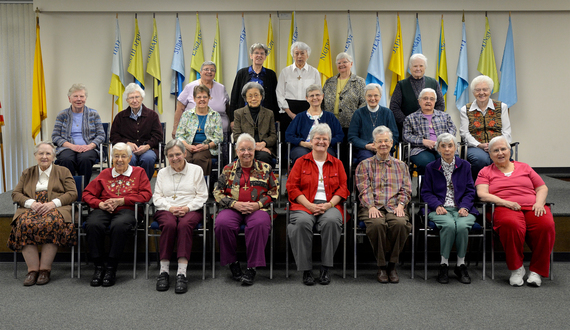 “It is a gift to be a part of an international order. You can’t be on the side of the poor only in your head. To have their firsthand experience is just such a gift and very moving,” reflects Sr. Carol Lichtenberg, SNDdeN, Provincial of the Ohio Province for the Sisters of Notre Dame de Namur.
“It is a gift to be a part of an international order. You can’t be on the side of the poor only in your head. To have their firsthand experience is just such a gift and very moving,” reflects Sr. Carol Lichtenberg, SNDdeN, Provincial of the Ohio Province for the Sisters of Notre Dame de Namur.
About the Sisters of Notre Dame de Namur
More than 175 years ago, eight Sisters of Notre Dame de Namur came to the United States from Belgium to help teach immigrant children. They brought with them their dedication to making known God’s goodness, especially among the poorest and most abandoned.
Since then, the Sisters have served the poor on five continents – in classrooms, in halfway houses, in inner-city community centers, and in rural village communities. The Sisters have taught in hundreds of schools across the United States. They arrived in the Archdiocese of Baltimore in 1934 and have staffed 15 different schools, reaching thousands of students from kindergarten to college.
“One of the things we often say is, ‘Where any Sister of Notre Dame is, each of us is,’” explains Sr. Carol. “So you feel like you are able to be helping in that place in the Congo, or in the new school in the Nigerian province, no matter where you are ministering.”
Caring for Others… and for One Another
The Sisters of Notre Dame de Namur receive no support from any diocese where the Sisters live and serve. This means they are entirely responsible for their mission and ministries, which includes caring for the frailest Sisters.
Last year, the Knott Foundation awarded a grant of $100,000 to support the retirement needs of the approximately 30 elderly Sisters residing at the Villa Julie Residence in Stevenson, Maryland where the median age is 85. The residence was purchased by the Order in 1947 as a place to care for Sisters who were sick and is now used as a facility for retired Sisters before they require skilled care.
With a portion of the grant funds, the Sisters purchased reclining chairs with electric lifts for each room at Villa Julie. The chairs are designed to help with mobility, comfort, and overall health. When asked about the new chairs, one sister smiled widely and proclaimed, “They’re great! I sleep in mine too much!”
For women who have dedicated their lives to serving others, it is only fitting that they receive the same love and attention in their own times of need.
Sustained and Persevering Efforts
“Our foundress St. Julie Billiart’s most characteristic virtues were simplicity, obedience, charity, and confidence,” states Sr. Carol. St. Julie was a strong woman and followed God’s call to serve others with conviction, saying: “God asks of us not promises, but efforts – sustained and preserving efforts.”
Today the Sisters continue to embody the virtues of their foundress and live out the charge of the Sisters of Notre Dame de Namur in their work as teachers, as ministers to the poor, and as prayerful ambassadors. They remain humble servants of the Lord who accept “the grace of the charge” with incredible passion and joy, from beginning to end.
By Kelly Medinger
03-07-2016
Recapping our strategic journey over the past three years
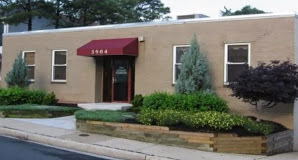 This is the first post in a multi-part series that explores a year in the life of the Knott Foundation behind the scenes
This is the first post in a multi-part series that explores a year in the life of the Knott Foundation behind the scenes
Transparency, in a nutshell, is about openness and accountability. To operate transparently, I believe our foundation must provide the broader community with relevant and timely information about our work, our operations and processes, and what we’re learning. A valuable byproduct of this sharing is that it opens the floor for discussion and participation from our stakeholders, promoting our own accountability to the community.
Having been in the grantseeker role myself, I understand that people might be curious about what’s happening “behind the scenes” in our office (or any private foundation for that matter). While there’s a lot of information on our website, and we’re always happy to talk over the phone, there may still be some big, unanswered questions. For example: When and how do we reflect on our work? What strategic thinking have we been doing over the past few years? How is the Knott family involved in our grantmaking process, and how do their professional and personal experiences help inform their work? And what exactly happens to that letter of inquiry, grant proposal, or post grant report that you write once it’s submitted?
To help answer these questions, I’m launching a blog series to explore a year in the life of the Knott Foundation behind the scenes. Here’s an outline of what you can expect to learn from these blog posts:
- Part I (this post) recaps our strategic journey over the past three years to share our donor intent and legacy, explore our own talents and resources, and create a common education base around community needs and conditions.
- Part II will examine what happens behind the scenes with grant applications – from the time a letter of inquiry comes in the door to when a final grant report is submitted.
- Part III will feature a Q&A with trustees about the family’s participation in our grantmaking process, including reflections on their giving philosophies and experiences as site visitors.
To begin, we’ve spent the last three years reflecting on three important components of our work: our donor intent and legacy, our foundation talents and resources, and our community needs and conditions. All of these components play a role in guiding our strategic direction as a Catholic family foundation in the Archdiocese of Baltimore.
Our Donor Intent and Legacy
One way of positioning donor intent is through three basic, formative questions I believe all foundations must answer about their giving: why, what, and how. Donor intent is the why. It illustrates the values that motivated our founders to give back in the ways that they did.
In the words of business writers Jim Collins and Jerry Porras, “It is more important to know who you are than where you are going, for where you are going will change as the world around you changes” (Building Your Company’s Vision, Harvard Business Review, 1996). For a family foundation like ours, donor intent is that identity, that stable force in an ever-changing world, which Collins and Porras allude to.
In 2014, after researching our donor intent and discussing it at a foundation retreat, we decided to share more about the legacy of our founders through the program pages on our website. There, you can find information about why Mr. and Mrs. Knott cared so deeply about supporting communities in the Archdiocese of Baltimore through giving to education, human services, health care, arts and humanities, and the Catholic Church. The values embodied in these stories are the guiding force behind our role as grantmakers entrusted with honoring the legacy of our founders.
Our Talents and Resources
Yet even with a shared understanding of our donor intent, it’s worth noting that our board looks very different today than it did when Mr. and Mrs. Knott established the Foundation 39 years ago. Twenty-nine Knott family members serve as trustees, representing three generations of the Knott family – the children, grandchildren, and great-grandchildren of Marion and Henry Knott.
With this many voices in the boardroom, it has been important for us to understand and reflect on our own talents and resources as a grantmaking foundation, and to be mindful in how we approach our work. We do this by taking a global view of our grantmaking – evaluating application and award statistics by each program area, for instance – as well as discussing our own tolerance for risk, expectations for results, passion for our work, and capabilities as a small-staffed foundation.
Our Community Needs and Conditions
Another important piece of the strategy puzzle for family foundations is external in nature – it’s all about community needs and conditions.
Last year I had the opportunity to formally consult with more than 25 high-level experts representing all sectors of our giving – executive directors, school principals, researchers, program staff, national advocates, and other grantmakers. These practitioners painted a picture of some of the key challenges facing our community and pointed us to important resources to further our learning. The Knott Foundation's board examined these findings at a retreat, spending time discussing the landscape of our ever-changing community, reflecting on our own giving, and determining how best to advance our mission to strengthen the community within the panoply of pressing needs that exist now.
So What?
So what do these three components have in common? They all intersect to help us manage our own strategic direction as a foundation.
Our founders saw a whole community of needs, which is reflected today in our broad programmatic focus and open application process. At the same time, Mr. and Mrs. Knott were steadfast in their dedication to education and the Catholic faith; they saw the Church as an anchor institution poised to address a wide spectrum of societal needs. Therefore, within our five program areas we continue to prioritize education and Catholic organizations because they were of central importance to our founders and remain important to both our current board and the Maryland community.
Next year, we’ll also initiate a small-scale, proactive funding portfolio in the out-of-school time space. This portfolio will focus on helping disadvantaged older youth in Baltimore City, especially through informal and formal mentoring relationships between youth and caring adults. I look forward to sharing more about this initiative and what we learn from it over time.
Ultimately our goal is to steward the resources entrusted to us by honoring the intent of our original donors, accommodating the preferences of our current board, and responding to the conditions of the present community. In this way, we remain true to our roots as a family foundation seeking to strengthen the community here in Maryland.
By Kathleen McCarthy
02-25-2016
The courageous act of kindness makes for a healthy snack and a better world
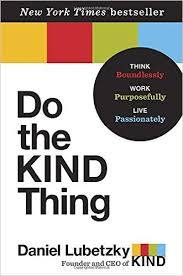 Daniel Lubetzky is a serial entrepreneur best known as the Founder and CEO of KIND Healthy Snacks.
Daniel Lubetzky is a serial entrepreneur best known as the Founder and CEO of KIND Healthy Snacks.
I encountered his book, Do the KIND Thing: Think Boundlessly, Work Purposefully, Live Passionately, through an act of philanthropic kindness. Each November, The Harry and Jeanette Weinberg Foundation holds its Annual Community Gathering, and this past year Mr. Lubetzky was the keynote speaker. The event brings together hundreds of individuals from communities near and far to celebrate their year in philanthropy, creating an authentic space for conversations between grant funders and grant seekers.
While admittedly the book, which was distributed at the event as another act of kindness, sat on my shelf for some time, it constantly caught my eye with its bright colors and its silently bolded refrain to “do the kind thing”. So, at a time when I began to question the presence of kindness in our world, I reached for the book.
It can be easy to think of the field of philanthropy as being naturally imbued with kindness, empathy and authenticity. While that may be truer than the field of commerce, it does not come without effort and it cannot flourish without intentional “care and feeding”. Emphasis on inflexible outcomes or the imbalance of power between funder and funded may be perceived as un-kindly and may even obscure opportunities and stifle audacious ideas that could lead to greater impact. Lubetzky challenges us to not approach our work or our lives from an “or” philosophy but rather one of “and”.
Do the KIND Thing makes clear that acts of kindness, whether in the personal or business context, should never be viewed from an “or” philosophy or seen as an act of weakness, but rather an act of courage. Bringing a philosophy of kindness and empathy to our work in philanthropy can enhance collaboration, build bridges between communities and create real solutions to what often appear to be insurmountable challenges. To get to that transformational place however, we must put ourselves, and our beliefs, out there in ways that may be uncomfortable.
Although the book is filled with stories tied specifically to the building of the KIND brand, it is a fascinating and heartening reporting on how kindness can build a brand and transform the world. It left me thankful for the many kind acts I witness every day in my work with grantees and thinking of ways to use the “and” philosophy to keep the conversations started last November at the Weinberg Annual Gathering moving forward.
By Kelly Medinger
02-16-2016
Announcing our most recent grant recipients in Catholic activities, education, health care, and human services
We are pleased to announce that 18 organizations received over $700,000 in our February 2016 grant cycle.
Catholic Activities
- FOCUS (Fellowship of Catholic University Students): $50,000 grant to support this organization’s expansion to Towson University, inviting college students into a growing relationship with their faith and the Catholic Church
- Ignatian Volunteer Corps.: $25,000 grant to support the Baltimore-based capacity building efforts of this Catholic, volunteer service organization for men and women over the age of 50
- Saint Clare Parish: $50,000 grant to support capital improvements to the interior church at this 60-year-old Catholic parish located in Essex, Maryland
- St. Vincent De Paul Roman Catholic Church: $12,840 grant to support the church’s Resource Exchange Program, which seeks to turn houses into homes for the formerly homeless
Education
- Acts4Youth: $10,000 grant to support two comprehensive mentoring programs, Game Plan to Manhood and Shine Into Womanhood, serving at-risk youth in Baltimore City elementary, middle, and high schools
- Druid Heights Community Development Corps: $30,000 grant to support year-round programming for youth living in the Druid Heights neighborhood of Baltimore City
- Higher Achievement Baltimore: $45,000 grant to support the general operations and technological capacity of this academic focused after-school program serving youth in grades 4 through 8 in Baltimore City
- Junior Achievement of Central Maryland: $30,000 grant to support the implementation of the JA Career Success and JA Build Your Future career prep and life success programs for early high school students in the Archdiocese of Baltimore
- Mercy High School: $76,150 grant to support technology upgrades at this all-girls Catholic high school in Baltimore City
- St. John the Evangelist Catholic School (Long Green): $50,000 grant to support a technology expansion, including 1:1 devices for the middle school, at this preK-8 Catholic school in Baltimore County
- Soccer Without Borders Baltimore: $35,000 grant to support this comprehensive afterschool program for newcomer refugee students in middle and high school in Baltimore City
- South Baltimore Learning Center: $45,500 grant to support the development and execution of a new marketing and outreach plan for this community-based organization focused on educationally disadvantaged adult learners in Baltimore City
Health Care
Human Services
- CASA of Allegany County: $25,000 grant to support efforts to recruit, screen, train, and support new volunteer advocates for children in the custody of the court in Allegany County
- Caroline Center: $50,000 grant to support the expansion of this Catholic, tuition-free employment training program for women in health care to Baltimore City’s Westside
- Catholic Charities: $64,100 grant to support the implementation of a professional mentoring program for teachers at their Catholic Charities Head Start of Baltimore City program
- Harford Community Action Agency, Inc.: $25,740 grant to support the expansion of their foodbank/pantry hours to reach more individuals and families in Harford County who are experiencing financial hardships
- Moveable Feast: $49,500 grant to support architectural design costs for this “food as medicine” organization’s renovation work as part of the Sustain the Feast, Secure the Future capital campaign
For a complete listing of our grant awards, please visit our past awards database.
By Kelly Medinger
02-10-2016
Bringing people together “under one roof” across Maryland
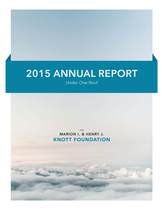 I am pleased to announce the publication of our 2015 annual report.
I am pleased to announce the publication of our 2015 annual report.
Last year painted a dichotomous picture of our community. On the one hand, we observed the noble ministry of nonprofits working tirelessly to help meet the spiritual, educational, social, and cultural needs of people all across Maryland. On the other hand, we also witnessed unrest in the wake of Freddie Gray’s death that plainly exposed the many structural inequities facing our city.
“Under One Roof” is the theme of our 2015 annual report. Through this theme we express optimism in our potential to bring people living in the Archdiocese of Baltimore closer in communion with one another, and to promote opportunity for all people.
I hope you enjoy reading our 2015 annual report and learning more about the Knott Foundation’s legacy as well as the many inspiring stories behind the grants that we award.
By Kelly Medinger
02-04-2016
Article explores how Knott grants to Catholic schools change students’ lives
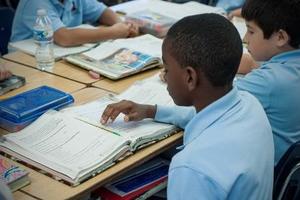 The February 2016 Catholic Review magazine features an article by Mary K. Tilghman that explores how our grants to Catholic schools improve students’ lives.
The February 2016 Catholic Review magazine features an article by Mary K. Tilghman that explores how our grants to Catholic schools improve students’ lives.
Education is our largest program area, and we’re proud to have awarded over $4 million to Catholic schools in the Archdiocese of Baltimore over the last five years. In 2015 alone, we awarded just over $1 million to Catholic schools, which equates to approximately 45% of our aggregate grantmaking distributions that year.
Beyond these numbers, however, is a story at each and every school illustrating how students are benefiting from the “whole package” that Catholic education offers: the character development it nurtures in students; the moral stability it provides to the community; the motivation it provides to students who are excelling academically; and the doors it opens for students who may have limited access to opportunity.
Our founders believed that education was the key to success, and that hard work combined with access to a quality education was the foundation from which all people could become active citizens, ready to give back and become leaders in their communities.
We thank the Catholic Review for highlighting our work in this area, and we hope you enjoy reading the article yourself.
By Kelly Medinger
12-22-2015
Everyman Theatre uses arts and humanities grant to find new ways to serve deaf and hard-of-hearing patrons
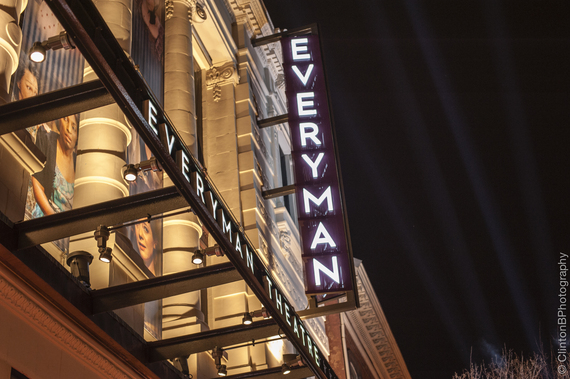 “What we strive for on stage is truth – finding a way to present something that is authentic,” proclaims Jonathan K. Waller, Managing Director of Everyman Theatre in Baltimore.
“What we strive for on stage is truth – finding a way to present something that is authentic,” proclaims Jonathan K. Waller, Managing Director of Everyman Theatre in Baltimore.
That sense of authenticity reached new heights in Everyman’s production of Tribes in 2014, where a deaf actor portrayed Billy, a deaf protagonist, in a coming-of-age story about being deaf in a hearing world. Notably, the show came to represent a coming-of-age for the Theatre itself and an opportunity for them to reach new audiences.
A Locally Grown Gem
Founded in 1990, Everyman Theatre has grown significantly over the past decade. In 2012 Everyman moved from an old converted bowling alley on Charles Street to the Bromo Tower Arts & Entertainment District. Today, the Theatre brings six productions to nearly 50,000 patrons each year.
Amidst this tremendous growth, however, Everyman remains deeply rooted in Baltimore’s local landscape: they employ a professional, equity-level resident company of actors who live in City neighborhoods, who send their children to neighborhood schools, and who are very much a part of the fabric of the community.
Technology as a Connector
For a number of years, Everyman experimented with ways to better serve deaf and hard-of-hearing patrons. Providing live sign language interpretation for select performances and investigating full service captioning for the entire theatre were two such options. As a small, local theatre company, the challenge became finding a more permanent and sustainable solution.
Everyman leveraged the production of Tribes to do just that. With a discretionary grant from the Knott Foundation and support from individual donors, the Theatre licensed cutting edge closed-captioning software, purchased 20 iPod touch devices, and began offering closed-captioning for all theatre performances.
“Closed captioning is definitely a game changer in how numerous people can experience live theatre, whether they are deaf or hard-of-hearing,” states Waller. Patrons now have a direct experience with the actors, instead of having to rely on an interpreter who is often positioned away from the main action of the stage. And Everyman’s commitment goes beyond technology to encompass staffing, training, and culture shifts. For example, an employee has been added to the Theatre’s production staff exclusively to operate the captions during each performance, and the Theatre teamed up with the Hearing and Speech Agency to help train house staff on basic sign language skills.
Strengthening Community Engagement
“The whole experience with Tribes has really become a case study for Everyman in how to reach new audiences and enhance inclusivity,” shares Alexandra Price, Director of Development. “Since then we have created a whole new department around community engagement with a dedicated staff position.”
Adds Waller, “Everyman Theatre’s name harkens back to the Everyman Theatre in Liverpool, England, which was founded on the principle of taking stories of kings and queens and making them accessible to the masses. In that tradition, our mission to make theatre accessible to everyone was pushed forward in a significant way with Tribes.”
In the meantime, Everyman Theatre continues to bring truth to the stage. The only difference is more people are able to join in that experience.
By Kelly Medinger
11-04-2015
Baltimore-area nonprofits are turning bright ideas into bold initiatives for social good
How many times do we have a bright idea, but push it aside for reasons like, “it’s too much work,” or “it’s never going to fly”? Well, some nonprofits here in Baltimore have ignored these excuses and turned their bright ideas into bold initiatives… all for the betterment of our city. I had the pleasure of visiting a few of these organizations this past month, and I’d like to share some stories of their innovation and good work with you.
Note: One important thing I learned from reflecting on these visits is that bright ideas don’t always require money. In fact, most (if not all) of the examples here occurred without any money ever changing hands.
Story #1: Fishing and farming to feed the hungry
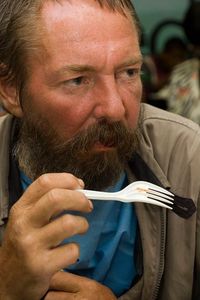 At the Franciscan Center’s “State of the Center” breakfast, I learned about two innovative partnerships that they’ve forged to help feed the hungry.
At the Franciscan Center’s “State of the Center” breakfast, I learned about two innovative partnerships that they’ve forged to help feed the hungry.
The Franciscan Center, a ministry of the Sisters of St. Francis of Assisi, serves more than 100,000 hot healthy meals every year to people in crisis. Several months ago the Center’s Executive Director, Christian Metzger, got a call from an area foundation that is a generous supporter of the Center’s mission, suggesting that he contact the Institute of Marine and Environmental Technology (IMET) in downtown Baltimore about a possible collaboration. IMET reported having tons of fresh and salt water fish they would use for research, and that there was ample demand from high-end restaurants to purchase the fish when the Institute no longer needed them. But IMET’s mission isn’t to sell fresh fish to expensive restaurants, so they asked Christian a question: “Could you use the fish from IMET to feed your guests?”
It was a great idea, but there were some roadblocks. Chief among them, how to clean and dress hundreds of pounds of fish at once when the Franciscan Center’s kitchen is small (in both physical size and number of staff). So Christian called the School of Culinary Arts at Stratford University in Baltimore and asked, “Could your students clean and dress a few hundred pounds of fish from IMET, a couple of times a year? The answer was yes, the School was happy to run “fish week” whenever the time was right. As a result, the Franciscan Center will receive this fresh, high quality protein ready to cook!
Then along came another innovative partnership. The Shrine of St. Anthony in Ellicott City, run by the Franciscan Friars, has a large property with 310 acres of rolling hills, woodlands, and farmland. About 85 acres are currently leased to a cash crop farmer. The Friars have generously agreed to set aside five acres of this farmland for the Franciscan Center, where they will grow vegetables for the Center’s dining and food pantry programs. A sign on the property will advertise this collaborative partnership between Franciscan organizations. There are also plans to engage the University of Maryland Agricultural Center, which is adjacent to the property, and recruit volunteers from St. Louis Church in Clarksville, the nearest Catholic parish, to help with the upkeep of the new Franciscan Center Farm.
Story #2: Word searches, table toppers, and recycling pick-up to employ adults with autism
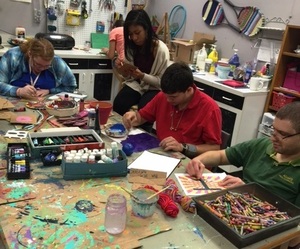 Itineris (the Latin word for journey) is an organization in Baltimore that serves adults with autism. All 60 of their clients are working (75% of them are getting paid), but that’s not the most impressive aspect of their program. All 60 of their clients are working in jobs they want to do. Itineris boasts just as many job sites as clients and doesn’t “track” their clients into specified fields based on job availability. Rather, they work with each individual to find their passion, and then turn that passion into productive activity.
Itineris (the Latin word for journey) is an organization in Baltimore that serves adults with autism. All 60 of their clients are working (75% of them are getting paid), but that’s not the most impressive aspect of their program. All 60 of their clients are working in jobs they want to do. Itineris boasts just as many job sites as clients and doesn’t “track” their clients into specified fields based on job availability. Rather, they work with each individual to find their passion, and then turn that passion into productive activity.
When I visited Interis’ home at The Pointe on Rockrose near TV Hill, I saw first-hand how enthusiastic they are about turning a client’s passion into work. One example is word searches. Itineris has a client who is gifted at making customized word searches. He has even published a book with creatively-themed searches! The fun part is that this person is available for hire. Do you want to add a word search to your wedding gift bags? How about as a placemat at your next family reunion? Or printed on the back of your Christmas newsletter? The options are endless.
I also witnessed several artistic Itineris clients assembling table toppers for a fundraising gala. They were beautiful and were customized according to the theme and colors for the big event. Another Itineris client showed a penchant for sorting. “He can sort anything!” his caseworker proclaimed. They worked with him to create a recycling business where he picks up recyclables from local businesses, sorts them, and turns them in by the pound for profit.
Story #3: Expanding to serve both East and West Baltimore
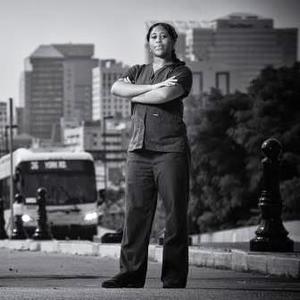 I was delighted to take part in a recent celebration for Caroline Center, looking back at their 20 years of service to educate women for sustainable careers. Sister Patricia McLaughlin, SSND, made an exciting announcement at the event: Caroline Center will open a new permanent location on the old Gibbon’s High School property on Baltimore’s West Side next year. In the meantime, they will offer classes for certified nursing assistants and geriatric nursing assistants (CNA/GNA) in a temporary (and rent-free) space at St. Agnes Hospital.
I was delighted to take part in a recent celebration for Caroline Center, looking back at their 20 years of service to educate women for sustainable careers. Sister Patricia McLaughlin, SSND, made an exciting announcement at the event: Caroline Center will open a new permanent location on the old Gibbon’s High School property on Baltimore’s West Side next year. In the meantime, they will offer classes for certified nursing assistants and geriatric nursing assistants (CNA/GNA) in a temporary (and rent-free) space at St. Agnes Hospital.
After the death of Freddie Gray, Caroline Center reflected on its mission to offer a life-changing education and career skills training to women and felt there was a calling to expand their reach in the city. The School Sisters have had a presence in East Baltimore for nearly a century-and-a-half, and now their work will expand to the West Side as well.
In sum, our Baltimore-area nonprofits do an incredible job turning bright ideas for partnerships, employment, and expansion into bold initiatives for the betterment of our community. It is a privilege to work amongst these great organizations and to have this opportunity to share these small but meaningful snippets of their stories with you.
By Kelly Medinger
10-30-2015
New research reveals Catholic schools matter more to urban neighborhoods than you might think
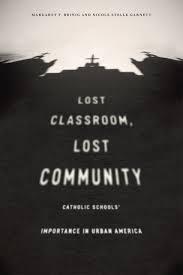 As an alumna of the University of Notre Dame, I was pleased to attend a recent event where two Notre Dame professors presented their findings on a novel claim in the Catholic education landscape. In their book Lost Classroom, Lost Community (The University of Chicago Press, 2014), authors Margaret F. Brinig and Nicole Stelle Garnett offer empirical evidence that Catholic schools improve neighborhoods in important ways beyond educational outcomes.
As an alumna of the University of Notre Dame, I was pleased to attend a recent event where two Notre Dame professors presented their findings on a novel claim in the Catholic education landscape. In their book Lost Classroom, Lost Community (The University of Chicago Press, 2014), authors Margaret F. Brinig and Nicole Stelle Garnett offer empirical evidence that Catholic schools improve neighborhoods in important ways beyond educational outcomes.
Brinig and Garnett’s statistical model submits that the very presence of a Catholic school in an urban neighborhood reduces crime, suppresses neighborhood disorder, and increases social cohesion.
To prove their thesis, the authors examine the Archdiocese of Chicago – the largest private school system in the United States – alongside data from the Project on Human Development in Chicago Neighborhoods and police beat crime reports. The lynchpin of their analysis is the identification of an instrumental variable for why Catholic schools in Chicago were closed. It turns out that factors related to the leadership of the pastor at each school were more predictive of school closures than anything else. This allowed the researchers to disaggregate the data from demographic variables that might otherwise have predicted the neighborhood’s decline. Why is this technicality so important? Because it paves the way for the holy grail of statistical modeling: an empirical, causal link between the closure of a Catholic school and the decline of the surrounding neighborhood.
Statistics aside, the authors’ point is this: urban Catholic schools are more than just teaching institutions, they are community institutions. They help to sustain the peace, build trust among people, and promote social and physical order in the community. Brinig and Garnett further state that Catholic schools may be unique to public schools and charter schools in this regard, as the neighborhood social cohesion data could not be replicated with public charter schools. The converse of their claim, of course, is that Catholic school closures result in more crime and disorder and less social cohesion in urban districts.
I was especially moved by the authors’ research and analysis for two reasons.
First, I believe in the power of education to transform lives, and this new research points to ways that Catholic schools are able to do that beyond just focusing on test scores, graduation rates, college acceptance rates, or even the spiritual development of our young people. It turns out that just living in a neighborhood with a Catholic school, but not necessarily even going to it, can be advantageous.
Second, I believe that relationships matter. If people know one another, if people are not only neighbors but friends, they are more likely to respect each other and be tolerant of their individual differences. Since we now know that Catholic schools promote relationships between people beyond the school itself, then I would venture to say that the Church’s presence in these neighborhoods is not only fulfilling an educational mission, but a parallel mission of community fellowship and trust.
As a Catholic family foundation dedicated to strengthening the community in the Archdiocese of Baltimore, Brinig and Garnett’s book really hit home. It suggests that our giving to Catholic schools, which has exceeded $4 million over the past five years, has a strong impact both inside and outside of school walls. Indeed, it seems plausible to consider Catholic education as one of the Church’s most powerful tools in community development, urban renewal, and poverty alleviation. This idea – when coupled with the renaissance our Catholic schools are experiencing, as reported by Philanthropy Roundtable’s Andy Smarick and Kelly Robson – is both promising and profound.
Brinig and Garnett’s statistical analysis is not for the faint of heart. Their presentation of the data is extensive, and there is ample background and history to digest. But the bottom line is worth the read, because it says that our Catholic schools matter more to our city than the average person might think.
By Kelly Medinger
10-23-2015
Announcing our most recent grant recipients in Catholic activities, education, and human services
We are pleased to announce that 14 organizations received over $700,000 in our October 2015 grant cycle.
Catholic Activities
- St.Francis Xavier Parish: $85,175 grant to support capital improvements to this historic church in East Baltimore, known as the first African American Catholic church community in the United States
Education
- Mother Seton Academy: $40,000 grant to support school-wide technology upgrades at this co-ed, tuition-free Catholic middle school in Baltimore City
- Mother Seton School: $30,000 grant to support the purchase and installation of interactive projectors in classrooms at this pre-K-8 Catholic school in Emmitsburg
- Sacred Heart School of Glyndon: $60,000 grant to support a 1:1 technology initiative for grades 6 through 8 at this pre-K-8 Catholic school in Baltimore County
- Seton Keough High School: $47,363 grant to support technology infrastructure upgrades at this all-girls Catholic high school in Baltimore City
- Visitation Academy: $90,665 grant to support capital improvements to this historic, all-girls pre-K-8 Catholic school in Frederick
Human Services
- Hampden Family Center: $65,000 grant to support capital improvements to this “community hub” that offers educational and support services to families, children, youth, and senior citizens living in the Hampden neighborhood of Baltimore City
- Manna House, Inc.: $40,000 grant to support the hiring of two new staff to assist this day shelter for the homeless reach more individuals in need in Baltimore City
- Meals on Wheels of Central MD., Inc.: $40,000 grant to support the Case Management and Client Services program, designed to help homebound people remain in their homes by connecting them to critical services
- Parks & People Foundation: $46,243 grant to support the BRANCHES youth job program for middle and high school youth in the Mondawmin community in Baltimore City
- St. Vincent de Paul of Baltimore: $40,000 grant to support a technology upgrade that will help unify multiple program sites for improved data collection, program delivery, and mission advancement at this human-serving organization located in Baltimore City
For a complete listing of our grant awards, please visit our past awards database.
By Kelly Medinger
10-05-2015
Marian House uses human services grant to create a brighter future for women and the world
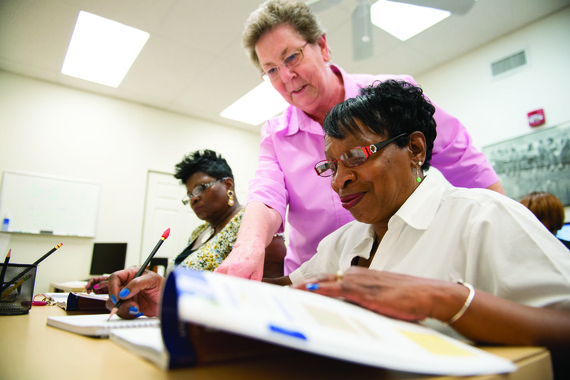 When Marian House opened its doors 33 years ago, their vision was to provide a brighter future to homeless women coming out of the prison system. Today, while Marian House has expanded to serve homeless women coming from multiple avenues, that vision has stayed true: to transform society by unlocking the potential of women who need a supportive place to live and heal.
When Marian House opened its doors 33 years ago, their vision was to provide a brighter future to homeless women coming out of the prison system. Today, while Marian House has expanded to serve homeless women coming from multiple avenues, that vision has stayed true: to transform society by unlocking the potential of women who need a supportive place to live and heal.
A Positive Transformation
The women living in Marian House’s transitional housing program are more than residents; they help run the organization. Residents staff the reception office – answering the phones and greeting visitors at the door – and they also cook dinner for each other every night and clean-up the kitchen afterwards.
“There are so many ways we’re trying to teach the women positive habits, from having dinner together, to recycling, to taking time to focus on their own personal development,” says Katie Allston, Executive Director.
Marian House’s rigorous program starts with an application, interview, and intake process, and women stay for an average of 11 months. “The women who come here are motivated to change their lives for the better,” adds Libby Keady, Grant Writer. “They have to demonstrate a capacity and drive to be a part of a structured program.”
Headquarters Upgrades
Marian House’s headquarters was built in 1928. It originally was used as a convent for nuns teaching at St. Bernard’s Catholic School across the street. The building now contains 29 single rooms, 4 family apartments, an education center, a commercial kitchen, a meeting room, and a large dining room for the women in Marian House’s transitional housing program, as well as space for approximately one dozen staff.
The Knott Foundation made a grant to Marian House to help install a new roof fitted with a state-of-the-art solar photovoltaic system on their headquarters building. Marian House’s headquarters now produces 75%-100% of its own energy. Any surplus energy is sold back to the power company, thereby creating a new revenue stream for the organization.
The Ripple Effect
Rooted in the Catholic tradition of their founders, the Sisters of Mercy and the School Sisters of Notre Dame, the work that Marian House does both to help homeless women and to be good environmental stewards has a broad positive impact.
“The focus of Marian House is to help women get back on their feet again, because women are often the primary teachers for their children. In that way, the ripple effect of Marian House is really quite extraordinary,” states Pete McIver, Director of Operations.
When talking about her time in the program, one resident reflects: “I now want a career, not just a job. It’s the first time I’ve had a chance to do that. ” Marian House has clearly helped her unlock her potential and envision a brighter future for herself.
By Kelly Medinger
09-17-2015
Saint Margaret Parish uses Catholic activities grant to replace aging roof
 Upon entering Saint Margaret Church, a magnificent prism of colorful stained glass shines over the baptistery. A large portion of the glass was actually closed off to direct sunlight until Saint Margaret replaced its roof and opened up the feature to natural light. “It has made such a difference for the presentation of this space,” proclaims Sandy Laird, Facilities Manager. “It was dark, and now it’s light and much more spacious.”
Upon entering Saint Margaret Church, a magnificent prism of colorful stained glass shines over the baptistery. A large portion of the glass was actually closed off to direct sunlight until Saint Margaret replaced its roof and opened up the feature to natural light. “It has made such a difference for the presentation of this space,” proclaims Sandy Laird, Facilities Manager. “It was dark, and now it’s light and much more spacious.”
Lighting the Way
Each weekend, 3,000 people attend Mass at Saint Margaret Parish, a Roman Catholic community with two locations in the heart of Bel Air, Maryland. As the largest parish in Harford County – and one of the largest in the Archdiocese of Baltimore – Saint Margaret serves as the center of Catholic spiritual life for thousands of families.
The pastor, Monsignor Michael Schleupner, explains the overall design of the worship space: “When you’re walking from the narthex into the sanctuary, the surrounding stained glass panels have a water-like effect. It’s as if you’re walking through the waters of baptism, which you need before entering the church to receive the sacrament of the Eucharist.”
Raising Support
Replacing the 30-year-old roof of the church was the first phase of a larger renovation project at Saint Margaret, partially funded by an even larger campaign for the entire Archdiocese. “We raised a record amount of money from this parish for the Archdiocesan campaign, while also raising money for our own capital needs,” shares Monsignor Schleupner.
“While we’re a large parish, we’re still a working class parish,” Monsignor Schleupner states. Support for the campaign is evident among a wide base of donors, who have all contributed what they can to make the church’s dream a reality. Among those donors, Saint Margaret received a capital grant from the Knott Foundation to help replace the aging roof. In this case, the construction project not only fortified the building, but also brought a new element of light and beauty to the entrance of the church.
Building Community
Community building is an integral part of the Catholic Church’s mission, and the campaign and renovations of Saint Margaret have brought the parish community together in multiple ways. For a time, parishioners attended Mass in the school gym, which the Liturgy Committee transformed into a worship space. People not only continued to come to Mass at Saint Margaret throughout the renovations, but many made personal gifts to the campaign.
With a new roof and other infrastructure upgrades, Saint Margaret Parish has turned its attention to enhancing the feeling of fellowship in the interior church. It is this strong feeling of communion with God and one another that makes Saint Margaret the spiritual home for so many Catholic families throughout Harford County.
By Carol Hoffman
07-14-2015
Finding joy and spreading the word
 I recently read The Joy of the Gospel by Pope Francis with my parish prayer group at Our Lady of Grace in Parkton.
I recently read The Joy of the Gospel by Pope Francis with my parish prayer group at Our Lady of Grace in Parkton.
The overall message of this book is that the Gospel fills the hearts and lives of all who encounter Christ. If we accept his offer of salvation, we are set free from sin, sorrow, and loneliness.
Pope Francis states that the Church must be a place of mercy, freely given, where everyone can feel welcome, loved and forgiven. He says the Eucharist is not a prize for the perfect, but a powerful medicine and nourishment for the weak. There are also many discussions related to economic justice and decision-making roles for women in the Church, which makes it thought-provoking for Catholics to read.
In the book, the Pope addresses the many troubles the Catholic Church is going through and tells us that the old ways of the Church do not work anymore. He says the Church needs to embark on evangelization with great enthusiasm and vitality. He invites everyone to be bold and creative in rethinking the goals, structures, styles, and methods of evangelization in their respective communities, and working within their own congregations and neighborhoods.
While I believe this message about evangelization is very true, I also feel that it’s very hard for most people to go out and preach the teachings of the Church. We not only need to be knowledgeable about our faith to evangelize, we also need to be comfortable approaching people in society on this subject.
Yet it strikes me that the Knott Foundation’s act of giving grants to nonprofits in the Baltimore metropolitan area helps in some small way to spread the word of many worthy organizations and causes, just as the Pope would like all Catholics to spread the word of the Catholic faith. In this way, I believe my work here at the Foundation helps me to understand the Pope’s message in new ways, because part of “evangelizing” is giving back to the community and refusing to hide from those who are less fortunate.
Pope Francis concludes, “Like the hummingbird that keeps coming back to the sugar water feeder, we need to keep returning to The Joy of the Gospel for encouragement, knowledge, and inspiration in the practice of our faith. It is in giving to others that it returns to you.”
By Kathleen McCarthy
07-10-2015
Help for the Accidental Technologist in a rapidly changing landscape
We are endlessly bombarded by the hype of the technology market – the newest device, the latest app, the ever-expanding cloud. It is all so bright and shiny and set to a musical score that makes us believe this next purchase will solve all of our technology needs, and we jump. Taking such a jump can be exhilarating when done for our own personal consumption, but when “the accidental technologist” is asked to do so for our organization, the leap can be overwhelming.
Accidental Technologist (noun): a person who, without any formal training has somehow become the go-to person in their organization for technology troubleshooting. Perhaps you did a great job clearing a paper jam out of the copier or suggested to your colleague that they reboot their computer when it was acting “glitchy.” Somehow, these actions caught the attention of your colleagues and you were swiftly tagged as the de facto IT person.
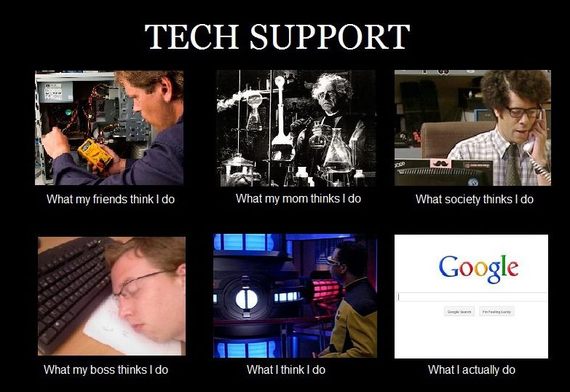 Studies such as the most recent NTEN Technology Staffing and Investment Report indicate that regardless of organizational size, the median technology budget as a percentage of total operating budget ranges from 1.4% to 2%. Meanwhile, 78% of organizations described themselves as barely maintaining or failing to maintain their technology systems. Technology has become a critical component of an organization’s backbone, and yet the accidental technologist is faced with making big decisions in an ever-changing marketplace with limited resources and often little time and access to expertise.
Studies such as the most recent NTEN Technology Staffing and Investment Report indicate that regardless of organizational size, the median technology budget as a percentage of total operating budget ranges from 1.4% to 2%. Meanwhile, 78% of organizations described themselves as barely maintaining or failing to maintain their technology systems. Technology has become a critical component of an organization’s backbone, and yet the accidental technologist is faced with making big decisions in an ever-changing marketplace with limited resources and often little time and access to expertise.
Over the past five years, we at the Knott Foundation have seen requests for technology-related support increase dramatically with the explosion of technology in classrooms and the rise of the importance of social networking and responsive design in fundraising for nonprofits. In response, our technology giving has grown to more than $2.5 million during that period, averaging slightly above $500,000 each year. Many of these awards have been given to schools and nonprofits who are lacking formally trained IT staff.
Through our work, we have learned a tremendous amount about the challenges faced by and the resources that exist to help guide “the accidental technologist” with technology planning, purchasing, and the many innovative approaches taken to make informed choices, save money without offsetting impact, and strengthen their organization’s backbone.
Sites such as TechSoup’s Cookbook and blog resources such as The Nine Steps of Planning a Successful Technology Project and Mobile Beacon’s Tech Planning Blog can be of tremendous assistance when trying to develop a right-sized, needs-based technology plan. Schools looking to invest in a one-to-one computing initiative can read Ten Considerations for Funding or Implementing Programs and opportunities to “try before you buy” can be found through EdSurge. Sites such as TechSoup, Digital Wish and Good360 can help schools and nonprofits secure hardware and software for dramatically reduced prices, or even for free. TechSoup notably has a section on donations and resources for religious organizations.
Hardware and software in-hand, the ability of technology to innovate in the workspace is reliant upon taking the time to train staff and create opportunities for professional development. Sites such as Lynda.com and Atomic Learning, for a fee, provide access to thousands of professional development and technology training opportunities with the click of a mouse. Idealware is a great site for information on a wide range of technology training, purchasing, and grantwriting, and you can even find helpful trainings on YouTube. Many of our grantees also create their own in-house video libraries by taping formal trainings provided by vendors or peers for use by new staff or returning staff looking to brush up on skills.
And, for the truly DIYs out there, ingenious ideas such as using igloo coolers to transport iPads instead of carts, converting cubby storage units into charging stations, and using flexible PVC pipe fittings to create iPad stands for students in wheelchairs can not only help save money, but may also help forge a community of excited accidental technologists that turn your organization into a group of passionate, tech savvy intentional futurists!
By Kelly Medinger
06-12-2015
Announcing our most recent grant recipients in Catholic activities, education, health care, and human services
We are pleased to announce that 13 organizations received over $700,000 in our June 2015 grant cycle.
Catholic Activities
Education
- Boys Hope Girls Hope of Baltimore: $48,000 grant to support operating costs for 16 scholars, ages 10-18, residing in the boys and girls homes in Baltimore City
- St. Augustine Catholic School: $45,750 grant to support an educational technology upgrade project including iPads, projectors, software, and teacher training at this pre-K-8 Catholic school in Howard County
- St. Mary Catholic School: $46,970 grant to support new computers for the student computer lab, faculty, and staff at this pre-K-8 Catholic school in Washington County
- St. Philip Neri School: $70,000 grant to support technology including infrastructure upgrades, a mobile device program for students, and professional development at this pre-K-8 Catholic school in Anne Arundel County
- St. Pius X School: $82,500 grant to support technology including infrastructure upgrades and tablet devices for students at this pre-K-8 Catholic school in Baltimore County
Health Care
Human Services
- Catholic Charities: $52,480 grant to support the hiring of a case manager for My Sister's Place Women's Center's Learn to Earn Internship Program, which helps women in Baltimore City experiencing poverty and homelessness obtain employment and housing
- H.O.P.E. (For All): $22,000 grant to support general operating costs associated with the Turning Houses into Homes Program, which assists formerly homeless families and individuals in Anne Arundel County secure furniture and household items when they begin again in their own home
- House of Ruth: $25,000 grant to support the hiring of a bilingual child therapist for the Adelante Familia program, serving Hispanic/Latino children and parents in the Highlandtown neighborhood of Baltimore City
- Maryland Food Bank: $75,000 grant to support this hunger relief agency’s food safety initiative by upgrading their main distribution warehouse in Baltimore
- Paul's Place Outreach Center: $30,000 grant to support case management in the STABLE housing program, which seeks to rapidly re-house individuals experiencing chronic homelessness and prevent first-time homelessness in the Pigtown neighborhood of Baltimore City
For a complete listing of our grant awards, please visit our past awards database.
By Kelly Medinger
05-19-2015
Brook Lane Health Services uses health care grant to construct a new hospital wing for children
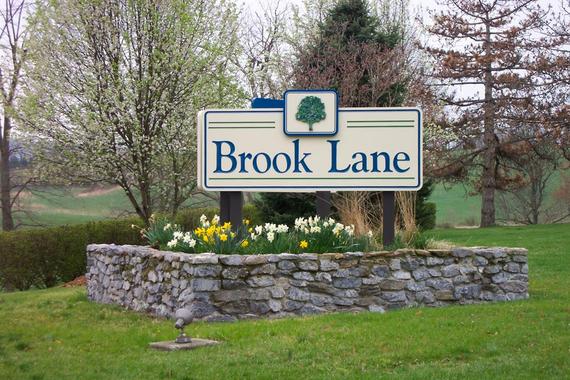 When a single mother whose six-year-old son was in need of inpatient mental health services in Hagerstown and there was no bed available at Brook Lane, the child and his mother were taken by ambulance to the next nearest in-patient facility, 75 miles away. Once the child was admitted there, the mother had to find affordable transportation back to Hagerstown, and then negotiate trips back and forth to Baltimore to be with her child, all while keeping her job.
When a single mother whose six-year-old son was in need of inpatient mental health services in Hagerstown and there was no bed available at Brook Lane, the child and his mother were taken by ambulance to the next nearest in-patient facility, 75 miles away. Once the child was admitted there, the mother had to find affordable transportation back to Hagerstown, and then negotiate trips back and forth to Baltimore to be with her child, all while keeping her job.
Kids Need Room Campaign
Located in Hagerstown, Maryland, Brook Lane offers a continuum of mental health services for children, adolescents, and adults. It is the only inpatient psychiatric facility for children and adolescents in the Western Maryland region.
In 2013, Brook Lane turned away 732 children and adolescents because all of their beds were full. A child who is turned away must remain in the emergency room until a bed is available, travel an hour or more to the nearest alternative facility, or return home without treatment.
To help kids get the specialized care they need and better serve families in the region, Brook Lane launched the Kids Need Room campaign. The campaign’s cornerstone was the construction of a new hospital wing with 14 single occupancy rooms for children. Brook Lane raised just over $2 million for the project, including a capital grant from the Knott Foundation.
More Room to Help People
When the new hospital wing opened in 2015, the number of beds available at Brook Lane increased from 43 to 57. Twenty-five staff were added to accommodate the growth in patient census and facility upkeep. This extra capacity allows them to care for 400 to 500 more children and adolescents each year, greatly reducing those who must be turned away.
Intakes at Brook Lane are done 24 hours a day, 7 days a week, where patients receive crisis stabilization in a safe and therapeutic environment. Kids most often come directly from the emergency room at a hospital with diagnoses of bipolar disorder or major depression, and they stay an average of six to eight days before being released with a treatment plan.
Saving Lives One Room at a Time
Over the past 65 years, Brook Lane has provided education and treatment to improve patients’ emotional and behavioral well-being. “We’re saving lives. We’re making lives better for people who are dealing with mental illness, whether it’s a coping skills issue, a behavioral issue, or a chemical imbalance,” says Kay Hoffman, Director of Development.
“When they find out where I work, people often joke by saying, ‘Save me a room!’” says Hoffman. “I always respond, ‘Do you know how lucky you are that we even have a room?” Indeed, the mother from Hagerstown whose son ended up in Baltimore is a fitting depiction of how Brook Lane can make a difference, one room at a time.
By Kelly Medinger
05-19-2015
Notre Dame Prep uses education grant to construct a new center on campus dedicated to science, technology, engineering, art, and math
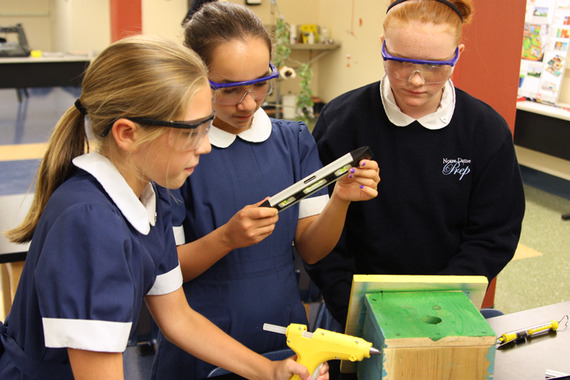 Two students, Francesca Zink ’16 and Victoria Niller ’16, stand in a room full of students and talk excitedly about robotics. They explain that last year they teamed up and designed a robot named Tank the Shark. While it took only three days to design Tank, it took months to construct him, wire him to a control panel, master how to power his movements, and give him a distinctive personality. This year they have teamed up again, and their robot’s movements are automated by a computer program they wrote. (In a show of Maryland pride, he’s a racehorse with a Preakness theme.)
Two students, Francesca Zink ’16 and Victoria Niller ’16, stand in a room full of students and talk excitedly about robotics. They explain that last year they teamed up and designed a robot named Tank the Shark. While it took only three days to design Tank, it took months to construct him, wire him to a control panel, master how to power his movements, and give him a distinctive personality. This year they have teamed up again, and their robot’s movements are automated by a computer program they wrote. (In a show of Maryland pride, he’s a racehorse with a Preakness theme.)
About NDP and STEAM
At Notre Dame Preparatory School (NDP), a Catholic school for girls in grades 6-12 sponsored by the School Sisters of Notre Dame, students have a multitude of opportunities to interact with the worlds of science, technology, engineering, art, and math, or STEAM.
In 2014, the Knott Foundation helped to fund the construction of a new STEAM center on campus. The center is a glass-enclosed space peppered with state-of-the-art equipment and bustling with activity. “At least once a day someone stops in front of the glass to see what’s happening,” shares Patrick Cusick, Engineering Teacher.
Interest in engineering at NDP has skyrocketed in recent years. In 2012, 11 students were enrolled in Introduction to Engineering. Four years later that number is projected to be 54 students in the introductory class and an additional 12 in Design/Build Engineering, the more advanced course.
Fostering Teamwork
Yet engineering is not a singular effort. It is about teamwork, including understanding and communicating the team’s product and process for getting there. Francesca adds, “Engineering isn’t just math and science. It’s also people skills. You really need to explain what you’re doing, and NDP prepares us well for that.”
“Everyone puts their part into the team,” Francesca notes. “I think that’s so cool about engineering. You’re not just in your cubicle; you’re bouncing ideas off each other.”
Engaging Students
The teamwork at NDP goes beyond the students and encompasses the faculty and academic departments as well. Taking an interdisciplinary approach, STEAM subjects are incorporated into the humanities (for example, students 3D print the skull of Yorick from Hamlet) and the theatre program, where engineering students conceptualize and construct set designs for the theatre program.
While the STEAM program and center at NDP provide the skills, awareness, and confidence for girls to excel in these subjects, the benefit extends beyond these areas. “What strikes me the most is the joy,” declares Marianne Reichelt, Acting Principal. “The students in the STEAM center are always energetic and engaged. It’s the classroom where the students are the most excited.” Victoria agrees: “The engineering class is the reason I decided to come to NDP.”
By Kelly Medinger
03-10-2015
Connecting to the vision and values of our founders
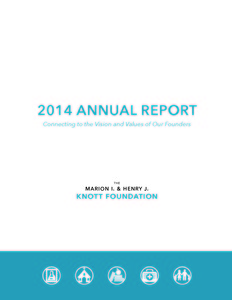 It is my pleasure to announce the publication of our 2014 annual report!
It is my pleasure to announce the publication of our 2014 annual report!
In 2014, we came together to explore and formalize the values and principles behind our founders’ generosity to people and organizations in the Archdiocese of Baltimore. Consequently, in addition to stories about the impact of our grant awards, our 2014 annual report features short narratives about Henry and Marion Knott and how they lived their lives. These narratives and the values that they stand for inform our work as a Catholic family foundation committed to nurturing family unity and strengthening the community.
On a more personal note, I would like to remark on the passing of our beloved trustee, Alice Voelkel, at the end of last year. Alice was the third of Henry and Marion Knott’s 13 children. She was a past president of the Knott Foundation and a charter trustee, serving for 37 years on our board. She will be dearly missed.
I hope you enjoy reading our 2014 annual report and learning more about the Knott Foundation’s story and the many wonderful stories behind the grants that we award.
By Kelly Medinger
03-01-2015
How to embrace chaos and see new ways to better outcomes
 Last month we completed some office renovations that – while celebrated in appearance and increased functionality – disrupted our normal course of operations. So much so that I started calling the project “Operation Disruptive Innovation” in my own mind, in reference to the catalytic social change phenomenon with the same name (Christensen et. al., Disruptive Innovation for Social Change, Harvard Business Review, December 2006).
Last month we completed some office renovations that – while celebrated in appearance and increased functionality – disrupted our normal course of operations. So much so that I started calling the project “Operation Disruptive Innovation” in my own mind, in reference to the catalytic social change phenomenon with the same name (Christensen et. al., Disruptive Innovation for Social Change, Harvard Business Review, December 2006).
Yet disruption is part of our everyday work and life. How many times have you hosted a dinner party, only to have a dish not turn out or finish cooking on time? How many times have you been awarded a grant for a project, only to have an unanticipated challenge stall its progress? Things rarely go according to plan, and new challenges emerge at every turn.
The question isn’t how to minimize these disruptions, but how to maximize their usefulness. You see, when things go according to plan, we rarely have to think outside the box. But when things get turned upside down, we tend to produce new ideas and solutions that change the trajectory of our work. It seems disruption can help us be more creative and innovative, if approached with a positive mindset.
I recently attended a lecture by Robert Siegel, longtime host of All Things Considered on NPR. He walked through four life lessons, one for each decade he’s been in journalism. The first lesson was the most salient to me and touched on this point about disruption. Siegel advised, “When presented with a possibility, don’t spend your time thinking about why it won’t work. Instead spend your time figuring out how to make it work.” As a young editor at NPR, Siegel was at the table when the station decided to cover a major congressional event gavel to gavel. Instead of dismissing this unorthodox idea when the opportunity arose, his team concentrated on ways to seize the challenge. It disrupted NPR’s normal programming, but the groundbreaking coverage catapulted the station to new heights.
As “Disruptive Innovation” points out, “Organizations are set up to support their existing business models.” Most innovations, therefore, advance an organization’s current model by improving the quality or functionality of services offered. But disruptive innovations go beyond this realm of sustaining or enhancing existing operations. They break through barriers and bring new benefits to more people in simpler ways.
Some of our grantees have taken this approach to heart. Top of mind is the Cristo Rey Network, which has opened the door for 9,000 students nationwide to attend a Catholic school through its innovative work study program. Here in Baltimore, Cristo Rey Jesuit High School opened in 2007 and currently serves 360 boys and girls. Their formula is simple – students’ jobs help pay for school – yet radically different than the typical high school business model.
The big question, of course, is how to create disruptive innovation in the social sector and bring about the positive changes in education, health, and human services that we all desire. To answer that question, I might direct you to my colleague Kathleen McCarthy’s post on Steven Johnson’s book, Where Good Ideas Come From. Because as Johnson (and my favorite GE commercial) expresses, “Old ideas can sometimes use new buildings. New ideas must use old buildings.” In other words, it’s difficult to accept new ideas in the context of our old environment.
At the Knott Foundation, our environment is looking a bit more new and fresh these days. And while “Operation Disruptive Innovation” might end with the completion of our office renovation, I hope the spirit of disruption continues to yield creative insights, a positive focus on possibilities, and new ideas that help change the world for the better.
By Kelly Medinger
02-27-2015
Announcing our most recent grant recipients in arts & humanities, education, health care, and human services
We are pleased to announce that 14 organizations received over $700,000 in our February 2015 grant cycle.
Arts & Humanities
- Art With A Heart: $20,000 grant to support general operating costs associated with the Youth Entrepreneurship Program serving at-risk youth ages 16-24
Education
- Archbishop Spalding High School: $150,000 grant to support this Catholic high school’s Keeping the Promise Campaign by purchasing seating for the renovated auditorium
- Bishop Walsh School: $81,275 grant to support technology upgrades including interactive display systems and iPads for this pre-K-12 Catholic school located in Cumberland, Maryland
- Boys & Girls Clubs of Harford County: $45,240 grant to support the STEM Technology Refresh project benefitting children ages 5-18 at four of the Club’s locations
- Downtown Sailing Center: $25,588 grant to support salaries related to the organization’s STEM Summer Program, which provides hands-on STEM enrichment to 80 low-income children from Baltimore City and County
- Dyslexia Tutoring Program: $40,000 grant to support operating costs to deliver free specialized tutoring services to low-income children and adults who are dyslexic or have a language-based learning disability
- John Carroll School: $40,000 grant to support the acquisition of architectural designs for the renovation of the Academic Wing at this Catholic high school in Harford County
- St. Elizabeth School: $43,764 grant to support the replacement of carpeting throughout this Catholic school serving children with special needs age 6-21
- St. Francis Neighborhood Center: $40,000 grant to support this community-based organization’s Power Project, an after-school program for children ages 5-14 in the Reservoir Hill neighborhood of Baltimore City
- St. Michael the Archangel School: $45,000 grant to support technology infrastructure upgrades, projectors, and the installation of an interactive weather station at this pre-K-8 Catholic school
- Trinity School: $55,000 grant to support renovations to St. Lidwine’s Hall at this pre-K-8 Catholic school
Health Care
- Good Shepherd Services: $90,000 grant to support renovations to two residential units, providing housing and therapeutic services to youth ages 13-21 who are experiencing severe mental health and emotional disorders
- Shepherd's Clinic: $35,000 grant to support operating costs to provide health care to uninsured and underserved adults age 19-64 living in northeast Baltimore
Human Services
- Assistance Center of Towson Churches: $10,000 grant to support emergency assistance with evictions, utility turn offs, and medicine for people in need living in Baltimore City and County
For a complete listing of our grant awards, please visit our past awards database.
By Kelly Medinger
02-27-2015
Helping organizations make ends meet in times of uncertainty
Financial uncertainty is more common than not in the nonprofit world. One estimate says that approximately one-third of all nonprofits operate in a constant state of financial distress (Mattocks, Zone of Insolvency, 2008). For others, financial distress can come at a moment’s notice. A late grant payment, a pending insurance claim for a major repair, or a lackluster fundraiser can make it difficult for organizations to make ends meet in any given month.
The Knott Foundation can serve as a source of help. In 2003, we began offering cash flow loans to qualifying nonprofits that meet our eligibility guidelines. In brief, we have the ability to provide short-term loans of $10,000-$25,000 with favorable rates and a quick turnaround time to nonprofits experiencing delayed receivables. You can learn more about the cash flow loan program and how to apply on our website.
Over the last 12 years, we’ve awarded 38 loans totaling $739,500. As of the date of this posting, all of the funds have been paid back to the Foundation. Many organizations have benefited and, while the number of loans awarded each year reached its peak in 2008, we continue to respond to inquiries and accept applications.
A few years ago we highlighted a story about one of our cash flow loan recipients and their journey with fundraising after undergoing a leadership transition. That story is just one example of how an organization experiencing unforeseen financial distress can benefit from a small loan to bridge a critical moment in time.
Cash flow loans are just one tool that we’ve been able to use to help make a difference in the day-to-day operations of the nonprofits we support. If you are interested in learning more about the program or applying for a loan, please take a moment to review our website or call our office.
By Mary Jo Broderick
02-20-2015
Lessons learned from starting an after-school STEM club at a small Catholic school
This is the third in a multi-part series about how a neighborhood Catholic school in Baltimore City started an after-school STEM Club on a shoestring budget.
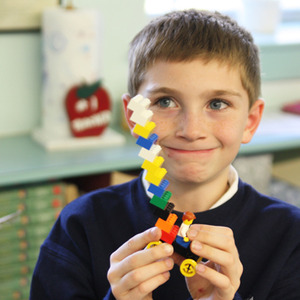 Forget about fancy facilities or a well-endowed budget. A successful STEM club needs only dedicated teachers, volunteers, and students.
Forget about fancy facilities or a well-endowed budget. A successful STEM club needs only dedicated teachers, volunteers, and students.
As a small, K-8 Catholic school in the northeast corner of Baltimore City, St. Francis of Assisi School began a STEM Club on a shoestring budget two years ago. Under the direction and encouragement of Dr. Sandy Young, a parent volunteer and materials engineer, the number of students participating in the Club has more than doubled since our first year.
As a middle school teacher and one of the coordinators of STEM at our school, here are a few highlights of things I’ve observed about our STEM Club:
- S: Students grow the most when they’re invited to discover how they learn best. It’s fun to see the students working together in a myriad of ways – generating ideas and solutions, taking on leadership roles within their groups, or simply encouraging one another to succeed. One student might garner enthusiasm from the littlest successes and discoveries, while another might enjoy more grandiose competitions. I’ve found this to be especially true of the Lego League competitions for the younger students in grades 1-3 (JrFLL) and the older students in grades 4-8 (FLL).
- T: Topics that are outside of the traditional curriculum can be examined in the STEM Club. For example, programming. Our older students have ventured into the world of programming through First Lego League Competitions and Robotics. It’s exciting to see how some of the students are naturals at programming their robots to complete certain tasks on a set field. They also quickly learn that not everything works successfully the first time, and they need to test and retest their ideas until the desired results are achieved. In this way, students that might not excel in the classroom get a chance to really shine and take on leadership roles in the context of the STEM Club.
- E: Excitement generated by the STEM Club spills over into the classroom. One of the tools we’ve used in our STEM Club is a 3D printer. A few of our students participated in a 3D printing workshop held here at the school, made possible in part by a grant from the Knott Foundation, and their excitement spilled over into the classroom where they considered all the possibilities of how 3D printers can used for various projects.
- M: More and more students will learn about career opportunities in STEM. National Chemistry Week is celebrated in our STEM program to make students more aware of the importance of chemistry in our everyday lives. National Engineers Week is also part of our after-school topics, making students aware of what engineers do and how they make a difference in our world. By building these national movements into our STEM Club, our students have participated in chemistry and engineering activities, such as building circuits, that have helped them realize what chemists and engineers do in real life.
Starting and running an after-school STEM Club requires a commitment of all those involved – teachers, parents, students, and our principal. Good ideas, planning, and flexibility are key ingredients for success, and there will never be enough time and energy to accomplish everything (especially at the end of a school day!). The rewards, however, are great. Our students are becoming great “inquirers” and “problem-solvers,” and they are experiencing the spirit and fun of learning, teamwork, self-motivation, and competition.
Mary Jo Broderick is a middle school science teacher at St. Francis of Assisi School, a K-8 Catholic school in northeast Baltimore.
By Kathleen McCarthy
02-18-2015
An engaging exploration of the origin of ideas and the notion of the lone genius
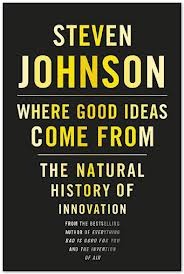 Eureka! Your flash of brilliance is actually a slow hunch built on a foundation of spare parts. Go ahead and insert a “wah waah” here. While we are primed to believe in the notion of a genius sitting alone in a room, a lab or on top of a mountain tinkering away until a fully formed brilliant idea flashes, Johnson contends that creativity and innovation do not happen when we (or systems) close ourselves off.
Eureka! Your flash of brilliance is actually a slow hunch built on a foundation of spare parts. Go ahead and insert a “wah waah” here. While we are primed to believe in the notion of a genius sitting alone in a room, a lab or on top of a mountain tinkering away until a fully formed brilliant idea flashes, Johnson contends that creativity and innovation do not happen when we (or systems) close ourselves off.
Scanning a landscape of over five centuries and the fields of biology, chemistry, technology and culture, Where Good Ideas Come From: The Natural History of Innovation is an exploration of how ideas are generated, why failure matters, and the benefits of diversity.
Johnson does a remarkable job of breaking down the myth of the lone genius without dampening the reality of human and environmental/biological ingenuity. With examples as varied as YouTube and neonatal incubators, Johnson demonstrates that we are indeed capable of generating great ideas; however, these ideas are constrained by the “adjacent possible.” That is, they cannot leapfrog the environment as it currently exists, and they need to enter into the “liquid network” – an environment that is open and allows connections to form in order to create change from the idea.
One of the most fascinating examples used to highlight his premise is Darwin’s “slow hunch” towards The Origin of Species. Darwin opened himself up to the physical and scientific world, collecting his observations without strictly categorizing them. In doing so, he was able to make connections between seemingly disparate environments, systems, and research that led him to his “aha” moment: creating a unifying foundation for the field of what is now called life science.
It is safe to say that Darwin would not have drafted his seminal work had he locked himself in a room or sailed on the Beagle alone. I would also venture it is safe to say that the world’s greatest challenges – poverty, economic disparity, education etc., many of which we in philanthropy dedicate ourselves to addressing – will not be solved if we silo ourselves off. Ideas need to mix things up in the “liquid network” and recognize the boundaries of the “adjacent possible” in order for them to move from the conceptual to the actual.
So, when that next great idea pops into your head, do not keep it to yourself. Go ahead and share it. Who knows, it could prove to be the missing element in creating one of the world’s greatest “aha” moments.
By Karen Smith and Laura Corbin Frazier
11-06-2014
A principal and university professor reflect on implementation, evaluation, expansion, and plans for the future
The following blog shares learning from a one-to-one iPad initiative from the perspective of the school principal and a university professor who engaged in a research study at the school. Together, they share the story of implementation, evaluation, expansion, and plans for the future.
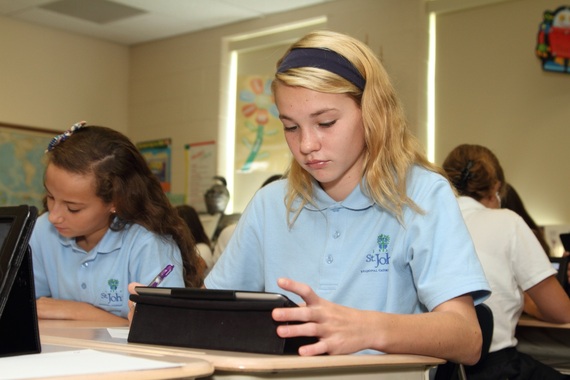 Implementation
Implementation
A one-to-one iPad initiative was begun at St. John Regional Catholic School (SJRCS) in the fall of 2011 with a generous grant award from the Knott Foundation. Principal, Karen Smith, conceived the idea for the initiative based upon her learning about a similar program at another school. Mrs. Smith knew her school community was ready for such an initiative and that she could rely on the expertise of an established technology team to help.
With a decision to proceed, the technology team sought grant funds to purchase iPads for use by all students in the 8th grade and the school installed reliable, wireless Internet. Integrated technology and learning goals were established for the initiative to include increased student engagement in learning and increased 21st century skills. Mrs. Smith emphasized the role of technology for her students’ future in college and career. The decision to use iPads over other mobile devices was based upon their affordability and portability. With a convenient, small size iPads were determined to be easier to manage in the school environment.
Next, policies and management were considered. It was determined that the iPads would remain at school for daily use and would not be provided for home use after school hours. Of critical concern was insurance for the iPads should they be damaged at school. Mrs. Smith was aware of some insurance plans that were available for iPads, but she decided to consult with the Archdiocese of Baltimore Department of Risk Management for their advice. As a result, families were offered an optional insurance plan that would enable an iPad to be replaced if it was lost or damaged on the school property. Parents who opted out of the insurance would be responsible for replacing the iPad on their own if anything happened to it.
Training teachers and generating enthusiasm for the initiative was important. Teacher professional development (PD) needs were identified and initial PD occurred prior to iPad deployment to students. Teachers were issued iPads to take home to begin exploring uses and familiarizing themselves with functionality. A weekly, after-school meeting provided teachers a forum for sharing best practices, new and useful applications, and troubleshooting. Additional off-campus PD opportunities were provided as well as in-house training by technology team members. Mrs. Smith noted that some teachers were nervous at first, but the after-school technology team meetings seemed to be very helpful in building confidence with use.
The iPad rollout was carefully planned. First, a mandatory parent meeting was held to explain the program to parents prior to the students receiving their iPads. Two different dates and times were offered so that parents were able to select the one that was most convenient for them. At the meeting, general expectations were explained; as well as, policies and procedures that were put into place. The Acceptable Use Policy for Computers was reviewed and the insurance program was also explained.
With a one-to-one computing program, more responsibility falls on the students. The school administration wanted to make sure that students understood the expectations for iPad use so a contract was developed that allowed for both parent and student signatures. Following the parent meeting, the iPads were ready for the rollout. The students were gathered in the school cafeteria for a general meeting about iPad use and expectations. Then, the students were broken up into smaller groups. The groups rotated among several different workshops that were called “boot camp.”
Since the students were not going to be allowed to take their iPads home, there needed to be a way for them to access the work they had started at school on their home computers. The school’s answer to that was the use of eBackpack and the Pages application. Learning about how to use eBackpack was one of the boot camp sessions. In another session, students explored the use of several different programs that allowed them to “personalize” their iPads. Students morphed their faces and added color to their photos. These photos would become the identifier for their iPad. In a third session, students were exposed to a variety of the applications they would be using in their classes. These apps had been pre-selected by teachers for each of their respective subject areas.
Expansion
The initiative was expanded in subsequent years through the fundraising support of the school community. In its second year, the initiative expanded to include purchase of iPads for all students in the 7th grade. A fundraising effort known as the Race for Technology supported this purchase. With school support, students seek sponsors for their run/walk. These fundraising efforts continue and have been used to increase the number of iPads the school has on hand for student use.
Plans for these funds included extending iPads to the 6th grade. However, after some time had passed, it became apparent that perhaps sixth grade students would not be able to handle the additional responsibility of carrying an iPad all day. Therefore, it was decided that iPad carts would be purchased instead. Teachers in 5th and 6th grade have the ability of using the iPads with students without expecting students to be responsible for carrying the iPads around all day and the primary grades have a cart to share as well. The more proficient teachers become in implementing iPads in the classroom, the more they want to have them available for their use. Mrs. Smith has since integrated questions about one-to-one computing into her interview protocol for new hires to help sustain the vision and pedagogical innovations brought by the iPad initiative.
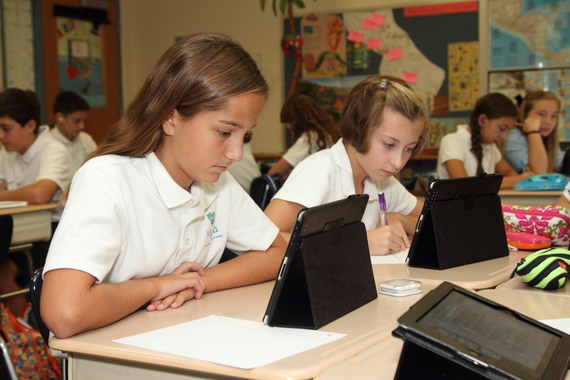 Evaluation
Evaluation
In the three years of the initiative Mrs. Smith has not observed any noticeable differences between the reliability of the iPads and existing desktop computers available in the computer lab. She has noted a cost savings as a result of reduced paper usage and in purchasing e-textbooks. Mrs. Smith also noted classroom efficiencies in materials distribution as fewer papers were being handed out during class time. Members of the technology team periodically obtain student views on the initiative through surveys and anecdotal conversations.
In the fall of 2013, led by faculty researcher, Dr. Laura Corbin Frazier, a qualitative research study was conducted at the school using focus group interviews with students, teachers, and parents. The research sought to understand how teacher technology decision-making may have been impacted by the initiative and to identify the perspectives of teachers, students, and parents on the role of the iPad in enhancing student learning.
Data were collected twice during the academic year and were analyzed for themes. Data provide evidence to support increased student engagement in learning and increased 21st Century skills, both goals established by SJRCS for the initiative. Regarding the research questions, data illustrate mixed views on the impact of the initiative to teacher technology decision-making. During the study period, the use of the iPads for instructional purposes was reported to increase as was teacher confidence with use. Data also provide evidence that the use of the iPad enhances student learning in several ways, but also highlights technical and policy issues that need to be considered as the initiative sustains.
Most respondents held favorable views on the use of the iPads indicating use to be motivational, engaging, and fun. Affordances of iPads to increase access to resources and to provide efficiencies in organization were also noted. Communication was enhanced through the use of Edmodo, an application available on iPads and through web access. Personalization features of the iPads were also helpful as students described their ability to customize their device, increasing font sizes and changing background colors. Use of eBackpack (an online, course management platform for students) was valued in supporting organization. Several students identified benefits of iPad use in increasing their technological skills. Skills they believed would prepare them for the future.
Teacher use of iPads varied from classroom to classroom. Typical instructional uses included use for presentations, research, worksheet completion, taking notes, reading maps, tests/quizzes, and videos. Several applications were used including: iMovie, Educreations, QR codes, Internet, Animoto, techbook, Google, games, calculator, graphs, and word processing apps. Ipads were used in various settings including individual, group, and pair work, with individual student uses most prevalent. Views on whether the use of the iPad changed the content of student learning or merely the tools that were used to support learning varied within each respondent group.
Concerns were raised over the use policy that prohibited students from touching the iPad of another student. Students questioned whether this policy reduced the amount of collaborative work they could engage in. Teacher and student comments on behavior management described positive changes including greater focus on learning tasks and quieter classrooms. Students did note that sometimes the iPads can be a temptation and it is hard to wait until the appropriate time to open applications of interest.
The most significant hindrance to the iPad initiative was server issues (i.e., slow speeds, uploading delays, glitches). A concern was also raised over the transition to high school and whether students would be at an advantage or disadvantage having engaged in the iPad initiative. Research findings in many cases confirmed anecdotal views on the successes of the iPad initiative, and also identified concern areas that were and were not known by school administration.
Plans for the Future
SJRCS believes the iPad initiative has been well received by students, teachers, and parents and research findings affirm this belief. Anecdotally, recent graduates who have attended high school where iPads were not being used report that they wish they still had them to use during their classes. While, initially, it does take some time, effort, and training to get the program up and running, once students become proficient with iPad use, they begin to recognize its value as a learning tool. Yet, research findings highlight some concerns regarding the role of iPads in supporting high school readiness. In consideration of research findings authors suggest a follow-up study, perhaps a survey to recent graduates assessing their views on the role of the iPad initiative in preparing them for high school and in identifying their continued use of iPads or similar tools to support their learning in high school.
Many of the decisions that were made before the iPad program started have proven to be beneficial for the school. For example, not allowing students to take the iPads home. Due to the age of the students and the added responsibility of caring for an iPad, students are currently not allowed to “share” iPads. Though research findings suggested some student concern over this policy, SJRCS administration feels that the policy has supported that decision. Limiting the sharing of iPads among students has definitely reduced the possibility of one student damaging an iPad assigned to someone else. The school administration had to take into consideration that they were dealing with thirteen year olds who sometimes act impulsively and without thinking beyond their immediate actions. Further, teachers have found ways for students to work cooperatively while using their own iPads. SJRCS teachers and administrators continue to attend workshops focused on the successful implementation of iPads in the classroom. Like everything else involving technology, continuous professional development is essential to make implementation successful.
Teachers have also found that even our youngest students in Pre-K enjoy using the iPads. They have been able to find several apps that allow students in the primary and elementary grades to access the iPads too. Fundraising has allowed the purchase of additional iPad carts to meet these demands. When more iPads were added, however, the need to increase bandwidth for Internet use was noted and later confirmed by research findings. Currently, SJRCS is at capacity and is in the process of identifying alternate means of providing faster wireless Internet access throughout the school.
SJRCS school administrators are pleased with the overall effects of the iPad initiative. It keeps their Mission at the forefront of what they do at school each day: “to develop future leadership for the 21st century through academic excellence…” This initiative has put a device in the hands of every 7th and 8th grade student. Some of whom might not have had that opportunity. It has also allowed students to realize first-hand the power of technology and has brought them closer to being college and career ready for a future that is ever changing in the realm of technology.
Karen Smith, M.Ed, is principal at St. John Regional Catholic School.
Laura Corbin Frazier, Ed.D., is an assistant professor in the department of Education at Mount St. Mary’s University.
By Kelly Medinger
11-03-2014
Boys Hope Girls Hope of Baltimore uses education grant to inspire, empower, and nurture scholars to succeed in school and in life
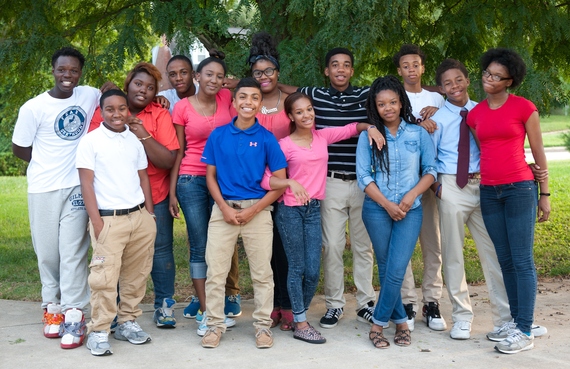 Living up to the organization’s tag line to “inspire, empower, nurture, succeed,” Boys Hope Girls Hope was founded by a Jesuit priest in 1977 to help academically capable and motivated children-in-need meet their full potential by providing them with an excellent education and a nurturing home. The Knott Foundation has supported their work since Boys Hope Girls Hope came to Baltimore in 2002, most recently with a grant to help pay educational expenses for their 16 scholars, including books, uniforms, field trips, and transportation.
Living up to the organization’s tag line to “inspire, empower, nurture, succeed,” Boys Hope Girls Hope was founded by a Jesuit priest in 1977 to help academically capable and motivated children-in-need meet their full potential by providing them with an excellent education and a nurturing home. The Knott Foundation has supported their work since Boys Hope Girls Hope came to Baltimore in 2002, most recently with a grant to help pay educational expenses for their 16 scholars, including books, uniforms, field trips, and transportation.
Inspire
Scholars are referred to Boys Hope Girls Hope (BHGH) by teachers, guidance counselors, and social service agencies who see both potential in a child and barriers to their success, such as economic hardship, domestic abuse, or poor supervision. After extensive psycho-educational evaluations, several visits to the BHGH homes, and in close partnership with the child’s parents, the student moves in.
This year, two new scholars joined BHGH. With the encouragement of her middle school guidance counselor, Brianna, now a freshman at Cristo Rey Jesuit High School, lobbied her family to allow her to join the program. While she admits it was hard to leave her mom, grandmother and sister, after just four months at BHGH Brianna already feels at home: “I see Boys Hope Girls Hope as a second family. The other girls in the house are my big sisters.”
Empower
Once a new scholar moves in, BHGH staff helps identify a private college-preparatory school in the Baltimore area that best fits the scholar’s academic needs and interests. Outside of school, scholars are encouraged to expand their horizons through service, job opportunities, sports, travel, and music.
“The community service we do comes from our foundation of faith,” says Jennifer Meyerhoff, Development Director. Scholars volunteer at local nonprofits including Beans & Bread and First Fruits Farm, and they work at places like Downtown Sailing Center and WYPR. In addition, they take part in many extra-curricular activities. Joshua, a freshman at Gilman School, plays four instruments and also plays lacrosse with a program called Next One Up.
Nurture
A typical day at BHGH begins with a 6:00 wake-up call. All the scholars leave for school at 6:45. Dinner is at 6:30, followed by two hours of required study time. Lights are out by 9:30 for middle schoolers and 10:30 for high schoolers.
While their days are highly structured, building scholars of character and compassion also comes from nurturing one another. As the oldest of five children, Noe, a junior at Calvert Hall College High School, grew up caring for his younger siblings. “Noe is now a leader among the boys in the house and takes his role as the oldest male scholar very seriously,” says Meyerhoff.
Succeed
Scholars from BHGH go on to achieve great things in life. Dwayne, a junior at Loyola University Maryland, recently became BHGH’s first scholar to study abroad. Another scholar, David, recently graduated from Morgan State University with a Master’s Degree in Social Work and is working full-time. A current scholar, Cierra, is a senior at the Institute of Notre Dame with hopes of studying engineering in college. She sums up the program like this: “Boys Hope Girls Hope is like co-parenting. It is truly a partnership between the program, the parent, and the scholar.”
Photo Credit: Stevie T. Photography
By Kelly Medinger
10-30-2014
Fire Museum of Maryland uses arts and humanities grant to put a spotlight on technology, democracy, and heroism
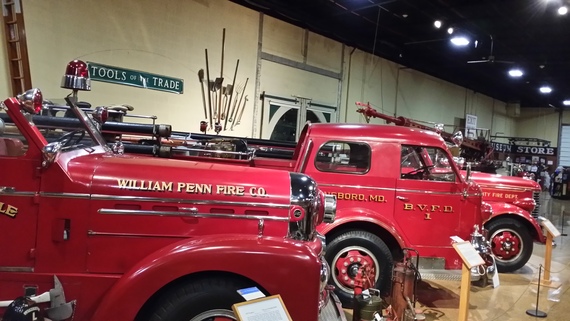 Standing in front of the new Fire Alarm Office at the Fire Museum of Maryland, a group of school children chant, “911, fire! 911, fire!” They clearly know who to call and what to say when they see a fire.
Standing in front of the new Fire Alarm Office at the Fire Museum of Maryland, a group of school children chant, “911, fire! 911, fire!” They clearly know who to call and what to say when they see a fire.
A Story about Saving Lives
Founded in 1971, the Fire Museum appears to be one of Baltimore’s best kept secrets. It is one of the largest fire museums in the country and holds some of the oldest pieces of fire equipment. “Together our 41 pieces tell the story of American urban firefighting,” shares Steve Heaver, Director and Curator of the Museum. “It is the story of how people help people. How they save their lives.”
Each year more than 12,000 people come to the Fire Museum to tour its collection, conduct research in its archives, participate in a special event, or even celebrate a birthday party. The Museum relies on a team of approximately 25 people, half of them volunteers, to keep things running smoothly.
Even with a small budget and a small staff, Heaver has a big vision: double the number of visitors to the Fire Museum to 25,000. He estimates that they can achieve this goal without increasing staffing or overhead, simply by taking advantage of economies of scale. “It’s not beyond the realm of possibility,” he says with a smile.
A Path of Technological Innovation
Walking through the museum is like taking a step into the history of fighting fire. Visitors follow a path of technological innovation from the earliest years of hand drawn firefighting (1654 – Civil War), through the horse drawn period (1852 – World War I), and then finally the motorized era (1906 – present). Each piece of the collection is cared for and restored by the staff and speaks to the ingenuity of humankind. Many pieces in the collection are even from our own backyard – Baltimore City, Boonsboro, Ellicott City, and the Violetville neighborhood, to name a few.
The Knott Foundation recently helped the Fire Museum renovate lighting for its exhibit space. With this grant and gifts from multiple other donors, the Museum replaced all of its 1971 fluorescent lamp fixtures and installed new LED lights as well as some track spot lights. “The new lights not only save energy and keep the artifacts from fading, they are much more visually pleasing,” Heaver comments.
By telling the story of American urban firefighting, the Fire Museum manages to be so much more than a museum: It becomes a lesson in democracy and making decisions. It serves as an example of technology improving peoples’ lives. And it ultimately stands as a witness to heroism.
By Kelly Medinger
10-27-2014
Announcing our most recent grant recipients in Catholic activities, education, health care, and human services
We are pleased to announce that 15 organizations received over $700,000 in our October 2014 grant cycle.
Catholic Activities
- Jesuit Volunteer Corps: $20,000 grant to support the recruitment, training and on-going work of five Baltimore-based Jesuit Volunteers committed to serving the poor and marginalized
Education
- Catholic High School of Baltimore: $100,000 grant to support the school’s first capital campaign and the McCafferty Visual & Performing Arts Program by renovating the auditorium’s production booth
- Code in the Schools: $20,000 grant to support operating costs for this out-of-school time program’s work teaching computer coding to underserved and under-represented youth in Baltimore City
- Notre Dame of Maryland University: $80,000 grant to support the Academy of Catholic School Educators (ACES) program and the creation of a model 21st century classroom and technology center for the professional development of K-12 Catholic school educators in the Archdiocese of Baltimore
Health Care
- Hospice of the Chesapeake: $45,000 grant to support the expansion of the Chesapeake Kids Perinatal Pediatric Palliative Program providing a continuum of care for families and children diagnosed with a life-limiting illness
Human Services
- Baltimore Child Abuse Center: $50,000 grant to support the expansion of the Family Advocacy Program and an additional Family Advocate who will serve child witnesses to violence in Baltimore City
- Catholic Charities: $50,000 grant to support the work of the Community Cares Outreach Worker in Western Maryland who connects households in crisis with resources in Allegany and Garrett counties
- Franciscan Center: $41,205 grant to support the work of the Volunteer and In-kind Coordinator at this comprehensive direct service outreach agency serving all zip codes in Baltimore City
- Govans Ecumenical Development Corporation: $35,000 grant to support operating costs for this housing and supportive service organization’s Community Services/CARES programs, which help move individuals from crisis to stability
- Light House Shelter: $20,000 grant to support advanced culinary job training and field catering experience for individuals in Anne Arundel County who are homeless or at risk of homelessness
- Marian House: $95,000 grant to support capital upgrades to the organization’s headquarters, which provides transitional, supportive housing for homeless women and children
- Maryland Center for Veterans Education & Training: $57,705 grant to support the Homeless Veterans Emergency Services Program by improving classroom instruction for homeless veterans and enhancing the organization’s marketing and outreach efforts
- Pathfinders for Autism: $48,533 grant to expand the organization’s Community Safety Program, which trains first responders to more effectively interact with individuals who have autism spectrum disorders
- St. Mary’s Outreach Center: $35,000 grant to support operating costs for the Center, which improves the quality of life for older adults living in poverty in the greater Hampden community
- YMCA of Cumberland: $62,311 grant to support capital upgrades to the Y’s Gilchrist Center, which provides housing for low-income, homeless, and disabled persons in Allegany county
For a complete listing of our grant awards, please visit our past awards database.
By Kelly Medinger
10-02-2014
Maintaining the Catholic identity of schools during transitions to lay leadership
 Then I will give you shepherds after my own heart, who will lead you with knowledge and understanding.
Then I will give you shepherds after my own heart, who will lead you with knowledge and understanding.
~ Jeremiah 3:15
From the first disciples to the present, centuries of men and women have been called to be leaders and teachers of the faith. And while that promise is still being kept today, the face of our shepherds in the Catholic Church is changing – a phenomenon perhaps most apparent in the Catholic schools. No longer are there enough sisters, brothers and priests to lead the schools, so lay men and women are increasingly being sought to fill the positions that religious leaders held in the past.
Background
The halcyon days of religious leadership in schools were in the 1950s and 1960s. “In the 1960s, we had about a 75/25 ratio of religious to lay faculty and staff in the schools. That has declined about 10% every decade since,” shares Sr. Dale McDonald, PBVM, Ph.D., Director of Public Policy and Educational Research at the National Catholic Educational Association. By about 1990, there were just 15% religious in the schools; by 2000 it was down to 7%, and now it is only 3%. “The trend is pretty well established, that the religious are gone from the schools,” Sr. Dale says.
In the Archdiocese of Baltimore in 1998, there were 98 Catholic schools serving 36,000 students. About 170 religious worked at those schools full-time, including 128 sisters and 41 brothers. Fifteen years later, there were only 40 religious at the remaining 70 schools serving 28,000 students. In the future, “there will probably be some religious at the schools, but looking at the demographic data, we expect that there will be less than 2% in 10 years,” proclaims Sr. Dale.
A combination of factors has led to this decline. Two often cited reasons are the reduction in vocations and the aging of existing religious sisters, brothers and priests. Another factor, however, is rooted in how the congregations realize their mission in the community. “Many congregations faced with a declining population have been forced to look back to why they were founded,” Sr. Dale recounts. For many, their mission was “to meet needs that couldn’t be met, and often the schools were established at a point when education for Catholics was really limited.” Consequently, in cases where schools have been able to maintain themselves through solid academics and strong faith formation, religious congregations have made the decision to entrust them to lay leadership, which in turn allows the religious to concentrate their time on other unmet needs in the community.
For the schools, this decline means there is a great need for new shepherds to provide leadership in promoting academic excellence, faith formation and administrative management. Of particular note is the faith formation piece, which is closely tied to the Catholic identity of the schools. “The perception used to be that because [the school’s leadership] was a religious priest or a brother or a nun, that it was Catholic, without being intentionally so. As more and more lay people have assumed their roles, there has been more of a focus on the intentionality,” states Sr. Dale.
So, in this transition from religious to lay leadership, how has the Catholic identity of schools been impacted? And how are they reflecting the value system of the faith that so distinguishes Catholic education and ultimately makes Catholic schools a preeminent choice for families and students?
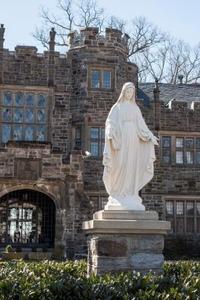 Maryvale Preparatory School
Maryvale Preparatory School
In 2012 Tracey Ford became the first lay President of Maryvale Preparatory School, succeeding Sr. Shawn Marie Maguire, SND, who had served as President for 31 years. “It was very humbling to be chosen,” relays Ford, who describes herself as “a hometown girl who came up through the ranks.” She attended St. Joseph’s School in Cockeysville, where her mother was the first lay incorporator for the Church, and later graduated from Notre Dame Preparatory School. During the 19 professional years she spent in Catholic institutions before coming to Maryvale, Ford recalls “being guided by multiple generations of the Knott family, from Mr. Knott Sr. to John Smyth,” in learning about fundraising and how best to advance the mission of Catholic education.
In her role, Ford has taken a conscious and sincere approach to the Catholic identity of Maryvale, touching on numerous facets of the School, from board and administrative leadership, to physical features of the campus, to the history of the founding order.
She began by meeting with the Sisters of Notre Dame de Namur provincial from Ohio to understand, emulate, and learn from their exemplary leaders. Notably, in her first year as President Ford increased the number of SNDs represented on Maryvale’s board.
In addition, Ford has taken to inculcating a spirit of faith into the everyday lives of her students. For example, she moved St. Julie Billiart’s portrait into the main foyer. And she opened the doors of the chapel to the Great Hall, exposing the girls to the presence and symbols of Christ in their everyday walk through the main building. “We recalled the Bible’s passage ‘let them make a joyful noise’ and thought the sound of the girls traveling the halls between classes would be a joyful noise to the Lord,” Ford shares. “Now that we have permanently opened the doors to the Chapel, people are wondering why we didn’t think of it earlier!”
Ford describes managing the Catholic identity of the School as “having one foot in each of two camps – tradition and reflection,” meaning that one must follow tradition but also interpret it so that it is real and relevant for girls today. At the opening Mass where she was formally installed as President, she chose a reading about “the valiant woman.” Also at the Mass, the youngest member of the sixth grade whose mother and grandmother graduated from Maryvale presented three roses in devotion to the Blessed Mother, representing the three generations of women.
Yet Catholic identity is much deeper than all of these things. Ford proclaims, “How to sustain our mission of access for students across a broad cross-section of the community is the biggest challenge a lay leader faces in a Catholic school today.” In effect, this is where Catholic identity merges with the administrative leadership of the School, in that there must be a working business model for how to serve the population that the Church and respective religious order desire to serve. “It is far easier to maintain Catholic identity. What keeps me up at night is the business model,” she admits.
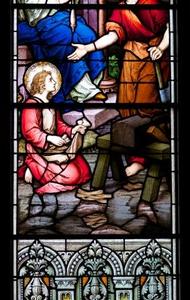 Mount Saint Joseph High School
Mount Saint Joseph High School
Since its founding in 1876, Mount Saint Joseph High School has maintained a history of creating life-long relationships with its students and guiding them in the Xaverian values of simplicity, humility and service. Therefore, when Br. James Kelly, CFX called upon George Andrews, Jr. to return to his roots in Xaverian education at Mount Saint Joseph’s, Andrews responded to the call. As the new President of Mount Saint Joe’s (MSJ), he succeeded Br. Jim who passed away in December 2011.
Andrews graduated from St. Mary’s Ryken High School in Southern Maryland, a Xaverian Brothers’ school much like Mount St. Joe’s (MSJ). He arrived at MSJ for the first time in 1987, serving 11 years as both a teacher and the Director of Formation, a position created by the Brothers to focus on the professional development of faculty as well as the faith formation of students, faculty and staff. Then, after serving as the first lay principal of York Catholic in Pennsylvania for 14 years, he returned to MSJ.
“I am a product of Xaverian education and am very comfortable communicating my faith,” he continues. Notably, the Xaverian Brothers were at the forefront of the faith formation of lay leaders, in part because they knew they would not always be able to staff their schools at such a high level. “They saw what the future held and knew that being mindful and deliberate in our approach to faith leadership would be increasingly important,” Andrews observes. This is one reason the brothers created the staff position of Director of Formation, which continues today and oversees all retreat programs, the campus ministry office, faculty and staff development, and other faith activities.
“Without the everyday presence of the brothers, it is doubly-important as non-brothers to live and practice our faith and charism and share it with students, parents, faculty, staff, and alumni,” he proclaims. He cites MSJ’s robust retreat programming and commitment to Christian service as exemplary models of integrating faith into the life of the school. Retreats are often multi-day experiences and call the students to grow in their faith and reflect on the School’s goal to “create men that matter.”
“The Catholic faith is very vibrant here,” Andrews concludes. And he is very committed to keeping it that way. “All of us have to be role models for the students – passionate for Xaverian education and ever-concerned with the full development of our students,” Andrews says.
 St. Thomas Aquinas School
St. Thomas Aquinas School
Sr. Marie Rose Gustatus, SSND, led St. Thomas Aquinas School in Hampden for more than 30 years, until 2012 when Mr. Gary Rand was appointed as the new Principal.
While attending the Catholic University of America, Rand began a teaching practicum in the Archdiocese of Washington, and he has been in Catholic education ever since. Now a resident of Frederick and a father to two young children, his career has taken him to multiple schools in both Washington and Baltimore, including serving as the Dean of Students at St. John’s Catholic Prep as well as the Principal of St. Clement Mary Hofbauer School in Rosedale.
“What has inspired me to remain in Catholic education is the opportunity to put my own faith into action,” Rand says. Each day the students, faculty and staff at St. Thomas Aquinas come together in the cafeteria, and Rand leads the school in prayer and song. Meanwhile, students use lessons they learn from Church and incorporate them into their academic day. For example, eight graders were asked to take a leadership role in the first school-wide Mass of the year, which they in turn incorporated into a lesson about leadership in the classroom.
“My job is to continue to focus on how faith can drive our education and really put our whole school in the position to be successful for the future,” adds Rand. He describes his commitment to Catholic education as one that includes both passion for academic excellence as well as faith formation. “Academic excellence comes first and foremost, but without Catholic identity, we are not doing the job of fully preparing our students for their lives,” he reasons.
In terms of leadership qualities, Rand cites working collaboratively with others as a key characteristic for lay leaders in Catholic education. In this way, he has worked to build a strong relationship between the parish and school community, as well as the broader community of parents, alumni, neighbors and friends.
Rand finishes by pointing to the fact that leadership can be something new, but it can also be continuing what works: “My specific goal is to recognize our past, focus on what has worked for our school, and then plan for our future.”
Conclusion
In the midst of all of this transition, it is apparent that the new lay leaders in Baltimore’s Catholic schools are approaching their roles with great energy and thoughtfulness. And that energy translates into promulgating the nurturing, faith-filled atmosphere that is a hallmark of Catholic education.
Sr. Dale explains, “A principal is the academic leader, business manager, and faith leader.” This means that an excellent principal needs to be good at all three things: curriculum development and teacher evaluation; administration; and faith formation. As such, new and emerging leaders are expected to be well-prepared in the academic and business aspects of their role, but they also must be comfortable serving as the faith leader of the school and ensuring that the Catholic identity of the institution remains strong, because ultimately, that is the fundamental difference between Catholic schools and other education options.
Today, the schools are looking for shepherds to become the new faces of Catholic education, leading with knowledge and understanding as the Bible proclaims. And, as witnessed at Maryvale, Mount St. Joe’s, and St. Thomas Aquinas, there is evidence that such shepherds are sent.
This article was adapted from a 2012 article Medinger wrote for the Knott Foundation’s family newsletter.
By Kelly Medinger
09-23-2014
A nonprofit’s guide for taking a successful “leap of reason” to sustained social impact
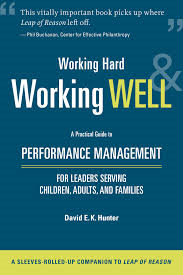 This summer I spent some time at the University of Notre Dame in Notre Dame, Indiana working on my master’s degree. In my nonprofit management class, entitled “Leading for Social Impact,” we discussed the unique demands, expectations, challenges and opportunities of managing to success in the nonprofit context.
This summer I spent some time at the University of Notre Dame in Notre Dame, Indiana working on my master’s degree. In my nonprofit management class, entitled “Leading for Social Impact,” we discussed the unique demands, expectations, challenges and opportunities of managing to success in the nonprofit context.
As part of my class, I read Working Hard and Working Well by David Hunter. Described as “a sleeves-rolled-up companion to Leap of Reason,” Hunter’s book picks up where author Mario Marino left off by sharing how leaders, managers, staff, funders, and consultants can better understand and implement a performance management culture.
Some of you may remember my colleague Kathleen McCarthy’s review of Mario Marino’s Leap of Reason a couple years ago. His book is a call to action for nonprofits to make smarter decisions based on measurable outcomes. The premise is that many nonprofits don’t know whether they’re actually delivering on their promises. So instead of taking a “leap of faith” to achieve our mission, we should make a “leap of reason.”
Hunter follows Marino with the “how to” guide for making a successful leap. He says it’s all about becoming an organization that manages to performance. Performance management has struggled to take hold in the social sector, perhaps because of the top-down, command-and-control approach many managers take to making improvements. Hunter dubs this form of performance management “compliance management,” saying it’s better for driving activities, not results.
To articulate the recommended approach, Hunter outlines three pillars of performance management: performance leadership; management systems; and information and knowledge production. Related to the first pillar, an important distinction in Working Hard, Working Well is the difference between an operational leader and an operational manager. Operational leaders continually challenge the status quo, inspire others, and drive their concerns downward. Operational managers, on the other hand, align with the vision and priorities articulated by the leader, deploy resources to sustain excellence, and channel the leader’s concerns into productive work and high standards.
Reading this book, I learned that performance management is the relentless pursuit of “making it better.” Yet moving to this culture of continuous improvement is not an easy road. It means shifting perspectives: from data as a burden, to data as a useful tool; from functional program silos, to cross-functional teams; from fear of breaking rules and patterns to support for making mistakes and trying new strategies.
The point is that the world is (and probably will always be) messy and complicated. On top of that, social change is and will continue to be even messier and more complicated. But there are tools we can all use to respond and be ready – strategic clarity and measurable outcomes being among them. With these tools in hand and Hunter’s road map for performance management, we can all hold hands and take a “leap of reason” toward greater impact by working hard and working well.
By Rebecca Malone
09-03-2014
Lessons learned from starting an after-school STEM club at a small Catholic school
This is the second in a multi-part series about how St. Francis of Assisi School, a small K-8 neighborhood Catholic school in Baltimore City, started an after-school STEM Club on a shoestring budget.
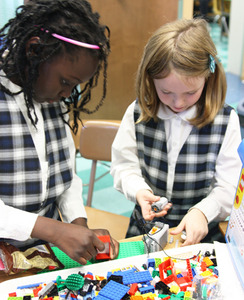 A common misperception about STEM (Science, Technology, Engineering, and Math) is that only schools with elaborate science labs and large budgets are suitable sites for STEM. The reality is that there are many projects and activities that can be implemented successfully in a school with limited space and limited resources. The crucial ingredients are commitment and imagination.
A common misperception about STEM (Science, Technology, Engineering, and Math) is that only schools with elaborate science labs and large budgets are suitable sites for STEM. The reality is that there are many projects and activities that can be implemented successfully in a school with limited space and limited resources. The crucial ingredients are commitment and imagination.
We are a small Catholic elementary school located at the northeastern edge of Baltimore City. Our mission is rooted in the example of St. Francis, who promoted the virtues of a selfless life dedicated to serving the world around him. Drawing on the spirit of our patron saint, we form children for a life of scholarship, spirituality, and service.
Two years ago, Dr. Sandra Young, a parent volunteer and STEM educator by profession, stepped forward to create an after-school STEM Club here at St. Francis. To our delight, 60 of our students signed up for the after-school club. Dr. Young and her team of helpers organized activities, sought grants, promoted attendance at weekend competitions, and managed the lively Thursday afternoon gatherings.
Our students have built robots, learned computer programming, tested chemicals, experimented with “snap circuits,” designed models, and more. This year, they will explore the world of 3-D printing, which was made possible by support from the Knott Foundation.
STEM seamlessly integrates pedagogical best practices in a way that traditional education can’t always accomplish. For example:
- “Total Participation/Hands-on Engagement.” All students are actively involved at all times. There is no opportunity to be passive recipients of information. Students learn by doing.
- Cooperative Learning: If you have ever watched a reality competition such as Project Runway, you know that being able to collaborate successfully with others is considered essential for today’s workplaces. Some cooperative learning activities in classrooms can seem artificial or contrived. Not so with STEM. The collaboration is real, and it is ingrained in the STEM experience. Students learn to negotiate and to understand different perspectives. They learn to communicate clearly because that is how teams accomplish things together.
- Craftsmanship and attention to detail: Precision matters in science and design. When a measurement for a bridge span is a few millimeters off, or a circuit is connected the wrong way, the whole project is weakened. Students don’t learn this by being told to be precise. They learn it through action.
Education is most successful when students are so curious and actively engaged that they move into a “flow” state, oblivious to the passage of time and eager to continue learning. As a principal, I am delighted to observe the energy and interest of a STEM Club session.
How can a small school make STEM happen on a shoestring? Here is what I have learned:
- Begin with what you have. Don’t wait for the perfect time or the perfect setting. Our school has no science lab and very little storage space ... but we are across the street from a beautiful wooded park. The kids love to get outside and mess around with dirt and plants and rocks. Our classrooms are small, but it is amazing how much good work can happen on a desktop or in a circle on the floor. Given the choice between a shelf full of construction materials or a shelf full of aging grammar textbooks, the decision is a clear one.
- Connect with community resources. Do you have a university nearby that would allow a visit to their engineering labs? Is there a community group that does stream clean-ups or wastewater monitoring? Do you have parents who work as engineers, as plumbers, as artists, as pharmacists, as computer programmers? Let them come show students how they use science, technology, engineering and math in their daily work.
- Make it fun and engaging for the adult volunteers too. I love bringing a visitor into a room where STEM activities are happening. They watch intently and often whisper to me something along the lines of “This is so cool!” Adults who are innately engaged by the activities, but who know how to step back and let the kids take the lead, end up finding STEM club to be a creative break from their regular routine.
- Go where the energy is. Seek grants, make wish lists, and allow your supportive community to step in and help you make STEM a priority. When committed educators say they really want to bring something special to their students, there are friends of the school who enjoy helping out. PTAs, neighborhood groups, grandparents -- all are looking for ways to show their support for your students. So don’t be shy -- show them something really cool that they can be a part of!
- Tell your story and celebrate the adventure. We love to post photos and videos on Facebook and Twitter. It is completely free, takes only a moment, and lets the community know, simply and quickly, about the great work that our kids are doing.
We are fortunate to have Dr. Young spearheading our STEM initiative. I would bet that in every community, there is someone -- be it a teacher, a parent, a neighbor -- who thinks STEM activities are just about the coolest thing there is. Find that person, befriend them, and give them your support in whatever way you can. You won’t be disappointed.
Rebecca Malone is the principal of St. Francis of Assisi School, a K-8 Catholic school in northeast Baltimore. She holds a bachelor’s degree in Religion and English from Harvard University and a master’s degree in English Education from Columbia University. She has served as the principal of St. Francis since 2010.
By Kelly Medinger
08-26-2014
Mt. Washington Pediatric Hospital uses health care grant to “grow their own” pediatric specialty nursing workforce
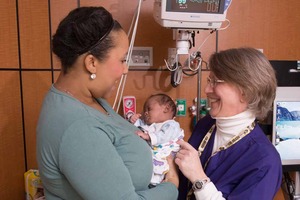 Caring and nursing are synonymous in our society. Yet to be caring specialists for patients, nurses need a support system of their own. That is how the Grow Your Own program at Mt. Washington Pediatric Hospital in Baltimore got its start.
Caring and nursing are synonymous in our society. Yet to be caring specialists for patients, nurses need a support system of their own. That is how the Grow Your Own program at Mt. Washington Pediatric Hospital in Baltimore got its start.
What is Grow Your Own?
Grow Your Own (GYO) is a pediatric nursing professional development program that includes a year-long residency for new nursing graduates or those new to pediatrics. It includes an orientation curriculum with classes like “Flu and Electrolytes” that utilize case studies and a simulation lab to foster problem solving, critical thinking, and technical skills. Interdisciplinary team building is another component of the program. Once a month, a “Mock Code” takes place in the simulation lab to improve communication between healthcare team members. Finally, GYO supports ongoing professional development for nurses at all levels by providing accredited continuing education courses and preparation for pediatric specialty certification.
“Change is constant in health care,” remarks Sharon Meadows, MS, RN-BC, Director of Education & Professional Development. “There is always new knowledge and new evidence out there to be integrated into practice.” Add to that the hyper-specialized nature of pediatric transitional care, and the need to “grow your own” team of highly-trained nurses becomes even more important.
About Mt. Washington Pediatric Hospital
Founded in 1922, Mt. Washington Pediatric Hospital was one of the first healthcare institutions in the United States devoted solely to the care of children. In their early years, they saw children suffering from rheumatic fever, polio, and influenza. Today, they serve 7,500 children each year for conditions such as feeding disorders, congenital challenges, diabetes, and more.
In many ways, Mt. Washington Pediatric Hospital is the bridge between a child’s stay in a more medically-intensive environment, like the ICU, and the child’s home. This transitional care environment means that the hospital’s medical staff work closely with parents to make sure each child’s healing continues well beyond the hospital stay.
From Pilot to Permanent
Since beginning as a pilot in 2009, the GYO program has exhibited impressive results in helping the more than 100 nurses at Mt. Washington Pediatric Hospital learn and grow.
During the year the Knott Foundation supported GYO, the 12-month retention rate for new nurses was 100%, compared to just 50% prior to GYO’s founding. Meanwhile, 10 nurses received their specialty certification. These positive results have persisted. The hospital now boasts nursing retention of 100% at 6 months, 95% at 12 months, and 83% at 18 months. Also, the number of certified nurses has grown to reach 30% of their nursing workforce.
With a track record of consistent, positive results, the GYO program has gone from being a pilot program supported by grant funding to being a permanent program sustained by the hospital’s budget. “Grant funding allowed us to build the program and demonstrate success for a few years. We couldn’t have done what we did without grant support,” Meadows recalls.
Reflecting on the GYO program’s impact, Meadows says: “The whole Grow Your Own program has really increased the level of expertise in our hospital and helped us retain our new nurses. This helps improve the quality of care and safety of our patient population – which is really what we aim to do in the education department. We help our staff be experts at what they do.”
By Carol Hoffman
08-04-2014
Understanding how introverts interact with and contribute to our workplaces and communities
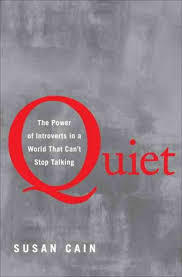 I recently read Quiet: The Power of Introverts in a World That Can’t Stop Talking by Susan Cain.
I recently read Quiet: The Power of Introverts in a World That Can’t Stop Talking by Susan Cain.
Cain defines introverts as those who “have a preference for a quiet, more minimally stimulating environment,” conditions that are often undervalued and hard to find in the loud world in which we live.
According to Quiet, at least one-third of the people we know or are associated with are introverts. These people might prefer listening to others rather than speaking, staying home with a good book, or watching a television show rather than going out to a party and socializing with friends. In other words, they recharge by “going quiet.” As a result, these individuals are often stereotyped as being shy, socially awkward and ill equipped for leadership roles. Cain encourages us to take a step back from the stereotypes and consider the power of different styles in affecting change, innovating new ideas and leading organizations.
In her book, Cain emphasizes how our culture often misunderstands the traits and capabilities of introverted people in communication, the workplace, school and at home. She points out that we owe many of society’s great contributions to introverts, and that great leadership can come from either introverts or extroverts. For example, in her research Cain found that introverts excel at leading proactive employees because they have a tendency to be better listeners and consequently let good employees run with their ideas. Extroverts, on the other hand, are often better at leading more passive employees because extroverts have a knack for motivating and inspiring others.
Quiet does not support one way of being over another. It sees the value in both traits and encourages the reader to do the same. It is quite possible that the quiet, shy, unassuming person sharing an office space with you, sitting across from you at the dinner table, or staring at you in the mirror, may just be the next Einstein, Rosa Parks or Warren Buffet -- all introverts.
In closing, whether you are an introvert or an extrovert, when reading this book you will benefit from the insights and the power to permanently change how we see introverts and, equally important, how introverts see themselves.
By Kelly Medinger
06-26-2014
Announcing our most recent grant recipients in education and Catholic activities
We are pleased to announce that 12 organizations received over $700,000 in our June 2014 grant cycle.
Education
- Boys & Girls Clubs of Metro Baltimore: $35,000 grant to support the Be Great Summer Club Program at five sites in Baltimore City
- Immaculate Heart of Mary School: $45,000 grant to support the expansion of technology at this pre-K-8 Catholic school, including tablets for 8th grade students
- Maryland School for the Blind: $52,035 grant to support assistive technology and learning resources for students with multiple disabilities
- Mount de Sales Academy: $50,000 grant to support the technology integration program at this Catholic high school for girls, including outfitting classrooms with projectors, upgrading wireless capabilities, and purchasing a mobile laptop cart
- Mount Saint Joseph High School: $120,000 grant to support a campus-wide technology upgrade at this Catholic high school for boys, including replacement of their existing 1GB fiber connections between buildings
- Notre Dame Prep School: $80,623 grant to support the construction of a Science-Technology-Engineering-Art-Math (STEAM) Center at this Catholic middle/high school for girls
- St. Frances Academy: $30,000 grant to support the expansion of the after-school program at the Cosby Community Center, which serves the broader Brentwood Village/Johnston Square community in Baltimore City
- St. John Catholic School (Westminster): $60,000 grant to support the upgrade of this pre-K-8 Catholic school’s technology, including iPads for middle school students and faculty
- St. Joseph School (Cockeysville): $35,000 grant to support the construction of a playground at this pre-K-8 Catholic school
- St. Maria Goretti High School: $80,000 grant to support the renovation of this Catholic high school’s chemistry and physics lab
Catholic Activities
- The Josephites: $60,000 challenge grant to support this religious society of priests serving the African-American community by building their capacity to sustain their operations in the Archdiocese of Baltimore
- Saint Margaret Church: $90,000 grant to support the renovation of their church building
For a complete listing of our grant awards, please visit our past awards database.
By Carol Hoffman, Kathleen McCarthy, and Kelly Medinger
06-16-2014
Celebrating the recent graduation of our intern from Cristo Rey Jesuit High School
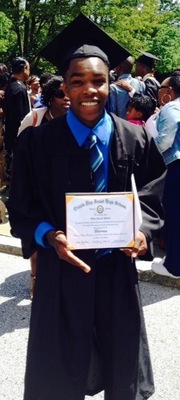 In life, we often meet someone who demonstrates a special quality that you cannot really describe. They exude an energy that you know will carry them far. We at the Knott Foundation met one such individual when Mr. Chae Aaron Harris walked through our doors in 2010.
In life, we often meet someone who demonstrates a special quality that you cannot really describe. They exude an energy that you know will carry them far. We at the Knott Foundation met one such individual when Mr. Chae Aaron Harris walked through our doors in 2010.
Chae came to us through Cristo Rey Jesuit High School’s Corporate Internship Program, a unique funding model whereby students contribute to the cost of their education through work partnerships with local employers. Through this program, Chae was a member of the Knott Foundation team for two years.
Chae has long been interested in music, writing songs, and performing. In addition to singing at his church, he has written many of his own lyrics and occasionally sang them to his “beats” in our office! He recently performed in the play, “Lost Now Found,” at Victorious Ministries International and is working on a mixed-tape entitled, “Music Forever, Part 1.”
It’s hard to believe that Chae graduated from high school this past weekend. Yet it is exciting to watch him enter another stage of his life. Chae applied to six colleges and was accepted to the Community College of Baltimore County. He is still awaiting news from several other schools. Wherever he lands, he plans to major in music.
This summer, Chae will be working two jobs in order to help with college expenses.
While Chae gained worthwhile work experience during his time with us, we benefitted as well by seeing his tenacity, curiosity and talents grow. We also saw first-hand how opening doors of opportunity for talented, faith-filled students like those at Cristo Rey helps to create a stronger, more vibrant community.
We are so proud of Chae and all of the other Class of 2014 graduates who are starting their next journey, and we remain thankful for everyone who has helped them along the way.
By Kelly Medinger
05-16-2014
The National Shrine of Saint Elizabeth Ann Seton uses Catholic activities grant to build a successful retreat program
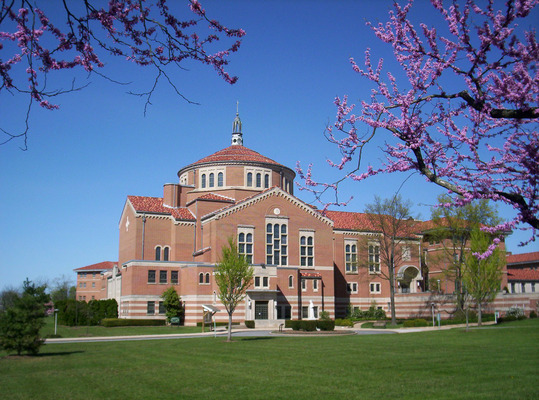 “Sacredness is a big part of why people like to come to Mother Seton’s Shrine,” says Rob Judge, Executive Director of the National Shrine of Saint Elizabeth Ann Seton. “That sense of peacefulness and sacredness permeates this place.”
“Sacredness is a big part of why people like to come to Mother Seton’s Shrine,” says Rob Judge, Executive Director of the National Shrine of Saint Elizabeth Ann Seton. “That sense of peacefulness and sacredness permeates this place.”
About the Shrine
Located in Emmitsburg, Maryland, the mission of the Shrine is to promote the life and legacy of Mother Seton, the first native-born Catholic American saint, as a source of inspiration and encouragement for all people. The Shrine is home to a museum and historical grounds that pay tribute to the life and work of Mother Seton, and a Basilica where she is laid to rest.
Today, the Shrine welcomes more than 45,000 visitors each year. Additionally, approximately 60 religious sisters reside on the campus of the Shrine. “Through our work, the sisters hope that more people will be drawn to the Shrine, that their experience will bring them closer to God, that they will see Mother Seton’s witness of charity to the poor, and that they will go home and want to live that out in their own lives,” Judge says.
Building the Retreat Program
To further its mission, the Shrine recently expanded its day retreat program with support from the Knott Foundation. From large confirmation retreats with 80 eighth graders, to faculty and staff retreats from area Catholic schools, to small parish groups, the Shrine is now a bustling retreat center.
During the grant period, the Shrine held 29 retreats, up from 6 retreats the previous year. With an average retreat size of 35 people, the program also brought many new visitors to campus. Overall visitorship to the Shrine increased significantly during the grant period. The upcoming 40th anniversary of the canonization of Mother Seton will offer a unique opportunity to continue to grow the retreat program.
Connecting the Dots
“When the groups are here, they’re able to spend time in the museum, watch the orientation film about Mother Seton, take a walking tour through the historic campus, attend Mass in the Basilica, and make private devotions in the chapel,” remarks Erica Colliflower, Retreat Coordinator. Notably, most organizers indicate that they would have hosted their retreat at a hotel, or not at all, if it were not for the Shrine’s retreat facilities.
“Being able to take advantage of all of these different services we offer really connects the dots for our retreatants,” Colliflower continues. “They see the whole picture and are able to walk with Mother Seton along her journey as a convert, a mother, a widow, a foundress, and a saint.”
By Kelly Medinger
05-16-2014
Adoptions Together uses human services grant to help foster children in Baltimore City find permanent connections as they age out of the system
 Turning 18 is a rite of passage for any young person, but it can be especially perilous for those in foster care.
Turning 18 is a rite of passage for any young person, but it can be especially perilous for those in foster care.
“Studies show that kids aging out of foster care without a permanent point of contact are much more likely to end up homeless within 18 months, have interactions with the justice system, face lower job prospects, and have fewer future educational opportunities,” shares Jeanette Stoltzfus, Manager of Corporate and Foundation Relations.
Adoptions Together and the Family Find Program
With a mission to build healthy, lifelong connections between children and families, Adoptions Together launched a program in 2011 to connect youth in Baltimore City aging out of foster care to a permanent relationship. The program, called Family Find Step Down, intersects the fields of social work, law enforcement, and investigations to produce the best result for a child.
“Every person needs someone to celebrate a holiday with and someone who will support them when they need it,” Stoltzfus explains. Adoptions Together begins that search by asking the child who they want that person to be. Sometimes it is a family member, and sometimes it is a teacher, a mentor, or a friend. For children who have been in the foster system for a long time, locating that person can be time consuming.
The Process of Finding People
Enter Dana Smoot, retired Maryland State trooper and criminal investigator. Through a grant from the Knott Foundation, Smoot was brought on to launch an “extreme recruitment” program where Adoptions Together works with Baltimore City Department of Social Services to link foster children to lifelong family connections.
“Basically, my job is to find people,” Smoot says. “While social workers provide direct services to children and families and law enforcement officers are out on the street, I am at my desk and able to devote my time to being analytical and persistent in locating the right people.” Smoot then passes along contact information of the people she has found to social workers who begin the process of engagement and building a permanent connection for the youth in care.
Producing Results
Her work has paid off. During the year-long grant period, Smoot conducted more than 2,300 searches and provided more than 300 prospective leads to child welfare professionals, which eventually helped to link 50 foster youth to a healthy, lifelong connection. After the Foundation’s funding expired, Adoptions Together, Baltimore City Department of Social Services, and the State of Maryland all recognized the benefits of the position and agreed to invest in the Family Find Step Down program.
Seventeen-year-old Daryl entered foster care at age two and is one of Adoptions Together’s clients. Daryl longed to connect with his birth family but didn’t know much about them, much less how to find them. Using a variety of medical records, court documents, and private and public databases, Smoot located Daryl’s mother and three of his siblings. Since then, Daryl and his mother are in weekly phone contact.
Daryl turns 18 soon and is lucky to have a new family to celebrate holidays with: his own.
By Sandra Young, Ph.D.
05-02-2014
Lessons learned from starting an after-school STEM club at a small Catholic school
This is the first in a multi-part series about how St. Francis of Assisi School, a small K-8 neighborhood Catholic school in Baltimore City, started an after-school STEM Club on a shoestring budget.
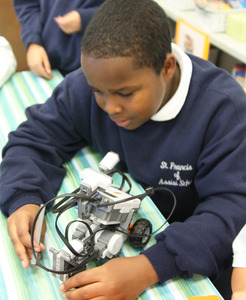 In the 2012-13 school year, St. Francis of Assisi School started an after-school STEM Club to get kids excited about STEM fields – science, technology, engineering and math. As a professional scientist and an active parent volunteer, I worked with our principal, Rebecca Malone, and two lead teachers to start the club. Together we conquered everything from recruiting students, to planning activities, to raising money, and engaging more parent volunteers.
In the 2012-13 school year, St. Francis of Assisi School started an after-school STEM Club to get kids excited about STEM fields – science, technology, engineering and math. As a professional scientist and an active parent volunteer, I worked with our principal, Rebecca Malone, and two lead teachers to start the club. Together we conquered everything from recruiting students, to planning activities, to raising money, and engaging more parent volunteers.
Why STEM?
STEM subjects foster critical thinking skills, which are used throughout life no matter what career path a student takes. Moreover, new science standards focus on project-based learning where the intent is for students to utilize basic book knowledge but demonstrate more creativity in applying what they know. It has been shown that non-formulary learning like this is important for students to develop problem-solving skills.
Who Signed Up?
Much to our delight, the STEM Club became a popular after-school activity. Approximately 40 students signed up in our first year – a significant number given that it represents nearly one-fifth of our total school population. Now in its second year, the STEM Club has grown to more than 60 students. Interestingly, I heard from many parents who said their children were excited to sign up because their friends had talked about how much they were learning and how fun the experience was.
What Have We Learned?
In starting our own after-school STEM program, we learned the importance of good planning, student and volunteer engagement, and community involvement. Here are some ideas that have come from our work thus far that might help other interested parents, teachers, and principals start their own STEM Club on a “shoestring” budget.
- Recruit plenty of adult volunteers. In addition to dedicated teachers, you need at least as many parents. A decent adult-to-student ratio helps to ensure that activities run smoothly. Yet it’s important to realize that adults don’t need to have all the answers – it’s OK to say to the kids, “I don’t know but I bet you can figure it out!” Volunteers don’t even need a science background; it’s more important that the individuals leading the club be organized and willing to learn some of the STEM topics alongside the kids. You’re never too old to learn new things!
- Plan the entire year’s activities. Having a general layout of what you’re going to do with the students for the entire school year may sound daunting, but it's easier to make changes to an existing plan along the way than come up with an entirely new plan at the last minute. It is also a good idea to have materials available for back-up activities, in case they are needed.
- Focus on activities not in the traditional curriculum. An after-school program is a good opportunity to focus on things not learned in the traditional curriculum such as robotics, Rube Goldberg machines, snap circuits, computer science unplugged (you don't even need a computer to do CS unplugged), etc. While many of these activities have initial start-up costs, the materials are reusable. And from an educational standpoint, any focus on non-formulary work is good if the students can be kept on task.
- Set goals. Developing short, medium, and long-term goals for our STEM Club helped keep us focused on where we were headed.
- Encourage students to reflect on what they learn. We recently decided to have our students bring a lab notebook at the beginning of the year to write down their thoughts and ideas about the project(s) throughout the year.
- Promote the club’s work. Internally, we promote the Club via a STEM newsletter to parents, so they’re aware of the Club’s activities as well as other ways that STEM is integrated at the school. Our newsletter includes a list of both school and local STEM events. We also offer an annual STEM Night to get the school community in the spirit of “STEM is important and fun.”
- Network with others. You aren't in this alone. Talk to other teachers, parents, and science professionals. You never know where your next idea (or next grant) will come from.
- Approach everything with a good sense of humor. Things do not always go according to plan. Just remember that the students are there to learn and have fun.
Sandra “Sandy” Young is a Materials Engineer by training and currently serves as a Program Manager for the U.S. Army Education Outreach Programs and the Aberdeen Proving Ground STEM Center in Maryland, which provides programs in science, technology, engineering and math for K-12 and college students. She holds a bachelor’s degree in Chemistry and a Ph.D. in Polymer Science and Engineering. She is also a proud parent of a second grade student and an active volunteer at St. Francis of Assisi School. Learn more about Sandy by reading an article or viewing a video of her work as a STEM educator.
By Kelly Medinger
04-09-2014
Painting a broader picture of the impact we’re having on people and communities in the Archdiocese of Baltimore
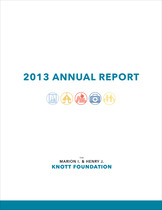 It is my pleasure to announce the publication of our 2013 Annual Report!
It is my pleasure to announce the publication of our 2013 Annual Report!
By weaving together outcomes from grants in our five program areas, our annual report paints a broader picture of the impact the Knott Foundation and our grantees are having on people and communities in the Archdiocese of Baltimore.
I hope you enjoy this publication and the many wonderful stories behind the grants that we award.
By Laura Corbin Frazier, Ed.D.
04-08-2014
Ten considerations for funding or implementing programs
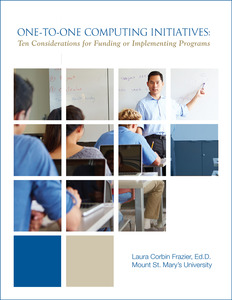 I first met Knott Foundation Executive Director, Kelly Medinger, in a small Catholic school that was expanding its technology resources. The Knott Foundation and Mount St. Mary’s University were partners with the school in this growth; the Knott Foundation with much needed funding and the university with professional development collaboration. However, on that day and in subsequent discussions, our focus was not on specific technology tools, but instead on instructional decision-making using technology.
I first met Knott Foundation Executive Director, Kelly Medinger, in a small Catholic school that was expanding its technology resources. The Knott Foundation and Mount St. Mary’s University were partners with the school in this growth; the Knott Foundation with much needed funding and the university with professional development collaboration. However, on that day and in subsequent discussions, our focus was not on specific technology tools, but instead on instructional decision-making using technology.
The Knott Foundation makes numerous decisions regarding grant applications each year, many of which include requests for specific technology infrastructure. But there are also a growing number of requests for one-to-one computing initiatives (one mobile device for each student). These requests parallel current demands for increased student readiness with 21st Century skills and a growing number of success stories from states, districts, and classrooms using mobile devices to enhance student learning.
My research agenda includes technology integration in schools, which necessarily encompasses one-to-one computing. The Knott Foundation, seeking research on the effectiveness of one-to-one computing initiatives to both inform their own work and support others in education, provided me the opportunity to review research on one-to-one computing initiatives and to engage in a research study on teacher technology decision-making in a one-to-one iPad initiative.
The linked article is the product of the first phase of that research and summarizes my findings from review of nearly 100 research studies and reports. The article highlights ten key considerations for technology decision-makers, with a specific focus on those new to one-to-one computing initiatives. In my discussion of each consideration area, I have highlighted current research findings that influenced my recommendation. Additionally, I have provided a list of online resources with how-to guides, success stories, and strategies to further support those beginning a one-to-one initiative.
The article is not designed to be a step-by-step guide to starting one-to-one computing initiatives, though the issues presented do generally coincide with the development process. Rather, it is intended to be a part of the discussion on issues confronting those seeking innovative change using one-to-one computing. In considering such initiatives numerous questions are raised such as:
- What are the impacts and gains for an institution?
- Is student achievement likely to improve?
- What are new requirements of students and teachers?
- Are there advantages/disadvantages to using different technologies?
- Do the benefits support the costs?
The article aims to synthesize research on these and many other common questions associated with one-to-one computing into the ten most prominent considerations for decision-makers. I hope you find the article both informative and useful.
Laura Corbin Frazier, Ed.D., is an Assistant Professor of Education in the School of Education and Human Services at Mount St. Mary’s University in Emmitsburg, Maryland. Dr. Frazier specializes in instructional technology and distance education. Her research interests couple these areas with new teacher preparation and professional development schools.
By Kelly Medinger
03-06-2014
Announcing our most recent grant recipients in education, Catholic activities, human services and health care
We are pleased to announce that 19 organizations received over $700,000 in our February 2014 grant cycle.
Education
- Enoch Pratt Free Library: $44,000 grant to support the expansion of the eLibrary and Gale Virtual Reference Library
- Our Lady of Hope/St. Luke School: $24,371 grant to support the upgrade of this pre-K-8 Catholic school’s computer lab and network
- School of the Incarnation: $67,000 grant to support Phase II of this pre-K-8 Catholic school’s technology initiative, including network upgrades and the purchase of new hardware
- Village Learning Place: $31,224 grant to support the LINK (Let's Invest in Neighborhood Kids) initiative, a free after school and summer program for students in the Charles Village neighborhood
Catholic Activities
- School Sisters of Notre Dame: $24,768 grant to support Villa Assumpta, a retirement facility for religious sisters, through the acquisition of much-needed equipment
Human Services
- At Jacob's Well: $25,000 grant to support case management services for mentally ill, homeless men and women in a transitional housing program
- Caroline Center: $50,000 grant to support operational costs for this organization’s tuition-free career and life skills educational program for unemployed and underemployed women in Baltimore
- CASA of Allegany County: $15,000 grant to support the recruiting, screening, and training of CASA volunteers to serve Allegany County’s abused and neglected children
- Family Tree: $40,000 grant to support family strengthening, school enhancing services at four Catholic schools in Baltimore City
- Historic East Baltimore Community Action Coalition: $25,000 grant to support the new position of a Director/Program Manager for the Baltimore Food Enterprise Center, providing economic and workforce development opportunities in a growing local food economy in East Baltimore
- HopeWell Cancer Support: $32,699 grant to support technology upgrades to help this organization improve education, outreach, and support to individuals and families dealing with cancer
- Job Opportunities Task Force: $25,000 grant to support JumpStart, a pre-apprenticeship training program in the building and construction trades for underserved, low-income Baltimore City residents
- Moveable Feast: $45,000 grant to support operating costs for the Culinary Training Program, providing job training and placement to underemployed adults in Baltimore who have a passion for food
- The Arc Baltimore: $17,400 grant to support this organization’s Parent’s Day Out Program at four Catholic parishes, offering respite for parents and caregivers of children with intellectual disabilities
- The Arc Carroll County: $40,000 grant to support the position of an Autism Coordinator to help craft Carroll County’s first autism program
Health Care
- Brook Lane Health Services: $50,000 grant to support the expansion of a facility that will provide 14 additional beds for inpatient psychiatric care for children and adolescents
- Gilchrist Hospice Care: $40,000 grant to support the Gilchrist Kids program that provides compassionate end of life care to children and those who love them
- Mission of Mercy: $42,000 grant to support the expansion of this community-based mobile health clinic by providing one additional day of service per month at their Reisterstown Clinic in Baltimore County
- Ulman Cancer Fund for Young Adults: $75,000 grant to support capital costs associated with the construction of a comfortable, multi-dimensional, supportive housing community in East Baltimore for young adults with cancer and their caregivers
For a complete listing of our grant awards from previous cycles, please visit our past awards database.
By Kathleen McCarthy
03-04-2014
A provocative thesis about who is driving technological innovation – people or technology itself?
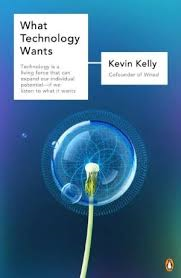 I recently read What Technology Wants by Kevin Kelly, one of the co-founders of Wired magazine.
I recently read What Technology Wants by Kevin Kelly, one of the co-founders of Wired magazine.
In my role at the Foundation, I regularly encounter a broad spectrum of nonprofits who are seeking funding to pursue technology related projects. While this has afforded me a clear picture of what technology these organizations want, the picture is less clear and far more intriguing when I think about the concept that technology might, in fact, want something from us.
Published in 2010, Kelly’s book and the theories contained within have been described as “provocative,” “revolutionary,” and “balderdash.” In What Technology Wants, the author promotes the thesis that technology has traveled an evolutionary path in much the same way as biological evolution; describing technology as a “near-living system” and an “evolving organism.” In sum, much like our own evolution, technology’s evolution is “inevitable” and constantly adapting through the selection of useful traits.
While many, as did I, will find his theory a bit thin at times, I did find his notion that as much as we choose technology, technology is choosing us. Kelly does however offer some persuasive examples to support his claim. One example that resonated with me was his description of the thousand plus years of evolution in rail lines. He writes that Roman roads which were specifically sized to accommodate war chariots were translated into the British railroad system and subsequently developed into rail tracks in the United States. It was amazing to learn that ancient Roman roads measuring 4 feet 8 ½ inches wide, designed to carry war chariots, had jumped continents and were being deployed in the same specific measurement to carry fuel rockets that power the space shuttle today. While I am not sure that I agree that this evolution was “pre-ordained,” I must admit, I was intrigued by the notion that technology changes in part because it is learning from humankind, evolving alongside of us every day, and perhaps even choosing us and how we use it.
What Technology Wants was a groundbreaking book when it was released and continues to be a challenging and fascinating read four years later. Whether you ascribe to the author’s almost mystical belief that “just as water ’wants’ to flow downhill and life tends to fill available ecological niches, technology similarly ‘wants’ to expand and evolve,“ it is undeniable that technology does indeed expand and evolve. The challenge is to not recoil in fear, but to contemplate this evolution and decide what value and virtue there is for creating common good.
So, when you reach for your next iPad or cell phone, or load your next app, you may want to consider whether you are making the choice, or, if you are being chosen. As for myself, I will continue to consider the inevitability of technology, be excited and awed by its possibilities, and cultivate preparedness for the rise of the machines!
By Kelly Medinger
02-11-2014
A snapshot of facts and figures about us, our giving, and the Knott family legacy
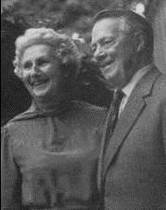 Oftentimes my favorite part of a publication is the “by the numbers” section. (I can’t seem to resist a cleanly presented package of numbers that tells a bigger story!) So, I thought it would be interesting and useful to present a few facts and figures about the Knott Foundation, our giving, and the family’s historic legacy.
Oftentimes my favorite part of a publication is the “by the numbers” section. (I can’t seem to resist a cleanly presented package of numbers that tells a bigger story!) So, I thought it would be interesting and useful to present a few facts and figures about the Knott Foundation, our giving, and the family’s historic legacy.
About Us
- $57 million in assets as of December 31, 2013
- 30 Knott family members serve on our Board of Trustees
- 3 full-time staff members work in our office
- 83% of Trustees conducted a site visit in 2013
- 15 years is the average tenure of our Trustees
About Our Giving
- Annually:
- 3 grant cycles are held in February, June and October
- Approximately 200 letters of inquiry are received
- Approximately 50 grants totaling around $2 million are awarded
- $40,000 was our median grant in 2013
- $120,000 was our largest grant in 2013
- Education is our largest program area
About the Knott Family Legacy
- 13 children were borne to Marion & Henry Knott
- 257 people now make up the Knott family – direct descendants of Marion & Henry Knott, their spouses, and children
- 3 generations of the Knott family serve on our Board of Trustees
- More than $50 million in grants have gone to help communities in the Archdiocese of Baltimore since our founding in 1977
As a premier Catholic family foundation in Maryland, we have the dual purpose to strengthen our community in the Archdiocese of Baltimore and promote family unity. With this mission in mind, we look forward to expanding these numbers in the future and continuing to tell our story for many years to come.
By Kelly Medinger
01-17-2014
We've expanded our communications mission through a refined website design
Our website has a new look!
In refining the design, we’ve also expanded our communications mission: Our aim is to paint a vivid picture of who we are and share in real-time what we’re learning.
As such, one of the new features on our website is a blog where we’ll post foundation news, spotlight stories about our grantees, and our key learnings from the field. We’ve also incorporated an embedded search function on the site and built program pages to showcase our giving in our five program areas: arts and humanities, Catholic activities, education, health care, and human services.
Beyond these changes, we want to assure you that grant seekers still have the ability to:
If you have any feedback about our new website, please send it to knott@knottfoundation.org. We would add that our new website is best viewed in the most recent version of popular web browsers (Internet Explorer version 10 or above, Firefox, and Google Chrome).
We look forward to staying in touch via our e-newsletter. In the meantime, please accept our warm wishes for a safe, healthy, and prosperous new year!
By Kelly Medinger
11-12-2013
A new site designed to help consultants in the social sector raise their game helps all nonprofits in the process
I was captivated this summer by Mario Marino's Leap of Reason Update on profiles in courage. In it, Marino describes a sort of "humble, courageous leadership" that is required for solving big social challenges. Part of this type of leadership, one could argue, involves knowing when outside expertise is needed to help your organization get to the next level, and then finding and engaging that expert to help you get to where you need to be.
Enter Impact Rising, a new site funded by three prominent Bay Area foundations that seeks to elevate the quality of consulting in the social sector. Impact Rising describes how consulting in the social sector has evolved from a "largely unregulated, under-the-radar, word-of-mouth cottage industry" into a market-driven industry with broadly accepted norms and practices. The site acts as a repository for these norms and practices "so that nonprofits, NGOs and foundations don't have to reinvent the wheel."
Impact Rising offers a plethora of tools and resources to help nonprofits and their consultants -- everything from how to determine whether you're ready to hire a consultant, to sample RFPs and consulting budgets, to lessons learned from others who have been through specific consulting projects.
Yet Impact Rising doesn't stop there. The site goes beyond typical consulting advice to offer the very plans and templates that you can use on your own to build capacity within your own organization. Think strategic planning resources, fundraising plans, organizational assessments, and communications advice.
The end result is a great resource for nonprofits and consultants alike who want a one-stop shop for some of the best resources on the market today.
By Carol Hoffman
11-12-2013
A journey into the human memory and how to use it better
 I recently read Moonwalking with Einstein: The Art and Science of Remembering Everything by Joshua Foer.
I recently read Moonwalking with Einstein: The Art and Science of Remembering Everything by Joshua Foer.
Foer was a journalist and, being a journalist, he needed to know a little bit about a lot of things. For several years he followed the U.S. Memory Championship tournaments and wrote articles about the competitors. One day, a tournament champion asked him if he wanted to learn how to memorize. Moonwalking with Einstein is about Foer's resulting yearlong quest to improve his memory and transform his understanding of the human brain.
Memory is all about technique and understanding how the brain works. Foer believes anyone can have a good memory; it is simply a matter of learning to think in more memorable ways. Everything that you pay any degree of attention to is recorded in a permanent part of your brain. A memory only comes into consciousness if it is cued by some other thought or perception.
In the book, Foer explains that when a person's name gets caught on the tip of your tongue, your memory is frustrated. He says you need to think of some piece of information to try to link that person's name in your memory to your consciousness. You can use this same concept for remembering events by positioning them in time relative to other life events.
In his quest to master his own memory, Foer learned that he could train his brain, but also that he needed to be more mindful of the world around him and take notice of everyday life. Notably, after a year of exploring the field of human memory, he competed against twelve other contestants and won the U.S. Memory Championship.
Foer believes we don't need to acquire a better memory -- we just need to use the memory we have more effectively.
By Kelly Medinger
11-12-2013
St. Elizabeth School uses education grant to purchase SMART Boards
 The hallways of St. Elizabeth School bustle with activity as students return to class after lunch in the cafeteria. In some ways, it seems like a typical school, but in other ways, it feels more special than that.
The hallways of St. Elizabeth School bustle with activity as students return to class after lunch in the cafeteria. In some ways, it seems like a typical school, but in other ways, it feels more special than that.
A Special Place
St. Elizabeth School, a ministry sponsored by the Sisters of St. Francis of Assisi, opened in 1961. Today, the School serves 120 students in the Baltimore metro area, ages 6-21, who have been diagnosed with disabilities such as autism, traumatic brain injury, emotional disabilities, intellectual disabilities, orthopedic or other physical impairments, or multiple disabilities.
“Every child with special needs deserves an appropriate education, and at St. Elizabeth School, we do more than that,” affirms Christine Manlove, Ed.D., Executive Director. Oftentimes students have struggled in other environments but flourish at St. Elizabeth, benefiting from skilled teaching, onsite clinical and therapeutic services, integrated use of assistive technology, a robust workforce development and transition program, and above all, an atmosphere of mutual respect and a sense of belonging.
Investing in SMART Infrastructure
The Knott Foundation has awarded St. Elizabeth School more than $100,000 over the past decade for capital needs, academic programs, and technology purchases. Most recently, the School received a $45,000 grant to install SMART Boards in seven classrooms, which advanced their focus on integrating technology to improve students’ learning experience.
Witnessing a lesson on the SMART Board, it is clear that the interactive animation and instant feedback that the SMART Board offers captivates the students. “Hearing automatic applause in front of the whole class when choosing the right answer is uplifting and encouraging,” Dr. Manlove observes. “It’s different than a teacher simply saying ‘right answer’ or ‘good job.’”
SMART Measurement
St. Elizabeth approached measuring the impact of the SMART Boards in their classrooms in a unique way. Through pre- and post- surveys, and comparisons to behavioral incident reports filed through the national School-Wide Information Systems (SWIS) database, they were able to observe measurable improvements in both student behavior and time devoted to educational tasks when the SMART Boards were in operation.
For example, when a SMART Board is being used in the classroom, the number of behavior incident reports decreases by 28.5%. And better behavior means more time focused on task. St. Elizabeth estimates that they earn back nearly seven educational days from the use of the SMART Boards over the course of an academic year.
Dr. Manlove concludes: “Without technology, our students would be isolated from the world in so many ways. No one would know how brilliant they are. Technology has allowed us to give them the tools they need to realize their full potential.”
By Kelly Medinger
11-12-2013
The Star Spangled Banner Flag House uses arts and humanities grant to showcase Baltimore’s role in our nation’s history
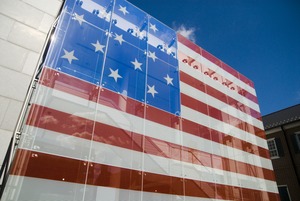 Sometimes we forget the importance that Baltimore plays in this nation’s history… and sometimes we can forget the role that museums, like the Star Spangled Banner Flag House, play in reminding us of this history.
Sometimes we forget the importance that Baltimore plays in this nation’s history… and sometimes we can forget the role that museums, like the Star Spangled Banner Flag House, play in reminding us of this history.
A Journey Back in Time
Touring the Star-Spangled Banner Flag House is like taking a 200-year journey through time and back again. On the Flag House’s campus in downtown Baltimore sits both a home built in 1793 and a modern museum that opened in 2004. Together, these buildings tell the story of the American flag that Mary Pickersgill sewed, which inspired the poem that became our National Anthem.
“Flags were a very important means of communication,” explains the museum’s docent. “They would signal everything from a company name, to a ship’s cargo, to a country’s land.” The American flag that Mary Pickersgill sewed came with special instructions: make a flag so large that the British could not miss it.
When it was finished, the flag measured 40 feet by 32 feet. Today, the Flag House’s campus contains a two-story Great Flag Window, which is the same size and design as the original.
Visiting the Flag House
Each year 12,000 visitors come to the Flag House to learn about domestic life in early America, the making of the Star-Spangled Banner, the War of 1812, and the writing of the National Anthem. More than half of these visitors are students from Baltimore City and Baltimore County. “In 2012, we saw a large uptick in the number of classes coming to the Flag House due to the bicentennial celebration of the War of 1812. Since then, our numbers have remained high,” shares Annelise Montone, Executive Director.
Over the past several years, the Knott Foundation has awarded the Flag House multiple discretionary grants to support the organization’s general operations and exhibits. The Foundation’s discretionary grant program provides awards between $500 and $2,500 and serves as a way for trustees to support organizations that most interest them – such as telling the story of Baltimore’s role in our nation’s great history to students and families who live here.
A New Exhibit
While telling a story that is 200 years old, the Flag House also has its eyes set on the future. On February 12, 2014, the birthday of Mary Pickersgill, a new permanent exhibit detailing Mary’s creation of the most famous flag in American history will open on campus. “It will be the first of its kind,” relays Montone. “There has never been a museum exhibit exclusively focused on this extremely important moment in history. We think it is high time there was.”
By Kelly Medinger
07-09-2013
A national study of challenges facing nonprofit fundraising
Last year, we invited you to participate in a national research survey exploring the role of executive directors and development directors in nonprofit organizations. The result of this survey is the report, UnderDeveloped, a joint project of CompassPoint and the Evelyn and Walter Haas, Jr. Fund.
Why We’re Interested
Given the Knott Foundation's support in the area of fund development -- we have helped organizations with fundraising salaries, activities, and infrastructure needs -- we had a particular interest in the findings of this report when it was released earlier this year.
What the Report Says
The report addresses the widespread concern in the nonprofit sector about premature turnover of development directors, lengthy vacancies in the role, and the seemingly thin pool of qualified candidates to choose from.
Ultimately, the authors suggest that classifying the issue as a "talent pool" problem alone is misguided. Instead, they assert that we also need to focus on "entrenched organizational factors that contribute to the inability to establish development as a shared function and nurture organizational culture to sustain it."
What We Can Do To Help
The resulting "call to action" is multifaceted.
- Embrace fund development through a mental model shift ("we heard plenty of complaints about fundraising, but very little enthusiasm")
- Elevate the field of fundraising (asking for money should not be taboo)
- Strengthen and diversify the talent pool
- Train board differently
- Apply the transition management framework to the development director position
- Invest strategically in grantee fundraising capacity
- Leverage technological innovation
- Set realistic goals for development
- Share accountability for fundraising results
- Exercise fundraising leadership (development directors should create a fundraising plan, educate staff and board members about what a culture of philanthropy entails, and take responsibility for their own professional development)
Click here to read the full report.
By Kelly Medinger
07-09-2013
Shepherd’s Clinic uses health care grant to serve those who need it most
 Since 1991, Shepherd’s Clinic has grown from a small medical clinic located in the basement of Seventh Baptist Church to an integrative health center recording, at its height, 18,000 volunteer hours and 9,440 patient visits in one year.
Since 1991, Shepherd’s Clinic has grown from a small medical clinic located in the basement of Seventh Baptist Church to an integrative health center recording, at its height, 18,000 volunteer hours and 9,440 patient visits in one year.
The Clinic serves patients whose income falls below 200% of the federal poverty index, and their catchment area includes the Waverly, Coldstream-Homestead-Montebello, Hampden and surrounding neighborhoods of Baltimore City.
A Mission Connection to Union Memorial Hospital
“The Clinic was originally founded to help the many non-urgent, uninsured patients going to Union Memorial’s emergency department,” shares Melissa DeLong, M.D., Medical Director. The connection to Union Memorial became deeper when Dr. William H.M. Finney, former Chief of Staff at Union Memorial, became the Clinic’s first volunteer Medical Director. “Dr. Finney set the tone for the Clinic, bringing an inspiring spirit of service and steadfast dedication to patient care,” DeLong remarks.
Today, Shepherd’s Clinic’s holistic approach to serving patients is a hallmark of the Clinic. Their campus includes a medical clinic, lab, as well as a full-service wellness center. The Joy Wellness Center offers psychiatric consultations, massage therapy, acupuncture, yoga classes, walking groups, and cooking lessons, among other things.
A Volunteer-Driven Clinic
Notably, all of Shepherd’s Clinic’s direct patient care services are provided by a vast and committed volunteer base. Volunteers range from the enthusiastic pre-med students from Johns Hopkins University manning the front desk, to the pharmacy students from Notre Dame of Maryland University’s School of Pharmacy, to the nurses, primary care physicians and specialists seeing patients every day.
The Knott Foundation has provided Shepherd’s Clinic with more than $180,000 since 2000, largely to support the Clinic’s general operations. During the most recent grant period, the Clinic saw record growth in patient visits – so much that the organization had to reaffirm its service area in the neighborhood to ensure continuation and quality of care as well as organizational stability.
Reform on the Horizon
Healthcare reform will mark another defining point in the Clinic’s growth and history. Many of Shepherd’s Clinic’s patients will be eligible for medical assistance under new federal guidelines, and others will be eligible for products on the healthcare exchange.
Even with these new measures in place, however, it is still expected that patients will experience gaps in coverage. Care will not be seamless, and people will still need an advocate to help them understand the system and reassure them that they will be taken care of. Shepherd’s Clinic will continue to meet the demand for free and affordable health care by adapting into a hybrid model that includes the existing free clinic for the uninsured, a new fee-based clinic, and a navigation service to help people acquire health coverage.
DeLong concludes, “While our model may shift some in the coming years, our mission to provide quality comprehensive care in the community to those who need it most will remain constant.”
By Kelly Medinger
07-09-2013
A story about the evolution of human motivation
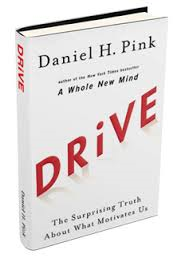 Drive: The Surprising Truth About What Motivates Us describes the evolution of motivation, from survival in the beginning of time, to a structured system of reward and punishment, to an emerging economy based on self-direction and the value of ideas.
Drive: The Surprising Truth About What Motivates Us describes the evolution of motivation, from survival in the beginning of time, to a structured system of reward and punishment, to an emerging economy based on self-direction and the value of ideas.
Most people still believe that the best way to motivate is with money. Pink refutes that notion. "On the edges of the economy -- slowly, but inexorably -- old-fashioned ideas of management are giving way to a newfangled emphasis on self-direction," he observes.
Pink describes this new motivation as one where people are not incentivized by economic reward, but rather the satisfaction that comes from directing their own lives, learning and creating new things, and doing good.
To adapt to this new system of motivation, Pink argues, people need autonomy over the four T's: task, time, technique, and team. "Control leads to compliance; autonomy leads to engagement," he states.
In the end, Pink exposes a gap between what science knows truly motivates us and what business actually does. (Take the billable hour, for instance.) He challenges us to embrace this new system of motivation and adapt our business practices to fashion a more fulfilling work environment based on principle, not precedent.
By Kelly Medinger
05-15-2013
Ignatian Volunteer Corps uses Catholic activities grant to grow the number of volunteers in Baltimore
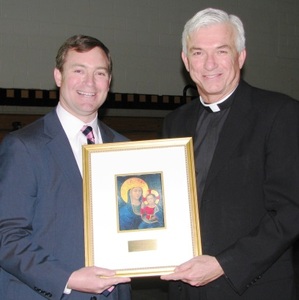 Love is shown more in deeds than in words,” St. Ignatius wrote. Today, the Ignatian Volunteer Corps lives out this principle by serving the poor, by working for a more just society, and by imparting the Catholic tradition of Ignatian spirituality.
Love is shown more in deeds than in words,” St. Ignatius wrote. Today, the Ignatian Volunteer Corps lives out this principle by serving the poor, by working for a more just society, and by imparting the Catholic tradition of Ignatian spirituality.
A national network, headquartered in Baltimore, the Ignatian Volunteer Corps (IVC) provides retired men and women opportunities to volunteer in their local communities while deepening their faith. Volunteers typically work two days per week in a social service agency and also participate in
organized group meetings and spiritual reflection exercises.
Growing the Number of Volunteers in Baltimore
The Knott Foundation made an early investment in IVC to help test their plans for dramatically increasing the organization’s number of volunteers. The grant allowed IVC’s Baltimore regional office – which had been in danger of closing – to hire a Regional Director who, in just one year, demonstrated significant results: Ten new volunteers recruited. Seven partner agencies added. An extra 4,500 hours of service performed. $20,000 in new partnership fees secured. And nearly $13,500 in individual gifts and fundraising event income raised.
These results, along with important data about the retiring population and rising social service needs, led IVC to launch a national campaign to raise $1 million and double the number of IVC volunteers over three years.
Launching a National Campaign
“The Magnify! Campaign recognizes the tremendous talent and opportunity that exists in the growing retired population,” states Mary McGinnity, National Executive Director. “Every day over the next two decades, 10,000 Baby Boomers will celebrate their 65th birthday. IVC is a great outlet for them to stay active, give back to the community, and grow in their faith.”
“Many IVC volunteers have lived their lives without really having known or worked with the poor,” continues Mary. “When they come to us, they are transformed through their experience.”
The Volunteer Experience
One such couple is George and Mary Jean Schuette, married 39 years, who joined IVC last year. George, a former Social Security employee, now works at Project PLASE, a housing and support services provider for the homeless. Mary Jean, a former Catholic school teacher, tutors GED students at Christopher Place Employment Academy, an intensive residential program for formerly homeless men. Each night George and Mary Jean recall the discerning question of their spiritual reflector, “Where do you find God in your work with these men?”
Sr. Marilyn Dunphy, MHSH, Baltimore’s Regional Director, sums it up: “Volunteer service in and of itself is wonderful. Volunteer service rooted in faith, like Ignatian spirituality, has a deeper meaning. Prayer and reflection allow our volunteers to take back a new understanding of, and a new perspective to, their work and their lives.”
By Kelly Medinger
05-15-2013
The League for People With Disabilities uses human services grant to generate jobs and revenue
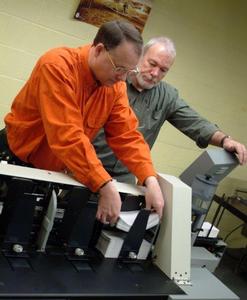 Words like “variable data printing” and “tray sequence numbers” are standard vocabulary at League Industries, a program of The League for People with Disabilities. As a full-service print and mail house operation, League Industries utilizes an array of commercial-grade automated equipment and an affirmative business model employing people with and without disabilities to do over $1 million of business every year.
Words like “variable data printing” and “tray sequence numbers” are standard vocabulary at League Industries, a program of The League for People with Disabilities. As a full-service print and mail house operation, League Industries utilizes an array of commercial-grade automated equipment and an affirmative business model employing people with and without disabilities to do over $1 million of business every year.
Taking League Industries from Small Shop to Big Business
League Industries was founded in 1933 to provide employment opportunities for people with disabilities. Over the past 80 years, the operation has evolved from a small workshop where people with disabilities constructed lampshades, to an affirmative, social enterprise that has successfully secured major direct mail and printing contracts from local, state, and private business entities.
The League for People with Disabilities (“The League”) offers individuals the opportunity to gain independence, increase self-sufficiency, and improve their overall quality of life through rehabilitative and support programs. League Industries is a special program of The League that provides employment for skilled individuals with physical, cognitive and neurological disabilities, while also helping to subsidize The League’s general programming.
“League Industries was founded as a way to keep people employed and perform job training. But it’s become a real social enterprise,” shares David A. Greenberg, CEO of The League. Indeed, League Industries’ business has grown 35% over the last two years. It generated nearly $170,000 for The League last year. “Frankly, the financial support from this operation helps us run important programs like our state-of-the-art wellness center and provide more scholarships to Camp Greentop, which are important to both our clients and the broader community,” remarks Greenberg.
How a Grant Augmented the Capacity of the Enterprise
The Knott Foundation has awarded more than $150,000 to The League since 2000. The most recent grant allowed League Industries to hire a Customer Service Representative and purchase commercial-grade mail house equipment, including a high capacity paper cutter, binding machine, printer and envelope inserter.
With the help of the added staff, League Industries was able to focus on more intense business development activities. Thanks to the Knott Foundation’s support, the added staff and machinery enabled League Industries to secure new, multi-year contracts worth over $250,000. Meanwhile, the new staff person was able to implement a more regular billing system, which reduced the number of outstanding account balances four-fold and increased the cash flow of the operation.
The benefits, however, extend far beyond financial subsidies. “Seeing League Industries makes you think about how important work is to life. In the typical workplace, you tend to hear people complain about work. But here, people love to work. Here, work is like gold,” says Greenberg.
By Kathleen McCarthy
04-26-2013
A thought provoking analysis of our approach to making decisions
 In yet another insightful and practical read presented by the Heath brothers, Decisive provides a thought provoking analysis of our often narrowed and flawed approach to making decisions in all aspects of our lives.
In yet another insightful and practical read presented by the Heath brothers, Decisive provides a thought provoking analysis of our often narrowed and flawed approach to making decisions in all aspects of our lives.
The book makes this case by providing intriguing examples that flow from the daily struggles of everyday people to nonprofit leaders and CEOs of Fortune 500 companies.
The authors argue that all too often we approach our decisions from positions of over confidence bolstered by limited and highly selective information gathering. To address this reality, they challenge us to Widen our options, Reality-test our assumptions, Attain distance before deciding, and Prepare to be wrong as we work through a decision. This WRAP process takes the decision maker outside of their biased comfort zone and encourages them to look for real and often unimaginable options.
One simple and easily deployed component of WRAP is the 10/10/10 exercise for "attaining distance before making a decision."
When you take the time to envision your decision and how you will feel about it 10 minutes from now, 10 months from now, and 10 years from now, you can gain an almost immediate perspective on something that might appear overwhelming when first considered.
It is a simple tool that might just help calm the gut and instill a sense of rational confidence in life and work.
By Owen Knott
01-03-2013
On behalf of the Board of Trustees of the Marion I. & Henry J. Knott Foundation, I am delighted to announce the appointment of our new Executive Director, Kelly Medinger.
Many of you know Kelly from her former role as our Program and Communications Associate. Joining the Foundation in March 2011, she excelled in her work, and in our evaluation, exhibited competency and strength beyond that position. As Executive Director, her new responsibilities include managing the general operations of the Foundation, supporting board membership and development, overseeing our grantmaking efforts, and guiding and carrying out our strategic direction.
Since graduating with honors from the University of Notre Dame in Notre Dame, Indiana, Kelly's career in the philanthropic giving arena has spanned 12 years. Prior to joining the Foundation, she served as a Program Officer at The Goizueta Foundation in Atlanta, a private family foundation with Catholic roots. Upon moving to Baltimore in 2007, she became the Director of Corporate, Foundation and Government Relations at Stevenson University. You can learn more about Kelly by clicking here.
Kelly's appointment comes at an important time for the Knott Foundation. This past year we celebrated 35 years of grantmaking. With three generations and 30 family members on our Board, we are confident that Kelly will serve the Foundation, the Knott family, and the Maryland nonprofit community with enthusiasm and thoughtfulness - as we have learned is her way.
"It is an honor and a privilege to be selected for this role," shared Kelly. "And I very much look forward to working with our trustees, grantees, fellow funders, and community leaders to help carry out the mission of the Foundation and the inspiring legacy of our founders, Marion I. and Henry J. Knott."
Alongside our Board of Trustees and our dedicated professional staff, Carol and Kathleen, we invite you to extend a warm welcome to Kelly in her new role. We are extremely grateful to have her talent and leadership at the Knott Foundation.
Thank you for all that you do to support our community, and please accept our best wishes for a joyous and successful new year.
By Kelly Medinger
11-16-2012
Junior Achievement of Central Maryland uses education grant to build financial literacy among Catholic school students
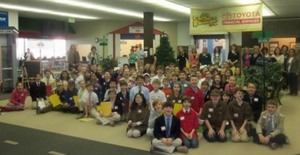 How many young people can calculate the value of a stock portfolio or define the difference between gross and net income? Nine in ten Catholic school seventh and eighth graders could, after participating in Junior Achievement of Central Maryland’s Finance Park program.
How many young people can calculate the value of a stock portfolio or define the difference between gross and net income? Nine in ten Catholic school seventh and eighth graders could, after participating in Junior Achievement of Central Maryland’s Finance Park program.
Making Smart Academic and Economic Choices
“At Junior Achievement, we give young people the knowledge and skills they need to own their economic success, plan for their future, and make smart academic and economic choices,” remarks Jennifer Bodensiek, President of Junior Achievement of Central Maryland (JA). JA’s programs are designed to deliver hands-on experiences that give young people the knowledge and skills in financial literacy, work readiness and entrepreneurship.
“JA helps students by supplying a real-world perspective that complements classroom learning,” Bodensiek says. “This approach is especially important given so many young people drop out or perform poorly in school because of boredom. This sense of boredom often stems from a disconnect between the classroom and the skills they perceive needing in the real world. The goal of JA programs and our cadre of trained corporate and community volunteers is to share life lessons to make learning come to life and be that connector between the classroom and the real world,” she adds.
Connecting with Young People
When it comes to connecting with more young people, JA has had great success. The organization currently serves 33,000 students annually in 12 Maryland counties, a 64% increase from the previous year. Over the last 15 years, the Knott Foundation has invested nearly $100,000 to support JA’s work in Catholic schools in particular. Most recently, a grant enabled more than 3,000 middle grade students and 800 elementary students to participate in JA’s two capstone programs, JA BizTown and JA Finance Park Virtual.
JA BizTown is an interactive experience where students visit a simulated town, work at assigned jobs, receive paychecks, buy and sell goods and services, and manage their business and personal finances. When students are older, they participate in JA Finance Park Virtual – a computer simulation where a student receives a unique profile (such as a married woman with two children making $40,000/year) and then plays the game of life, budgeting and investing her own money as various situations arise.
Taking the Program System-Wide in the Archdiocese
Notably, the Foundation’s grant was a key ingredient to helping take the JA Finance Park Virtual program system-wide in the Archdiocese of Baltimore. The program is now taught to all seventh grade math students throughout the Archdiocesan school system. Students’ reactions have been positive. A recent graduate of St. Stephens School in Kingsville who took part in JA Finance Park Virtual even told her former teacher, “Keep doing Finance Park because it has already helped me in high school!”
By Owen Knott
11-16-2012
An exploration of the customer-centric mindset
 Who Do You Want Your Customers to Become? explores how successful innovators reinvent their customers as well as their business. For example, Henry Ford is widely hailed as an innovator of the auto industry because his factory assembly model created new drivers, not just new cars. His story is one example of how innovation made the customer better, and in turn made better customers.
Who Do You Want Your Customers to Become? explores how successful innovators reinvent their customers as well as their business. For example, Henry Ford is widely hailed as an innovator of the auto industry because his factory assembly model created new drivers, not just new cars. His story is one example of how innovation made the customer better, and in turn made better customers.
Perhaps one of the more salient examples of our time is Khan Academy, which is now the largest "school" with 10 million students who access free online instruction on a myriad of subjects. Khan Academy is revolutionizing the education industry and how "customers" approach knowledge and learning.
So the question becomes: who are your customers and how can you transform how they consume your product or service? In the nonprofit sector, we often ask that question with the end goal of creating a better world and fostering a more healthy, educated and just society. But how often do we completely reimagine our customers' situations, look past what they are asking for, and create something totally new and innovative? Something that transforms how our customers think, behave, adapt and grow?
In the end, Schrage pushes the reader to envision a world where innovation aims beyond products or services to touch the very nature of human experience.
By Kelly Medinger
11-15-2012
Mother Seton School uses education grant to educate teachers and students
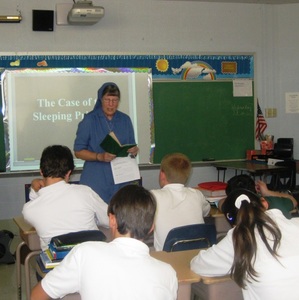 Some students use the classroom computer to print their homework because they don’t have a printer at home. Others need the computer for assistive technology to accommodate their learning needs. And yet others might use it to access an online dictionary and challenge a friend’s word during a heated Scrabble game. In all cases, students at Mother Seton School in northern Frederick County use technology in the classroom every day.
Some students use the classroom computer to print their homework because they don’t have a printer at home. Others need the computer for assistive technology to accommodate their learning needs. And yet others might use it to access an online dictionary and challenge a friend’s word during a heated Scrabble game. In all cases, students at Mother Seton School in northern Frederick County use technology in the classroom every day.
About Mother Seton School
Mother Seton School (MSS) is an independent Catholic school established by the Daughters of Charity in 1957. The School traces its roots back to St. Joseph Academy and Free School in Emmitsburg, which was founded 200 years ago by St. Elizabeth Ann Seton herself.
Today, MSS serves approximately 300 students in pre-k through eighth grade. The School is committed to St. Elizabeth Ann Seton’s legacy of providing Catholic education to students from families of diverse economic backgrounds, and as such, tuition is the lowest among all private schools in Frederick County.
From a Technology Grant…
With a grant from the Knott Foundation, Mother Seton School installed interactive ceiling mounted projectors in their remaining four classrooms without this equipment, purchased computer workstations for student use in each of the 16 classrooms, and provided staff development in instructional technology.
“The way I look at our school,” Principal Sr. JoAnne Goecke, D.C. shares, “is that it’s okay to take baby steps. The most important factor is to put real thought and planning into the purchases, and then to foster a culture among teachers of excitement and flexibility when it comes to new technology.”
To a Graduate Technology Course…
During the grant period, seven MSS faculty (which equates to one-third of their faculty) enrolled in a three-credit graduate course through Mount St. Mary’s University called “Integrating Technology into Instruction.” The course was offered on-site at the School. “We realized it would probably be more appropriate for the teachers in this building to have training using the technology they have here,” shares Laura Frazier, Ed.D., Assistant Professor of Education at Mount St. Mary’s University and MSS Technology Committee member.
To Technology Utilization in the Classroom
“The class inspired me to use more equipment and not be afraid of it,” one teacher who completed the course comments. Dr. Frazier adds that graduate instruction goes well beyond teaching the technology tools used in today’s classrooms: “We look at how each technology tool enhances student learning, and we talk extensively about instructional decision-making. Using technology for the sake of using technology is not a good reason to use technology,” she affirms.
Sr. JoAnne ends by offering a striking analogy to using differentiated technology tools in the classroom: “It’s somewhat like a chalkboard. Are you going to use colored chalk or plain white chalk? That was the question long ago. Today the question is, ‘What tools are we going to use to help the children facilitate their learning?’”
By Kelly Medinger
09-13-2012
Ballet Theatre of Maryland uses arts and humanities grant to build fundraising capacity
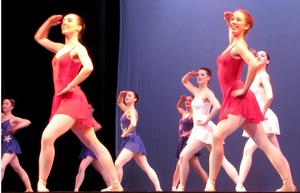 As the only professional ballet company in the state, Ballet Theatre of Maryland is a natural gateway into the world of dance for people of all ages. Each year the Ballet Theatre reaches more than 23,000 people through performances, contemporary and classical dance training, and outreach in schools.
As the only professional ballet company in the state, Ballet Theatre of Maryland is a natural gateway into the world of dance for people of all ages. Each year the Ballet Theatre reaches more than 23,000 people through performances, contemporary and classical dance training, and outreach in schools.
“We are a small organization doing as much as some large organizations,” shares Dianna Cuatto, Artistic Director. “Our success comes from our incredible team of people and the energy that they bring to our work – the dancers, board members, students, parents, and administrative staff,” she adds. It is not uncommon, for example, to find a dancer building and painting sets for an upcoming production.
Reaching Out to Donors
With support from the Knott Foundation, Ballet Theatre of Maryland hired a full-time Development Officer charged with structuring the organization’s fundraising efforts. During the grant period, the Development Officer raised approximately $60,000 in new and increased gifts by identifying new donors, initiating a scholarship program, increasing gifts to the annual fundraising appeal, and nearly doubling the profits from the annual gala.
“Her work allowed me to focus my time on new and exciting initiatives, such as our Point of Entry program,” explains Cuatto. The Point of Entry program invites people into the studio for an intimate experience with the ballet. They spend an hour meeting the dancers, mingling with board members, learning about the vision of the organization, hearing testimonials about educational outreach activities, and watching a live performance. Each attendee then leaves with two complimentary tickets to a future performance and a pledge card to commit their time, talent, or treasure to the organization.
Reaching Out to Schools
Meanwhile, Ballet Theatre doubled the number of school children reached through their educational outreach last academic year. This year they received grant support to implement a program for preschoolers, teaching the young children about creative movement and helping their teachers better integrate arts education into the preschool curriculum.
In the end, it is clear that the Ballet Theatre serves not only as a gateway into the world of dance, but into many different fields, such as art, literature and history. After seeing a piece focusing on Maryland history performed by the Ballet Theatre for the bicentennial celebration of the War of 1812, one child announced, “I really liked Dolley Madison… Can I be her?” Indeed, the Ballet Theatre became an avenue for this child to experience Maryland’s rich history through the world of dance.
By Kelly Medinger
09-13-2012
A summary of key similarities and differences between the nonprofit and for profit worlds of fundraising and sales
How does for-profit sales and marketing compare to the world of nonprofit fundraising?
While there are distinct differences, most notably in the "mission" vs. "bottom line" objectives, there are many similarities as well. Veteran fundraiser Tony Poderis highlights these similarities in his recent article, Sales Professional to Development Professional: A Workable Transition. Poderis' 35 years in fundraising and 19 years in sales and marketing for General Electric Company make his perspective especially noteworthy.
"It is unfortunate that far too few non-profit and non-government organizations see the close parallel between the role of a fund-raising professional in the non-profit community and a sales professional in the business world," comments Poderis. He cites the high demand for experienced development officers yet often shallow pool of candidates, and he points to interested sales professionals as a potential new source of talent for the fundraising profession.
Poderis' article includes a lengthy list comparing for-profit and nonprofit terminology, which is especially helpful for those considering a transition from sales into fundraising. For example, a "sales and marketing plan" becomes a "fund development plan" in the fundraising arena, and "market area" is referred to as "constituency."
Vocabulary aside, Poderis asserts that the professional who has sales experience in the for-profit world "will almost always have (or should have) a distinct advantage in being considered for a job in non-profit development."
By Kelly Medinger
09-13-2012
An insightful read about giving and getting results
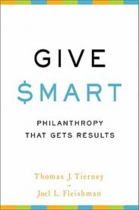 The basic premise of Give Smart is that philanthropists making smarter decisions achieve better results. And it is worth noting that achievement and results in the field of social impact come from a place of humility, not arrogance. The authors are quick to point out, "Having money is not the same as having answers."
The basic premise of Give Smart is that philanthropists making smarter decisions achieve better results. And it is worth noting that achievement and results in the field of social impact come from a place of humility, not arrogance. The authors are quick to point out, "Having money is not the same as having answers."
So, in the context of the complex world in which we live, how does one make "smarter decisions" that lead to these "better results"?
From my perspective, that question is one that we should ask of ourselves no matter our profession. What is my definition of success? Do I have what it takes to get the job done? Am I getting better? All of these questions are raised in Give Smart and are pertinent, I believe, in realms beyond philanthropy
By Kelly Medinger
07-09-2012
The Red Devils use health care grant to support breast cancer patients in need
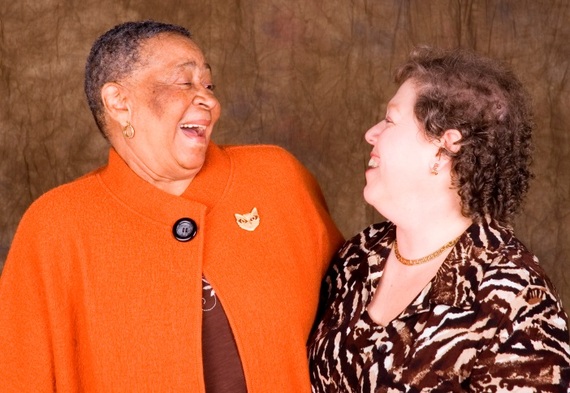 What does it mean to be a Red Devil?
What does it mean to be a Red Devil?
The name itself references the chemotherapy drug Adriamycin, commonly used in the treatment of a wide range of cancers including breast cancer.
It is also the title of Katherine Russell Rich’s spirited memoir about her own breast cancer treatment entitled The Red Devil: To Hell with Cancer and Back (Metheun, 2002). The book inspired the mother of breast cancer patient Jessica Cowling, and she later adopted the team name The Red Devils for the Susan G. Komen Race. When Jessica and her friend Ginny Schardt died of breast cancer, the organization The Red Devils was founded in their honor.
Serving Breast Cancer Patients throughout Maryland
Ten years later, The Red Devils serves nearly 700 breast cancer patients and their families each year. The organization’s geographic reach has grown from one hospital in Baltimore to 39 hospitals across Maryland. Notably, they are able to serve all of these patients with only two staff members and a network of hospital coordinators, namely nurses and social workers. “It’s a brilliant business model that was created by our founders and has served us well,” shares Janice Wilson, Executive Director, explaining that the organization dramatically limits its overhead by vesting certain decisions with professional staff at the hospital level.
The Knott Foundation has awarded The Red Devils $60,000 in operating support over the past five years, ultimately helping the organization grow from serving 500 patients in 2008 to nearly 700 in 2011. On average, The Red Devils provides each patient or family with $300 for critical needs, including transportation to treatment, family support, and medical costs.
Enhancing the Quality of Life
The support provided by The Red Devils enhances patients’ quality of life and promotes normalcy in a most traumatic time. “The Red Devils made it possible for survival. The pressure that I carried impacted my healing process. Your kindness and thoughtfulness gave me peace to heal,” commented one patient. Another simply stated, “I could not afford to go to my treatments without your support. You were a God send for me as I didn’t know what I was going to do.”
So what does it mean to be a Red Devil? It means a life-giving helping hand to someone in need. It means hope above despair. “Until there’s a cure for breast cancer, we need to be here,” Wilson concludes. “That’s why, for now, it’s great to be a Devil.”
By Kelly Medinger
07-09-2012
Timeframes for strategy development are reframed for the 21st century
In the world of strategic planning, it seems the term "long range" is being re-examined.
"With the accelerating rate of change, it's more important to be strategic in your planning than long range," shares nonprofit consultant Bill Hoffman. He argues that the five or ten-year strategic plan model is outdated in today's fast-changing environment, and that nonprofits need to adapt their approach to strategic planning to fit this new paradigm.
Hoffman's article, "Entering the New World of Strategic Planning," suggests a two-year plan with a midterm review as a new standard. He even proposes tying a strategic plan to a board chair's term, therefore giving that person more ownership of the process and implementation. The article goes on to provide four steps for developing a great strategic plan: (1) get input; (2) uncover themes; (3) agree on priorities; and (4) set measurable goals.
The importance of planning for the future will always be paramount. But as the future takes new shape each and every day, we will continually be challenged to adapt and respond to the world around us.
By Carol Hoffman
07-09-2012
Practical advice for giving for all ages
 I recently picked up A Kid's Guide to Giving by Freddi Zeiler.
I recently picked up A Kid's Guide to Giving by Freddi Zeiler.
Freddi was a normal 13-year-old. She went to school every day, came home, did her homework, played sports, and had dinner each night with her family. Meanwhile, watching the news on television she saw children who did not have the usual things in life she and most of her friends enjoyed. So, she started looking into how she could help children across the world who could not go to a doctor when they were sick, or did not go to school, or sometimes went to bed hungry.
Initially, Freddi decided she wanted to help by donating money from her piggy bank, but she didn't know where to start. She began doing research and learning whatever she could to find a cause she was passionate about. The result was this book, A Kid's Guide to Giving.
Freddi's advice, while geared towards children and teens, is an excellent introduction to charitable giving for any new donor. Through her work, Freddi discovered ways she could help beyond donating money, such as volunteering in a soup kitchen, picking up trash in a local park, helping an elderly neighbor, or teaching children how to play a sport.
Ultimately, this book is both heartwarming and practical for those who are interested in making a difference or simply learning about the many ways in which donors, volunteers, and nonprofit organizations improve our community.
By Kelly Medinger
05-15-2012
Sisters Academy of Baltimore uses education grant to support girls well beyond their years at the Academy
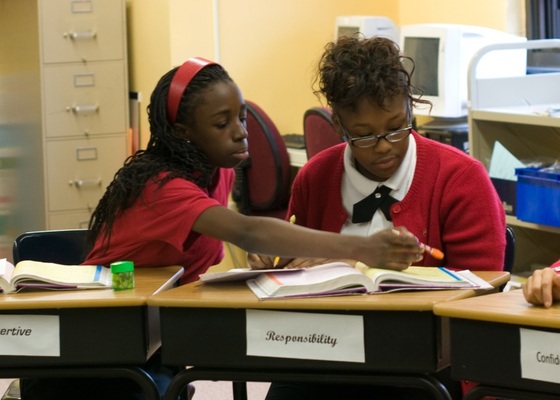 In 2004, four congregations of religious women came together to respond to the community’s call for an all girls’ tuition-free middle school in southwest Baltimore. The result was Sisters Academy of Baltimore – founded by the School Sisters of Notre Dame, Sisters of Bon Secours, Sisters of Mercy, and Sisters of Notre Dame de Namur – which now serves 63 girls in grades 5-8.
In 2004, four congregations of religious women came together to respond to the community’s call for an all girls’ tuition-free middle school in southwest Baltimore. The result was Sisters Academy of Baltimore – founded by the School Sisters of Notre Dame, Sisters of Bon Secours, Sisters of Mercy, and Sisters of Notre Dame de Namur – which now serves 63 girls in grades 5-8.
Working Together to Foster a Welcoming Spirit
“It has been a once in a lifetime opportunity, to work together as educators and begin something from nothing,” comments Delia Dowling, SSND, President. She describes the collaborative effort of the four congregations of sisters as “the wave of the future and the Church,” in that religious communities are “stepping beyond themselves” to help meet unmet needs in the world. In Sisters Academy’s case, the needs are especially poignant: the students primarily come from west and southwest Baltimore, low-income neighborhoods where nearly half of the adult population has less than a 12th grade education.
A welcoming spirit embodies the Academy. Every morning, the girls begin their day in the gathering space for prayer. One empty chair always sits in the corner. “It is there to show that we always have room for someone else, that we will always welcome a newcomer,” explains Kafui Anthony, an 8th grade student.
The Knott Foundation’s Deeply Rooted Support
Since Sisters Academy opened eight years ago, the Knott Foundation has provided $130,000 to the school in grant support, most recently awarding $40,000 in October 2010 to support three priorities – the graduate support program, technology instruction, and salaries for masters-level teachers.
The graduate support program is integral to Sisters Academy’s graduates’ success, helping them in the selection and application process for high school and college while also guiding them through life after Sisters Academy. Notably, during the grant period, all fifteen 8th graders were accepted to Catholic high schools and received adequate financial aid to attend. In addition, 2012 marks a special year for the school with its first class of alumnae finishing high school. These 10 young women have been accepted to such colleges as Notre Dame of Maryland University, Stevenson University, Saint Joseph’s University in Philadelphia, and Lebanon Valley College in Annville, Pennsylvania.
The Knott Foundation’s recent grant also supported the development of an integrated technology curriculum plan with specific learning goals by grade level. This planning helped, in part, to leverage $53,000 more in technology funding from sources such as the Abell Foundation and the University of Maryland BioPark.
Meanwhile, the grant supported two teachers who completed Operation TEACH, a post-graduate service program offered through Notre Dame University of Maryland where teachers earn their master’s degree while working in local Catholic schools. “In addition to developing capable and committed teachers, the program gave me a large teacher support system that doesn’t always exist in schools,” comments Regina Fabbroni, an Operation TEACH graduate who now teaches mathematics and social studies at Sisters Academy.
Transformative Education at its Best
In the end, Sisters Academy is about transforming girls’ lives, one at a time. One student who experienced particular hardships during her time at the Academy recently wrote to Sister Delia: “I look at where I am in my life today – the opportunities I have and doors that are opening up for me, and I ask myself ‘why me?’ …When I analyze just what was the pivotal factor in my life that set my success in stone – I know it was me attending and graduating from Sisters Academy.”
And so Sisters Academy’s mission of empowering girls to become agents of transformation in their families, communities, and society continues each day, with an open chair and a welcoming spirit for all who enter the school.
By Kelly Medinger
05-15-2012
Gilchrist Hospice Care uses health care grant to support pediatric hospice
 “To live – that’s really what we’re about. We don’t focus on the dying. We focus on enjoying what time remains,” declares Brenda Blunt, Gilchrist Kids Program Manager.
“To live – that’s really what we’re about. We don’t focus on the dying. We focus on enjoying what time remains,” declares Brenda Blunt, Gilchrist Kids Program Manager.
Gilchrist Hospice Care is the largest hospice provider in Maryland and serves 600 patients every day. Gilchrist Kids is a special program that serves pediatric patients. “One of the reasons we deliberately called the program ‘Gilchrist Kids’ and even created a different logo than the one used for our adult program is so that families didn’t have to see the word ‘hospice’ every day,” explains Brenda. Understandably, hospice is associated with the end of life and represents an especially difficult development for any family whose child is suffering from a terminal disease.
A Founding Supporter of Gilchrist Kids
The Knott Foundation was one of the founding supporters of the Gilchrist Kids program when it began in 2010. During the grant period, Gilchrist Kids grew from serving 4 patients to 15 patients per day.
The patients are most often referred from pediatric units at large Baltimore area hospitals such as Johns Hopkins, University of Maryland Medical Center, and Sinai Hospital. Approximately half of them have cancer, while the other half suffer from conditions including congenital anomalies, degenerative neurological diseases, AIDS, traumatic injuries, end-stage organ diseases, or rare genetic disorders.
Kids Just Want to Be Kids
Even though they are ill, most of the pediatric patients “still just want to be kids,” says Brenda.
So Gilchrist’s strong corps of volunteers helps each family to maintain a happy home life and sense of normalcy. A volunteer might decorate a child’s bed, bake cupcakes for school, cook dinner for the family, or even walk the family dog.
Beyond these volunteer efforts, the professional support Gilchrist Kids provides to families is exceptionally comprehensive: 24-hour on-call nursing visits; pain and symptom management; healthcare benefit navigation assistance; medication and medical supply delivery to the home; a child life specialist to work through complicated emotions with parents and siblings; bereavement support; and family and community outreach and education.
Pediatric Hospice Care – A Specialized Operation
It is important to note that the financial burden of running this type of comprehensive program is not light. Gilchrist Kids employs a team that includes a medical director and two medical consultants to oversee the staff: a neonatologist, a pediatric oncologist, and a general practice pediatrician, all with very specialized knowledge.
Moreover, their team of nurses, aides, counselors, and volunteers must travel to each child’s home to provide care. When compared to adults, it is estimated that these visits to pediatric hospice patients are twice as frequent and last twice as long.
The price of pediatric equipment is also very high – a pediatric hospice bed, for instance, can cost $12,000, and specially designed chest vests that help with breathing and secretions are $15,000. To help cover the multitude of uncompensated costs that arise, Gilchrist Kids must raise up to $200,000 every year.
Helping Those Who Need It Most
Yet all of these resources are priceless to each patient and family in the program. Brenda recalls one baby that Gilchrist Kids recently served:
When the baby was born, they didn’t expect him to go home. Two days later, the mom was ready to be discharged but she didn’t want to leave the baby in the NICU. She and her husband decided to call Gilchrist Kids, and we helped them bring their baby home. A couple days later, the mom said to us, “Wow, this is kind of fun – being a parent.” It turns out they had not prepared for being just “mom and dad.” They were first-time parents and were very grateful for all the help the nurses were providing, including education on normal baby care and how to bond with your baby. In the end, their baby lived for 12 days. When he died, the mom hugged me and whispered, “Thank you for taking something that could have been so horrible, and for making it not be.”
And that is the power of Gilchrist Kids: focusing on life and celebrating it until the very end.
By Kelly Medinger
05-04-2012
Catholic Community at Relay uses Catholic activities grant to create a new entrance to their church
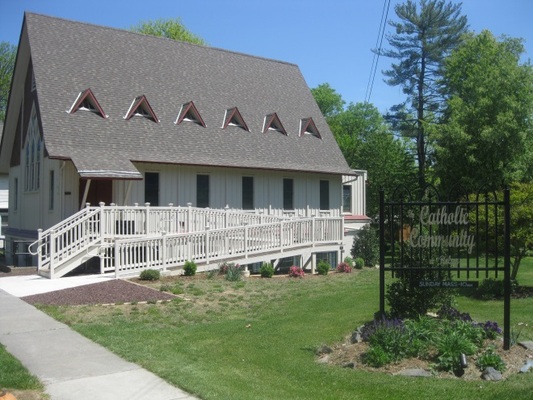 On the day of First Holy Communion, friends and family of the Catholic Community at Relay bounded up the steps to the small church to see their children, grandchildren, and even great grandchildren receive this important sacrament. Yet not all family members were able to climb the stairs, so some used the newly constructed ramp leading to the church’s entrance.
On the day of First Holy Communion, friends and family of the Catholic Community at Relay bounded up the steps to the small church to see their children, grandchildren, and even great grandchildren receive this important sacrament. Yet not all family members were able to climb the stairs, so some used the newly constructed ramp leading to the church’s entrance.
Building the Ramp
As with any church built in 1880, the Catholic Community at Relay (CCR) was peppered with steps and narrow passages until they embarked on a major renovation project to make the church more accessible to those with disabilities. The Knott Foundation helped fund the construction of a ramp leading up to the church’s entrance, which provides people in wheelchairs, with walkers, on crutches, or even those pushing strollers easy access to the worship space.
“A large part of my healing is being back in my faith community,” lifelong CCR member, Elise Cole, proclaims. Due to a knee injury, the young mother of three has relied on crutches for nearly a year, so she is especially grateful for the ramp.
In addition to solving a physical access issue, the construction project served as a community building experience for CCR. All 100 households belonging to the faith community, representing more than 250 individuals in total, contributed volunteer time and/or financial resources to the effort. Notably, CCR exceeded its fundraising goal for the work by 30%. And one CCR member even recruited a local Boy Scout to undertake the landscaping and hardscaping surrounding the new ramp as his Eagle Scout project.
Being an Intentional Eucharistic Community
CCR is an intentional eucharistic community located in the historic village of Relay, Maryland. It is ecclesiastically approved by the Archdiocese of Baltimore but different than a traditional parish. Visiting priests, usually from religious orders such as the Franciscans, Jesuits, or Trinitarians, celebrate mass on Sunday. Beyond that, each member of the community takes full responsibility for running CCR. “An underlying theme is that every member has a vested interest in the church. We are all responsible, from managing the finances, to emptying the trash, to cleaning the church. Volunteerism is something we see in every aspect of what we do,” states Greg Bean, CCR member.
Connie Maas, CCR member, concludes: “The words ‘faith community’ really sum it up. We are bounded by our faith, and we work together as a family to support each other, our own spiritual growth, and our commitment to actively carry out the message of Christ.”
By Kelly Medinger
05-04-2012
A look at the financial contribution board members make across the nonprofit sector
As a funder, we place a high level of importance on seeing 100% of board members contribute personally to a nonprofit.
Board members' involvement in fundraising plays a significant role in a nonprofit's fundraising success. In a recent article entitled "Majority of Nonprofits Reached Fundraising Goals in 2011," the Chronicle of Philanthropy's Raymund Flandez reports how charities were able to increase their funding in 2011: "Most nonprofits attributed their success to taking advantage of online fundraising tools, relying on diverse sources of money, and encouraging their board members to take their role as fundraisers more seriously."
Part of being a serious fundraiser is committing personally to a cause. Consequently, it is interesting to note that an April 2012 report published by the Nonprofit Research Collaborative found that:
- 35% of nonprofits set a minimum figure for a required donation by board members. The average amount required was $5,000.
- Arts and culture groups were most likely to require a minimum gift (57% did so), whereas religious groups were the least likely to impose such a requirement.
- Education groups requested the highest gift amount from board members, while human service groups requested the lowest.
For a visual snapshot of this data, click here. And, for further reading on the importance of board members' personal giving, check out Bridgestar's rationale.
By Kelly Medinger
05-04-2012
A look at the Speak Up 2011 national findings
A recent survey asked school administrators what keeps them up at night. The top responses were "adequate funding" and "staff morale." But the next response, above even "communication with parents," was "the use of technology in instruction."
Does technology keep you up at night? Do you have the data you need to create and inform technology initiatives for 21st century learning that meet students' expectations and needs? Enter Project Tomorrow and the Speak Up National Research Project.
In fall 2011, over 416,000 K-12 students, parents, teachers, and administrators participated in the online Speak Up survey administered by Project Tomorrow, a national education nonprofit group. The data from this survey is used to inform policy leaders at the national and state levels while also providing individual schools and school systems with a better understanding of issues important to students, parents, and educators about the role of technology for learning in and out of school.
Of particular interest in the Speak Up 2011 National Findings:
- 1 in 10 students in grades 6-12 have sent out a Tweet about an academic topic that interests them.
- 30% of middle school students and 46% of high school students have used Facebook as an impromptu collaboration tool for classroom projects.
- Almost two-thirds of parents (62%) say that if their child's school allowed the use of mobile devices for instructional purposes, it is likely that they would purchase such a device for their child to use at school. This view was nearly identical in low-income (Title 1) and non-Title 1 schools.
Click here to read a full copy of the report. And, if your school is interested in participating in the next Speak Up survey and receiving free access to the findings, please check the Speak Up website this fall when new survey data will again be collected.
By Kathleen McCarthy
05-04-2012
Keeping up in today's outcomes-based world
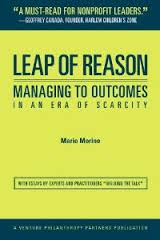 In the field of philanthropy, as in any industry, buzzwords come and go. One year a needle is moved and the next, an impact is leveraged.
In the field of philanthropy, as in any industry, buzzwords come and go. One year a needle is moved and the next, an impact is leveraged.
Most recently the buzz is loudest around the word "outcomes" and, based upon a reading of Leap of Reason by Mario Marino, the buzz is here to stay... and for good reason.
I will admit that I approached the book with an arched brow and a pit in my stomach, as I was imagining a treatise on expensive IT systems and the need to collect granular levels of quantitative data. By the end of this collection of essays, however, I was reassured by Marino and the other authors' honesty and willingness to clearly convey why this work is so important to the communities we seek to serve. Without the hard work of managing to outcomes, how can we say if our work is smart work -- work that is truly impacting our missions?
The book emphasizes that this work does not demand expensive data collection systems and complicated logarithms to be meaningful; in fact, small may not only be beautiful, but if carefully designed and clearly articulated, it can be impactful as well. An organization's ability to manage to outcomes largely rests on its willingness to do the hard work required, ask the tough questions, and commit to understanding just why we are doing what we are doing.
By Kelly Medinger
03-15-2012
Second Chance uses human services grant to turn lives around
 52,000 labor hours created. $3.2 million consumer dollars saved. 11 million pounds of landfill waste diverted. And that was just in one year!
52,000 labor hours created. $3.2 million consumer dollars saved. 11 million pounds of landfill waste diverted. And that was just in one year!
Founded in 2001, Second Chance provides people, materials, and the environment with “a second chance.” The organization deconstructs buildings and homes, salvages usable materials, and then sells them to the public. The sales proceeds funnel into their workforce development program, which provides job training and placement to those with employment obstacles in the Baltimore region.
Turning Job Training Into Social Benefit
“It was hard to fully appreciate the social benefit of what we do until the first four guys graduated from our job training program,” Mark Foster, Founder and Executive Director, says with emotion in his eyes. “Then I saw what it actually meant – to watch four guys completely turn their lives around.”
Yet the turn is not an easy one. Job trainees must pass a rigorous two-week evaluation and qualifying period, which includes life and safety skills development, and then embark on 16 weeks of on-the-job technical instruction in how to use numerous types of power tools, hand tools, and equipment. Upon completion of the program, qualified trainees receive additional, specialized training in lead abatement and other hazardous materials removal and handling, as well as forklift operation. And those motivated to advance further can go on to receive certificates in carpentry, restoration, manufacturing, plumbing, electrical and masonry. In the end, trainees are placed in green jobs at companies such as Hirsch Electric and Waste Management System.
Expanding All Under One Roof
With funding from the Knott Foundation, Second Chance expanded the capacity of its job training program from 10 new trainees in 2010 to 30 in 2011, and they grew to reach more than 50 in 2012. Even more impressive are the outcomes from the program: During the grant period, for example, Second Chance boasted a 100% graduation rate. Every graduate was placed into a green job, and 97% remained in their jobs after one year. Moreover, ten workforce trainees were promoted, resulting in a combined annual pay increase of $52,000.
Second Chance’s new headquarters located at 1700 Ridgely Street in South Baltimore has brought the organization’s retail operations, job training program, and central office all under one roof – a meaningful achievement for the growing nonprofit and social enterprise. “The general public comes to Second Chance to shop in the warehouse for home furnishings, architectural salvage materials, building materials, and kitchen and bath elements,” shares Foster. “What they may not know is the whole story of our organization – what we accomplish for the universal good of us all.”
By Kelly Medinger
03-15-2012
Learning about people to improve employee selection and team performance
What types of behavioral traits are you looking for in your next hire, and how do you know when you've found that person?
What is a Behavioral Assessment?
Behavioral assessments (also called personality tests or predictive evaluations) are increasingly being used in the business sector for hiring, team building, professional development, leadership identification, coaching, and conflict resolution. This practice recognizes that hiring is about more than finding a qualified candidate for a slot -- it is about finding a "multi-level match," according to the wisdom of Dr. Todd Harris, director of research at the human resource consulting firm PI Worldwide. A "multi-level match" is described as the ideal fit between a person, a job, a supervisor, a company or organizational culture, and the surrounding community.
How Can it be Used?
An effective use of behavioral assessments begins with an understanding of the roles within an organization and what types of people are most successful in those roles -- that is, the specific behavioral characteristics of a good executive director, finance person, development professional, social worker, or database administrator. Once these roles and characteristics are defined, it is possible to use behavioral assessments to test job candidates against the desired behavior pattern. For example, a development director may need to proactively connect quickly with others and also be able to enthusiastically persuade and motivate others. These desired traits would be revealed in a behavioral assessment.
Who are Some Behavioral Testing Resources?
A recent article by Kay McFadden on Inc.com entitled "7 Tips for Using Personality Tests to Hire," explores various reasons to consider using behavioral assessments in a company or organization. McFadden points out that they often add perspective, balance, and fairness to the hiring process. She also mentions resources such as Hire Success and PI Worldwide's Predictive Index System, noting that many testing consulting agencies now tailor their products especially for small businesses.
In the end, when combined with interviewing, reference checks, and work samples, a behavioral assessment can help answer the question: Will this person be successful in the role I have defined for them, and will this person fit within our organizational culture? Are you trying to answer this question at your own organization? If so, it may be worthwhile exploring the use of behavioral assessments in your employee selection, retention, and professional development efforts.
By Kelly Medinger
03-15-2012
Harnessing the emotional elephant in the room
 Switch: How to Change Things When Change Is Hard offers practical advice for how to appeal to both our rationale and emotional sides in order to affect change, be it changing the world or simply changing a bad habit.
Switch: How to Change Things When Change Is Hard offers practical advice for how to appeal to both our rationale and emotional sides in order to affect change, be it changing the world or simply changing a bad habit.
Of particular note was the chapter entitled "Shrink the Change," where the authors recommend focusing on small milestones that are attainable and visible, rather than on the eventual destination, which may seem very remote. This approach is especially relevant to the nonprofit sector, where many are working towards large-scale change yet can fuel their motivation by celebrating small-scale successes along the way.
In the end, Switch introduces a pattern for successful change through an engaging and story-driven narrative. A great read all around!
By Kelly Medinger
01-03-2012
Friends of Patterson Park uses cash flow loan to boost operations
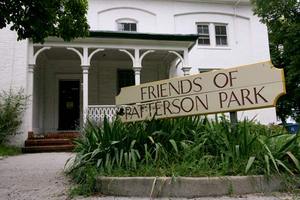 You might see them in chest waders scooping debris out of the lake with pool skimmers. Or mulching trees. Or inspecting playground equipment for safety. In all cases, the Friends of Patterson Park will be helping to steward the resource that is near and dear to their hearts: Patterson Park.
You might see them in chest waders scooping debris out of the lake with pool skimmers. Or mulching trees. Or inspecting playground equipment for safety. In all cases, the Friends of Patterson Park will be helping to steward the resource that is near and dear to their hearts: Patterson Park.
The Past and the Present
The first known resident of what is now Patterson Park arrived in 1669. A lot has happened in the last 340 years, and now Friends of Patterson Park, which was founded in 1998, is working with more than 600 volunteers to preserve and enhance all that the Park offers.
Kathy Harget, who joined Friends of Patterson Park as the new Executive Director in the summer of 2011, sees how the mission extends beyond the physical space: “The green spaces in our city are a perfect connector to bring neighborhoods together. Hosting the right programs can attract a whole lot of diverse people who otherwise may not have met each other.”
Transition to the Future
The Knott Foundation stepped in to help Friends of Patterson Park in late 2011 through a Program-Related Investment (PRI). PRIs, also referred to as cash flow loans, provide nonprofits with access to capital at lower interest rates and at shorter turnaround times than might otherwise be available. For Friends of Patterson Park, some of their fundraising activities, including a major event for corporate donors, had been delayed with the leadership transition, so the organization needed a boost to carry them through the fall.
The result? Friends of Patterson Park received a $25,000 loan from the Knott Foundation. With
sufficient financial footing, they were able to meet or exceed all of their fundraising goals, including hosting a corporate fundraiser that brought in $10,000 more than budgeted; receiving increased
annual grants from two foundations; exceeding individual giving goals with the help of the State’s tax credit program; and meeting a $15,000 matching grant from the Meyerhoff Foundation in just 45 days. The year finished with a cash surplus, and the Friends paid the loan back to the Knott Foundation early.
“This is a new chapter in the history of the Friends of Patterson Park,” states Harget. Indeed it is, and the Knott Foundation is honored to be a part of it.
By Kelly Medinger
11-15-2011
Meals on Wheels of Central Maryland uses human services grant to feed the hungry and homebound
Imagine if your shopping list included 1,250 lbs. of meat. Every day. That is the reality for Meals on Wheels of Central Maryland, the largest and longest continually operating Meals on Wheels program in the country.
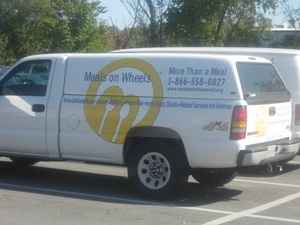 Feeding Those in Need
Feeding Those in Need
The central mission of Meals on Wheels is to feed those in need. Every day, more than 250 committed volunteers deliver a hot lunch and refrigerated dinner to approximately 1,500 people living in the Metro Baltimore area. These include the elderly and chronically disabled, as well as the temporarily disabled, such as those on bed rest during pregnancy or recovering from major surgery. Many times, the client’s only social contact outside the house is the Meals on Wheels volunteer who comes to visit each day during the week.
Fostering Life-Saving Relationships Between Volunteers and Clients
In fulfilling its core mission, Meals on Wheels is often so much more than just a conduit for sustenance – it’s a lifeline to the homebound. On Labor Day this year, a Meals on Wheels driver was delivering lunch and dinner to a woman living at home in a wheelchair. When he arrived at her house, she did not answer the door, and he could hear her crying out for help from inside the house. She had fallen out of her wheelchair on Saturday, and when he found her on Monday, she had gone 48 hours with no food, no water, and no ability to move or reach a phone to call for help. “The sad truth is that she probably would have died there, had it not been for Meals on Wheels,” relates Barbara Levin, Client Services Director.
“The volunteers and clients become quite attached to each other,” explains Ellen Falk, Volunteer Retention and Recruitment Coordinator. Volunteers often shop for clients, bring in their mail, take out the trash, and talk to them about their families. After excitedly telling clients about her daughter’s upcoming wedding, one volunteer brought her daughter and the wedding pictures on her route to share with clients. Then there is the exceptionally dedicated gentleman who volunteers all five days a week. He recently retired, and his wife of nearly 60 years told him he “needed to get out of the house and find something productive to do with his time.” Thank goodness for Meals on Wheels!
Starting in the Kitchen
Yet the good work that Meals on Wheels does out in the community starts inside the warehouse kitchen. In 2010, the Knott Foundation awarded a grant to meet a funding challenge from the France-Merrick Foundation, which enabled the organization to purchase a Cook-Chill System.
This impressive piece of machinery cooks large quantities of food and then chills it immediately. Meals on Wheels uses it to cook almost anything, most recently discovering that it is both cheaper and healthier to cook beans in the Cook-Chill System instead of purchasing the higher-sodium canned varieties. “And the best part is,” shares Kathleen Tinker, Food Services Manager, “the system can even cook overnight when no one is here.”
Meeting Ever-Growing Needs
Even with these advances, Meals on Wheels is still faced with the daunting task of meeting growing needs. With the aging population, the organization is projecting an explosion of demand over the next ten years. “The goal is to double the number of clients served by 2020,” states Toni Gianforti, Grant Writer.
The Cook-Chill System is one way they are increasing their capacity to produce more meals. Another way is through a new tray sealing process, funded by a $100,000 grant from The Walmart Foundation and the Meals on Wheels Association of America. Notably, the grant required a quick turnaround of a 10% match, and the Knott Foundation provided the initial $1,000, with the Board pledging the remaining $9,000. “The Knott Foundation provided the weight and leverage we needed to secure the rest of the funds,” Gianforti adds.
Thus, with an impressive history in Maryland and an ambitious charge for the future, Meals on Wheels continues to help homebound people eat well, live independently, and enjoy peace of mind.
By Kelly Medinger
05-20-2011
St. Francis Neighborhood Center uses education grant to empower students
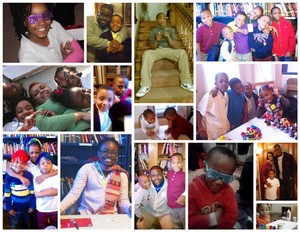 When Shawn came to St. Francis Neighborhood Center two years ago, he was failing the fourth grade. He was a bully at school. And he was generally angry at the world and uncomfortable in his own skin. What he needed was to be given back the power to choose his own direction in life – essentially, the mission of The Power Project, a youth development program at St. Francis.
When Shawn came to St. Francis Neighborhood Center two years ago, he was failing the fourth grade. He was a bully at school. And he was generally angry at the world and uncomfortable in his own skin. What he needed was to be given back the power to choose his own direction in life – essentially, the mission of The Power Project, a youth development program at St. Francis.
The Power Project
The past two years in The Power Project have helped Shawn to regain his self-confidence. Surprisingly, he now breezes through his math lessons, thanks in part to his mentor in The Power Project, a Ph.D. candidate in mathematics at Johns Hopkins University.
The Power Project began two years ago with a $30,000 grant from the Knott Foundation and recently received $45,000 from the Foundation earlier this year. With 30 children, the program operates at full capacity and has a waiting list.
“Power is truly the formative word in this program,” shared Sarah Tarighi Murphy, Executive Director. At The Power Project, the Center’s staff works with each child and his or her family to develop a Power Plan to identify a child’s Power Goal (their ultimate life goal; i.e., “I want to be a teacher”), short-term and long-term objectives, and the resources needed to achieve their goals. Participants even eat a Power Snack – a healthy meal that the children prepare alongside volunteers once a week.
A Cornerstone of Reservoir Hill
For almost 50 years, St. Francis Neighborhood Center has been a cornerstone of Reservoir Hill in Baltimore City. Founded by two Catholic churches in 1963 – both aptly named St. Francis – the Center began as a Catholic outreach ministry where young Jesuit priests were assigned to work. Enter Father Tom Composto in 1965.
Father Tom became the lifeblood of St. Francis Neighborhood Center. “He gave the word ‘service’ meaning,” declared Murphy. “He lived it with every action and every word.” Indeed, Father Tom was closely connected to the people of Reservoir Hill and kept his promise to serve them every day of his life.
Sadly, on March 16, Father Tom passed away at the age of 72. More than 100 people attended his funeral in the chapel of St. Francis Neighborhood Center, with crowds spilling out onto the porch, into the street, and down the entire block. Tom Hall, a resident of Reservoir Hill, voiced a touching tribute to Father Tom on NPR’s Maryland Morning: “He’s not an ordinary man who did extraordinary things… He’s an extraordinary man who did ordinary things.”
Leadership in Transition
Sarah Tarighi Murphy currently serves as the Executive Director of St. Francis Neighborhood Center. After initially pursuing a career in the advocacy and public policy arena, she felt instinctively drawn to the positive and powerful feeling inside the walls of the Center. Through her work, she witnesses how people change themselves every day as a result of the Center’s mission.
Being a young leader in the Baltimore nonprofit community, Murphy was honored to participate in the first cohort of the Leaders Circle, which the Knott Foundation founded in 2009 in partnership with Maryland Nonprofits and University of Baltimore. The Circle consisted of nine Executive Directors who met monthly to problem-solve and share stories. “It was amazing how so many different people from different organizations were dealing with the same issues,” expressed Murphy.
So, under bright new leadership, the mission of St. Francis Neighborhood Center to break the cycles of poverty continues. And Father Tom’s legacy lives on in the seemingly ordinary, yet heroic, work that is done. And Shawn, in The Power Project? He is finally able to just be a kid.
By Kelly Medinger
05-15-2011
Civic Works uses human services grant to enhance Real Food Farm
“Compost! Wood chips! Hoses!” 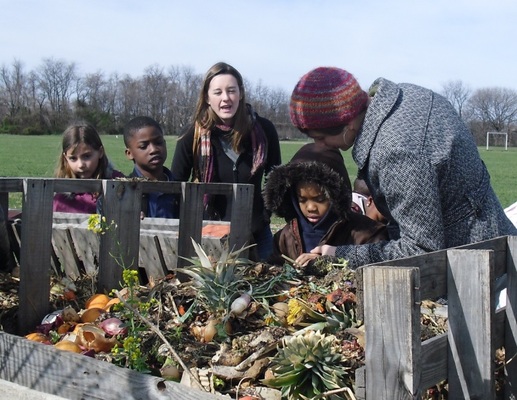
It took three tries for the fifth-grade students from Baltimore City’s Green Charter School to identify a component of Real Food Farm that actually cost the organization money. Tyler Brown, or “Farmer Brown” as he is called by the kids, shared that Whole Foods and other companies deposit their trash at Real Food Farm to serve as composting material. And the wood chips came from a tree company that otherwise would have taken them to the dump. But the hoses, well, those did cost money.
Fueled by Volunteers
Real Food Farm is a project of Civic Works, an organization focused on giving people meaningful opportunities to serve their community. The Knott Foundation has supported Civic Works for a number of years, most recently awarding a $50,000 grant to the Real Food Farm Project in 2010.
From farming, to tutoring and mentoring, to learning how to construct a green, energy-efficient roof, Civic Works acts as a bridge between human capital and community needs. While the majority of volunteers are in the 17-24 age range, the organization also employs elementary-age and senior volunteers, and they come from many different parts of the country.
Building Hoop Houses on Real Food Farm
On a sunny April afternoon amongst fields of freshly planted garlic, onion, carrots, and spinach (and four scarecrows!), a group of high school volunteers from Detroit was helping to build a hoop house. A hoop house is basically a low-cost greenhouse. Real Food Farm has five hoop houses and hopes to grow that number to 20 in the future. The hoop houses allow the Farm to cultivate fruits and vegetables year-round and therefore provide fresh produce to the communities of South Clifton Park, Darley Park, Belair-Edison, and Coldstream-Homestead-Montebello on a regular schedule.
Civic Works recently received a van that will be painted to feature Real Food Farm’s mobile produce market. “The great thing about the Farm is that it not only provides fresh, organic produce to the local community, but it also reduces the transportation costs for the goods and provides an educational platform for kids to see how fruits and vegetables are grown and how they can be prepared in healthy meals,” stated Earl Millett, Director of Volunteer Services.
About Civic Works
Founded in 1993, Civic Works is headquartered in Clifton Mansion, a structure dating back to the late eighteenth century that is still being carefully restored by Civic Works and the Friends of Clifton Mansion. With additional resources, Civic Works plans to further renovate the Mansion in order to enhance its programs. Even Real Food Farm would be able to use a renovated kitchen to expand its cooking classes, since not all residents of the neighborhood are familiar with how to prepare fresh produce and preserve the nutrients.
In the meantime, it seems that Civic Works is still operating at full capacity, and the volunteers just keep calling. So many volunteers, in fact, that Millett explained he sometimes must find alternative opportunities for them with organizations such as Habitat for Humanity, Blue Water Baltimore, Paul’s Place, Baltimore Reads, or Baltimore City Recs and Parks.
If you call and happen to have any garden hoses, however, Civic Works will take them.


 I began at the Knott Foundation, my first foundation job after a career in the nonprofit sector, just a few months ago. When I learned that the Foundation's blog has a column on what the staff is reading, I wanted to select a book that would explore the idea of philanthropy and giving. I am doing lots of learning on policies, practices, and the way foundations carry out their important work, but what about why we are drawn to philanthropic work? Every day we have the privilege of engaging with people in the nonprofit field giving their time, resources, and mental energy to help others. I picked this book to dig into what generosity means and how it manifests in one's life in ways big and small.
I began at the Knott Foundation, my first foundation job after a career in the nonprofit sector, just a few months ago. When I learned that the Foundation's blog has a column on what the staff is reading, I wanted to select a book that would explore the idea of philanthropy and giving. I am doing lots of learning on policies, practices, and the way foundations carry out their important work, but what about why we are drawn to philanthropic work? Every day we have the privilege of engaging with people in the nonprofit field giving their time, resources, and mental energy to help others. I picked this book to dig into what generosity means and how it manifests in one's life in ways big and small.  h notably lower than Maryland’s public school turnover rate of 18%, the 12.82% turnover rate in AOB Catholic schools is only slightly higher than the national average and cannot be ignored. Estimates place the cost of teacher turnover somewhere between $9,000 to $21,000 per teacher. While less quantifiable, rapidly changing social contexts including growing disaffiliation from religious practice among the population mean that it is harder to find teachers who, while not required to be Catholic, share the same mission as that of the schools' which is to “provide a Christ-centered education that is academically excellent and empowers students to reach their full potential –spiritually, intellectually, physically, socially, and morally.”
h notably lower than Maryland’s public school turnover rate of 18%, the 12.82% turnover rate in AOB Catholic schools is only slightly higher than the national average and cannot be ignored. Estimates place the cost of teacher turnover somewhere between $9,000 to $21,000 per teacher. While less quantifiable, rapidly changing social contexts including growing disaffiliation from religious practice among the population mean that it is harder to find teachers who, while not required to be Catholic, share the same mission as that of the schools' which is to “provide a Christ-centered education that is academically excellent and empowers students to reach their full potential –spiritually, intellectually, physically, socially, and morally.”
 As we emerge from the COVID-19 pandemic, it is clear that the country continues to face challenges finding workers to fill open positions. A recent study by the Chamber of Commerce found that Maryland is one of twelve states facing a “most severe” crisis filling open positions, with 44 available workers for every 100 jobs.
As we emerge from the COVID-19 pandemic, it is clear that the country continues to face challenges finding workers to fill open positions. A recent study by the Chamber of Commerce found that Maryland is one of twelve states facing a “most severe” crisis filling open positions, with 44 available workers for every 100 jobs.
 “Kelley Kilduff’s long career with institutions that underscore and strengthen Catholic values will be a terrific asset for our family foundation as we continue the work my parents began over 45 years ago. Her energy and enthusiasm for our mission, along with her accomplished history and leadership experience, will carry us forward in the years to come,” Knott said.
“Kelley Kilduff’s long career with institutions that underscore and strengthen Catholic values will be a terrific asset for our family foundation as we continue the work my parents began over 45 years ago. Her energy and enthusiasm for our mission, along with her accomplished history and leadership experience, will carry us forward in the years to come,” Knott said. We are pleased to announce the publication of our
We are pleased to announce the publication of our 
 After graduating from Boston College with a degree in business and economics, Codie Perry knew two things: first, he wanted to use his educational background to serve others; and second, he didn’t want to sit in a cubicle all day. Perry applied to Jesuit Volunteer Corps and was placed at St. Vincent de Paul Church in Baltimore City. There, he was charged with running the Church’s outreach ministries in a community experiencing deep poverty.
After graduating from Boston College with a degree in business and economics, Codie Perry knew two things: first, he wanted to use his educational background to serve others; and second, he didn’t want to sit in a cubicle all day. Perry applied to Jesuit Volunteer Corps and was placed at St. Vincent de Paul Church in Baltimore City. There, he was charged with running the Church’s outreach ministries in a community experiencing deep poverty.  Our longtime Executive Manager, Carol Hoffman, retired this summer after 28 years of service to the Knott Foundation, and nearly 50 years with the Knott family! Carol has been a familiar face at the Foundation’s office for decades, always leading with kindness and grace. We are excited for her to enjoy this next phase of her life, and we thank her for her many contributions to the Foundation over the years. She will be dearly missed!
Our longtime Executive Manager, Carol Hoffman, retired this summer after 28 years of service to the Knott Foundation, and nearly 50 years with the Knott family! Carol has been a familiar face at the Foundation’s office for decades, always leading with kindness and grace. We are excited for her to enjoy this next phase of her life, and we thank her for her many contributions to the Foundation over the years. She will be dearly missed! I had a hard time selecting a book to read for the purposes of this blog post, and I think that it had a lot to do with being distracted. Like so many others, I find myself increasingly distracted; consumed by an overabundance of tasks, information, and obligations, so that taking a moment to select and read a book felt like a great indulgence.
I had a hard time selecting a book to read for the purposes of this blog post, and I think that it had a lot to do with being distracted. Like so many others, I find myself increasingly distracted; consumed by an overabundance of tasks, information, and obligations, so that taking a moment to select and read a book felt like a great indulgence. I am pleased to announce the publication of our
I am pleased to announce the publication of our  “Conservation and repair of our collective cultural heritage is key to our understanding of world history and the universal human need to create,” observes Julie Lauffenburger, Director of Conservation, Collections, and Technical Research. “Works of art that have been preserved and shared with the public help bring history to life and foster conversation about world events, religion, culture, and life in periods beyond our own.”
“Conservation and repair of our collective cultural heritage is key to our understanding of world history and the universal human need to create,” observes Julie Lauffenburger, Director of Conservation, Collections, and Technical Research. “Works of art that have been preserved and shared with the public help bring history to life and foster conversation about world events, religion, culture, and life in periods beyond our own.”  I recently picked up Angela Duckworth’s
I recently picked up Angela Duckworth’s  When 30-year old Jasmine moved home to take care of her father with cancer and mother with depression and hoarding issues, she needed someone to help her through the grief, pain, and psychological stress of becoming a caregiver. Enter Pro Bono Counseling Project.
When 30-year old Jasmine moved home to take care of her father with cancer and mother with depression and hoarding issues, she needed someone to help her through the grief, pain, and psychological stress of becoming a caregiver. Enter Pro Bono Counseling Project.  A new, 65,000 square foot school stands proudly on Martin Luther King Jr. Boulevard. A large cross illuminates three stories of windows above the front entrance, which first welcomed students on August 30, 2021.
A new, 65,000 square foot school stands proudly on Martin Luther King Jr. Boulevard. A large cross illuminates three stories of windows above the front entrance, which first welcomed students on August 30, 2021. I recently picked up the book
I recently picked up the book  A clean red brick façade with a statue of St. Veronica helping Jesus, surrounded by manicured green grass and shrubbery, stands proudly on Cherry Hill Road in Baltimore.
A clean red brick façade with a statue of St. Veronica helping Jesus, surrounded by manicured green grass and shrubbery, stands proudly on Cherry Hill Road in Baltimore.  In Baltimore City, a group of red brick row houses sit on West 23rd Street where, in 1968, Sister Irene Marshiano, O.S.F. opened an emergency food and clothing center when local residents told her that’s what they needed most.
In Baltimore City, a group of red brick row houses sit on West 23rd Street where, in 1968, Sister Irene Marshiano, O.S.F. opened an emergency food and clothing center when local residents told her that’s what they needed most.  Each day we awake into a world of systems ranging from the commonplace (such as the way one organizes their sock drawer), to the highly complex (such as the universe itself). In between the sock drawer and the universe lies a myriad of other systems in which we operate, perhaps none more reflexively and repeatedly than the global economic system.
Each day we awake into a world of systems ranging from the commonplace (such as the way one organizes their sock drawer), to the highly complex (such as the universe itself). In between the sock drawer and the universe lies a myriad of other systems in which we operate, perhaps none more reflexively and repeatedly than the global economic system.
 A 65-year-old woman named Dolores was referred to HASA (formerly known as the Hearing and Speech Agency) by her ENT for hearing aids. She had profound hearing loss. Even though her family knew she needed hearing aids, they could not afford the cost. They came to HASA for help.
A 65-year-old woman named Dolores was referred to HASA (formerly known as the Hearing and Speech Agency) by her ENT for hearing aids. She had profound hearing loss. Even though her family knew she needed hearing aids, they could not afford the cost. They came to HASA for help.  “We give individuals a second chance to take the first step towards a better life,” proclaims Sid Wilson, Executive Director of SBLC/Learning Works.
“We give individuals a second chance to take the first step towards a better life,” proclaims Sid Wilson, Executive Director of SBLC/Learning Works.  In America, the state of education for children of color living in disadvantaged communities is extremely poor and the educational consequences are very severe.
In America, the state of education for children of color living in disadvantaged communities is extremely poor and the educational consequences are very severe. The St. Francis Missal is a 12th-century manuscript and beloved to be a relic of touch of St. Francis of Assisi – founder of the Franciscan Friars and the patron saint of Italy, animals, and merchants. The Missal is housed at the Walters Art Museum in Baltimore and was recently exhibited with the support of the Knott Foundation and other funders.
The St. Francis Missal is a 12th-century manuscript and beloved to be a relic of touch of St. Francis of Assisi – founder of the Franciscan Friars and the patron saint of Italy, animals, and merchants. The Missal is housed at the Walters Art Museum in Baltimore and was recently exhibited with the support of the Knott Foundation and other funders.  “One great thing about the library is that it’s a place people trust,” comments Meghan McCorkell, Marketing Director of the Enoch Pratt Free Library, “so they feel comfortable coming to us for help.”
“One great thing about the library is that it’s a place people trust,” comments Meghan McCorkell, Marketing Director of the Enoch Pratt Free Library, “so they feel comfortable coming to us for help.”
 “Our mission is the spread the Word of God and be the Light of Christ for the Essex community in this day in time,” proclaims Father Richard Gray, Pastor of St. Clare Parish in Baltimore County.
“Our mission is the spread the Word of God and be the Light of Christ for the Essex community in this day in time,” proclaims Father Richard Gray, Pastor of St. Clare Parish in Baltimore County. With the generosity of Marion and Henry Knott – and their large Catholic family that has only grown in size over the decades – many in Baltimore are familiar with the Knott name. What most don’t know, however, are the multiple structures for giving that our founders established long ago, as well as how those structures continue to support the community today.
With the generosity of Marion and Henry Knott – and their large Catholic family that has only grown in size over the decades – many in Baltimore are familiar with the Knott name. What most don’t know, however, are the multiple structures for giving that our founders established long ago, as well as how those structures continue to support the community today.  Aristotle said, “We are what we repeatedly do. Excellence then, is not an act, but a habit.”
Aristotle said, “We are what we repeatedly do. Excellence then, is not an act, but a habit.” “It’s so great to see the kids watching the new gym being built,” observes Sister Peggy Juskelis, President of Mother Seton Academy. “They see this as a sign of people’s belief in them. To the kids, it’s not just a steel structure, it’s a symbol of the great promise the future holds and the transformative effect of education.”
“It’s so great to see the kids watching the new gym being built,” observes Sister Peggy Juskelis, President of Mother Seton Academy. “They see this as a sign of people’s belief in them. To the kids, it’s not just a steel structure, it’s a symbol of the great promise the future holds and the transformative effect of education.” A class of kindergartners from James McHenry School walks out of the B&O Railroad Museum abuzz with excitement. As the first school group to tour the First Mile Stable – an innovative partnership between the Museum and the Baltimore City Police Department – the children had spent the morning meeting horses and talking to Sargent Russ Robar, the head of the City’s Mounted Police Unit.
A class of kindergartners from James McHenry School walks out of the B&O Railroad Museum abuzz with excitement. As the first school group to tour the First Mile Stable – an innovative partnership between the Museum and the Baltimore City Police Department – the children had spent the morning meeting horses and talking to Sargent Russ Robar, the head of the City’s Mounted Police Unit. In
In  How do you double your grant revenue in a year by applying for fewer grants? Ask the
How do you double your grant revenue in a year by applying for fewer grants? Ask the  When people say, “Tell me about the Knott Foundation,” I often answer that we are a Catholic family foundation with a capital F-A-M-I-L-Y.
When people say, “Tell me about the Knott Foundation,” I often answer that we are a Catholic family foundation with a capital F-A-M-I-L-Y.  I am pleased to announce the publication of our
I am pleased to announce the publication of our  In my colleague
In my colleague  Earlier this year I introduced you all to my friend and colleague,
Earlier this year I introduced you all to my friend and colleague,  Situated in the Edmondson Village neighborhood of West Baltimore, St. Bernardine Catholic Church has a storied history. As one of the largest Catholic parishes in the City in the 1950s, it nearly closed 20 years later when it struggled to adapt to changing demographics and a changing Catholic Church.
Situated in the Edmondson Village neighborhood of West Baltimore, St. Bernardine Catholic Church has a storied history. As one of the largest Catholic parishes in the City in the 1950s, it nearly closed 20 years later when it struggled to adapt to changing demographics and a changing Catholic Church.  “Ships are safe in harbor, but that’s not what ships are built for,” says Leanna Powell, Fundraising Manager at Baltimore Chesapeake Bay Outward Bound School.
“Ships are safe in harbor, but that’s not what ships are built for,” says Leanna Powell, Fundraising Manager at Baltimore Chesapeake Bay Outward Bound School.  When Macy showed up at Charm City Care Connection’s clinic in East Baltimore, she wanted help getting medical insurance coverage. The case management team signed her up for Medicaid and reconnected her with her primary care doctor. They also recommended she do some preventative health screenings their medical team was offering that day – which was how they found her blood pressure was dangerously high.
When Macy showed up at Charm City Care Connection’s clinic in East Baltimore, she wanted help getting medical insurance coverage. The case management team signed her up for Medicaid and reconnected her with her primary care doctor. They also recommended she do some preventative health screenings their medical team was offering that day – which was how they found her blood pressure was dangerously high.  While sitting down recently with one of our grantees, they told us about this amazing book, and how they were going to introduce it as a way to frame their work with youth in their afterschool program.
While sitting down recently with one of our grantees, they told us about this amazing book, and how they were going to introduce it as a way to frame their work with youth in their afterschool program. I recently caught up with Sadiq Ali, the founding director of our state’s new national mentoring affiliate,
I recently caught up with Sadiq Ali, the founding director of our state’s new national mentoring affiliate,  When he’s not running the Front of House at
When he’s not running the Front of House at  “It’s my heart and soul, and the most phenomenal place I’ve ever worked,” declares Mandy Arnold, President & CEO of
“It’s my heart and soul, and the most phenomenal place I’ve ever worked,” declares Mandy Arnold, President & CEO of  More than 50 years ago the War on Poverty was launched by then President Lyndon B. Johnson to “not only relieve the symptom of poverty, but to cure it and, above all, prevent it.” What has followed, however, has not eradicated or prevented poverty but, in the words of the author, merely made the condition of poverty tolerable.
More than 50 years ago the War on Poverty was launched by then President Lyndon B. Johnson to “not only relieve the symptom of poverty, but to cure it and, above all, prevent it.” What has followed, however, has not eradicated or prevented poverty but, in the words of the author, merely made the condition of poverty tolerable.
 I recently attended the National Forum on Family Philanthropy in Washington, DC, where Harvard professor and best-selling social science author Robert D. Putnam delivered a riveting breakfast plenary presentation on the American dream.
I recently attended the National Forum on Family Philanthropy in Washington, DC, where Harvard professor and best-selling social science author Robert D. Putnam delivered a riveting breakfast plenary presentation on the American dream. A list of rules sits on every table in Druid Heights Community Development Corporation, where a group of approximately 20 young people are gathered afterschool. “Be respectful to everyone,” and “don’t destroy things” are two points on the list. “The kids came up with these rules themselves,” explains Anthony Pressley, Executive Director, “so they’re worded the way they would talk.”
A list of rules sits on every table in Druid Heights Community Development Corporation, where a group of approximately 20 young people are gathered afterschool. “Be respectful to everyone,” and “don’t destroy things” are two points on the list. “The kids came up with these rules themselves,” explains Anthony Pressley, Executive Director, “so they’re worded the way they would talk.” When Melvin came to Joseph Richey Hospice, he likely did not expect a party thrown in his honor. It turns out Melvin loved to fish, and he often spoke to the hospice staff about taking a fishing trip before he reached the end. When a trip with a friend fell through, the staff decided to take matters into their own hands: they threw a fishing party for Melvin in the backyard of the house, complete with a kiddie pool, fishing poles, and party hats.
When Melvin came to Joseph Richey Hospice, he likely did not expect a party thrown in his honor. It turns out Melvin loved to fish, and he often spoke to the hospice staff about taking a fishing trip before he reached the end. When a trip with a friend fell through, the staff decided to take matters into their own hands: they threw a fishing party for Melvin in the backyard of the house, complete with a kiddie pool, fishing poles, and party hats.  This is the third post in a multi-part series that explores a year in the life of the Knott Foundation behind the scenes
This is the third post in a multi-part series that explores a year in the life of the Knott Foundation behind the scenes  During a recent site visit for our BOOST initiative, the group we observed was reading “Writing My Wrongs” by Shaka Senghor. So I decided to read it, too.
During a recent site visit for our BOOST initiative, the group we observed was reading “Writing My Wrongs” by Shaka Senghor. So I decided to read it, too. Four out of five people who leave the Catholic Church do so between the ages of 18 and 23. Meanwhile, the American College Health Association routinely reports widespread unhappiness among college students in this age range. So how does the Church find those who are lost and ultimately show them a path to a more fulfilling life?
Four out of five people who leave the Catholic Church do so between the ages of 18 and 23. Meanwhile, the American College Health Association routinely reports widespread unhappiness among college students in this age range. So how does the Church find those who are lost and ultimately show them a path to a more fulfilling life? “While the number of children in foster care is declining in Maryland, the number in Allegany County has nearly doubled over the last four years, largely due to the drug epidemic,” says Misty Raines, Executive Director of CASA of Allegany County. Citing one of many examples, Raines shares the story of a young mother in Cumberland who recently died from an overdose, leaving her two young children with no options other than foster care.
“While the number of children in foster care is declining in Maryland, the number in Allegany County has nearly doubled over the last four years, largely due to the drug epidemic,” says Misty Raines, Executive Director of CASA of Allegany County. Citing one of many examples, Raines shares the story of a young mother in Cumberland who recently died from an overdose, leaving her two young children with no options other than foster care.  We are pleased to release a short film showcasing the history and mission of the Marion I. & Henry J. Knott Foundation.
We are pleased to release a short film showcasing the history and mission of the Marion I. & Henry J. Knott Foundation. This entry in our “What We’re Reading” series might better be called “What We’re Reeling,” as my recent choice of tomes has triggered a level of cognitive imbalance in this reader’s brain.
This entry in our “What We’re Reading” series might better be called “What We’re Reeling,” as my recent choice of tomes has triggered a level of cognitive imbalance in this reader’s brain.
 As one of the region’s larger human service organizations,
As one of the region’s larger human service organizations,  This is the second post in a multi-part series that explores a year in the life of the Knott Foundation behind the scenes
This is the second post in a multi-part series that explores a year in the life of the Knott Foundation behind the scenes  Special deliveries arrive each day at University of Maryland St. Joseph Medical Center: more than 2,200 babies are born at the Catholic hospital in Towson every year.
Special deliveries arrive each day at University of Maryland St. Joseph Medical Center: more than 2,200 babies are born at the Catholic hospital in Towson every year.  “One of the things we always say is, ‘If you can’t read, you can’t do anything,’” states Marcy K. Kolodny, CEO of the
“One of the things we always say is, ‘If you can’t read, you can’t do anything,’” states Marcy K. Kolodny, CEO of the  Fifteen new employees – all formerly homeless youth – are seated in an art studio for their new job orientation. “This is not just about making art. It’s about job readiness,” says the orientation director. She explains that they will be learning many different artistic techniques throughout their employment, but if they are late for work by only ten minutes, they will not get paid that day. “Punctuality is important on the job, and docking your pay may seem harsh, but at least you keep your job.”
Fifteen new employees – all formerly homeless youth – are seated in an art studio for their new job orientation. “This is not just about making art. It’s about job readiness,” says the orientation director. She explains that they will be learning many different artistic techniques throughout their employment, but if they are late for work by only ten minutes, they will not get paid that day. “Punctuality is important on the job, and docking your pay may seem harsh, but at least you keep your job.”  “It is a gift to be a part of an international order. You can’t be on the side of the poor only in your head. To have their firsthand experience is just such a gift and very moving,” reflects Sr. Carol Lichtenberg, SNDdeN, Provincial of the Ohio Province for the Sisters of Notre Dame de Namur.
“It is a gift to be a part of an international order. You can’t be on the side of the poor only in your head. To have their firsthand experience is just such a gift and very moving,” reflects Sr. Carol Lichtenberg, SNDdeN, Provincial of the Ohio Province for the Sisters of Notre Dame de Namur.  This is the first post in a multi-part series that explores a year in the life of the Knott Foundation behind the scenes
This is the first post in a multi-part series that explores a year in the life of the Knott Foundation behind the scenes  Daniel Lubetzky is a serial entrepreneur best known as the Founder and CEO of KIND Healthy Snacks.
Daniel Lubetzky is a serial entrepreneur best known as the Founder and CEO of KIND Healthy Snacks.  I am pleased to announce the publication of our
I am pleased to announce the publication of our  The February 2016 Catholic Review magazine features
The February 2016 Catholic Review magazine features  “What we strive for on stage is truth – finding a way to present something that is authentic,” proclaims Jonathan K. Waller, Managing Director of Everyman Theatre in Baltimore.
“What we strive for on stage is truth – finding a way to present something that is authentic,” proclaims Jonathan K. Waller, Managing Director of Everyman Theatre in Baltimore.  At the Franciscan Center’s “State of the Center” breakfast, I learned about two innovative partnerships that they’ve forged to help feed the hungry.
At the Franciscan Center’s “State of the Center” breakfast, I learned about two innovative partnerships that they’ve forged to help feed the hungry.  Itineris
Itineris I was delighted to take part in a recent celebration for
I was delighted to take part in a recent celebration for  As an alumna of the University of Notre Dame, I was pleased to attend a recent event where two Notre Dame professors presented their findings on a novel claim in the Catholic education landscape. In their book
As an alumna of the University of Notre Dame, I was pleased to attend a recent event where two Notre Dame professors presented their findings on a novel claim in the Catholic education landscape. In their book  When Marian House opened its doors 33 years ago, their vision was to provide a brighter future to homeless women coming out of the prison system. Today, while Marian House has expanded to serve homeless women coming from multiple avenues, that vision has stayed true: to transform society by unlocking the potential of women who need a supportive place to live and heal.
When Marian House opened its doors 33 years ago, their vision was to provide a brighter future to homeless women coming out of the prison system. Today, while Marian House has expanded to serve homeless women coming from multiple avenues, that vision has stayed true: to transform society by unlocking the potential of women who need a supportive place to live and heal. I recently read
I recently read  Studies such as the most recent
Studies such as the most recent  When a single mother whose six-year-old son was in need of inpatient mental health services in Hagerstown and there was no bed available at Brook Lane, the child and his mother were taken by ambulance to the next nearest in-patient facility, 75 miles away. Once the child was admitted there, the mother had to find affordable transportation back to Hagerstown, and then negotiate trips back and forth to Baltimore to be with her child, all while keeping her job.
When a single mother whose six-year-old son was in need of inpatient mental health services in Hagerstown and there was no bed available at Brook Lane, the child and his mother were taken by ambulance to the next nearest in-patient facility, 75 miles away. Once the child was admitted there, the mother had to find affordable transportation back to Hagerstown, and then negotiate trips back and forth to Baltimore to be with her child, all while keeping her job. It is my pleasure to announce the publication of our
It is my pleasure to announce the publication of our  Last month we completed some office renovations that – while celebrated in appearance and increased functionality – disrupted our normal course of operations. So much so that I started calling the project “Operation Disruptive Innovation” in my own mind, in reference to the catalytic social change phenomenon with the same name (Christensen et. al.,
Last month we completed some office renovations that – while celebrated in appearance and increased functionality – disrupted our normal course of operations. So much so that I started calling the project “Operation Disruptive Innovation” in my own mind, in reference to the catalytic social change phenomenon with the same name (Christensen et. al.,  Forget about fancy facilities or a well-endowed budget. A successful STEM club needs only dedicated teachers, volunteers, and students.
Forget about fancy facilities or a well-endowed budget. A successful STEM club needs only dedicated teachers, volunteers, and students.  Eureka! Your flash of brilliance is actually a slow hunch built on a foundation of spare parts. Go ahead and insert a “wah waah” here. While we are primed to believe in the notion of a genius sitting alone in a room, a lab or on top of a mountain tinkering away until a fully formed brilliant idea flashes, Johnson contends that creativity and innovation do not happen when we (or systems) close ourselves off.
Eureka! Your flash of brilliance is actually a slow hunch built on a foundation of spare parts. Go ahead and insert a “wah waah” here. While we are primed to believe in the notion of a genius sitting alone in a room, a lab or on top of a mountain tinkering away until a fully formed brilliant idea flashes, Johnson contends that creativity and innovation do not happen when we (or systems) close ourselves off. Implementation
Implementation Evaluation
Evaluation Living up to the organization’s tag line to “inspire, empower, nurture, succeed,”
Living up to the organization’s tag line to “inspire, empower, nurture, succeed,”  Standing in front of the new Fire Alarm Office at the
Standing in front of the new Fire Alarm Office at the  Then I will give you shepherds after my own heart, who will lead you with knowledge and understanding.
Then I will give you shepherds after my own heart, who will lead you with knowledge and understanding. Maryvale Preparatory School
Maryvale Preparatory School Mount Saint Joseph High School
Mount Saint Joseph High School St. Thomas Aquinas School
St. Thomas Aquinas School This summer I spent some time at the University of Notre Dame in Notre Dame, Indiana working on my master’s degree. In my nonprofit management class, entitled “Leading for Social Impact,” we discussed the unique demands, expectations, challenges and opportunities of managing to success in the nonprofit context.
This summer I spent some time at the University of Notre Dame in Notre Dame, Indiana working on my master’s degree. In my nonprofit management class, entitled “Leading for Social Impact,” we discussed the unique demands, expectations, challenges and opportunities of managing to success in the nonprofit context.  A common misperception about STEM (Science, Technology, Engineering, and Math) is that only schools with elaborate science labs and large budgets are suitable sites for STEM. The reality is that there are many projects and activities that can be implemented successfully in a school with limited space and limited resources. The crucial ingredients are commitment and imagination.
A common misperception about STEM (Science, Technology, Engineering, and Math) is that only schools with elaborate science labs and large budgets are suitable sites for STEM. The reality is that there are many projects and activities that can be implemented successfully in a school with limited space and limited resources. The crucial ingredients are commitment and imagination. Caring and nursing are synonymous in our society. Yet to be caring specialists for patients, nurses need a support system of their own. That is how the Grow Your Own program at
Caring and nursing are synonymous in our society. Yet to be caring specialists for patients, nurses need a support system of their own. That is how the Grow Your Own program at  I recently read
I recently read  In life, we often meet someone who demonstrates a special quality that you cannot really describe. They exude an energy that you know will carry them far. We at the Knott Foundation met one such individual when Mr. Chae Aaron Harris walked through our doors in 2010.
In life, we often meet someone who demonstrates a special quality that you cannot really describe. They exude an energy that you know will carry them far. We at the Knott Foundation met one such individual when Mr. Chae Aaron Harris walked through our doors in 2010.  “Sacredness is a big part of why people like to come to Mother Seton’s Shrine,” says Rob Judge, Executive Director of the
“Sacredness is a big part of why people like to come to Mother Seton’s Shrine,” says Rob Judge, Executive Director of the  Turning 18 is a rite of passage for any young person, but it can be especially perilous for those in foster care.
Turning 18 is a rite of passage for any young person, but it can be especially perilous for those in foster care. In the 2012-13 school year,
In the 2012-13 school year,  It is my pleasure to announce the publication of our
It is my pleasure to announce the publication of our  I first met Knott Foundation Executive Director, Kelly Medinger, in a small Catholic school that was expanding its technology resources. The Knott Foundation and Mount St. Mary’s University were partners with the school in this growth; the Knott Foundation with much needed funding and the university with professional development collaboration. However, on that day and in subsequent discussions, our focus was not on specific technology tools, but instead on instructional decision-making using technology.
I first met Knott Foundation Executive Director, Kelly Medinger, in a small Catholic school that was expanding its technology resources. The Knott Foundation and Mount St. Mary’s University were partners with the school in this growth; the Knott Foundation with much needed funding and the university with professional development collaboration. However, on that day and in subsequent discussions, our focus was not on specific technology tools, but instead on instructional decision-making using technology. I recently read
I recently read  Oftentimes my favorite part of a publication is the “by the numbers” section. (I can’t seem to resist a cleanly presented package of numbers that tells a bigger story!) So, I thought it would be interesting and useful to present a few facts and figures about the Knott Foundation, our giving, and the family’s historic legacy.
Oftentimes my favorite part of a publication is the “by the numbers” section. (I can’t seem to resist a cleanly presented package of numbers that tells a bigger story!) So, I thought it would be interesting and useful to present a few facts and figures about the Knott Foundation, our giving, and the family’s historic legacy.  I recently read
I recently read  Sometimes we forget the importance that Baltimore plays in this nation’s history… and sometimes we can forget the role that museums, like the Star Spangled Banner Flag House, play in reminding us of this history.
Sometimes we forget the importance that Baltimore plays in this nation’s history… and sometimes we can forget the role that museums, like the Star Spangled Banner Flag House, play in reminding us of this history. Since 1991,
Since 1991,  Drive: The Surprising Truth About What Motivates Us
Drive: The Surprising Truth About What Motivates Us Love is shown more in deeds than in words,” St. Ignatius wrote. Today, the
Love is shown more in deeds than in words,” St. Ignatius wrote. Today, the  Words like “variable data printing” and “tray sequence numbers” are standard vocabulary at League Industries, a program of
Words like “variable data printing” and “tray sequence numbers” are standard vocabulary at League Industries, a program of  In yet another insightful and practical read presented by the Heath brothers,
In yet another insightful and practical read presented by the Heath brothers,  How many young people can calculate the value of a stock portfolio or define the difference between gross and net income? Nine in ten Catholic school seventh and eighth graders could, after participating in
How many young people can calculate the value of a stock portfolio or define the difference between gross and net income? Nine in ten Catholic school seventh and eighth graders could, after participating in  Who Do You Want Your Customers to Become?
Who Do You Want Your Customers to Become? Some students use the classroom computer to print their homework because they don’t have a printer at home. Others need the computer for assistive technology to accommodate their learning needs. And yet others might use it to access an online dictionary and challenge a friend’s word during a heated Scrabble game. In all cases, students at
Some students use the classroom computer to print their homework because they don’t have a printer at home. Others need the computer for assistive technology to accommodate their learning needs. And yet others might use it to access an online dictionary and challenge a friend’s word during a heated Scrabble game. In all cases, students at  As the only professional ballet company in the state,
As the only professional ballet company in the state,  The basic premise of
The basic premise of  What does it mean to be a Red Devil?
What does it mean to be a Red Devil? I recently picked up
I recently picked up  In 2004, four congregations of religious women came together to respond to the community’s call for an all girls’ tuition-free middle school in southwest Baltimore. The result was
In 2004, four congregations of religious women came together to respond to the community’s call for an all girls’ tuition-free middle school in southwest Baltimore. The result was  “To live – that’s really what we’re about. We don’t focus on the dying. We focus on enjoying what time remains,” declares Brenda Blunt, Gilchrist Kids Program Manager.
“To live – that’s really what we’re about. We don’t focus on the dying. We focus on enjoying what time remains,” declares Brenda Blunt, Gilchrist Kids Program Manager.  On the day of First Holy Communion, friends and family of the
On the day of First Holy Communion, friends and family of the  In the field of philanthropy, as in any industry, buzzwords come and go. One year a needle is moved and the next, an impact is leveraged.
In the field of philanthropy, as in any industry, buzzwords come and go. One year a needle is moved and the next, an impact is leveraged.  52,000 labor hours created. $3.2 million consumer dollars saved. 11 million pounds of landfill waste diverted. And that was just in one year!
52,000 labor hours created. $3.2 million consumer dollars saved. 11 million pounds of landfill waste diverted. And that was just in one year! Switch: How to Change Things When Change Is Hard
Switch: How to Change Things When Change Is Hard You might see them in chest waders scooping debris out of the lake with pool skimmers. Or mulching trees. Or inspecting playground equipment for safety. In all cases, the
You might see them in chest waders scooping debris out of the lake with pool skimmers. Or mulching trees. Or inspecting playground equipment for safety. In all cases, the  Feeding Those in Need
Feeding Those in Need When Shawn came to
When Shawn came to 